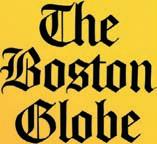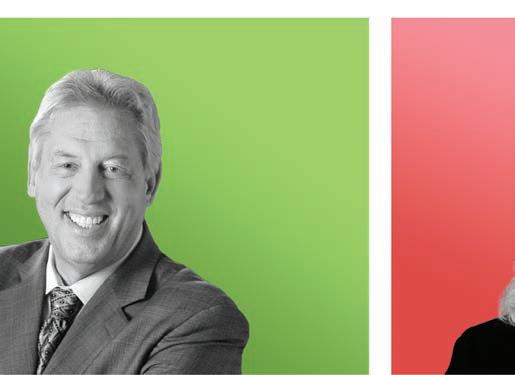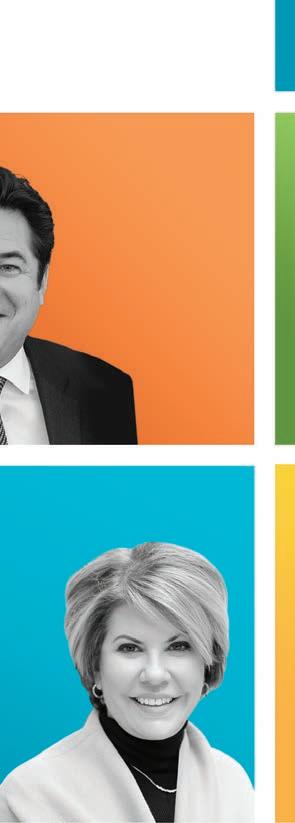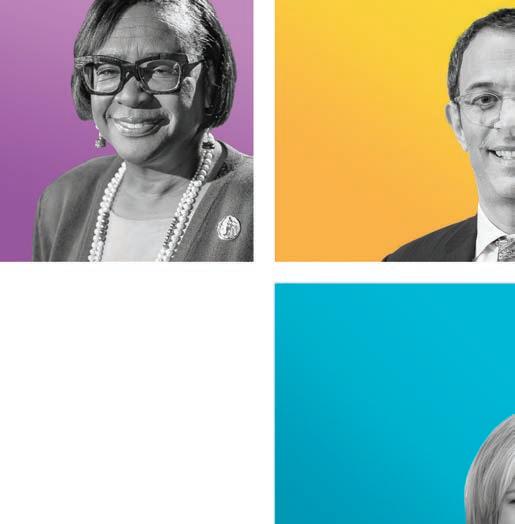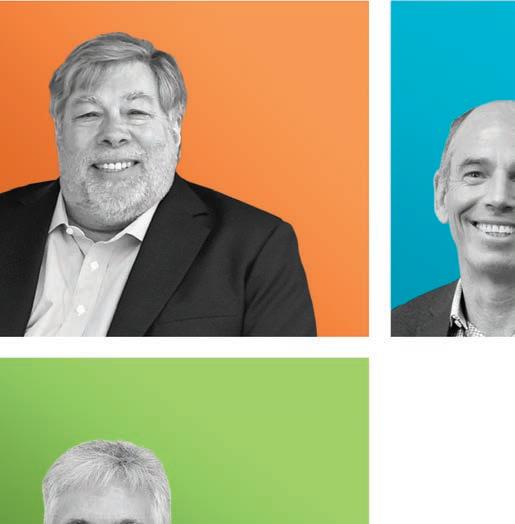PURPOSE SPACE EXPLORATION

SPORTS AND FAMILY SAVING THE HOME PLANET

WIM HOF GUN VIOLENCE
PREVENTION DIVERSITY, EQUITY & INCLUSION




WINE & SPIRITS
LEADERS

PURPOSE SPACE EXPLORATION

SPORTS AND FAMILY SAVING THE HOME PLANET

WIM HOF GUN VIOLENCE
PREVENTION DIVERSITY, EQUITY & INCLUSION




WINE & SPIRITS
LEADERS





Count on our industry experts to manage the risks associated with major construction and infrastructure projects all over the world. Starr is one of the world’s fastest-growing large commercial insurance companies, equipped with the industry knowledge and breadth of coverages to help your business grow in the most complex markets.

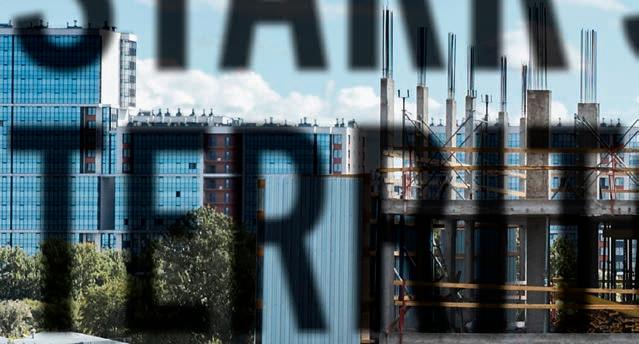



LEADERS Magazine is published quarterly and circulated to distinguished leaders of the world. Circulation is strictly limited. To receive LEADERS Magazine, one must be a leader of a nation, an international company, a world religion, an international institute of learning, or an international labor organization; or a chief financial officer, a major investor on behalf of labor or corporate pension funds, a chief information officer or a Nobel laureate. LEADERS Magazine was founded by Henry O. Dormann (1932-2018).

LEADERS Magazine
Publisher and Executive Editor: David W. Schner
Editor: Darrell J. Brown
Advertising Executive: Laurie McClure Ferber
Mikhail Baryshnikov
Sebastian Junger
Loretta Lynch
Paul, Weiss, Rifkind, Wharton & Garrison
Michael Dowling
Northwell Health
Ed Haug
Haug Partners LLP
Barbara Linarducci
Silvermine Arts Center
Printing: Calev Print Media – Freeport Press
Photo Credits : Cover - Baryshnikov, 8 - ©Peter Baryshnikov; 8 -10 ©Maria Baranova; 12 Junger - ©Peter Foley 2016; 18-21 - UConn Athletics; 46 Crow - ©Arizona Board of Regents; 51 - ©Leonid Andronov - stock.adobe.com; 58 top right - ©2019 American Lebanese Syrian Associated Charities; 60 game - ©Maria Lysaker; 62 bottom - ©Katie Stratman 64 building - ©2022 Christian Garibaldi /Garibaldi Imaginering LLC; 65 - ©Chris Coe; 74 exhibition hall - ©Jeremy Keats Saladyga; 86 headshot - ©Lee S. Weissman; 86-87 event - ©Kelly Williams; 89 - ©Igor Litvinov; 100 Heyen - ©2017, Gittings; 104 - ©David Hume Kennerly/2022; 106 Stock Exchange - ©Allie Joseph; 108 - ©Jose Mandojana; 115 - ©2020 Max Touhey; 122 - www.claudiapaul.com; 129 - ©Captured by Tymel; 132-133 all photos - ©Captured by Tymel; 138 bottom - ©2015 Jason Tinacci; 146 author, 147 portfolio - Roy Horn, drhorn. org; 148 author, 149 single bottle - ©Lucas Elmelaj; 149 winery - ©Alan C Hood; 149 three bottles - ©2020 Axel Lloret
LEADERS (ISSN 0163-3635 ) is published quarterly by Leaders Magazine, LLC, a Sandow brand; www.leadersmag.com. Leaders Magazine, LLC, Sandow Media, LLC and their respective affiliates, directors, officers, employees, contributors, writers and editors (collectively, “Publisher”) accept no responsibility for inaccuracies, errors or omissions with information and/or advertisements contained herein. The Publisher has neither investigated nor endorsed the individuals, companies and/or products that advertise within the publication or that are mentioned editorially. Publisher assumes no responsibility for the claims made by the Advertisers or the merits of their respective products or services advertised or promoted in the publication. Publisher neither expressly nor implicitly endorses such Advertiser products, services or claims. Publisher expressly assumes no liability for any damages whatsoever that may be suffered by any purchaser or user for any products or services advertised or mentioned editorially herein and strongly recommends that any purchaser or user investigate such products, services, methods and/or claims made thereto. Opinions expressed in the magazine and/or its advertisements do not necessarily reflect the opinions of the Publisher. Neither the Publisher nor its staff, associates or affiliates are responsible for any errors, omissions or information whatsoever that have been misrepresented to Publisher. The information on products and services as advertised in the publication are shown by Publisher on an “as is” and “as available” basis. Publisher makes no representations or warranties o f any kind, expressed or implied, as to the information, services, contents, trademarks, patents, materials or products included in this magazine. All pictures reproduced in the publication have been accepted by Publisher on the condition that such pictures are reproduced with the knowledge and prior consent of the photographer. As such, Publisher is not responsible for any infringement of any third party’s intellectual property or other rights arising out of any publication. LEADERS® is a registered trademark of Leaders Magazine, LLC. © Leaders Magazine, LLC 2023. All rights reserved. No part of this publication may be reproduced or transmitted in any form or by any means, electronic or mechanical, including photocopy, recording or any information storage and retrieval system, without the written permission of the Publisher.
“A winner is a dreamer who never gives up.”


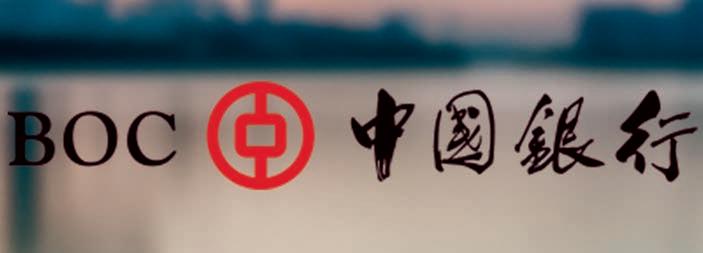




Democratizing Finance Nancy Davis, Founder and Portfolio Manager, Quadratic Capital Management LLC 44
The New American University Michael Crow, President, Arizona State University
46
Industry Expertise and Operational Excellence
Peter Reisman, Managing Director and Chief Communications Officer, Bank of China, U.S.A. 50
Maintaining a Flexible Mindset Byron L. Boston, Chief Executive Officer and Co-Chief Investment Officer, Dynex Capital, Inc. 52
The Little Engine That Could Jonathan Landau, Chief Executive Officer, Landau Properties 56
Inspiring the Next Generation of Humanitarians
Robert Catalano, Founder, Kids for Kids Foundation 58
A Love of the Game Dusty May, Head Coach, Men’s Basketball, Florida Atlantic University 60
Innovators in Multifamily Housing
Martin Nussbaum and David Schwartz, Co-Founding Principals, Slate Property Group 64
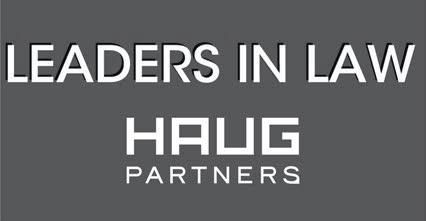
An AI Knowledge Platform
Igor Jablokov, Chief Executive Officer and Founder, Pryon 66
The Three Greatest Adventures
Michael Boydell, Founder, Boydell Global 68
Thoughtful Design Harel Edery, Founder, EDRE Development
70
The Silvermine Story
Barbara Linarducci, Chief Executive Officer; Rose-Marie Fox and Svetlin Tchakarov, Co-Chairs; and Roger Mudre, Gallery Director, Silvermine Arts Center
72
Where Strategy Meets Passion Taryn Brandes, Founder, Brand Urban 78
Simplifying the Rental Journey Jordan Kavana, Chief Executive Officer, ARK Homes for Rent 80
Putting Victims First Anita Busch, President, VictimsFirst 82
CHINA GENERAL CHAMBER OF COMMERCE - USA



“Some people want it to happen, some wish
happen, others make
happen.”





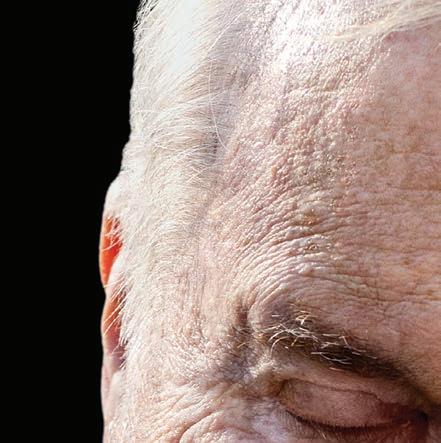











When former White Plains Deputy Police Commissioner James Bradley su ered two massive back-to-back heart attacks, the specialists at Monte ore Einstein saved his life by implanting a mechanical support system called an LVAD. What happened next was a heart failure reversal for the record books. His team did what few have the expertise to do, they removed the LVAD, and James’ heart continued to function well without needing a transplant.

See James’ heart failure reversal story at monte ore.org/James


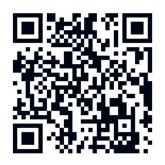




“I don’t know that I ever would’ve survived if I wasn’t at Monte ore Einstein.”
— James Bradley


EDITORS’ NOTE Born 1948 in Riga, Latvia, Mikhail Baryshnikov is considered one of the greatest dancers of our time. After commencing a spectacular career with the Kirov Ballet in Leningrad, he came to the West in 1974, settling in New York City as principal dancer with American Ballet Theatre (ABT). In 1978, he joined New York City Ballet, where he worked with George Balanchine and Jerome Robbins. A year later he was appointed artistic director of ABT where, for the next decade, he introduced a new generation of dancers and choreographers. From 1990-2002, Baryshnikov was director and dancer of the White Oak Dance Project, which he and choreographer Mark Morris co-founded to expand the repertoire and visibility of American modern dance. As an actor, he has performed widely on- and off-Broadway, as well as in television and film, receiving a Tony Award nomination and a Drama Desk Award nomination for Metamorphosis, and an Academy Award nomination for The Turning Point . Other theatrical productions include

Forbidden Christmas or The Doctor and the Patient, Beckett Shorts, In Paris, Man in a Case, The Old Woman, Letter to a Man, and Brodsky/Baryshnikov Recent projects include NOT ONCE., a cinematic installation developed in collaboration with Jan Fabre and Phil Griffin, and a second theatrical production directed by Latvian director Alvis Hermanis entitled The White Helicopter. He has worked with director Igor Golyak and the Arlekin Players Theatre on a new adaptation of Chekhov’s masterpiece The Cherry Orchard. In 2005, he launched Baryshnikov Arts Center (BAC) in New York City, a creative space designed to support multidisciplinary artists from around the globe. Among Baryshnikov’s many awards are the Kennedy Center Honors, the National Medal of Arts, the Commonwealth Award, the Chubb Fellowship, the Jerome Robbins Award, and the Vilcek Award. In 2010, he was given the rank of Officer of the French Legion of Honor, and in 2017 he received Japan’s prestigious Praemium Imperiale International Arts Award in Theatre/Film.
Will you discuss your career and your ability to reinvent yourself throughout your career?
Since the time I started studying dance, my interest was always wider than classical ballet. Of course, like most ballet students, I wanted to do the big romantic roles, and eventually I did, but I also knew there were all kinds of dance; folk dance, barefoot modern dance that I saw pictures of in smuggled copies of Dance Magazine, and National Ballet of Cuba dancers performing Balanchine in costumes that looked like rehearsal clothes. There was Fred Astaire and James Cagney in classic Hollywood films –somehow those were available in the Soviet Union – and in the films from India that my mother loved. I understood early that there was a big sandbox to explore, and I’m still playing. I guess you could say that it has been more of an evolution than a reinvention.
What do you attribute to your leadership and success in the profession?
I think I’ve been able to instinctively choose the right people to work with at the right time, and I’ve given 150 percent of myself to every project.
How important was it be resilient when you look at your career journey?
When you study classical dance for years, you have to be resilient to achieve anything. It’s about doing it again and again until it’s right and that takes a certain persistence. Resilience becomes second nature.
What was your vision for creating the Baryshnikov Arts Center (BAC) and how do you define its mission?
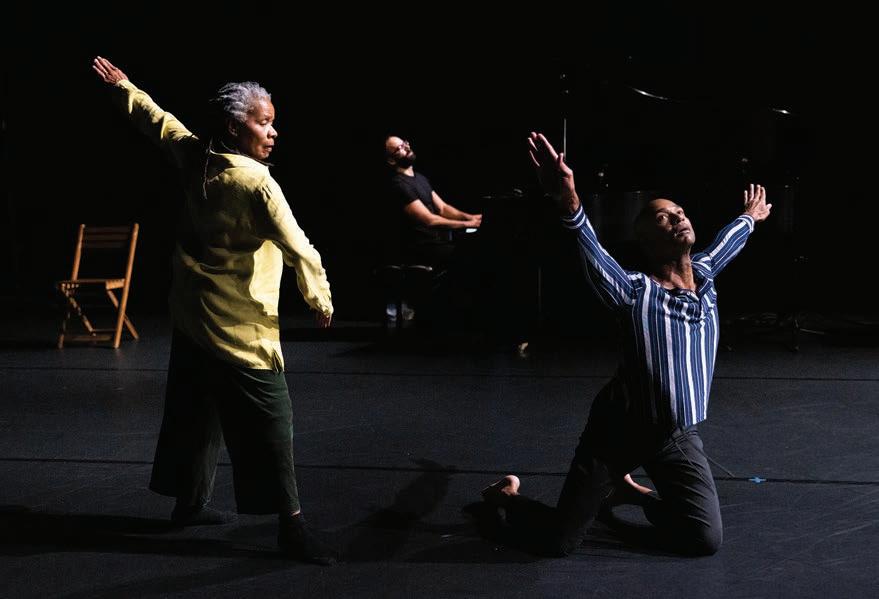
Before BAC existed I was supported creatively by fellow dancers, choreographers, musicians, designers, producers – whole teams of people – and of course, by audiences. With BAC, I wanted to give some of that open-hearted support back to the performing arts community. BAC’s mission is to provide artists with unfettered access to the time and space necessary to develop new work. There are many arts organizations that do similar work, but I think BAC has refined the process so that artists feel respected and validated as members of BAC’s creative community. They know they are valued and that BAC will always be a place they can turn to for support, advice, and encouragement.
Did the skills that made you successful as a dancer translate to being successful in business?

Am I successful in business? Not sure about that, but I suppose success of any kind comes back to instinct and the ability to persevere. Again...resilience. BAC is a nonprofit organization so it’s not an ideal business model, but we use our limited resources to focus on what we can offer the artists. The returns are not monetary, which is the typical measure of success, but for me, life is meaningless without art – it is the color and stimulus of life – so there’s great satisfaction in supporting performing artists.
Will you discuss your feelings on Russia’s current politics, and your call for prominent Russians to speak out against the war in Ukraine?
I’m rooting for the Ukranians, full stop, and rooting for Biden’s continued support of the fight for Ukrainian sovereignty. I don’t want to go into details about Russia’s current politics other than to say that Russia has a dark and tragic history of oppression and nothing much seems to have changed. Alexey Navalny, one of the few glimmers of hope for a democratic future in Russia, sits imprisoned and ill, courtesy of Putin. This sad reality is one more item on a long list of humanitarian abuses Putin is perpetrating on the people of Russia and Ukraine, and I hope that one day he’ll be held responsible. I’m part of truerussia. org and we’re doing what we can to help refugees from those countries and their neighbors.
How important is arts education in schools and what do you feel are the benefits of introducing students to the arts at an early age?

I’m told that once there was an extensive arts education system in U.S. public schools and that
access to music, theater, and the visual arts was a given for every public school child. This is similar to what I experienced as a young student, and for me, that early access to the arts was critical. I wasn’t particularly good at academics, but when I discovered dance, and along with it, music, theater, and design, I knew I’d found my place. Any psychologist will tell you that this is the best thing that can happen to a child, and any sociologist and economist will tell you that it’s a lot less expensive to fund arts education than to lock people up.

With all that you have accomplished during your career, were you able to enjoy the process and take moments to celebrate the wins?
I don’t view anything I’ve done in my life through the lens of winning or losing. I simply keep at it and try to enjoy – or at least learn from – the process, no matter how difficult. It’s much more about passing the torch to the next generation now, and the older I get, the more grateful I am that I can help to do that.•
Owls


EDITORS’ NOTE Sebastian Junger is the #1 New York Times Bestselling author of The Perfect Storm, Fire, A Death In Belmont , War , Tribe , and Freedom . As an awardwinning journalist, a contributing editor to Vanity Fair, and a special correspondent at ABC News, he has covered major international news stories around the world and has received both a National Magazine Award and a Peabody Award. Junger is also a documentary filmmaker whose debut film, Restrepo , a featurelength documentary co-directed with Tim Hetherington, was nominated for an Academy Award and won the Grand Jury Prize at Sundance. Restrepo, which chronicled the deployment of a platoon of U.S. soldiers in Afghanistan’s Korengal Valley, is widely considered to have broken new ground in war reporting. Junger has since produced and directed three additional documentaries about war and its aftermath. Which Way Is The Front Line From Here? , which premiered on HBO, chronicles the life and career of his friend and colleague, photojournalist Tim Hetherington, who was killed while covering the civil war in Libya in 2011. Korengal returns to the subject of combat and tries to answer the eternal question of why young men miss war. The Last Patrol , which also premiered on HBO, examines the complexities of returning from war by following Junger and three friends – all of whom had experienced combat, either as soldiers or reporters – as they travel up the East Coast railroad lines on foot as “high-speed vagrants.” Junger is the founder and director of Vets Town Hall. He has also written for magazines including Harper’s, The New York Times Magazine, National Geographic Adventure, Outside, and Men’s Journal. His reporting on Afghanistan in 2000, profiling Northern Alliance leader Ahmed Shah Massoud, who was assassinated just days before 9/11, became the subject of the National Geographic documentary Into the Forbidden Zone, and introduced America to the Afghan resistance fighting the Taliban.
Will you highlight your journey to becoming a journalist?
I went to a liberal arts college and majored in anthropology since it interested me. I had no sense of practicality at the time or thought about what I would do after college, and before I graduated I ended up doing field work
on the Navajo Reservation. During college I had been a pretty good long-distance runner, so I wrote a thesis on Navajo long-distance running which is a very old tradition in that culture. The thesis was about that tradition and its modern expression. I realized how much I enjoyed doing the research and studying the subject and writing about it. I figured this was pretty close to what journalism must be like,
so I thought that maybe I would become a journalist.
There were also a number of great short story writers during that time – Tobias Wolff, Grace Paley, Ray Carver – who I was enamored with, not thinking about how utterly impractical that was in trying to make a living. I was intrigued by the art form, and I began waiting tables, writing short stories and articles, hitchhiked around the country, traveled to Europe where my dad was from, and had a lot of experiences, but nothing that was geared towards a career. I had gotten a few things published, but it was not really going anywhere. In my late 20s, I was sitting next to a guy in a bar who owned a tree company, and he told me that he needed a climber and asked if I was willing to work a few days a week. I thought it sounded good and agreed to be a climber who goes up 80 feet in the air with a rope and a chainsaw to cut down trees. It is quite acrobatic work, and dangerous if you make a mistake. I realized that there was no random danger – it is all physics and if you get killed, it is because you screwed up. I enjoyed the concept that there were risks, but the risks were controllable. One day I did screw up and cut the back of my leg with a chainsaw, and while I was recovering I was thinking about writing a book about dangerous jobs.
At this time, I was living in the town of Gloucester and a huge storm hit the coast of New England. A local boat named the Andrea Gail was lost in the storm, and while I did not know any of the crew, I thought about writing a book to tell the story of the Andrea Gail since this happened in my community. That became my first book, The Perfect Storm. I researched that story for many years, and during this same time there was a civil war occurring in Bosnia, so I took a duel approach to my failed future and decided to write a book proposal for The Perfect Storm and go overseas to be a war reporter. I actually had an agent at the time who saw some promise in me and took a chance on me. I sent the book proposal for The Perfect Storm to him, went off to Bosnia to cover the war, and completely fell in love with the work of war reporting. I was with a few other freelancers and we traveled all across Bosnia. The war was in a stalemate so there was not a lot of combat, but I was able to experience this society that was in crisis and stagnating. There were
businessmen in suits who were boiling coffee in a pot on a twig fire in the courtyard of their apartment buildings. It was an eye-opening experience. I had to come home because my agent had sold The Perfect Storm, and even though it was not much money, I was thrilled. This was really the beginning of my career. I knew I did not want to be an American author and soon after headed off to cover the war in Afghanistan since I wanted to be a foreign reporter.
What was it like covering wars and being in areas of conflict around the world?

Being in danger is very scary, but there is an intensity and sense of meaning that comes from being in situations like that. I have been in several situations where I thought I may be killed, which is obviously an awful feeling. However, if you widen the context, you are in a critical situation that you are reporting on which is an important role and gives you a sense of meaning and purpose.
This can make ordinary life, which for me was being back in the U.S., seem bland and uninteresting, but of course it is not. There is nothing more meaningful than taking a walk in the park with your daughter, for example. However, at my age at the time, I felt that I had to prove myself. It took a long time in my life for me to reach the maturity to see the meaning in what many would refer to as mundane activities.
What are your views on war?
There are so many different types of wars. My father grew up in Europe and his father was Jewish so they fled Germany first in 1933 and then Spain in 1936 when the fascists came into Spain, and then France in 1940 when the fascists came into France. When I was growing up, war was the righteous counter to fascism. The moral choice was to confront fascism, even with violence if necessary. I was a kid during Vietnam, but this was a time when war became an immoral thing. After 9/11, it reversed again
when the war was thought of as a moral and necessary thing. There was a legal and moral right to go after the terrorists.
Whether war is moral or immoral really depends on the context. While I covered the war in Afghanistan, I refused to cover the Iraq war because I felt it was immoral.
What were the factors that led you to stop being a war reporter?
My colleague and friend, Tim Hetherington, was killed on assignment during the Arab Spring in Libya. I was supposed to have been with him on that assignment, but at the last minute I could not go for a personal reason. My wife at that time and I got the call on our home phone in our New York City apartment alerting us of Tim’s death and she said to me that if I was going to keep going to these places of conflict around the world, she was going to spend the whole time worried that the phone was going to ring and the call would be about me, even if this was unlikely to happen. I realized that she was right and it was not fair to do this to her.
When I stopped, it was a difficult transition since it is a very easy identity which makes you very interesting at cocktail parties and in social settings – you are the war reporter. I had matured and realized that if that was the reason to not give it up, I had bigger problems. I was turning 50 years old at the time and it sent me on a more thoughtful path. If I had not made this change, my book, Tribe, would have never happened. It allowed me to go deeper into the human experience and was an enormously good thing.
What led you to write the book Tribe?

I had written a book called War and a reporter asked me why soldiers return from war so messed up. I gave a lot of thought to this question and realized that it was not that they were messed up – it was that they return and do not feel as if they fit into society, but in truth a lot of people feel that they do not fit into society. I thought about the incredibly strong fraternal bond in an adverse environment during war when the stakes are very high and everyone needs each other – this bond is our evolutionary
past. You take these people from the suburbs and drop them into our evolutionary past, they respond very positively, and then you take them back out and put them into modern America which has incredibly high rates of depression, addiction and suicide – of course they are not going to feel good. In combat, it is a collective and the soldiers have community. This was the foundation for the book.
What about your latest book, Freedom?

You are always looking for your next book, and after Tribe, I was thinking about what else people were willing to die for other than their family and community, and it is their freedom. Freedom is such a misused word and such an elusive word, and I wanted to write a book that was a discussion of freedom that no one has had before. For me, this meant how do less powerful groups maintain their autonomy and freedom in the face of more powerful groups. It is a very simple equation: if you are the biggest person in the room, of course you are free –everyone is afraid of you. But what about less powerful groups. I asked myself the question, “when have I been most free in life?” There are many ways to answer that – financial freedom, which I have now more than I had when I was a kid; temporal freedom, being able to do what you want with your time, which I have less now with responsibilities that I did not have as a kid – so it depends how you define freedom.
I thought one interesting definition was this: I had come up with a crazy idea and walked with a couple of veterans and a journalist along the railroad lines over the course of a year from Washington, DC to Philadelphia and then turned west to Pittsburgh. We chose the railroad lines because these are no man’s land, and it is quite safe and you can do what you want. We were sleeping in the woods, under bridges, and in abandoned buildings – we called it high speed vagrancy. I realized that
most nights we were the only people who knew where we were – under what bridge, in what abandoned building – which was an important aspect of freedom. If people can’t locate you, they can’t tell you what to do.
I also realized like with any form of freedom, it only works if you agree to commit to other people to maintain your safety. You are not free from the group, because you need to be dependent on something – there is no such thing as complete freedom and complete safety. It is a balancing act between the freedom from an outside force, freedom from internal oppression, and commitment to the group to keep yourself alive and safe. I learned this during our experience since the four of us really needed each other to survive this tough environment. We could not have done it without everyone contributing to getting water, firewood, making food, carrying someone’s backpack when they were tired. That trip was what led to the book Freedom.
What are your views on isolation which is so prevalent in society today?
The more affluent the society, the more prone it is to isolation. I live in a middle to lowincome neighborhood in New York City where there is subsidized housing and it is substantially Dominican and Puerto Rican. It is a tight-knit community. Everyone knows each other and is dependent on each other. It is possible to stay in socially healthier communities. I have spent a lot of time in Africa where kids do not have cell phones, and most adults do not have cell phones. I was in Liberia during the civil war, and we went back there when my eldest daughter was around three years old, and it was very peaceful. It was like a pre-technology society, and I remember telling my wife that if American society gets too alienated and dysfunctional, we could always move to Africa where life is
actually more human. It would break my heart to do that because I love my country, but I do worry about the direction it is heading.
What are your views on what makes an effective leader?
I sometimes do speaking gigs for corporations where management wants me to discuss how you foster a feeling of tribe, which you can translate as loyalty to the company so that the company does better. They know that the feeling of loyalty increases production and improves results. I give a talk that I refer to as “battlefield lessons for the corporate world” where I try to distill down what I have learned. My focus is on saying something that is helpful in human terms and one of my messages is that you can lead a company, or you can manage a company. If you are going to lead a company, it means suffering the same consequences as everybody else. If there is a downturn, you personally experience a downturn. If you have to fire people because of a downturn, you do not get a bonus that year. Leaders do not take a bonus in a year when other people get fired. If you want to just manage your company, take a bonus, but don’t expect loyalty. Your people notice when only bad consequences come to them, and not to upper management.
Being a leader is about not thinking of yourself, but focusing on others. You are the last in the line. Real leaders see themselves as the last consideration in all the calculations they have to make.
One thing that I found when researching for my book Freedom is that the underdog groups that prevail tend to have a few things in common, and one of them is leaders that are willing to die for a cause – literally die for a cause.
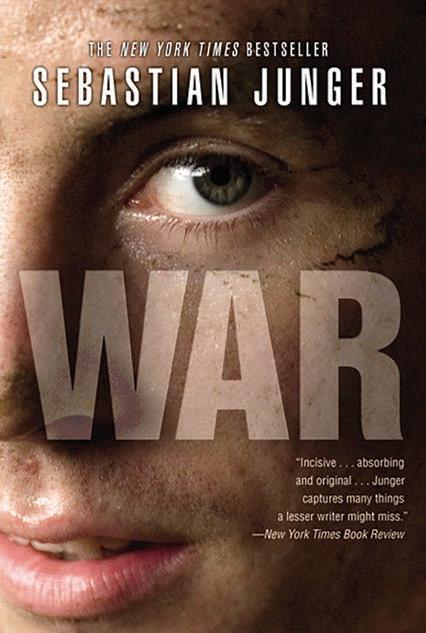
How did your health scare impact your views on life?
A few years ago, I had a pain in my abdomen which turned out to be a ruptured artery and within a few minutes I could not stand up. I was bleeding internally which can be a killer. It took me 90 minutes to get medical health and I barely made it. This incident really impacted me mentally as I am now very aware of my surroundings and knowing where the nearest hospital is and where medical care would be. I am always gaming things out, thinking about possible scenarios relating to medical issues. This is something soldiers are constantly doing in combat to make sure they are prepared for all possible scenarios.
This health scare was the hardest psychological struggle of my life, far worse than anything I experienced in combat. It went from a panic disorder to a real depression, and at that point I started talking to a therapist since I knew it was dangerous.
Do you have plans for your next book?
I am writing a book about what happened to me with my health scare. I’m an atheist and don’t believe in anything. While I was dying, my dead father appeared above me to welcome me to join him. I did not know at the time that I was close to death, but I actually was on my way out. The doctors were working on me when I saw a big, black pit open up underneath me and I was
getting pulled into it. I was still conscious and talking to the doctors, but I could feel myself getting pulled into the pit and I didn’t want to go. I could see my father telling me it was okay and I didn’t need to fight it. I remember telling the doctors to hurry.
I am writing a book about this experience and about death, since I have a specific relationship with death having gone to war zones, and then after years of being in areas of conflict covering wars, having this health scare back home. I am trying to sort out all these thoughts and experiences in rational terms.

After having this medical emergency, it made me realize that none of us are guaranteed to make it to sundown. We are not living our lives with this knowledge – we live our lives assuming that we will make it to sunset. If you suddenly realize that you are living in a world where there is no guarantee, reality looks very different. If you can keep it from becoming too terrifying, it almost becomes sacred.
What has made it so important for you to not let success change you?
It is just not who I am. Nothing depresses me more than a nice Tribeca loft, because it doesn’t feel human. My family lives in an apartment that is less than 600 square feet – we co-sleep partly because there is not much room and there is no other space for the kids. Americans are the only mammal that does not sleep with their young. Every other animal, every other society, basically sleeps with their young.
Affluence depresses me. My wife and I do not fit into the culture of wealth and consumerism that seems to dominate today, which is probably why we are happy together. The push for affluence often leads to unhappy people and if you look at the numbers around depression, addiction, and anxiety today – this is clearly something this society needs to work on.•






EDITORS’ NOTE In May 2023, business pioneer John Shoffner fulfilled his lifelong dream of going to space. At eight-years-old, he formed a young astronauts club with his friends in Middlesboro, Kentucky. He ignored the voice in his head that begged to be an astronaut, as space flight didn’t make for a widely accepted career at the time, and instead took a more conventional route. Shoffner’s professional endeavors led him to the forefront of the fiber optic telecommunications industry at its earliest stages. He formed Dura-Line Corporation, developing and patenting multiple processes for materials and methods for the placement of fiber optic cable during the 1980s. He built the foundation for Dura-Line from scratch, turning a small family startup into a business that ultimately sold for hundreds of millions of dollars. DuraLine remains a world market leader today as a result of his assertive, but humble, leadership. Outside of business, Shoffner’s zest for adventure led him to become a pilot. He is a veteran of airshows for more than 25 years and holds commercial, instrument, single-engine, and multi-engine ratings in both land and sea aircraft, helicopters, as well as ratings in ex-military jets and high-performance radial engine aircraft. Most recently, Shoffner and his wife, Janine, created their own motorsports team, J2-Racing, where he quickly became a champion GT racer. Despite the thrill of racing and piloting airplanes, Shoffner’s wild ambition to become an astronaut never escaped him. As the years went by, his childhood ambition of making it to space became more and more prevalent. His wife showed him an article about Axiom Space whose mission is to build the world’s first commercial space station, and it didn’t take long for him to become an investor in Axiom, and later an astronaut. Shoffner served as backup crew for Axiom’s Ax-1 mission, but just going to space wasn’t enough. He went beyond the call of duty for a private astronaut, receiving NASA certifications and spending additional time and resources to train at Johnson Space Center. His ambition for going to space is bigger than being a joyride for the privileged, and he is building a curriculum for middle school STEAM education that will include dynamic demonstrations aboard
the ISS with his Commander and one of America’s most accomplished astronauts, Dr. Peggy Whitson. Along with the curriculum that will reach classrooms in the fall, Shoffner will be personally investing in select schools and educators to fund STEAM certifications. Additionally, Shoffner launched an art and poetry contest asking students, “What would it look like if we lived in space?” The contest has inspired over 930 entries from over 24 countries around the world, and he will announce the winners live from the ISS.
Will you discuss your career journey?
My business career developed accidentally at the dawn of the fiber optic industry. The result was a global business that participated in the early deployment of many of the world’s fiber optic networks. As the company matured, I found it was time to move on to what my world was truly about, finding the exciting limits of human performance and, finally, spaceflight itself.
When did your passion for space develop?
I fell in love with space when I was eight years old at the beginning of the space race. The passion for spaceflight and space exploration followed me throughout my entire life, eventually resulting in my flight to the ISS.
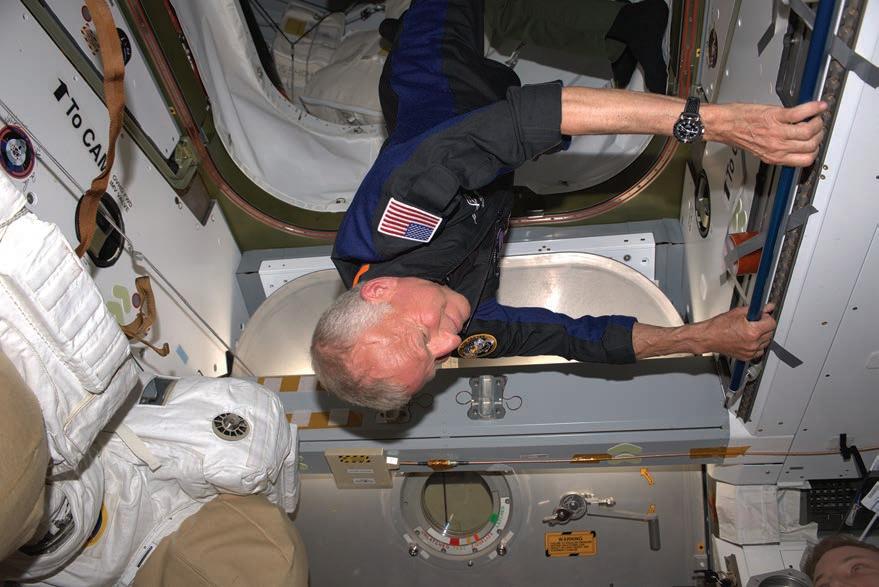

You and your wife, Janine, created your own motorsports team, J2-Racing. What led you to this opportunity?
The passion to find my personal limits for performance eventually lead us to motorsports. My wife told me I had never owned a cool car, which was true – cars were just transportation to me. So, I bought a Ford GT and that led us to a fun track day and that led us to the racetrack and eventually to Germany for real motorsports competition at the Nurburgring.
Where did your interest in philanthropy develop and how do you decide where to focus your efforts?
As a 10-year-old loving space and science, there was little push from our school system to follow that interest. I believe there are many 10-year-olds today in schools that need support and encouragement to follow the inner vision they hold
of themselves. I have chosen to put my efforts into STEAM education to help educators recognize and teach to the interests of their students.
Will you highlight your work to build a curriculum for middle school STEAM education?
During my time on the ISS, I recorded multiple examples of what it is like to live and work in space. We will process these videos into short episodes for teachers to use and create a classroom conversation. Getting the attention of the students is the first step to opening their minds to the possibilities that exist, and hopefully to them recognizing the voice in them to pursue their passion.

What is your outlook for the future of space exploration?
The future of space is brighter than ever. Many companies, such as Axiom Space, are planning projects that involve access to low earth orbit that will allow us to bring more people and activities to space. The next 10 years will be very exciting times for space travel. We will see not only improved Low-Earth Orbit (LEO) access, but also multiple lunar landings and our first lunar outposts develop. Commercial interests will develop rapidly as access and the cost of access improves.
How important is it for you to showcase the value that space commercialization brings to Earth?
It is very important to keep the conversation of space commercialization active. There are many questions that need to be both asked and answered to continue bringing commercial interests forward. Expanding involvement will bring new perspectives and solutions to some of the difficult questions that remain. Costs will remain high initially, so it will require stakeholders to seek solutions to demonstrate and create value from their participation.
Did you always know that you had an entrepreneurial spirit?
I believe so. I always had faith in my views, but was equally comfortable seeking guidance. I find it difficult to be satisfied with any status quo, so I always seek what is next.
What advice do you offer young people beginning their career journey?
Ask questions, but take a moment to look at what is the primary interest you hold – what activity, what topic do you find you always return to. It seems true that if one develops sufficient expertise in anything, you will be both successful and happy, so do that in something that you love.•
“The future of space is brighter than ever.”
EDITORS’ NOTE The steady upward trajectory that the UConn men’s basketball program had maintained during Dan Hurley’s first four years as head coach took a monumental leap in 2023 as Hurley guided the Huskies to the fifth NCAA National Championship in program history. The national crown was the product of a rebuilding job that Hurley began when he took the reins of a struggling UConn program in March 2018, as the 19th head coach in UConn history. The Huskies’ winning percentage has improved in each season under Hurley.
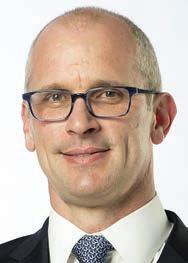
Although Hurley was a national recruit coming out of St. Anthony High School and he put together an impressive college playing career at Seton Hall, it is as a coach that Hurley has made the basketball world take notice, as a program-builder and a positive guiding force for young men. While still a youthful coach in college basketball terms, Hurley has already taken charge of four struggling hoop programs – St. Benedict’s Prep, Wagner College, the University of Rhode Island, and UConn – and built them into competitors on the national stage.
Hurley is a product of one of the most wellknown basketball families in the country, led by his father, Bob Sr., a Naismith Memorial Basketball Hall of Fame inductee following a legendary high school coaching career at powerhouse St. Anthony in Jersey City (New Jersey), and including older brother Bobby, a college All-American and two-time National Champion player at Duke, who played for five years in the NBA, and is currently the head coach at Arizona State.
Hurley came to UConn following six years at Rhode Island, where he took a program that went 7-23 in the season before he arrived to a combined 51-18 mark and two NCAA Tournament appearances in his final two years, URI’s first NCAA appearances in 18 years. In each year, Hurley guided the Rams to a first-round NCAA tourney victory. In 2014-15, Hurley earned his first U.S.BWA District I Coach of the Year Award and in 2017-18, Hurley was named Atlantic 10 Coach of the Year, earned his second U.S. BWA District I Coach of the Year Award and sent two of his players to NBA teams. Prior to his tenure at Rhode Island, Hurley spent two years at his first Division I head coaching job at Wagner College in the Northeast Conference.

After graduating from Seton Hall in 1996 and spending a season as an assistant coach under his father at St. Anthony, Hurley was hired as an assistant coach at Rutgers and remained there for four years. When Rutgers decided to change coaching staffs, Hurley opted to go back to the high school level and took over the basketball program at St. Benedict’s Prep in Newark, New Jersey, in 2001. It was at St. Benedict’s, where he also taught history, that Hurley maintains he really learned his craft, building the program into a national prep school powerhouse. In nine seasons, Hurley compiled a sterling 223-21 record, with four Top Five finishes in the national rankings. He coached four McDonald’s All-Americans as well as future NBA players J.R. Smith, Tristan Thompson, and Lance Thomas.
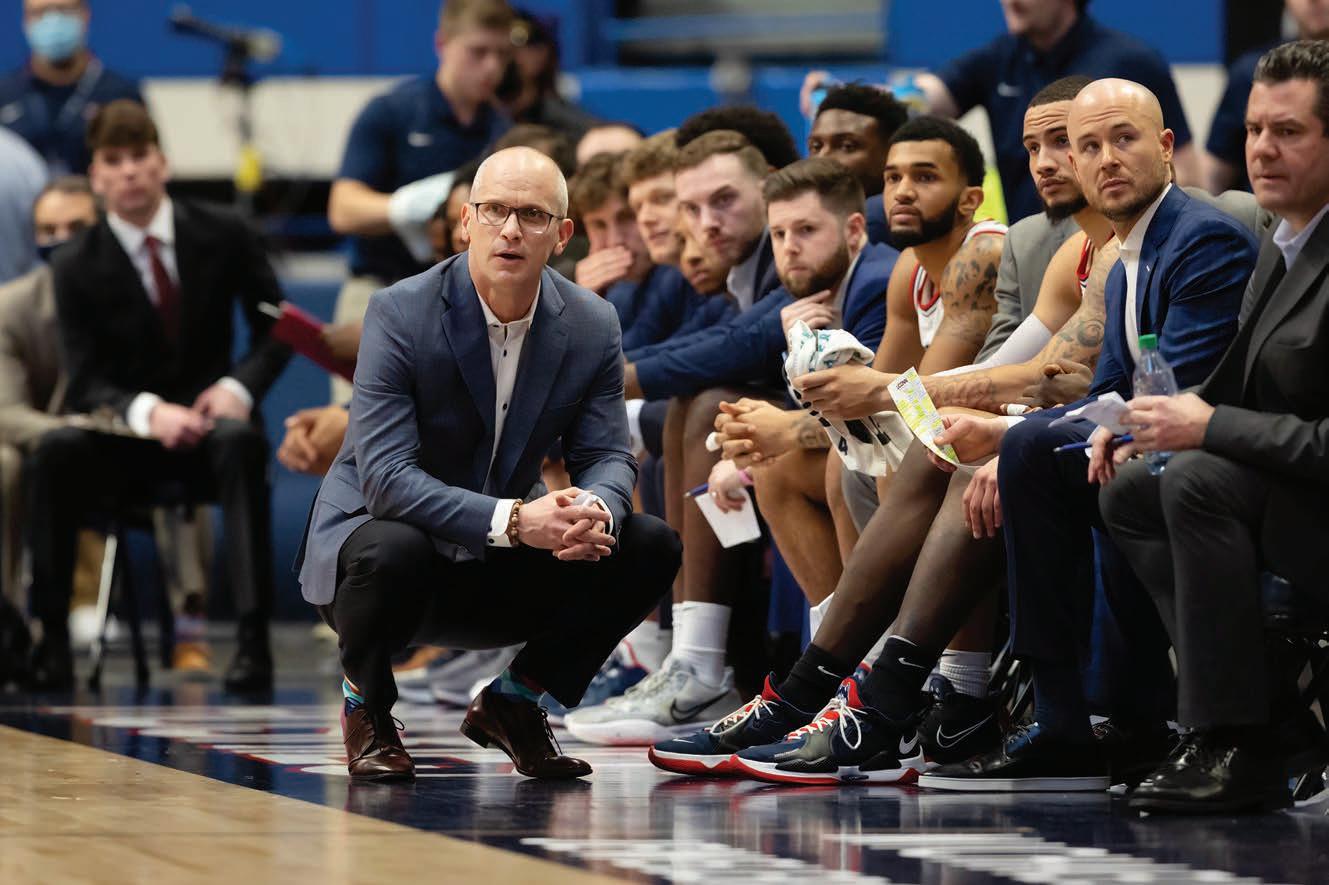
Born and raised in Jersey City, Hurley was an outstanding high school player at St. Anthony, leading the team to a 31-1 record and a #2 national ranking as a senior. At Seton Hall, he played under head coaches P.J. Carlesimo and George Blaney, amassing career totals of 1,070 points and 437 assists and helped the Pirates to three NCAA Tournament appearances and an NIT berth during his career.
Hurley and wife, Andrea, who met while both were attending Seton Hall, are the parents of two sons, Danny, also a Seton Hall graduate, and Andrew, a junior at UConn.

Having grown up in a basketball family, did you always know that this was the career path you wanted to pursue?
I could not imagine a life without sports. Our dad exposed us in Jersey City where we grew up with all types of sports, from Little League baseball to football, basketball, track –we were always very active. The competitive fire was developed at a very young age by being involved in so many different sports, and then as you get older you start to narrow your focus. As we approached high school, we knew that it was necessary to commit to basketball to be able to play at a high level and to be able to get a college scholarship. My brother and I knew that the only way we were going to be able to go away to college was if we got a college scholarship. Once basketball became the central figure in our lives during our high school days, I knew that I was going to either play and then coach, or coach straight away.
It has not always been a smooth journey. How important has it been to have resilience as you have navigated your career?
I think that most successful people have experienced a lot of setbacks and losses along the way, and this builds up a resiliency and a toughness which is necessary to learn and grow from the mistakes. I have always had self-awareness, especially as I got into coaching. While I feel that my playing career gave me a good understanding of the game, I realized when I entered coaching that year after year I needed to get better to develop and evolve as a coach. Unfortunately, sometimes the best way to get better is to fail.

When you look at the state of college sports today, with the transfer portal and NIL deals and players entering the NBA draft after one year, is it harder for a program to build a culture?
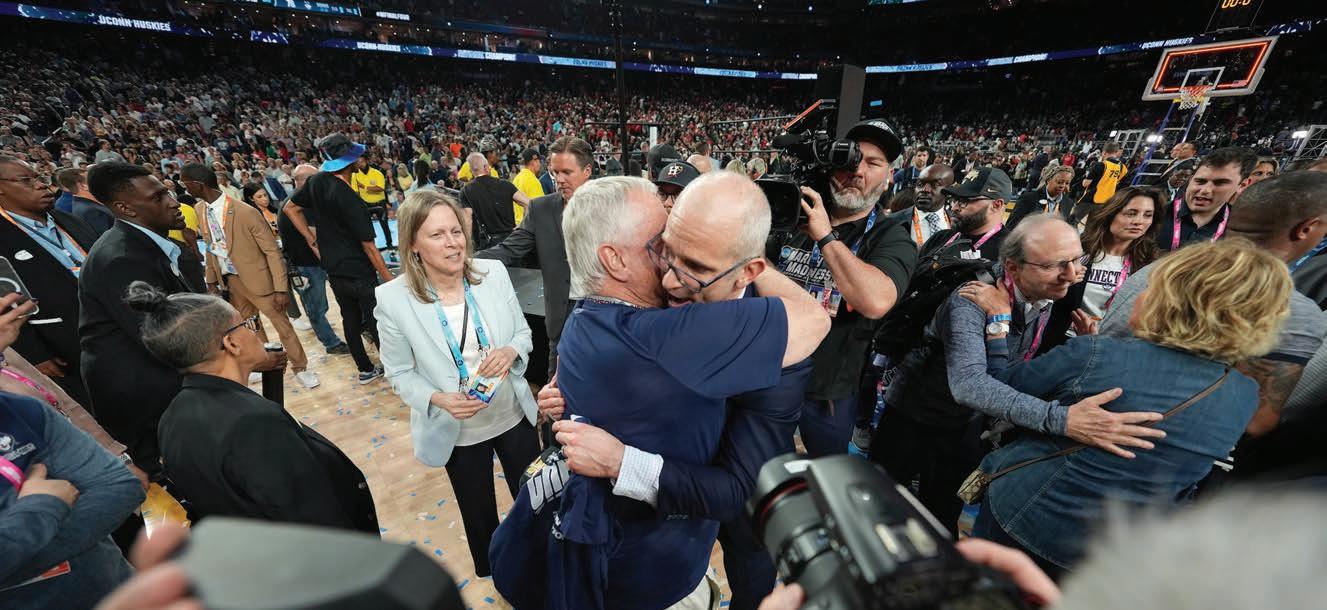
It definitely is, and it can be tempting to take shortcuts but, in the end, that weakens your culture, or you end up without a true culture; you don’t have a program – you just have a team. I have no interest in being a coach in basketball if I am not part of a program that is recruiting young players, getting them on the court right away, and continuing to develop them over time. It is about building a bond between you and them through a lot of hard work. This is what keeps me excited and coming back for more.
While you are always looking for the best talent, how much do you factor in personality and program fit during the recruiting process?
We look for old school parents and old school high school coaches and old school mentors around the kids we recruit. Our program is not about selling sizzle – it is about selling substance. It is about the year-round commitment that we make to our players and exhibit every day that they are on campus. Our staff is here and committed to our players – we
are here around the clock for our players. We look for young people who prioritize that and for families that are looking for that type of coaching commitment.
It is about the commitment of our entire staff. I have always tried to hire the smartest people and best coaches who are focused on building relationships and creating a vision for what our program can do in terms of developing and winning. Kimani Young and Luke Murray are two of the best coaches in the country and will be incredibly successful head coaches. Tom Moore is an amazing coach to have around me. They challenge me to be my best every day and have great ideas and suggestions that have been critical to our success.
You are known to be a very passionate coach which is clear when watching you on the sidelines. Will you discuss your coaching style?
Most of that passion during a game is directed at the officials or to engage the crowd, particularly at home games since our play style – our aggression and the way we attack –lends itself to us having a very passionate bench. When you play against us, there is a special energy on our bench which is probably why we lead the country in warnings from officials for our whole bench to sit down – not just me.
What people do not see behind closed doors is the scouting work of Kimani and Luke and me; the detail of structured, high-energy, super-competitive practices; the countless hours of film work, both as a group and as individuals. We are doing this 11 months a year.
What are your views on the state of college basketball today?
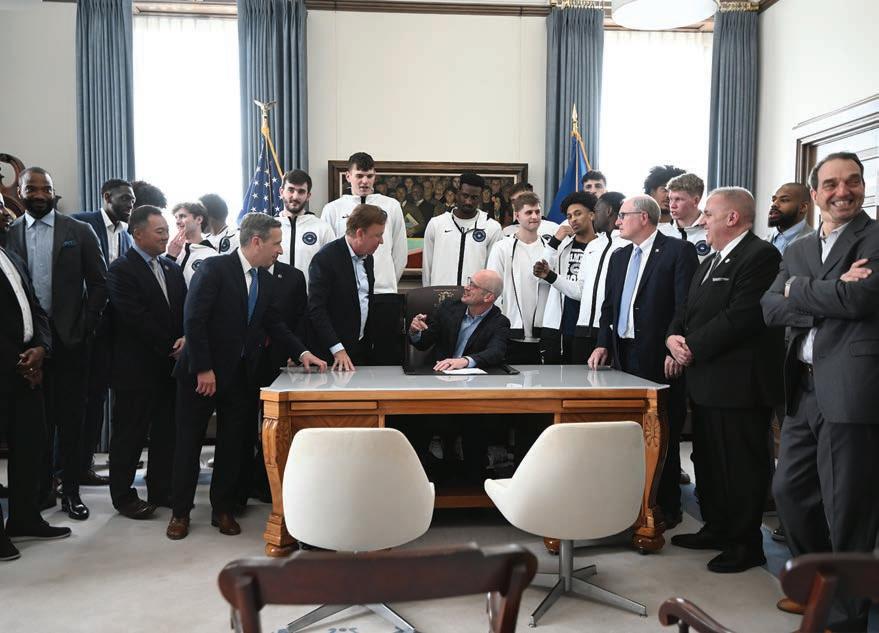

I think that the NIL was much needed for these student-athletes who bring so much value to college basketball and it provides a great
opportunity for them to begin to think like businesspeople and entrepreneurs.
With regard to the transfer portal, I think we need some guardrails. For players to play for four or five different colleges allows for a lot of freedom in the short term but, in the long term, I think it unfortunately allows young people to run from ever really addressing the things that they need to do to be successful –the habits and behaviors and mentality needed to succeed. I think the transfer portal today also hurts an athlete’s ability to develop a network. If you play at three or four schools, you do not
have a network in terms of a university and a coaching staff that you were with for three or four years. These networks are critical in creating opportunities for players in life after basketball.
How important is it for you to build a strong alumni network for the program and to stay engaged in your players’ lives after they leave the university?
Being someone who the players respect and who they know will tell them the truth and care for them is extremely important to me. I believe in radical honesty and telling them what they need to do to improve and get better. I am also there for them when they need to be picked up or need a hug during the tough times. We develop a bond that is there throughout the rest of their lives, and it is about being there to always tell them the truth, give them advice, and care about them.
How hard is it when you are with your father and brother to not talk about basketball?
No one has ever asked me that. It is really hard. It is usually about sports and family since this is where our interests are. For us, it is all about family, close friends, and sports.
With the success that you have achieved, are you able to enjoy the process and appreciate the journey?
I prefer the process over the destination. I grew up in an incredibly high-achieving, striving household which always had me thinking about the next thing. My staff and I have been talking about next year’s roster since last February. There are times when I take moments to enjoy it, such as when I am in my truck heading home and I see a nice sunset and I think about what we just accomplished, but for the most part I am about the work and experiencing it with a group of people – which is a beautiful moment.•









John Ferren (1905 -1970) was born in Pendleton, Oregon. He moved to San Francisco in 1925 and studied at the California School of Fine Arts (now known as San Francisco Art Institute). Ferren was largely self-taught, although he took classes at several prestigious instituions. According to Ferren, his real education came in and around cafes and studios in Paris, where he primarily lived between 1931 – 1938.
Importantly, Ferren was one of few artists of the New York School to have first been ensconced in the Parisian prewar artistic community and the circle of Gertrude Stein. He was respected by his fellow artists in a manner that many Americans were not, even earning inclusion in Stein’s Everybody’s Autobiography, in which she states, “Ferren ought to be a man who is interesting, he is the only American painter [that] foreign painters in Paris consider as a painter, and whose painting interests them...”
Ferren returned to the United States in 1938, and by 1940, Ferren had received one-man shows at Pierre Matisse Gallery, Minneapolis Art Institute, Arts Club (Chicago), San Francisco Museum of Art, and Corcoran Gallery, among others. He served during World War II in the North African and European theaters, however he never stopped painting. After the war he turned to Abstract Expressionism.
Selected Museum Collections
The Museum of Modern Art, New York
The Metropolitan Museum of Art, New York
Whitney Museum of American Art, New York
Philadelphia Museum of Art, Philadelphia
Solomon R. Guggenheim Museum, New York



Selected Exhibitions
1936 - San Francisco Museum of Modern Art, CA
1936 - Pierre Matisse Gallery, New York, NY
1936 & 1940 - Corcoran Gallery of Art, Washington, DC
1951 - The Ninth Street Show, New York, NY
1969 - The Parrish Museum, Southampton, NY
In 1946, Ferren moved to a loft at 52 East 9th Street and began his association with the artists that would become the New York School. During this period, the Cedar Street Tavern, the Waldorf Cafeteria, and the 8th Street Club became the new “cafes” of Ferren’s development as an artist.
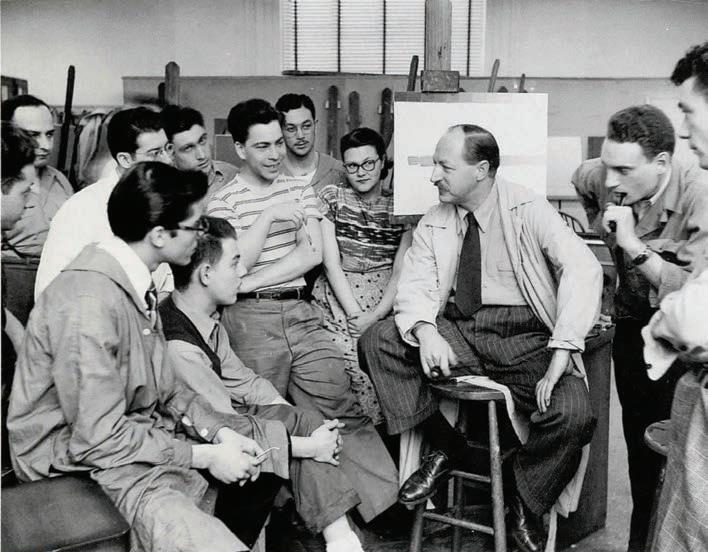
In 1959, Ferren and fellow painter Willem de Kooning settled in adjacent houses in Springs, a hamlet in the town of East Hampton, which was also home to Jackson Pollock and Lee Krasner. The area, known in art circles as the cradle of the Abstract Expressionist movement, provided Ferren with a fertile environment in which he created many of the paintings included in this exhibition.
Findlay Galleries’ exhibit at the 2023 Hamptons Fine Art Fair will focus on artists works of the New York School, particularly the works of John Ferren who performed an influencial role during the movement’s formative years. Other works from Robert Richenburg, Simeon Braguin, John Grillo & Ronnie Landfield will also be on view.

“He is young yet and might, only perhaps nobody can, do that thing called abstract painting” - Gertrude Stein, 1938
EDITORS’ NOTE Manish Sharma is Accenture’s Chief Operating Officer and a member of its Global Management Committee. He joined Accenture in 1995 and became a managing director in 2004. Before assuming his current position in 2022, Sharma served as Group Chief Executive – Operations, overseeing a comprehensive intelligent operations portfolio. He is a strong advocate for inclusion and diversity and founded the Accenture Rural program. He and his wife also have established a trust that focuses on children’s education in India. Sharma holds a bachelor’s degree in mechanical engineering and a master’s degree in operations management from Mumbai (Bombay) University.
COMPANY BRIEF Accenture (accenture.com) is a leading global professional services company that helps the world’s leading businesses, governments, and other organizations build their digital core, optimize their operations, accelerate revenue growth, and enhance citizen services – creating tangible value at speed and scale. Accenture is a talent and innovation led company with 738,000 people serving clients in more than 120 countries. Technology is at the core of change today, and Accenture is one of the world’s leaders in helping drive that change.
What have been the keys to Accenture’s industry leadership and how do you describe the Accenture difference?
Accenture really is unique in a lot of ways and no other company truly occupies the same space we do. Between our technology, assets and the end-to-end solutions we deliver to clients, the depth and breadth of our industry expertise and the incredibly talented people that work here, we are able to create 360° Value. This means that we drive and measure both financial performance and our progress toward our sustainability, talent and inclusion and diversity goals. It’s how we pass on real benefits for our clients, people, communities, shareholders and partners. And I don’t believe any one company can do it the same way that we do.
Will you provide an overview of your role and areas of focus?
I’m Accenture’s Chief Operating Officer and a member of the Global Management Committee. I’m responsible for leading the

company’s global business operations, which includes overseeing the execution of our own Total Enterprise Reinvention. This is a strategy that we’ve adopted across our business, which is different from traditional transformations because we are reinventing every part of our business and doing it all at the same time and at speed – what we call compressed transformation. This allows us to break down the silos that exist in traditional business functions and transform key processes end-to-end, connecting people, technology and data to change the way we work and become more data and insights driven. By doing this, we are improving how we serve our clients and the experience of our people while delivering net benefits to our business and stakeholders.
How do you define Accenture’s culture and values?
Accenture’s culture is based on key values that center around our people, clients and
communities. We prioritize our people and help them to reach their full potential through continuous learning and boundaryless opportunities – while creating a collaborative and supportive environment that is inclusive and diverse, and where we all act with respect and integrity. I believe we have the best people in the world working at Accenture and every day they prove it by providing exceptional service to help improve our clients’ businesses as well as our own. We also have a strong commitment to supporting our communities around the world.
What do you see as Accenture’s responsibility to be engaged in its communities and to be a force for good in society?
It’s something we take very seriously and have several very successful programs and initiatives, such as the Accenture Development Partnerships where we work with various organizations to create social impact and help advance the Sustainable Development Goals. Over the last two decades, we have completed more than 1,900 engagements in nearly 100 countries in areas such as global health and
“Total Enterprise Reinvention is a strategy that we’ve adopted across our business, which is different from traditional transformations because we are reinventing every part of our business and doing it all at the same time and at speed… By doing this, we are improving how we serve our clients and the experience of our people while delivering net benefits to our business and stakeholders.”
nutrition, gender, inclusion and diversity, livelihoods and education, inclusive finance, humanitarian and refugees, agriculture, energy, climate and environment. I’m really proud to be part of an organization that is making such an impact in communities around the world.
How important is it for Accenture to build a diverse and inclusive workforce?
It’s critical to our business, which is why we’ve made it a key part of our strategy. I believe a key reason Accenture attracts such amazing talent is because we treat inclusion and diversity like every other business priority – we set goals, measure, collect data, have accountable leaders who embrace inclusion and diversity and have an action plan. We set a goal for Accenture to be gender-balanced by 2025, in other words, a workforce that is 50 percent women and 50 percent men, for those whose gender is binary. I’m proud to say in 2023, 47 percent of our workforce are women and we are on track to achieve our goal. Through our commitment to inclusion and diversity, it has enabled us to expand our talent pool and bring in the best people, because we know that diversity makes us better and more innovative. It takes all kinds of people to understand who your customer is because your customer is all kinds of people. Inclusion and diversity are essential components for improving the way businesses operate and how the world works and lives. We unlock our people’s potential by investing in them, helping ensure they are net better off and feel a sense of belonging in working as part of inclusive and diverse teams. It also allows us to match their skills with our clients’ needs and highlights the agility we have to evolve those skills over time. We’re a skills-based organization so strengthening our talent pool and leveraging the full potential of data, technology and people is a key part of our own reinvention.
What has made it possible for Accenture to so effectively be able to adapt and evolve during times of global change and uncertainty?
About a decade ago, we set out to become a truly digital company. At that time, we were less than 20 percent in the cloud and within six years we successfully rotated our business to be 70 percent, and today we’re 95 percent in the cloud. We have shifted from a technology landscape of static, standalone parts to a consumption-based composable architecture that allows us to plug and play the best capabilities to stay ahead of the fast pace of technology and business. And because we have a strong digital core built on a secure cloud-based data foundation, we can easily apply AI and other advanced technologies to help us make better, faster decisions during times of uncertainty. We’ve done a lot to strengthen our digital core and have also made big changes to break down silos and connect people, data and processes, giving us a more comprehensive understanding of what’s happening across Accenture. This is enabling us to create a more data and insights-driven culture which is changing how we operate our business and allows us to be more proactive, better mitigate challenges and capitalize on opportunities.
Accenture recently announced that it will be making a $3 billion investment over three years in its Data & AI practice. Why is this significant for your clients?
We know that external forces will continue to disrupt business, and data and AI are absolutely necessary for leaders of large, complex organizations to quickly make decisions and implement them in an efficient way. We’ve been working with AI for a long time and know the value it can bring because we’ve seen it both in our clients’ organizations as well as our own and as the
pace of technology and business continues to accelerate, we’re seeing more and more interest and demand from our clients. This investment will enable us to expand on how we’re helping them responsibly advance their use of AI to grow faster and be more resilient.
You founded the Accenture Rural program. What was your vision for the program and how do you define its purpose?
Rural BPO is an “impact sourcing” program which I initiated at Accenture and continue to develop. This program focuses on creating partnerships with small business process services firms based in rural areas and provides employment opportunities to qualified youths. These opportunities help improve employees’ standard of living and financial independence and provide vital training and mentoring that builds on their existing education, which is key for their long-term success. We are currently in three locations across India and one in the Philippines. Each center provides a sustainable model for driving employment and socioeconomic health in communities and we aim to repeat this model across South and Central America, and South Africa in the coming years.
What do you feel are the keys to effective leadership and how do you describe your management style?
Listening, encouraging learning, being datadriven and, very importantly, creating a sense of belonging with a focus on equality. I try to lead by example while empowering people with the right skills, tools, data, and processes to enable them to deliver value while feeling valued.
You have spent more than 25 years with Accenture. What has made the experience so special for you?
There are so many things that has made my time at Accenture so special, but what stands out the most are the opportunities it has provided me and the people who have inspired me along the way. All the roles I’ve held have given me an opportunity to learn and grow, but none more so than my last year as COO. Other than CEO, I don’t think any other role gives you such visibility across the business and ability to understand every single part of the company and really see what’s happening end to end. It’s incredible. And this has also given me more perspective on the power of data when you connect it across the various functions of the organization and being able to see what it means for all the facets of the business to see what makes business sense for the company. I’m grateful for the experience Accenture has given me and I’m trying to pay it forward by mentoring young leaders.
What advice do you offer to young people beginning their careers?
Learn, learn, learn. Ask questions, seek to understand, build a diverse network of people from different disciplines and stages of their careers that you can learn from. And take every opportunity to discover and try new things –and it’s ok if something doesn’t work out. Those collective experiences are so valuable as you grow in your career.•
“We have shifted from a technology landscape of static, standalone parts to a consumption-based composable architecture that allows us to plug and play the best capabilities to stay ahead of the fast pace of technology and business. And because we have a strong digital core built on a secure cloud-based data foundation, we can easily apply AI and other advanced technologies to help us make better, faster decisions...”
RXR is a leading real estate owner, investor, operator, and developer committed to building socially, economically, and environmentally responsible communities. RXR puts sustainability at the forefront of its approach to investing, property management, tenant engagement and community outreach.
Through environmental policy, energy conservation, social programming, and annual waste auditing, RXR is determined to achieve and exceed our portfolio-wide sustainability goals each year. #Leadingtheway
EDITORS’ NOTE Charles Conn serves as Chairman of the Board of Patagonia and was previously CEO of the Rhodes Trust in Oxford. He co-founded Monograph Capital after having served as CEO of Oxford Sciences Innovation, a deep-science venture firm formed in partnership with Oxford University. He is a technology entrepreneur and former public company CEO (Ticketmaster, Citysearch, Match.com). Earlier, Conn was senior advisor to the Gordon & Betty Moore Foundation in San Francisco. He began his career at McKinsey & Company, where he was a Partner. He is a best-selling author on problem-solving and is a member of The Nature Conservancy’s European Council for Global Conservation. Conn is a graduate of Harvard Business School, Boston University, and Oxford University, where he was a Rhodes Scholar.
COMPANY BRIEF Founded by Yvon Chouinard in 1973, Patagonia (patagonia.com) is an outdoor apparel company based in Ventura, California. A certified B-Corporation, Patagonia’s mission is to save planet Earth. The company is recognized internationally for its commitment to authentic product quality and environmental activism, donating 1 percent of sales annually, contributing over $100 million in grants and in-kind donations since 1985. Patagonia is a worldwide business that makes clothes for climbing, as well as for skiing, snowboarding, surfing, fly fishing, paddling, and trail running.
You serve as Chair of the Patagonia board. What interested you in this role and how do you define the role of a board chair today?
Patagonia is a unique and inspiring company to serve. The example set by Yvon Chouinard and his family over the last 50 years of building a company based in a deep purpose is wonderful –something like this has to be the model for the future. Companies and capitalism have been remarkable drivers of innovation, but at the expense of the environment and communities. It is time to change that.
Every board is different. Being a board chair in Patagonia – led by a visionary founder and a strong CEO – is a straightforward thing. I act as an advisor to CEO Ryan Gellert, and help the board juggle a complex set of objectives. We all work together to guide the company toward its mission of being in business to save our home planet including, since the new company structure was announced last September, its relationship to the Holdfast Collective, the nonprofit we created to distribute dividends to fight the environmental crisis and defend nature.
What led to Patagonia’s decision to become a Benefit Corporation and what impact has it had on the way the company is managed?
Our founder, Yvon Chouinard, has been in the vanguard of a movement to make companies more responsible, to tie their purpose to something bigger than profit. The Benefit Corporation idea is ideally suited to a company like Patagonia, which has always put goals for
our environment, our teams, and our communities alongside being a successful business. We made sure to be the first Benefit Corporation in California – Yvon even put on a tie when he went to register us as a B-Corp.
Will you highlight the process in Patagonia’s decision to make the Earth its only shareholder?
Patagonia has been working on being a responsible company for a long time, both in reducing harm in our operations as a business, and as an activist in the environmental battle. Five years ago, Yvon raised the bar again, changing our mission to something both simple and incredibly challenging: We are in business to save our home planet. In many ways that bold act is what led the Chouinard family to make the Earth our only shareholder last year. The ultimate alignment of walk with talk was to fully commit the company’s resources to the benefit of the planet.
What do you see as the responsibility that leading companies have to corporate citizenship and to be a force for good in society?

I think Patagonia’s actions make it clear that we believe companies have a fundamental responsibility to the planet and the communities in which we live. We need to invest in a regenerative and circular economy if there is to be a future for our children and other living creatures.
How can business leaders find a balance between the short-term pressures for quarterly results and the need to make longterm investments for the future?
At the end of the day that is a false tradeoff and I think we all know it. Short-term

“We all work together to guide the company toward its mission of being in business to save our home planet including, since the new company structure was announced last September, its relationship to the Holdfast Collective, the nonprofit we created to distribute dividends to fight the environmental crisis and defend nature.”
profits that undermine investments in the future will make weaker companies and damage their social license to operate.
What interested you in writing your latest book, The Imperfectionists , and what made you feel the timing was right for the book?
We live in a different world than the one in which most of us learned how to develop
strategies for our companies and nonprofits. We all feel it: change has been accelerating, with greater uncertainty and threat of disruption in every segment. Artificial intelligence, programmable biology, robotics, and other technologies are transforming existing fields and blurring old boundaries. External shocks, from pandemics to environmental crises, cut across borders and impact all organizations, even those that
appear to enjoy structural advantages. In this volatile environment, established approaches to company strategy development don’t work very well. We wrote the book to address this set of challenges, to give leaders confidence to step into that uncertainty.
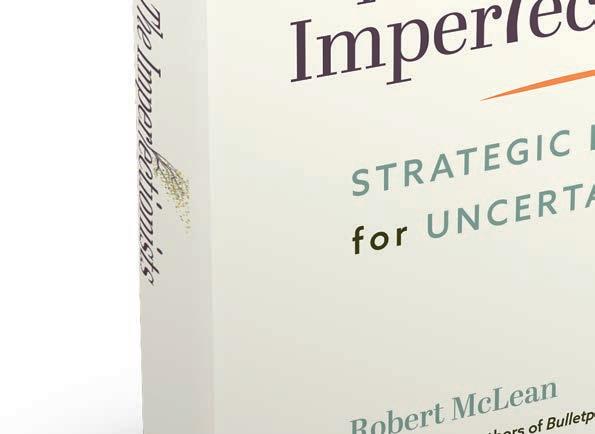
What are the key messages and lessons from the book?


The Imperfectionists puts forward a dynamic approach to developing organizational direction under uncertainty, based on harnessing six reinforcing strategic mindsets, which we call curiosity, dragonfly eye, occurrent behavior, collective wisdom, imperfectionism, and show and tell. Imperfectionists are deeply curious, they look at problems from several perspectives, gather new data via experimentation, and source new approaches from outside their current space. They deliberately step into risk, proceeding through trial and error, utilizing nimble, low consequence, and reversible moves to deepen their understanding of the unfolding game being played, and to build capabilities. They accept ambiguity and some apparent failures in exchange for improved learning and market position. Imperfectionists succeed with fluid, real-time strategic problem-solving, carefully moving forward while others wait for certainty or make impetuous bets.
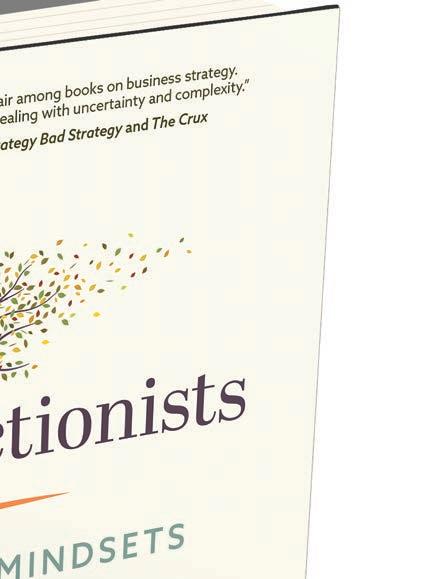
The book is based on a decade of research and 50 new case studies, with examples drawn from both nonprofits and companies.

What do you feel are the keys to effective leadership in today’s quick-changing times?
Our view is that company and nonprofit leaders need to start with audacious goals, such as those we have seen with Yvon Chouinard and Patagonia. Then, they need to be comfortable being curious experimentalists, to step into risk with thoughtful, parallel moves, understanding that some of these will fail. It is critical that frontline teams be given room to develop and test ideas, without fear of punishment. Risk aversion paralysis is the real threat in fastchanging times.
Did you always know that you had an entrepreneurial spirit and desire to build your own businesses?
I have always loved the feeling of being part of building things, especially those that have a strong sense of purpose.
What advice do you offer to young people beginning their careers?
Experiment! I think we have hurt a generation of young people by cultivating a perfection narrative. Everyone should have a learning agenda and a clear set of values – after that, it is critical to get out there and try different roles on. Joy comes from aligning purpose and work.
With all that you have accomplished in your career, are you able to enjoy the process and take moments to reflect on what you have achieved?
Most of what we can achieve we do by working together, not as sole architects. Real partnership with good collaborators is the heart of this. There is much left to do.•

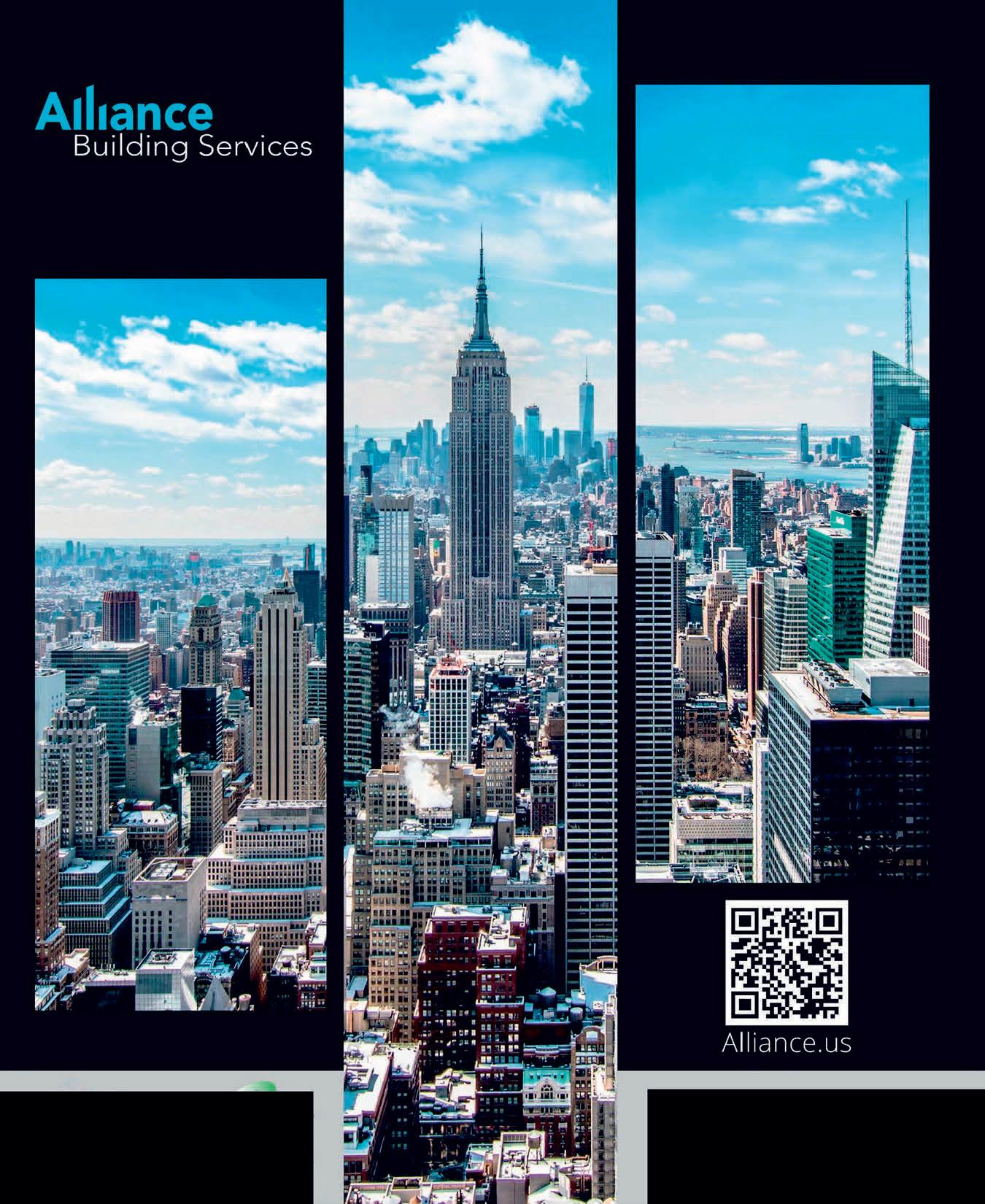

EDITORS’ NOTE Dutch extreme athlete Wim Hof got his nickname ‘The Iceman’ by breaking a number of records related to cold exposure including climbing Mount Kilimanjaro in shorts, running a half marathon above the Arctic Circle barefoot, and standing in a container while covered with ice cubes for more than 112 minutes. Using “cold, hard nature” as his teacher, his extensive training has enabled him to learn to control his breathing, heart rate, and blood circulation and to withstand extreme temperatures. Armed with his motto “what I am capable of, everybody can learn,” he is convinced that everyone can tap into their inner potential without having to invest the same decades worth of study, travel and daring. He has made it his mission to share what he’s learned with the rest of the world and developed the Wim

Hof Method: a combination of breathing, cold therapy, and commitment that offers a range of benefits. With the Wim Hof Method, he teaches people from all over the world, from celebrities to professional athletes, to people of all ages, to control their body and mind and achieve extraordinary things. To know more about the Wim Hof Method, go to www.wimhofmethod.com.
A 35 percent discount code will be applied to Wim Hof’s Fundamentals video course by entering MEDIA35 upon check-out on www.wimhofmethod.com/fundamentals.
Will you highlight how your breathing practice developed?
It started with a search for more than I knew, a soul search that led to practicing esoteric disciplines like yoga, spiritual practices
and so forth. Yet, when I met the icy water, it all changed into practicing in the cold. Breathing exercises I developed from going regularly into the cold naturally induces you to breathe deeply.
What does going into cold water do for you and how do you describe the experience?
Cold water immersion is training the cardiovascular system to perform at its best. It feels like I am creating a silver protective layer around me. The cold to me is an absolute noble force.
You have talked about your need to survive with your four little kids after your wife’s suicide. Will you discuss this tragic moment in your personal life and how it has impacted the course of your life?
It was deep trauma processing, and the
need to find ways to do that effectively. I found that good practice in both cold and breathing plus exercise were excellent to work it all out. Energy wise, I got so much of it through these practices which fulfilled the need to provide physically and emotionally for my family.
Many of our readers are CEOs and business leaders. Some of them may be familiar with you, but many are not. For those who have never practiced meditation or experienced the power of it, what would you like for them to know?
This works! When being an executive with a directive mood, you should be able to perform cognitively while being under stress. This practice works best – try it at least once.
How are your breathing exercises and cold water experience related?

When going into the cold, you by reflex will start to breathe more deeply. Deep breathing triggers the body to be stronger, more adaptive, and alert.
How were you able to take your breathing practice in cold water and adapt it to be effective on land?

It showed very quickly that it made me stronger. As I became aware of that, I started practicing breathing exercises at home, and
it was amazing what it did for me. I had such strong, intense, deep sensations, which became my greatest motivation to do it already for 46 years.
You have said that you “found a spiritual partner in nature.” Will you elaborate on the special relationship you have with nature?
I call the cold my warm friend as it fires up my body when going into the cold as no other practice is able to do. It is a great ally and a great power, preventing disease, both mentally and physically. Cold is my teacher – my great teacher.
You have talked about the fact that you were almost not born and that your mother during your birth said the words, “Oh God, let this child live. I will make him a missionary.” How do those words in many ways describe how your life has played out?
I am a man on a mission and believe my mother invocated that. It is very fulfilling and exciting, while also challenging and full on.
How do you describe the difference in energy between somebody who practices 20 minutes a day of good breathing versus someone who doesn’t?
The difference has been studied and shows that people practicing this have much better mood control during stressful situations.
Healthcare is 20 percent of the U.S. economy. The U.S. spends the highest percentage of GDP on its healthcare, yet it has
some of the worst healthcare outcomes in the world. What are the biggest things that the U.S. healthcare system gets wrong and what do you feel are the keys to building a more effective, sustainable healthcare system?
Simple practices like a cold shower a day plus breathing exercises will give people much more autonomy over their mind and body. The preventative power of this practice toward disease is enormous. We should not be so dependent on doctors, but rather nurse ourselves through the practice of natural, simple breathing and cold water exercise. It has great potential for anyone and it is simple.
It has been said by some that you have a superpower. Do you feel this is true and how do you describe what makes Wim Hof?
I am a driven man who believes in the good in humanity. I challenge myself in nature to find the good within myself and find great tools for humankind. If there is a superpower, it is that I share what I have found – anybody can do what I do. I just keep on and enjoy life to the fullest.•

“The cold to me is an absolute noble force.”
For over 95 years, Alliant has been home to some of the most dynamic and entrepreneurial producers in the business hailing from across the nation and serving in a broad range of industries.
Alliant is the premier place to propel your career to new heights, and the reasons are simple. We give you the resources to succeed. We surround you with outstanding people. Then we get out of your way.

At Alliant, we take ownership seriously and even offer our producers an opportunity to own equity in the company.
Why? Because we believe you should own your success.
EDITORS’ NOTE Tiffani Bova is the global customer growth and innovation evangelist at Salesforce, and the Wall Street Journal bestselling author of Growth IQ . Over the past two decades, she has led large revenue-producing divisions at businesses ranging from start-ups to the Fortune 500. As a Research Fellow at Gartner, her cutting-edge insights helped Microsoft, Cisco, Salesforce, Hewlett-Packard, IBM, Oracle, SAP, AT&T, Dell, AmazonAWS, and other prominent companies expand their market share and grow their revenues. She has been named one of the Top 50 business thinkers in the world by Thinkers50 twice. She is also the host of the podcast, What’s Next! with Tiffani Bova

COMPANY BRIEF Salesforce (salesforce.com) empowers companies of every size and industry to connect with their customers in a whole new way through the power of AI + data + CRM.
Will you provide an overview of your role and areas of focus at Salesforce?
As the Global Growth Evangelist at Salesforce, my role is almost exclusively customer facing. I get the honor and privilege of spending time with our amazing Trailblazer customers looking for best practices and insights that I can share with others in our ecosystem.
How do you define Salesforce’s culture and values?
Salesforce is built on a set of five core values:
• Trust. Trust is our #1 value. It means we act with transparency and lead with our ethics.
• Customer Success. We prioritize our customers’ success and the success of the customers they serve.
• Innovation. We want our products to be the most relevant, easy-to-use, integrated, scalable, and global products out there, delivering a faster time to value for our customers.
• Equality. We are committed to creating a more equal world and believe we are more powerful working together.
• Sustainability. Everything rests on a stable climate, so we’re helping every organization achieve net zero carbon emissions and lead by example as a net zero company.
Guided by our values, we believe that it isn’t enough for businesses to do well – we believe that businesses must do good and use their business as a platform for change.
Since our founding, we’ve continued to invest in our local communities and give back as we’ve grown. One of the ways we use our platform for change is through our 1-1-1 philanthropic model, where we pledge 1 percent of our equity, 1 percent of our time, and 1 percent of our product to giving back to our communities. What we’re most proud of is that 17,000 companies from over 100 countries have joined us in the Pledge 1 percent movement.
We didn’t just do this through rapid growth. We did it with the right values every step of the way. Our values are what’s led us to more than $31 billion in revenue. In addition to being the category leader, we’ve also become a leader in philanthropy, innovation, and culture.

What interested you in writing the book, The Experience Mindset , and what are the key messages you wanted to convey in the book?

After publishing my first book, Growth IQ –a Wall Street Journal bestseller that outlined ten paths to sustainable and repeatable growth, I realized to my dismay that although I had an entire chapter devoted to customer experience (CX), I had not dug deep enough into the interconnectedness of employee experience (EX) and its impact on CX.
Like so many others, I intuitively knew these two were linked, but it wasn’t until 2018, while I was on stage in Vancouver in front of a few thousand people, when it hit me: “Globally, Salesforce is one of the best places to work,” I
Salesforce is also a big proponent for climate action, and we are proud to be a net zero residual emissions company with 100 percent renewable energy across our operations.
Our values are our guiding compass, helping us venture into new places and reach great heights. By making technology more accessible, we’re helping create a future with greater opportunity and equity for all.
What have been the keys to Salesforce’s industry leadership and how do you describe the Salesforce difference?
Together with Salesforce and our ecosystem of customers and partners, Trailblazers fuel a global Salesforce Economy that will create nearly $1.6 trillion in new business revenue and 9.3 million new jobs by 2026, according to IDC, a market intelligence firm. Our Trailblazer community is more than 19 million strong, with more than 2,000 community groups, across more than 100 countries.
We are proud to be the #1 CRM, and we are also now the world’s fastest growing top 5 enterprise software company. In addition to being the #1 CRM provider worldwide, Salesforce is also the #1 market share leader for CRM in North America, Western Europe, LATAM and Asia-Pacific, including Japan.
said. “It is one of the most innovative companies, and it is the fastest-growing enterprise software company.” After pausing to let that sink in, I added: “I don’t think these three things are a coincidence.”
I realized those last words were true as soon as they left my mouth. It followed that there were points of connection – a cause and effect – between employees, customers, and growth, whereby each factor buoyed the others. Standing on that stage is when it occurred to me: pleasing customers was about more than simply “putting customers first;” it has to start with a healthy, engaged and productive employee base to make the vision of an organization come to life.
While many executives have made big claims about the importance of the employee experience to the experience of the customer, where was the research to back up their assertions? Furthermore, if this idea was so obvious, why wasn’t every company building stronger employee experiences as a way to improve CX?
This stark realization began a transformative two-year journey. In the process, I developed a far better understanding of the current state of EX and CX corporate initiatives, the connection between the two, and how a more symbiotic relationship between them could produce a virtuous cycle, resulting in incredible growth results for any company.
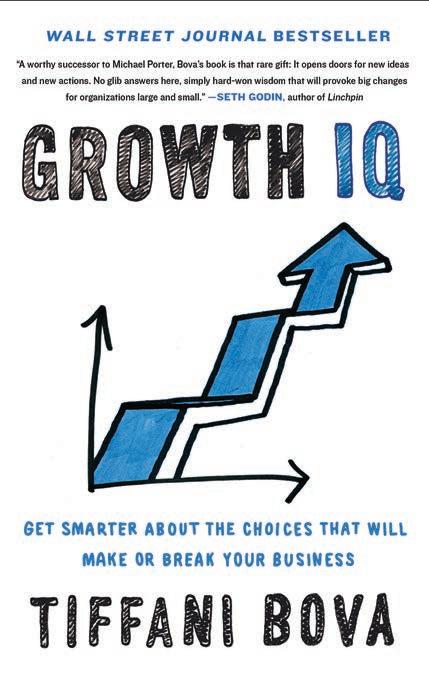
How important is it for companies to identify who owns the employee experience?
There’s a need for a clear champion or team responsible for operationalizing employee data, putting insights into action, and clearly defining what EX means to their organization. Unfortunately, the research showed that 74 percent of the global C-suite surveyed admitted that no one is truly “owning” the employee experience, and 73 percent say they don’t know how to use their employee data to drive change. Without clear direction, developing the right mindset to improve both EX and CX with greater intention becomes almost impossible.
How can business leaders lead a peoplecentered turnaround at a company?
Employees carry the torch every day for the values and mission of their company. They are the facilitators of every moment that matters – the positive connections and negative pain points encountered by a customer or a fellow employee interacting with a brand or employer. There is tremendous value to the bottom line when leaders put people at the center of the business, especially when they are driving a turnaround at a company. Best practices include communicating openly and honestly, fostering a positive culture, investing in employee development including re-skilling, empowering employees with autonomy and decision-making authority, recognizing and rewarding performance, seeking and acting on feedback, and maybe the most important, leading by example.
How critical is it for business leaders to know if they are prioritizing CX at the expense of EX?
I often run through a series of questions when meeting with leaders to uncover current strategic priorities focused on customer experience and employee experience. This allows me to determine whether they have over-indexed CX at the expense of EX or the other way around. Once we can agree that is the case,
the conversation shifts to what can be done to create a more balanced approach. It is critical for leaders to understand how their current priorities are impacting the performance of other parts of the business.
How do people, process, technology, and culture play a role in boosting both EX and CX?
In the early 1960s, business management expert Harold Leavitt formulated a new model on the components of every business called Leavitt’s Diamond Model, which identified three variables – People, Process and Technology [PPT] – which were used for creating change in an organization. I took the liberty to add one more variable – culture – to this multi-dimensional framework creating PPTC. “Building an Experience Mindset” is all about balance and intention between various CX and EX initiatives. Breaking down complex and often siloed efforts across the organization can highlight the interconnected nature of each variable. Focusing on one without considering the others is a recipe for suboptimal performance.
How can business leaders start developing an experience mindset?
I would say there are three things I advise leaders to do:
1. Do an inventory on current initiatives focused on either CX or EX.
2. Identify the top 3-5 KPI (key performance indicators) used to measure performance and the current state of CX and EX.
3. Do a short 3-5 question survey of both customers and employees on aspects of PPTC to uncover where the greatest disconnects exist.
What do you see as the keys to effective leadership?
So many things play a part in effective leadership. However, considering the overarching theme of “The Experience Mindset,” I’d say that asking better questions, listening with more interest, and championing an unwavering feedback loop between the company, its employees, and its customers are keys.
What advice do you offer to young people beginning their careers?
Do not forget about the people – those that work for you and those that buy from you. All those stakeholders that play a part in your success. If you take care of your people, the rest will take care of itself.•
“Employees carry the torch every day for the values and mission of their company. They are the facilitators of every moment that matters – the positive connections and negative pain points encountered by a customer or a fellow employee interacting with a brand or employer.”
EDITORS’ NOTE Ratmir Timashev (ratmirtimashev.com) is a globally recognized entrepreneur, technologist, and philanthropist. He is the founder of Veeam Software – a global leader in cloud data protection and management software, headquartered in Columbus, Ohio, as well as the Kubeshop software incubator. Timashev was born in 1966 in the city of Ufa, the capital of the Bashkortostan region in Russia. He decided to pursue higher education studies in the 1980s in physics and attended the Moscow Institute of Physics and Technology, graduating in 1990 with a master’s degree in physics. Motivated to complete his PhD, Timashev attended the Chemical Physics PhD program at The Ohio State University (OSU) and graduated from OSU with a master’s degree in chemical physics. Timashev is a member of the Fast Company Impact Council, an invitation-only network of leaders and executives that meets throughout the year to discuss issues of importance in business and society. In recent years, Timashev’s philanthropy has brought the Timashev Family Foundation to become a leading supporter of The Ohio State University where he recently donated $110 million to create the Center for Software Innovation, a university-wide center focused on software product management, sales, marketing, and innovation. In April 2022, Timashev and his wife, Angela, were recognized with the Distinguished Service Award at the “Honoring Excellence” ceremony from OSU’s College of Arts and Sciences alongside fellow alumni Governor John Kasich, Jeff Charney, J. Jean Cui, and Zuri Hall.

You came to the United States to study chemical physics at Ohio State and were well on your way towards receiving a PhD, before pivoting to entrepreneurship. What inspired this decision?
When I arrived in the United States to study at OSU, a new world of opportunity had been opened to me – well beyond the chemical physics and non-linear optical science that I was studying. This was the era of the dotcom boom, and while my studies were going well, the internet was calling.
In my earlier years, I was encouraged to center my education around STEM. My parents were both engineers, and I had a natural aptitude for it. As my early career unfolded though,
I began to see how the same problemsolving and experimenting skills I had been honing in on in the lab could be applied in the worlds of business and tech. Creating products and solutions for customers quickly became my hobby, and eventually my life’s work. It couldn’t have been possible without the early support I received from friends, family, and my many mentors at The Ohio State University. What were the keys to your success as an entrepreneur in the early years of the internet?
I always like to say, my entrepreneurial success has been a matter of “right time, right place, brilliant product.” The stars aligned perfectly when I arrived at OSU in 1992. It was obvious that the onset of the digital age was approaching and would transform the world as we knew it. My hard work and determination to be a part of those changes helped shape these early chapters.
While many didn’t think of Columbus, Ohio in the 1990s to be the ideal place to launch a career in tech, it was the perfect setting for me –both professionally and personally. The community is diverse, welcoming, and located in the heart of the United States where you can access nearly every major population center in the country. All this combined to make me feel not only welcomed into the American way of life, but also empowered to be part of its story and future growth.
Most importantly for any entrepreneur, my team and support network helped make it all possible. My business partner and friend is Andrei Baronov, who I believe is one of the most brilliant engineers and technology visionaries of our time. With my background in go-tomarket (GTM) sales and marketing strategy, our complementary skill sets fueled our compatibility as co-founders and the execution of our visions to develop brilliant products. Challenges and obstacles undoubtedly arose in those early years, but together we harnessed our strengths and opportunities to build great products.
Do you feel that entrepreneurship can be learned, or is it a trait a person is born with?
Entrepreneurship absolutely is a skill and mindset to be learned, practiced, and mastered and, in today’s environment where new industries and spaces are being defined through new tech, it’s more important than ever.
Becoming an entrepreneur requires a complex set of traits – creativity, risk-taking, experimentation, problem-solving, leadership, and more. While some people may be born with certain predispositions that make them better suited for entrepreneurship than others, I strongly believe it can be developed through education, mentorship, and hands-on experience. Anyone who is willing to put in the effort and has the right mindset can learn to be an entrepreneur and form a successful business. I also make sure to always reiterate with younger generations that entrepreneurship is needed in established companies as well. We see it all the time with larger corporations struggling to adapt, and this is a key opportunity for innovative younger minds to thrive.
How did the OSU and Columbus community shape your career and eventual success?
Anyone who has stepped foot on OSU’s campus knows there’s something special about the community. The OSU family, and professors, like Dr. Terry Miller and Dr. George McBane, helped me feel a part of this great institution’s history – and its future – from day one. It doesn’t always feel like it, but it was nearly three decades ago when I first arrived with big dreams and a lot to learn about this new language and culture. The mentorship and relationships I formed played an invaluable role in my journey in business and adulthood, which continue to this day. Most importantly of all, OSU is where I met my wife, Angela, who has been my number one supporter and partner. Now whenever we make the quick trip from Connecticut, the American Midwest feels like home – and we’re humbled to be in the position to pay it forward by investing in the next generation.
What inspired you to become involved in philanthropy, and how do you choose the causes and organizations that you support?
The years I spent in Columbus played a pivotal role in my life. Without my time studying at OSU, I’m not sure I would have had the courage or skill necessary to form my companies. So, it only felt natural that I’d use my success and capacity to give back to the community that shaped me into who I am. This has been the underlying idea behind our close partnership with The Ohio State University.
Angela and I, through the Timashev Family Foundation, center our philanthropic efforts around the arts, innovation, and uplifting communities in need, wherever they are in the world. For many years, we’ve seen the impact we can make, from establishing grants and scholarships that support underrepresented individuals in STEM, to funding initiatives that promote access to the arts and culture. We believe that by investing in these areas, we can help pave the way for a brighter and more equitable future for rising generations.
What is your vision for the Center for Software Innovation?
My hope is that the Center will play a pivotal role in transforming Columbus into a flourishing “high-tech mecca,” situated right in the heartland of America. This transformation would not only drive economic development and further bolster the region’s existing momentum, with notable investments from companies like Intel and Google, but it would also showcase the abundant opportunities and advantages that Ohio offers to global brands and innovators.
Software, the Center’s focus, is where the most value creation is going to happen over the next 50 years. In fact, many companies today are essentially software companies. Tesla, for instance, is a software company that manufactures cars, while JPMorgan Chase is a software company that delivers banking services. By providing a comprehensive curriculum, the Center will equip OSU students with essential hard and soft skills, empowering them to establish similarly successful software companies in the future.
The Center for Software Innovation, developed with Ohio State University’s Fisher College of Business and College of Engineering, is just now getting started and is soon welcoming its first cohort of students this Fall. Students will be immersed in an integrated curriculum that leverages industry experiences and hands-on learning, with a focus on the hottest trends in tech – AI, blockchain, cloud computing, cybersecurity, AR and VR, and 3D printing.
For the community, we plan to host conferences and events to not only highlight the talent we already have in Ohio, but also bring in leading voices in technology and innovation from elsewhere. And for budding entrepreneurs, both student and non-student, we are planning to launch a software startup accelerator that will ensure the next great innovations are founded right here in Ohio. Together, we aim to create a positive cycle where the Center is empowering brilliant ideas and leaders across software product development, sales, and marketing – and providing them with the opportunities to succeed in the industry, contribute back into the Columbus ecosystem, and help build a more prosperous, inclusive, and sustainable future for the Midwest.
What advice would you give to young people who are just starting their careers, particularly those interested in entrepreneurship?
In the world of entrepreneurship, focus on satisfying a critical need in the market – a real problem for a real customer. Too often,
innovators get caught up in the excitement of building the latest new thing, without really thinking about who their target customer is or what problem they’re trying to solve. By focusing on a specific problem and a specific customer, entrepreneurs can create a product or service that truly adds value to their lives and can be easily consumed or leveraged. This makes a business more likely to survive and thrive, and it provides a deeper sense of purpose and direction to help stay focused and motivated over the long term.
or products, and can both convey these visions clearly and inspire others to join them. When it comes to executing on vision, effective leaders understand how to set the right priorities for an organization and rally the troops towards the same goal.
Leadership, regardless of where it comes in a hierarchy, requires the abilities to hire the right people, build a team of like-minded people who share your core values, set the goals and priorities and empower employees, and foster a sense of trust, respect, and open communication. This includes actively listening to feedback and ideas from team members and creating a culture of collaboration and innovation.
In terms of my own management style, I start with my end goal in mind: how can I build teams and empower all segments of a company to execute. I do this by prioritizing building strong relationships and taking the time to understand strengths, goals, and challenges of my colleagues. When we have a solid foundation built upon a shared set of values and vision, I strive to foster a culture of continuous learning and improvement – encouraging teams to take risks and learn from both successes and failures. By supporting them, the entire company can make a more successful product – and greatness can come from any corner.
Looking forward, what do you see as the most exciting trends or opportunities in tech, and what is your perspective on the burgeoning rise of AI?
AI is undoubtedly the most significant trend in tech, and our world as a whole. It will likely prove to be the most disruptive technology created since the onset of the internet, and I’m keen to see where its progression leads for all different industries and sectors. AI does not exist by itself. It will become part of any product and service we consume. It has the potential to revolutionize markets and solve many of our most critical global challenges that we face today. Like all other great waves of innovation throughout history, this chapter starts and ends with individual products and solutions – many of which we’re already seeing deployed.
This brings me back to my mantra: “right time, right place, brilliant product.” It’s not luck or serendipity that brings a successful business or team together – even though that helps –but rather a deep understanding of the market and a willingness to put in the hours required to build something truly valuable and unique. Equally important is believing in yourself and surrounding yourself with positive forces and team members who you can have fun with.
What do you feel are the keys to effective leadership and how do you describe your management style?
The most effective leaders are those who have a compelling vision for their organizations
Certainly, there are legitimate concerns about the economic, ethical, and social implications of AI, from issues of bias and fairness to the potential for job displacement and the impact on privacy and security. However, these challenges are precisely why we need younger generations studying the intersection of software and other disciplines – business, philosophy, the arts, soft skills, and more.
With all that you have accomplished in your career, are you able to enjoy the process and take moments to reflect on what you have achieved?
Thankfully, yes. Each day is a chance to cherish being with family, friends, and community. Spending time with our kids going to tennis matches or visiting colleges are just a few of the weekend activities that Angela and I have been enjoying. With summer almost upon us, it’s another great opportunity to remind ourselves to unplug and be present.•
“In the world of entrepreneurship, focus on satisfying a critical need in the market – a real problem for a real customer. Too often, innovators get caught up in the excitement of building the latest new thing, without really thinking about who their target customer is or what problem they’re trying to solve.”
EDITORS’ NOTE Ryan Simonetti co-founded Convene in 2009 with the intention of disrupting the commercial real estate industry and transforming the workplace experience by capitalizing on converging trends in real estate, technology, and hospitality. Simonetti is also the Chairman and Co-Founder of Ease Capital, a digital-first commercial lending platform that combines data, technology, and world-class customer support to streamline the multifamily financing process from end-to-end. His professional career began as a real estate banking analyst in the global real estate group at Lehman Brothers, where he focused on the securitization of commercial mortgage-backed securities. Following Lehman Brothers, he joined Gramercy Capital Corp. as a vice president where he was responsible for the restructuring of a billion-dollar loan portfolio. Simonetti is a Venture Partner at Revolution Growth, a venture capital fund investing in growth-stage companies in the U.S. that are leading disruption within their industries. In addition, he is an active supporter of CoreNet Global and was selected to the board of New York’s Regional Planning Association. Simonetti has been recognized for his transformative achievements on Commercial Observer’s inaugural Power PropTech List; Real Estate Forum’s 50 Under 40 list; Inc. Magazine’s “30 Under 30,” a list of America’s Most Promising Young Entrepreneurs; was named “Top Entrepreneur” by Crain’s New York; and was a finalist in Ernst & Young’s Entrepreneur of the Year® New York Awards. Simonetti, the first in his family to attend college, graduated from Villanova University, where he ran several “start-up” concepts designed for students.

COMPANY BRIEF Convene (convene.com) is a leading hospitality company founded off the simple question: “What if you ran an office building like a hotel?” From there, Convene made it its mission to elevate the way people meet, work, and live by reimagining what “a workday” means for today’s most innovative organizations. Through a network of beautifully designed and tech-enabled meeting, event, and WorkPlace locations, Convene offers a fullservice, premium single solution that transforms workdays into memorable experiences.
What was the vision for creating Convene and how do you define its mission?
Convene was founded in New York City in 2009 under the premise, “What if you ran an office building like a boutique hotel?” Our goal was to bring lifestyle experiences into the workplace, so we partnered with Class A landlords to provide full-service meeting and event venues and hospitality-driven amenities within their buildings. This fundamentally changed the value proposition not only for tenants, but also their employees. In 2018, in response to client demand, we expanded our product offering to include premium flexible workspace solutions. By capitalizing on converging trends in real estate, technology, and hospitality, we’ve built a global network of beautifully designed and tech-enabled meeting, event, and flexible workspace locations that cater to the diverse needs of our clients. How do you define Convene’s culture and values?
At Convene, we’ve always been focused on our “why,” centering ourselves on our core values of G.R.I.T. and our “1 percent better each day” philosophy. G.R.I.T. stands for Genuine, Relentless, Integrity, and Teamwork. It’s the foundation of our company culture and drives us to have the passion and perseverance to pursue our long-term goals while, in the shortterm, focusing on actionable things that make us 1 percent better each day. As a founder, having a strong company culture is hugely important to me and, as a people-first company, making sure every employee at Convene feels engaged, valued, and inspired by a universal vision helps us strengthen our culture internally and deliver exceptional hospitality experiences for clients externally.
What have been the keys to Convene’s strength and how do you describe the Convene difference?
First and foremost, it’s our people. I believe there is a difference between service and hospitality. Hospitality is the emotional, human-tohuman delivery of a service experience. The best hospitality is not scripted – it’s human and authentic. At Convene, we are lucky to have an incredible team of genuine and passionate people that care deeply about our clients and go above and beyond to make sure they have
an incredible experience. It’s that hospitalityfirst mindset that informs every aspect of how we operate, including how we design our spaces. Our locations are aesthetically beautiful, yet thoughtful and human-centered, and our in-house capabilities – from event production to catering and technology services – allows us to provide an elevated, turnkey experience to our clients.
Lastly, it’s our partnership-first strategy with commercial landlords that has helped us grow thoughtfully and in a capital-efficient way. As a premium brand, we know that location and quality are extremely important so we have been very strategic in only providing Convene experiences in Class A buildings, which is a key differentiator amongst our competitive set. Similar to how hotel brands operate, Convene partners with top global landlords to help them amenitize, monetize, and brand their buildings and, in doing so, has established a clear level of credibility and a track record of delivering increased value to the asset while offering unmatched experiences to their tenants.
Where do you see the greatest opportunities for growth for Convene?
Hybrid work is here to stay and I’m extremely excited about Convene’s future. We see tremendous potential to grow the company both organically through landlord partnerships and inorganically through consolidation in the flex workspace industry. In a post-pandemic world, employees are demanding workplace flexibility and as a result, the commercial real estate industry is at an inflection point. We see Convene as the answer. Landlords need to rethink their buildings to create more of a workplace destination that will attract and retain tenants. This means more building amenities, more capital, and more operational complexity – rather than pivoting into a new area of operations, building owners are partnering with hospitality providers, like Convene, to outsource the delivery of a greater workplace experience.
With Convene’s strong presence in the U.S. and U.K., we have built a solid foundation and are continuing to execute on expansion plans into new and growing markets. Given the macro uncertainty and dislocation in the capital markets, our industry is consolidating. Earlier this year, Convene acquired etc.venues – an established leader in urban day
conferencing with venues across the U.K. and New York City – which marked a significant milestone in our international growth strategy. The acquisition added 16 new venues to our global portfolio, making Convene the largest single provider of premium meeting and event venues in the U.S. and U.K. By leveraging our end-to-end solution, we are well-positioned to capture a larger share of the rapidly growing foreign and domestic markets for premium meeting and workplace solutions. With future acquisitions, Convene’s model could move to resemble that of the hotel industry, with one operator at the top and many brands within its portfolio.
What are your views on the future of work and what the office of the future will look like?
The workplace of the future is a meeting space. Despite the rise of remote work, there’s something to be said about the increased productivity, happiness, and connection employees feel when they’re able to come together. Team-based work requires collaboration that can’t be accomplished through a computer screen, or at least not with the same benefits as in-person meetings. It’s time to rethink what “hybrid work” means and re-frame it in the context of “workplace flexibility.” Employees’ expectations of the workplace have fundamentally changed, and flexibility will remain their biggest priority. For organizations embracing hybrid-work, agility will be the top priority as they look to navigate their way through an increasingly dynamic macro environment – where outsourcing their real estate to a provider like Convene allows them to shrink their real estate footprint while also delivering a great experience to their employees – “half the space, twice the experience.”
How critical has it been to build the Convene team and to attract a diverse and inclusive workforce?
We strive to create an environment at Convene where everyone feels valued and empowered to be their true selves. We understand that diverse perspectives are essential to the success of our company, and our diversity, equity, and inclusion efforts encompass a range of initiatives that promote cultural awareness and inclusivity. We are committed to continuing to attract and retain a talented and diverse workforce as we grow and expand our business so that we can better serve our clients and communities.
What do you see as Convene’s responsibility to be engaged in the communities it serves?
As a company, we believe in “doing good” and “doing well” and prioritize being involved in the communities in which we operate and strive to make a positive impact. We engage in a lot of charitable causes in our local markets, such as forming a partnership with Rescuing Leftover Cuisine to donate leftover food to those in need, and participating in fundraising movements like Cycle for Survival.
We also value our role as an employer of choice in the markets in which we operate, and we’re continuously evaluating our existing network of locations in order to best support the needs of our clients, whether it be expanding into new markets or growing our footprint in existing markets. With this comes job creation, which has a direct, positive impact on the community; in San Francisco, for example, Convene at 100 Stockton is set to open this Fall and is expected to create between 25 to 75 jobs.
From a design standpoint, one of our core principles is “act global, think local”. As part of this, we value and appreciate the things that
make a city unique and prioritize these one-ofa-kind attributes when outfitting our locations. For example, Convene at 333 North Green in Chicago was designed to honor the architecture of the Fulton Market neighborhood and features experiential design elements that pay homage to the city’s history, such as nods to the 1893 World’s Fair. By integrating ourselves into the fabric of the communities we serve, we can better meet the needs of our clients and the community at large.

You also serve as the Chairman and co-founder of Ease Capital. Will you provide an overview of Ease Capital’s business?
Ease Capital is a digital-first commercial mortgage lending platform that focuses on providing financing solutions for the multifamily real estate sector. Ease combines data, technology, and a team of expert loan specialists to streamline the multifamily financing process from end-to-end, making it faster, simpler, and more accessible for borrowers to finance their properties.
Did you always know that you had an entrepreneurial spirit and desire to build your own business?
For me, entrepreneurship was part nature and part nurture. Growing up, my father was an entrepreneur and from a very young age instilled in me the importance of dreaming big and working hard. He often shared his wisdom which I think about often, like “be your own boss,” and “don’t let anyone outwork you.” My father’s influence inspired me to pursue entrepreneurship as a path towards realizing my own dreams.
I was also fortunate to solidify my passion for entrepreneurship during college where I partnered with my best friend and co-founder of Convene, Christopher Kelly, to create and run multiple start-up concepts for students. Through these experiences, I discovered that entrepreneurship is not just a professional journey, but a personal one as well. The thrill of building something from the ground up and making a positive impact in the world is what drives me to continue on this crazy journey.
You have achieved much success building and investing in businesses. Are you able to enjoy the process and take moments to reflect on what you have accomplished?
As I’ve gotten older, I’ve made it a point to slow down a bit and really appreciate the journey of building a business and all the milestones that come with it. Like most entrepreneurs, I’m wired to always want to achieve more and immediately jump to “what’s next.” Building a business takes time and isn’t linear, but I’ve learned that the process is what makes each “success” that much more meaningful. Throughout my career, I’ve come to appreciate that each “win” matters and should be celebrated in some way big or small, not only for myself, but for the larger team around me that makes everything possible. I’m always focused on pushing forward, innovating, and creating, and the process of setting goals and seeing them through is deeply rewarding.•



Tony Markel began his career with the Markel organization in 1964 upon graduation from the University of Virginia McIntire School of Commerce with a major in Economics. He was promoted to Vice President in 1970 and assumed responsibility for the management of Markel’s wholesale brokerage operation in 1975. Markel was named Executive Vice President of Markel Corporation in 1977 and named President and Chief Operating Officer in March 1992. In January of 2009, he was named Vice Chairman. He was a member of the Board of the National Association of Professional Surplus Lines Organization (NAPSLO now WSIA) from 1978 to 1983, serving as its President in the last year. He also served on the Board of the National Association of Independent Insurers (NAII now PCI) from 1988 to 1993, serving as Chairman of the Surplus Lines Committee in 1993. In 2004, he was honored as a recipient of the Ernst and Young Entrepreneur of the Year Award. In 2005, Markel was awarded the Charles A. McAlear Award by NAPSLO for long and outstanding service to the Surplus Lines Industry. In 2006, he was awarded the City of Hope Spirit of Life Award for his notable contributions to the insurance industry and his community, and in 2011 was awarded the Vince Donahue Lifetime Achievement Award by the American Association of Managing General Agents (AAMGA). In May 2014, Markel was inducted as a laureate into the Junior Achievement Richmond Business Hall of Fame, recognizing his success and leadership in the insurance industry and community. In 2016, he was named as one of the 30 most influential business leaders in Richmond over the last 30 years by the Richmond Times-Dispatch and in January 2017, Markel received the “2016 Insurance Leader of the Year” Award by St. John’s University’s School of Risk Management, part of the Peter J. Tobin College of Business. In September 2017, he received the Lifetime Achievement Award by Reactions Magazine . Although semi-retired, he stays active as a Director of the Company and accepts a variety of special assignments from Markel’s current leadership. Continuing his family’s history of philanthropy, Markel’s

noteworthy charitable causes have included Faison School for Autism; Alzheimer’s Association; University of Virginia; American Heart Association; Cullather Brain Tumor & Quality of Life Center; Goochland Family Services; Special Olympics of Virginia; and, United Way of Greater Richmond Alexis de Tocqueville Society. In addition, he was the National Chairman of the $1 Billion Centennial Power of Hope Campaign for City of Hope, an NCIdesignated Comprehensive Cancer Center in Duarte, California, which successfully reached its goal in January 2014. His current projects include the Markel-Friedman Foundation for Ovarian/Peritoneal Cancer Research (at City of Hope); the Richmond SPCA’s full-service veterinarian clinic (named for his departed wife); and, Operation Healing Forces, an initiative started by his brother, Gary, that provides therapeutic retreats for wounded Special Operation Forces and their spouses. Presently, he serves as a member of the three-person steering committee in the current Naples Community Hospital’s $350 million campaign.
COMPANY BRIEF Founded in 1930, Markel (markel.com) is comprised of the following major operating units: Markel Specialty, Markel International, Markel Global Reinsurance, State National, Nephila Capital, and Markel Ventures. Markel maintains 61 offices in 16 countries. The insurance operations employ approximately 5,000 employees (with another 15,900 employees at Markel Ventures companies) and underwrite approximately $9.8 billion in gross premiums annually.
Will you highlight the history and heritage of Markel?
Given the fact that Markel is within seven years of celebrating our centennial anniversary, a review of our history would be timeconsuming, and probably, boring. Touching the highlights over this 93-year period, however, can provide a little bit of insight into our history and heritage. Founded in 1930 by my grandfather, Sam, the first 25 years in business was as an insurer of hard-to-place transportation risks. We converted to a managing
general agency in roughly 1955, still specializing in the same class, and it wasn’t until 1980 that we reinvented ourselves back to a risk-bearing insurance company, but with a much broader array of products, mostly commercial property, casualty, and professional liability. We were a private, familyowned business from 1930 to 1986 when we took the company public in order to provide liquidity for the growing number of family members who didn’t work for, but had equity in the company, as well as provide us with a platform to raise capital for future expansion. We are the product of four generations of management, the first three being Markel family members, initially my grandfather, followed by my father and his three brothers, and ultimately, myself, my brother, and two cousins. We were succeeded by the first non-family members, Tom Gayner, Richie Whitt, and Mike Crowley, with Tom rising to CEO with the retirements of Mike and Richie. Insurance was our only business until 2000, when we acquired a bakery equipment company as part of our investment portfolio. This was the foundation of what is known now as Markel Ventures, an amalgamation of some 23 wholly owned, disparate companies, which now generate about one-third of our corporate revenue. Worthy of note is the fact that our operations, with one small exception in Canada, were limited exclusively to the United States until the early 2000s when we acquired a London-based insurer, Terranova, which provided a platform into the international marketplace, spreading our geographic footprint to the current 61 offices in 16 countries. The constant through all of this change and almost a century has been the focus on specialization and market leadership along with family values, and a commitment to the individual, be it employee, channel partner, or client.
How do you describe Markel’s culture and values?
Very simply, The Markel Style. As I mentioned in the previous answer, the overriding focus at Markel is people and relationships. Back in 1980, recognizing that we had evolved into an organization with a unique culture, we set out to capture it in words, and the result from an original draft, written by Alan Kirshner, edited by Steve Markel, and me, was The Markel Style. It has been our
guidepost for over 40 years now and continues to be the guidepost which influences all of our decisions and strategic direction.
The Markel Style, our long-standing statement of values, is as follows:.
• Markel has a commitment to success. We believe in hard work and a zealous pursuit of excellence while keeping a sense of humor. Our creed is honesty and fairness in all our dealings.
• The Markel way is to seek to be a market leader in each of our pursuits. We seek to know our customers’ needs and to provide our customers with quality products and service.
• Our pledge to our shareholders is that we will build the financial value of our company. We respect our relationship with our suppliers and have a commitment to our communities.
• We are encouraged to look for a better way to do things – to challenge management. We have the ability to make decisions or alter a course quickly. The Markel approach is one of spontaneity and flexibility. This requires a respect for authority, but a disdain of bureaucracy.
• At Markel, we hold the individual’s right to self-determination in the highest light, providing an atmosphere in which people can reach their personal potential. Being resultsoriented, we are willing to put aside individual concerns in the spirit of teamwork to achieve success.
• Above all, we enjoy what we are doing. There is excitement at Markel, one that comes from innovating, creating, striving for a better way, sharing success with others – winning.
What have been the keys to Markel’s industry leadership and how do you describe the Markel difference?
Although I think our bead on specialized niches gives us the ability to serve our customers and channel partners better than some of our more generalized competitors, it’s become more and more difficult to differentiate coverages and products. Our difference? I would have to, once again, highlight our people and their commitment to The Golden Rule, giving us a competitive advantage – oversimplistic, perhaps, but nonetheless, true. From The Markel Style, “Being results-oriented, we are willing to put aside individual concerns in the spirit of teamwork
to achieve success.” As it relates specifically to insurance, if I had to describe one operational standard that I think provides some differentiation, it would be our unwavering focus on underwriting profit that provides the foundation for an investment policy that is not riskaverse and enables us to produce superior returns for our shareholders.
Will you provide an overview of Markel’s offerings and solutions?
From the insurance side, it is a classic array of commercial coverages – casualty, property, excess, inland marine, professional liability, etc. that make up typical excess and surplus lines solutions. The major addition to those offerings is our partnership with Hagerty on classic antique and collector cars and boats. As the world leader in that marketplace, the legacy of specialization at Markel continues. The major diversification, corporately, over the last couple of decades has been the growth of Markel Ventures, and the companies that currently make up that division, including bakery equipment manufacturing, mobile home parks, residential construction, technology systems integration consulting, ornamental plants, upscale women’s handbags, and building supplies, just to name a few of the market sectors that we now participate in.
How important is it for Markel to build a diverse and inclusive workforce?
Just like any organization of size, it is critical to attract people with different backgrounds, perspectives, cultures, and viewpoints if you want to build a strong, resilient fabric. Given our family roots, I think we have always sensitively strived for diversity on all fronts. In an effort to even further strengthen our commitment in this regard, we have become even more aggressive in reaching out, proactively, to increase our pool of minority applicants with much broader advertising and promotion, highlighting our many attractive career paths. As a result, our current roster reflects even more DEI, and has fostered advocacy networks representing virtually every minority group. As I’ve said earlier, albeit trite, people are our strongest asset, and the diversity that we have always had, and continue to seek, further steels our performance.
What do you see as Markel’s responsibility to be engaged in the communities it serves?
Corporate responsibility and philanthropy have always been a part of our makeup. The expectation of personal community involvement by the leaders at each of our locations is clearly part of their job description and responsibility. As we have continued to grow, becoming a major employer in each of our locations, this aspect of our commitment has become even more focused. The example that our leaders provide with regard to corporate philanthropy along with their personal involvement has fostered tremendous volunteerism by our entire employee base. I can tell you there are always some causes, some charities, some community service, that are being touted and supported by our associates. In addition to being personally gratifying, it enhances our image as a responsible, philanthropic employer, worthy of a “look-see” by potential candidates for employment. As The Markel Style iterates, “We respect our relationship with our suppliers and have a commitment to our communities.”
What has made the insurance industry so special for you?
First and foremost, you can tell by my size, it has provided me at least three-square meals a day. Beyond that, it’s a wonderful industry that provides necessary financial security, inhabited by friendly competitors, and the potential to develop lifelong friends. Plus, the simplicity of the fundamentals of property and casualty insurance, coupled with my personal good fortune, shows it, obviously, doesn’t take a rocket scientist to succeed. As the Markel Style says, all it takes is “hard work and a zealous pursuit of excellence, while keeping a sense of humor.”
What advice do you offer to young people interested in building a career in the industry?
Since it’s a commodity that everyone needs for financial security, the key is to be able to differentiate yourself from your competitors. Quoting The Markel Style again, “we seek to know our customers’ needs, and to provide our customers with quality products and service.” If you enjoy people and are willing to go the extra mile, the property and casualty insurance business will offer a wonderful career path. “At Markel, we hold the individual’s right to selfdetermination in the highest light, providing an atmosphere in which people can reach their personal potential.”•
“Back in 1980, recognizing that we had evolved into an organization with a unique culture, we set out to capture it in words, and the result from an original draft, written by Alan Kirshner, edited by Steve Markel, and me, was The Markel Style. It has been our guidepost for over 40 years now and continues to be the guidepost which influences all of our decisions and strategic direction.”

EDITORS’ NOTE Nancy Davis is the portfolio manager for the Quadratic Interest Rate Volatility and Inflation Hedge ETF and the Quadratic Deflation ETF. Davis began her career at Goldman Sachs where she spent nearly ten years, the last seven with the proprietary trading group where she became Head of Credit, Derivatives and OTC Trading. She has been the recipient of numerous industry recognitions. Barron’s named her to their inaugural list of the “100 Most Influential Women in U.S. Finance.” Institutional Investor called her a “Rising Star of Hedge Funds.” The Hedge Fund Journal tapped her as one of “Tomorrow’s Titans.” Davis writes and speaks frequently about markets and investing, and has been profiled by Forbes, and interviewed by Barron’s, The Economist, The Wall Street Journal, and The Financial Times, among others. She is a frequent guest on television including CNBC, Bloomberg, CNN, CBS, and ABC.
FIRM BRIEF Quadratic Capital Management LLC (quadraticllc.com) is an innovative asset management firm founded in 2013 by Nancy Davis. The firm has utilized its significant expertise in the interest rate volatility and options markets to construct IVOL in a way that helps mitigate the downside risk of the strategy while maintaining upside potential.
What was your vision for creating Quadratic Capital Management and how do you define the firm’s mission?
My vision was to be the first to bring options and hedging strategies usually found in private funds to the public markets, essentially democratizing them. Before Quadratic launched

IVOL, most fixed income investors had no choice but to be short convexity and short volatility. Our mission is to give regular fixed income investors long convexity and long volatility in an exchanged traded fund in a potentially tax-friendly wrapper with no lockups at a fraction of the cost compared with private fund vehicles. Will you provide an overview of Quadratic Capital’s business?
Quadratic is an innovative asset management firm that manages the portfolios for two exchange traded funds – IVOL and BNDD. Our investment approach is based on our expertise in investing through options. We like to buy options because we like to stay on the asymmetric side of the trade, where the potential upside is larger than the maximum downside. A lot of firms that trade options are actually in the business of selling them. The problem with selling options is when you sell an option, you’ve given someone else control over what and when you have to buy.
Most fixed income investors are only short options because the bond benchmarks have a large weight towards mortgages. If you invest in a mortgage, most of the time you own an agency obligation combined with a short option. U.S. homeowners are long the option to pre-pay but if you own the financial mortgage, you’re short options to homeowners, and whenever you’re short options, you’re short volatility.
I think of our funds as solutions to problems most investors must either confront or ignore. For example, our IVOL fund helps investors with their embedded short volatility position. Our BNDD fund helps investors who are concerned that the U.S. economy is in a prolonged slump.
What have been the keys to the strength of Quadratic Capital and how do you describe the Quadratic Capital difference?
Our funds solve several problems for investors. For example, our IVOL fund helps investors deal with the embedded short volatility from their mortgage-backed securities. It has offered very low correlations with – and therefore helps diversify – the major stock and bond indices. It has provided very consistent, tax-efficient income without taking on corporate credit risk.
Our success is largely a function of the innovations we’ve brought to market. But we don’t innovate for its own sake. We’re trying to solve specific problems facing investors. Using options as a core element of our funds is a major difference.
What do you see as Quadratic Capital’s responsibility to be engaged in the communities it serves and to be a force for good in society?
Our funds can be very helpful for working people all over the country. Higher inflation hurts everybody, but it hits people on fixed incomes and limited budgets harder, and people who are not qualified investors don’t have a lot of ways to deal with it. Our IVOL fund is designed to help hedge against inflation, to protect purchasing power. And it works just the same in a teacher’s 403(b) as it does in an account at any exclusive private bank.
I am a big advocate of having this hedge against inflation to fight the loss of purchasing power and I believe we have democratized the market for any and all investors with our funds.
Did you always know that you had an entrepreneurial spirit?
“My vision was to be the first to bring options and hedging strategies usually found in private funds to the public markets, essentially democratizing them.”
I’ve worked for some really talented people over the years, and I tried to learn as much from them as I could. Quadratic is my attempt to put together all the best lessons that I learned during my time on Wall Street. It’s been exciting and rewarding and a tremendous amount of work.
Quadratic Capital has accomplished much in its ten years of existence. Are you able to enjoy the process and take moments to reflect on what you have built?
I’ve always enjoyed the process. It’s been quite a journey and I try to savor it, but I’d say I’m never satisfied; I always want to be on that soapbox on a daily basis educating investors. It doesn’t even feel like work because I love what I do. That passion drives my desire to advocate and educate.
Do you feel that there are strong opportunities for women to grow and lead in the industry?
Yes and no. When I was at Goldman, I was given a lot of responsibility very quickly and allowed to keep growing. As well, from my experience there has been a recent push for greater diversity in the financial world, and I personally have always tried to be very supportive of talented people in the industry, women and men. That said, there aren’t a lot of women-owned asset management firms in the world. With the big push to make sure there are women on corporate boards, I don’t understand why there isn’t a push for more womenowners. If you buy the argument that having people of different backgrounds and different ways of thinking makes for a better process and
outcome, then surely more investment should be made to support women owning and operating their own businesses.
What advice do you offer to young people interested in a career in finance?
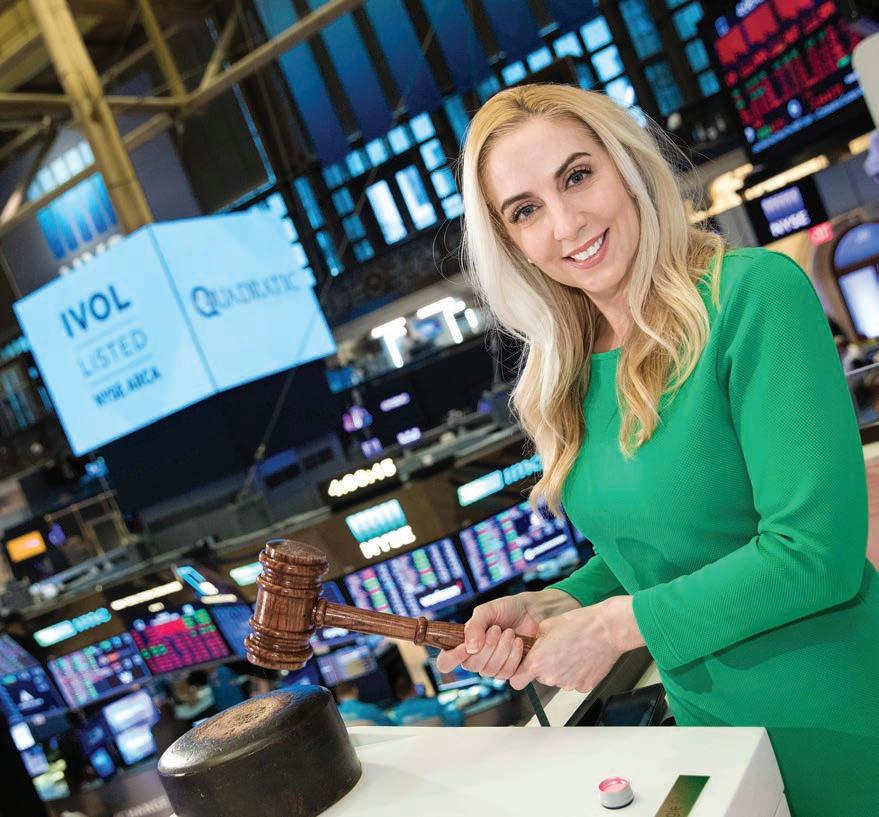
Don’t major in finance or business administration. I am a big believer in liberal arts education. If you go to work at a bulge bracket bank, they will teach you everything you need to know. Learn about the world, and how and why it came to be what it is. Study what smarter people than you thought and wrote about what it means to be a human and what is important and worth studying and what isn’t. Not only will you be much more interesting to talk to, but you’ll be a better investor, too.
I also say that if people get into finance to make money, that is definitely the wrong reason. Do something because you love it –whatever that is – and you will usually outperform people doing that same thing for money.
What do you see as the keys to effective leadership and how has operating Quadratic Capital affected your views on leadership?
Well, there are lots of ways to be a good leader, but there are some common traits. First, you have to have a clear vision of what you want. If you’re a leader, that implies that you’re leading towards something. Leaders are always focusing on tomorrow and let their teams take care of today. If you’re just holding down a seat, it’s hard to be a leader.
Then I think you must be a communicator. You may know what you want to do, but if you can’t get your team to believe it or see it with you, it will be very challenging to motivate that group to its peak. And that includes listening. Leaders need to understand what is really going on around them. It’s easy to sit in a corner office and have a Mr. Smithers from the Simpsons tell you, “Gutsy decision, sir” after everything you do. But you’ll make bad decisions that way.
Lastly, I think you’ve got to be a worker. You’ve got to put in the hours. I am a big fan of the band Whiskey Myers. They have a song called “The Wolf” and the chorus includes the lines, “I’ll be prowling while you sleep. You’re playing for fun but I’m playing to eat.” I love that line. I think that’s the correct mentality. You need to be the first car in the parking lot, the last computer monitor turned off. You can’t ask people to work harder than you do. Well, you can, but they won’t. •
“I think of our funds as solutions to problems most investors must either confront or ignore. For example, our IVOL fund helps investors with their embedded short volatility position. Our BNDD fund helps investors who are concerned that the U.S. economy is in a prolonged slump.”
EDITORS’ NOTE Michael Crow continues to lead Arizona State University, one of the country’s largest universities, in a wholesale transformation, including one of the largest and best online education programs in the nation. Crow, the former chief strategist of Columbia University’s research enterprise, became the president of ASU in 2002. He brought with him a vision for designing a new kind of university – one capable of simultaneously providing broad access and comprehensive excellence – a goal which many said was impossible.
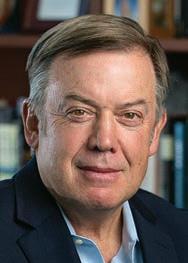
Over the next two decades, Crow drew from his experience as a student, professor, science and technology policy expert and higher education leader to guide a culture shift that has rapidly reinvented ASU as a model 21st century university. Through his leadership and the efforts of the university community, ASU has been recognized as “#1 in the U.S. for innovation” for eight consecutive years. ASU was also the inaugural recipient of the American Council on Education Award for Institutional Transformation, and in 2010, TIME magazine named Crow one of America’s “10 Best College Presidents.”
In his former role as Executive Vice Provost at Columbia, Crow led technology and innovation transfer operations, established Columbia Innovation Enterprises (subsequently renamed Science and Technology Ventures), the Columbia Strategic Initiative Program, and the Columbia Digital Media Initiative, while advancing new interdisciplinary programs. He led the creation of and served as founding director of Columbia’s Earth Institute, and in 1998, founded the Center for Science, Policy, and Outcomes (CSPO) in Washington, D.C., a consortium of scholars and policymakers dedicated to linking science and technology to optimal social, economic, and environmental outcomes. In 2003, CSPO reemerged at ASU as the Consortium for Science, Policy, and Outcomes, based in both Phoenix and Washington, DC.
Crow has advised the U.S. Departments of State, Commerce, and Energy, as well as defense and intelligence agencies. He serves as Chairman of the Board for In-QTel, and has counseled several nation-states on matters of knowledge enterprise development. An elected fellow of the American Association for the Advancement of Science, the National Academy of Public Administration, and the American Academy of Arts and Sciences,
Crow is the author of books and articles analyzing knowledge enterprises, science and
technology policy, and the design of higher education institutions and systems. He coauthored Designing the New American University, outlining the imperative for new and creative public university models that advance both academic excellence and broad accessibility, and The Fifth Wave: The Evolution of American Higher Education, which introduces a new class of large-scale public universities capable of educating greater numbers of qualified students and accelerating positive social change.
A member of the U.S. Council on Competitiveness and the Council on Foreign Relations, Crow is also a two-term member of the National Advisory Council on Innovation and Entrepreneurship and has served on the U.S. Department of Homeland Security Academic Advisory Council. Crow graduated from Iowa State University and earned his PhD in Public Administration (Science and Technology Policy) from the Maxwell School of Citizenship and Public Affairs, Syracuse University.
You left Columbia University to lead Arizona State University more than 20 years ago. What excited you about the opportunity and made you feel it was the right fit?
Columbia, of course, was and is a tremendous teaching, learning, and discovery institution of the highest order. But being in New York City at Columbia, I saw the intense need for an institution deeply focused on research and access. Having gone to both a public university and a private university, I was broadly experienced in how different universities worked. I was acutely aware of the fact that universities were, in spite of all of their achievements, poorly designed for the kinds of transdisciplinary research that would be necessary to tackle challenges like sustainability and global climate change. They were also very difficult to scale across the broad spectrum of learners that actually exist in the population.
A number of authors then were exploring why universities couldn’t do more for our society. Frank Rhodes wrote a book called The Creation of the Future, about what we needed to do to lay down tracks for the future that our democracy really needed to achieve and how universities like Cornell, where Frank had been president for many years, were only able to do so much with the model that they had. Another writer at the time, University of Michigan President Jim Duderstadt, laid out the concept of the university for the 21st century.
In all of these conceptualizations, it all came down to design. So when thinking about where one might help design a new kind of American university, I thought about three places where one could possibly do this. One was metro Seattle in Washington state, owing to the highly innovative nature of the local culture in Seattle which led to the creation of lots of different companies – Amazon, Starbucks, Microsoft, Boeing, Costco, and so on. The second place was the Front Range of Colorado, which in the literature is identified as a large source of public and democratic innovations that have then swept across the country. The third place was Arizona State University. I thought of Arizona because of its newness, its deep commitment to entrepreneurial thinking, and its openness to new ideas and new people – all of which I had some understanding of, having been a consultant here for a while.
Initially, none of those jobs were open, but then Arizona State came open and I was selected. They were looking for innovation, so I had a real opportunity here to build a new kind of American university. ASU was the place I could make it work.
What have been the keys to ASU’s leadership and how do you describe the ASU difference?
I think ASU has separated itself by allowing cultural change to occur. We have been transformed from a faculty-centric institution to a student-centric institution – that is, the purpose of the institution is to serve the student and to enhance outcomes in the community, not just to provide a place for the faculty to be great academics, or scientists, or creators.
The second key has been a willingness to have leadership help set the design parameters for the culture change to become specified. To that end, we derived a three-part charter: that the university will measure its success based on who we include, versus who we exclude, and how they succeed; that we will measure our success from our research based on the benefit to the public – have we made the place better, have we made it more sustainable, have we made it more equitable; and lastly, have we designed the institution so that we are taking responsibility for the outcomes of the communities that we serve?
The interesting thing, in terms of the keys to ASU’s leadership, has been this openness to the transformation of the objective function of
the institution. That openness has led to a number of new and differentiated innovations. We are willing to be self-aware, to vary from the norm, to differentiate, to focus on excellence across a very broad spectrum of activities, and to accept technology as a way to enhance the academic process. As an example, we have five times as many graduates as we used to have. We have what must be 30 times the number of learners that we used to have if you total them all up, including people not involved in degree programs. We’ve grown engineering from 6,000 students to 30,000 students over the last decade. We’ve doubled the four-year graduation rate. We’ve expanded the diversity of the institution. We’ve increased sevenfold our research expenditures and our research portfolio. We’ve done all of that because we’ve embraced technology, embedded technology, and built a culture of continuous innovation.
Universities are, at their heart, knowledgeseeking organizations, and we’re no different in that regard. We live by the 2,500-year-old sort of models of Plato’s Academy and the precursors to that Academy, centered on free and open discourse. We have practiced and maintained all of those things. I think the difference is our acceptance of that, while at the same time being willing to innovate. How do you protect academic freedom while still enhancing performance and productivity? How do you build a student body which is as diverse as the population? How do you take students from every family background – from rural Native American communities with no electricity and no water to rich suburbanite kids – bring them all into the same institution, and have them succeed? Those things are all a part of this difference.
So the institution is different by design. It’s different in its culture, and different in the rate, speed, trajectory, and integration of technology into the innovation process.
Will you discuss ASU’s transformation journey?
All universities and colleges have their complicated creation stories. In the case of ASU, we were created in the mid-1880s as a territorial teachers academy. Our assignment at the time was to produce teachers for this pioneer region, which was not yet a state – that didn’t occur until 1912. We continued in that role through many iterations until the late 1950s and early 1960s, when there was a move to create a second university in Arizona. That move had been resisted to that point out of political fears and economic funding fears for the university model. But around 1960, by public plebiscite, Arizona State University was voted into existence by the people of Arizona.
What’s really important about that, and what gave great license to our model as a New
American University, was the vote by the people meant that it was an institution centered on and driven by the interests of the people. So the people of Arizona – over the head of the regents, over the head of the legislature, and over the head of the governor – said, “No, we’re not going to keep Arizona State College as a teachers college. We’re going to create a full-scale university.”

The design of the university itself – namely, the maintenance of egalitarian admissions standards – was a major driver of our transformation. In that time, ASU had low graduation rates – with scarce resources, there were no technologies and very little training for the faculty – which eventually led some to label the institution as the world’s largest party school. I don’t know what that label meant or whether it was fair or not, but I do know that the university in that 20-year timeframe was really struggling to get going.
By 1980, as a part of its maturation process, the university started the process of building a research culture. This is very, very late; it would make us one of the youngest research universities in the world. It took ten years to get that design in place. Then in 1991, my predecessor, Lattie Coor, took on the process of designing the fundamental beginnings of ASU as a research university. In 1994, we became what’s called a research one university, meaning we hit the threshold of the lowest level of research expenditures to be classified as a first-tier research university – basically yesterday in university parlance.
When I was appointed in 2002, I was allowed by the board that appointed me to outline the model for the New American University. I outlined eight design aspirations, including intellectual fusion, meaning we don’t need to just build universities of the same intellectual design: we need new departments, new schools, and so forth. Another design aspiration was to value use-inspired scholarship. All that was doing was laying down track so that basic research would be not superior to, but equal to, use-inspired research in the culture of the university that we were designing. We presented this transformation process in the charter of the university, then these eight design aspirations – which in 20 years have grown to be nine – became the self-actualizing, aspirational goal of the institution.
This is a key part of the changing of the culture. Inclusion versus exclusion. Research that makes a difference for the people that we
“Universities have to figure out how to innovate. They have to figure out how to do things in a new way. They have to figure out how to educate across a broader spectrum of people.”
serve. Taking responsibility for the communities that we serve. What that means is: let’s say the K-12 system is underachieving, which it is. We’re partially responsible for that. We may even be largely responsible for that and need to focus on it. If the local environment is not sustainable – which it isn’t – then how do we take responsibility for that and see what we can do to enhance those outcomes? These are all a part of this transformation journey.
Beyond the charter, the design aspirations become, in a sense, the things that you want to make the institution unique. This is really important: the last thing the world needs is more universities that do the same thing. We need differentiation in design, differentiation in intellectual purpose.
To make all of that happen, the last part of our transformation journey was the design of a unique institution. We eliminated 85 schools, departments, and colleges. We created at least 35 new transdisciplinary schools – a School of Sustainability, a College of Global Futures, a School for Complex Adaptive Systems, a School of Human Evolution and Social Change. All of those new units contributed to the building of a new intellectual agenda.
I think along the way, while doing all of these things, we found a way to transform faculty from academic bureaucrats into academic architects – designing new programs and building many degree programs, rather than protecting a few degree programs. So the transformation journey has been one of faculty empowerment, cultural change, technological innovation, the design of new concepts for innovation, and then bringing all those things together to help this thing work.
How is ASU building the model for the 21st-century public research university?
The new model – what we call the fifth wave or the New American University – is a model for universities which builds upon the thousands of institutions that have been created in four previous waves of evolution.
Wave one was America’s Greek academies – the colonial schools like Dartmouth, Columbia, or Princeton when they were narrower as colleges. Wave two was the late 18th and 19th century development of public colleges and universities. Wave three was the unique, American design of the land grant schools: UC Berkeley, University of Illinois, Cornell University, Michigan State, Purdue, Iowa State. Great schools like that all over the country,
all designed to focus on American agricultural and industrial success, taking on students from the broadest set of families possible. Then the fourth wave, which is also uniquely American, was the design of the American research university, starting at Johns Hopkins in 1876 and moving on around 1890 to Stanford and the University of Chicago. When those three institutions got going, everybody else broke ranks. Harvard became a research university. Columbia became a research university. Princeton became a research university. Michigan, California, and other schools all became research universities. Around 15 or 20 of these got going before World War I, and they became then the core of this kind of university.
Now, what happened along the way is that these research universities in that fourth wave tended to become increasingly elitist in their admission standards. Then the public universities in the second wave, including the community colleges, increasingly became access-oriented, with low graduation rates and all kinds of faculty, organizational, and performance complexities. Lots of arguments emerged for a new kind of university.
So, ASU is building the model for a 21st century public research university around the notion of scaled research across as many subjects as possible, including and in particular those subjects of importance to the well-being of our country and planet that are not necessarily being done by industry or government. We’re trying to take on more unique roles and concentrations of research activity to benefit the local region, like our Water Innovation Initiative here in Arizona.
The 21st century public research university of the type that we’re talking about – wave five, the large-scale university – is also accelerating the use of technology to educate more learners across a broader time horizon of their life. In the semester that opens in the fall of 2023, we’ll have about 83,000 students on campus pursuing degree programs. We’ll have about 100,000 students online pursuing degree programs, designed and overseen by our faculty with input from our own internal shop.
We also have, in the spirit of inclusion, students from every background imaginable with very limited financial barriers. On top of that, we will shortly have 500,000 additional learners, who are not enrolled in degree programs but who are learning from our assets in some way that helps their career, helps their
life, helps their family, helps them earn their way into college.
So we’re building a model, by example, at scale.
In its charter, established under your leadership, ASU states that it is a university “measured not by whom it excludes, but by whom it includes and how they succeed.” Will you discuss your views on how universities have contributed to economic and social elitism and injustice, and how universities can instead be part of the solution?
This is a complicated question. At the root of the design of our democracy is the notion that our democracy is going to be most successful when it is the most focused on delivering its core principles – equal justice, equal rights, and liberty, along with other core principles like freedom of speech and freedom of religion. That then means that you have to have a public university designed around the notion of inclusion in order for it to be successful. However, we have sometimes had universities designed to be exclusionary – in the past there have been rules preventing your admission to university if you were Black, Native American, or Latino. At some public universities today, you can only enter if you have the highest test score possible; they only admit the upper two to four percent of the high school class. The students in that upper two to four percent of the class are often economically advantaged – not always, but often economically advantaged.
That gets to the heart of the question: have we contributed to economic and social elitism? Yes. I think that’s an outgrowth of how we’ve built universities. The greatest universities in the country are often seen as those that are the most exclusive. That’s fine for private universities; I don’t know that that’s necessarily fine for public universities.
How does that elitism contribute to outcomes? What it means is that we have large portions of our population which are not gaining access to high-quality postsecondary education because there aren’t a lot of seats. We have divided our public universities into those that are focused heavily on access and those that are focused heavily on excellence. Most of the seats are on the access side, with fewer seats on the excellence side. The excellence side, in nearly every case, is focused on only selecting those students who have demonstrated fantastic academic ability in a few subjects in the last couple of years of high school, which does create the potential for a socially elite group to emerge.
The injustices that emerge from that are macro-level and micro-level. On the macro-level, the injustice is that all of our talent is not being operationalized. All of the talent in the country is not finding a pathway to becoming more significant contributors to the success of the democracy. All of the talent is being separated out at a young age – 17 years old is when you’re taking these tests – which is greatly and significantly narrowing the pathways for many. The injustice at the larger level is that we have unequal access because we didn’t build and invest in institutions of equal quality across the entire country.
“If you broaden the number of people with higher levels of educational attainment, we’re going to see a social and economic transformation beyond anything that we’ve ever experienced in our species.”
In terms of micro-level injustices, it is the case that a student from a family making $25,000 a year of family income is perhaps not as able to go to some of the universities that have high tuition rates, and also demand very significant admission requirements. At the micro-level, there can be a feeling of injustice from a hardworking student who did the best that they could and had a B+ average, but wasn’t able to study abroad in high school, wasn’t able to have tutors in high school, wasn’t able to take AP exams in high school. They’ll feel very much that it wasn’t fair, and therefore, that it was unjust.
How can we become a part of the solution? We have to find a way to continue to evolve the university. We need some larger-scale universities using technologies to figure out how to educate a broader spectrum of students, in terms of their learning pathways, and then larger numbers of students. We have to find ways to actually succeed with the students that we have coming to the universities that we’ve already built. Here’s where we have another problem of some significance: more than half the students that have come to universities in the United States, after attending universities or the community colleges, have no degree or certificate of tradable value.
Universities have to figure out how to innovate. They have to figure out how to do things in a new way. They have to figure out how to educate across a broader spectrum of people. That’s how these things can be moved in the right direction.
Many might be surprised to learn that you were raised in a working-class family, in public housing. How did that experience influence your design of the 21st-century public university?
I was raised in a military family with a lot of disruption, including living in public housing and living with relatives. My mother passed away when she was 28 years old, leaving behind four children. My father was deployed overseas
at the time in the Navy, and we were all split up. I went to 17 schools, moved 21 times.
I think what I really experienced growing up was how much talent, genius and drive there was among the children that I was growing up with – all the things that they wanted to do and so many of which weren’t able to do. After a while, they, at least in many of the schools that I went to, became classified as working class or working poor and were put on a track where they would either go to a shop to figure out how to go to work or they would be in school to join the military as an enlisted person. Or, if they were having learning or home difficulties which didn’t allow them to focus on learning – I saw this over and over – they were basically written off and no longer approached. I even had those experiences with my own siblings.
What I saw was that the institutions of higher education were basically accepting the outcomes of the social constructs in which students were being raised. In 1970, very few students from families in the bottom quarter of family incomes were ever going to graduate from college. That number is only slightly better now, 50 years later. That’s a bad thing for the United States – that’s a bad thing for all of us.
That has influenced my notion that some of the public universities need to maintain highly egalitarian levels of admission to a world-class research faculty. Think of universities like the University of Michigan, or the University of California, which in the 1950s had no tuition and admitted students with B averages from high school if they took the right courses. Imagine an institution like that operating today.
Now, it’s very difficult for us to get there, but that’s our goal. Our goal is to take qualified kids at the level of what we call qualification requirements from every family background. We’re trying to eliminate the financial barriers for entry. We’re trying to make all of those things work and we’re trying to do that at scale.
It’s clear that you believe deeply in providing opportunities for people of all backgrounds, but it doesn’t sound like you view it simply as a moral obligation. What is the benefit of inclusivity beyond the obvious moral imperative it fulfills?
It is far more than a moral obligation; it’s a moral aspiration about us as human beings. Each of us has been given this thing that, if you look it up on the internet, is the most complicated object in the known universe. Everyone reading this has got one of those between their ears. So how do we operationalize it? We’re not good software coders for what we can each do, for all of the things that we can learn. So there’s a moral aspiration for the maximization of human potential by empowering what each of us has already been given.
Beyond that, we have an economy which has made good and steady progress over the last 200 years. But we still live on – I don’t know how to put it outside of a joke – a small, rural planet that remains relatively poor. We haven’t solved all kinds of things. We still haven’t solved issues of clean drinking water. We still have diseases that are curable that aren’t cured. We still have environmental impacts from the production of our energy systems. I could go on and on.
The reason we haven’t solved all these things is that there’s too few people working on them. Who knows what would happen if, all of a sudden, we had engineers from every family background imaginable and every perspective imaginable? In growing our engineering program from 6,000 students to 30,000 students, that’s really something that we have focused on. We’re ending up with a lot of students in there who wouldn’t typically have been engineers because they would have been filtered out by the system.
The benefit to our society is that, it turns out, some of those engineers are going to come up with solutions to problems that nobody else from the traditional pathways could even conceptualize. If you broaden the number of people with higher levels of educational attainment, we’re going to see a social and economic transformation beyond anything that we’ve ever experienced in our species. I think if we can get it right and get values into the system –practicing one of our design aspirations, principled innovation – we’re going to find a way to greatly accelerate our evolution on the planet. That’s going to be because we have more capable people, from more backgrounds, in larger numbers, able to take on these kinds of problems.
You have received much recognition for your leadership and accomplishments at ASU. I know you’re far from done, but when you retire one day, what is it that you hope people will remember you for accomplishing at ASU?

I am hopeful that people will remember that was the guy, that was the leader that helped us to build a new kind of public research university that contributed to the success of our democracy.
It’s just about the culture and the design. That’s what I really hope.•
EDITORS’ NOTE Peter Reisman has almost 30 years of experience dealing with Chinese private and government entities. He is fluent in Chinese language and culture, experienced in the sourcing, negotiating, structuring, documenting, and closing of equity and debt investments as well as joint venture transactions. He has advised extensively on cross-border investments and trade between the United States and China and Israel. Reisman joined Bank of China U.S.A. in 2017 and leads a group focusing on government and public relations, new business development, marketing, and social impact investing. Reisman is a member of the China General Chamber of Commerce-U.S.A. and serves as Co-Chair of its Government and Public Relations Committee. He is also a member of the National Committee on U.S.-China Relations, the Board of Touro University, and the advisory board for AJC’s Asia-Pacific Institute. Reisman was the first American to graduate with a Masters in Law from Peking University Law School, and obtained a Juris Doctor degree and LL.M. from Columbia Law School.
COMPANY BRIEF As China’s most international and diversified bank, Bank of China (www.boc.cn/en) has a well-established global service network with institutions set up across the Chinese mainland, as well as in more than 60 countries and regions. It has established an integrated services platform based on the pillars of its corporate banking, personal banking, financial markets, and other non-commercial banking businesses, which covers investment banking, direct investment, securities, insurance, funds, aircraft leasing, and other areas, thus providing its customers with a comprehensive range of financial services. Bank of China U.S.A. (BOC U.S.A.) (www.bocusa.com) has branches in New York City, Queens, Chicago, and Los Angeles.
What have been the keys to BOC U.S.A.’s growth and leadership in the industry?
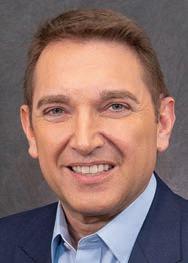
Bank of China U.S.A.’s commitment to our clients, longstanding industry relationships, diverse and supportive work culture, as well as our dedication to the communities we operate in, have been the backbone of our success in
the industry. As the oldest Chinese bank operating in the United States, we play an important role in the critical relationship between the U.S. and China. As one of the world’s largest banks and the first Chinese bank to enter the U.S. market, our global network empowers businesses and people from both countries to navigate the complex global trade and supply chain environment. This enables our clients to enter new markets from positions of strength and scalability. We are experts and leaders in U.S. Dollar and RMB settlement, cross-border investments, commodities, and trade, making us the premier bank for accessing the world’s second largest economy.
We bring more than four decades of experience securing first-class deals in the U.S. market, and are proud to partner with many Fortune 500 companies, homegrown enterprises and financial institutions to support their domestic and global business objectives.
Will you highlight BOC U.S.A.’s culture and values?
Transparency, industry expertise, and impeccable execution are benchmarks of Bank of China U.S.A.’s brand. We continue to invest in talent in our offices across the country – and our rich environment allows us to stay true to our commitment of bridging the gap between the U.S. and Chinese business communities.
We’ve been able to establish our brand locally and serve a wide range of U.S. businesses, from small businesses to Fortune 500 companies. We leverage our industry expertise and operational excellence to deepen our relationships with clients by providing the high-quality service they have come to expect from BOC U.S.A. In addition, our strong compliance protocols allow us to maintain an exceptional operational environment throughout our organization to best protect our customers, partners, and employees – and in turn, to build our reputation and grow our business.
Do you feel that BOC U.S.A.’s financial strength and global reach is a key differentiator for the company?
Yes. Our business has maintained steady growth: achieving new heights, expanding our client base within the Fortune 500, advancing specific areas such as project and subscription financing, and developing a robust personal banking business. This is all due to our commitment to balanced and sustainable development. While the U.S. banking industry has come on some hard times recently, our team at Bank of China U.S.A. has continued to build on our success.
What do you see as BOC U.S.A.’s responsibility to be engaged in the communities it serves and to be a good corporate citizen?
We often say we are a global bank with a local heart – and that guides everything we do as an institution, from how we interact with
“Transparency, industry expertise, and impeccable execution are benchmarks of Bank of China
U.S.A.’s brand. We continue to invest in talent in our offices across the country – and our rich environment allows us to stay true to our commitment of bridging the gap between the U.S. and Chinese business communities.”
our clients and employees to how we operate within and support our local communities. We feel a close connection to the communities in which we operate, including major metropolitan areas across the United States like New York, Los Angeles, and Chicago.
We continue to find that our customers and our greatest business opportunities exist in major metro areas, and we have made it a priority to give back to the cities that have given so much to us. Investing in our communities has and will continue to be part of BOC U.S.A.’s mission.
How does BOC U.S.A. focus its corporate responsibility efforts?

All of Bank of China U.S.A.’s branches are dedicated to supporting local communities and organizations through various initiatives. We’ve partnered with community leaders and organizations such as The Family Center, Cents Ability, and the Jump$tart Coalition to provide
financial education in innovative ways. We’ve also supported local organizations and events dedicated to enriching cultural ties between the U.S. and China, including the CGCC Foundation, Chinatown Healthcare Clinic Foundation, and the Sino-U.S. Business Leaders Roundtable.
How important is it for BOC U.S.A. to build a diverse and inclusive workforce?
Bank of China U.S.A. is thoroughly committed to both continue and expand our actions to support diversity, equity, and inclusion (DEI) in all we do. That includes everything from how we operate to how we engage with our customers and how we build and utilize our workforce. Creating and retaining a diverse, inclusive workplace is a strategic business priority that supports and invites creativity, fairness, development, and connection to those we serve across the country. We believe in utilizing diverse talent throughout our organization, and developing professional employees
no matter their gender, their race, their ethnicity, their sexual orientation, and other demographic features that create diversity. The world we live in is quite diverse and we want to use that diversity to make our company, our country, and our world better.
We also believe in the importance of inclusion and equity. In our workforce, we want our employees to feel comfortable no matter their background. That means respect and engagement irrespective of racial, ethnic, gender, and other differences. With respect to equity, a diverse organization maintains compliance with the law and seeks to ensure fairness in areas such as compensation, benefits, and opportunities. Diversity, equity, and inclusion together result in a better and stronger organization.
We will seek to meet our goal not by quotas or mandatory preferences, but by broadening our recruiting methods and our recruiting sources, and by continuing development of a diverse group of qualified employees for potential promotion to leadership and other positions. Developing and relying on a broader pool of diverse candidates, internal and external, should enable us to reach our goals in an appropriate manner.
BOC U.S.A. has a long history in the United States and has experienced recessions, public health crises, and economic downturns. Will you discuss BOC U.S.A.’s resilience in overcoming challenging and uncertain times?
Bank of China U.S.A. is not immune to the larger challenges facing our economy, but as you mentioned, we have a long history of remaining resilient and overcoming challenging and uncertain times. We have instituted sound risk management practices and regulatory compliance, and we are proactive in preparing for the complex and volatile economic and political environments we face. We will continue to enhance our relevant models, foster a culture of compliance and risk management, communicate effectively, and identify any potential unintended consequences to achieve our internal objectives of sound management and safety.
What do you tell young people about the type of career the banking industry offers?
Despite the challenging environment our banking industry currently faces and enormous geopolitical complexities facing our two countries, it’s an exciting industry that offers young people the opportunity to play an important role in the lifeblood of economies across the country and across borders. We provide critical services to everyone from large corporations to small business to individuals. While not always an easy career path, the banking industry can be both challenging and rewarding and I would encourage our next generation to consider it. I highly recommend studying or taking a post overseas for at least a year, if possible. Regardless of which country you choose, there is no replacement for living in another country to better understand their economy, politics and culture. •
“We often say we are a global bank with a local heart – and that guides everything we do as an institution, from how we interact with our clients and employees to how we operate within and support our local communities. We feel a close connection to the communities in which we operate, including major metropolitan areas across the United States like New York, Los Angeles, and Chicago.”
EDITORS’ NOTE Byron Boston is an investment professional with an extensive background in fixedincome capital markets. During his 42-year career, he has held a number of leadership positions in the asset management/investment banking community, and has personally built two successful public companies. Boston began his career as a corporate banker with Chemical Bank, where he focused on direct corporate loans and bond issuances. He then joined the fixedincome training program at Credit Suisse First Boston (CSFB), subsequently becoming a mortgage-backed securities bond trader. Between 1986 and 1997, Boston traded mortgage securities for both CSFB and Lehman Brothers. In 1997, he was recruited by Freddie Mac to develop and lead the initial investment plan to grow their retained portfolio. After successfully overseeing the investment strategy and driving excellent performance, Boston departed Freddie Mac in January 2004 to launch Sunset Financial Resources, a mortgage REIT specializing in high-quality residential and commercial loans and securities. He led the company’s initial public offering in March 2004, raising $130 million in initial equity. Sunset was sold in 2006. Boston consulted with Redwood Trust Inc. until he joined Dynex Capital in 2008. He earned a degree in economics from Dartmouth College and an MBA specializing in finance and accounting from the University of Chicago.

COMPANY BRIEF Dynex Capital, Inc. (dynexcapital.com) is a financial services company committed to the ethical stewardship of stakeholders’ capital, employing comprehensive risk management and disciplined capital allocation to generate dividend income and long-term total returns through the diversified financing of real estate assets in the United States. Dynex operates as a REIT and is internally managed to maximize stakeholder alignment.
Will you highlight the history and heritage of Dynex Capital?
Over our 35-year history, Dynex Capital has managed through multiple market cycles. We have learned from our history such that today we maintain a flexible investment strategy,
responding effectively to dynamic market conditions, and recognizing how those conditions present new opportunities for us to meet our stakeholders’ evolving needs. Originally, Dynex Capital was one of the earliest participants in the non-agency securitization markets. Dynex originated loans backed by both residential and commercial properties and subsequently sought financing in the non-agency securitization markets. However, in 2008 I was hired to develop a new long-term business plan that would be more appropriate for the market conditions that existed at that time. This was a chance to capitalize on new opportunities that emerged following the Great Financial Crisis, particularly by increasing our exposure to the highly liquid Agency RMBS market.
When I started at Dynex in January 2008 our total capitalization was slightly above $100 million and our investment portfolio was relatively small. Today, we have a seasoned team of professionals with deep experience in risk management and capital allocation across all noteworthy mortgage-related asset classes. In addition, we have increased our capital base to approximately $850 million. Most importantly, strong execution along with comprehensive risk management practices continue to enable us to generate attractive dividend income and longterm total returns for our shareholders.
What have been the keys to Dynex Capital’s growth and leadership?
Skilled risk management, disciplined capital allocation, and a diversified investment strategy have been key to our ability to rebuild Dynex’s balance sheet over the past 15 years. Our team experience spans more than four decades in the fixed income marketplace, and we fully understand the importance of maintaining a flexible mindset toward an ever-changing and increasingly complex world.
Our experience managing through prior market cycles and major risk events has allowed us to make better decisions today. We live in a highly complex and interconnected global environment with many factors that could evolve into some type of surprise event. For example, we weren’t shocked by the pandemic. We didn’t predict it, but we were prepared because of the importance we place on understanding prior historical events. In other words, we did not rule out the probability of a large-scale health event. The best way to manage in today’s markets is to prepare for multiple possible scenarios in the future.
Will you discuss Dynex Capital’s investment strategy and how Dynex Capital approaches risk?
At Dynex Capital, we believe in building a diversified portfolio. However, today our global risk view dictates that we emphasize a narrower investment focus due to our view of the global macroeconomic environment. For example, after the global financial crash of 2008, we decided
“We have learned from our history such that today we maintain a flexible investment strategy, responding effectively to dynamic market conditions, and recognizing how those conditions present new opportunities for us to meet our stakeholders’ evolving needs.”
to move down in credit and liquidity and we built a portfolio of various asset types in both the residential securities and the commercial real estate sector. We were willing to take credit risk from loans and unrated assets, as well as agency-backed securities. Starting in 2016, we became more cautious regarding the global risk environment, and we began to sell our less liquid and lower credit assets. Eventually we evolved our strategy to emphasize liquidity and liquid assets. Today, 95 percent of our assets are comprised of securities issued by a U.S. government agency such as Freddie Mac or Fannie Mae. We are holding a much larger percentage of our balance sheet in cash or unencumbered assets. Our emphasis on high-quality liquid assets and a high degree of liquidity on our balance sheet has served us well during this decade, as we have encountered a continual stream of surprise risk events.
How critical is it for Dynex Capital to build a diverse and inclusive workforce?
Dynex Capital had a diverse workforce before people started calling it DE&I – it’s just part of our DNA. Having a diverse team and different perspectives should be important for any business. For us, it’s invaluable because we’re assessing the global risk environment. We have people from different backgrounds and different parts of the world who bring unique views on everything from global events to domestic monetary policy – all vital factors to our ability to manage risk.
For decades, there have been huge segments of our society that have essentially been ignored in our country’s talent pool. As a corporate leader, I want to gain a competitive edge by tapping into this rich talent pool of smart, ethical, and experienced professionals. I want a group of people at the table who are comfortable contributing different sets of opinions, thinking outside the box and not just endorsing the conventional views. A leader needs to be able to elicit and manage a diverse set of opinions to deliver the right decisions for all stakeholders.
What do you see as Dynex Capital’s responsibility to be a good corporate citizen?
We manage other people’s savings and have an obligation of stewardship for
those investors, as well as our employees and creditors, all who could be impacted by our financial performance. As CEO, I constantly think about the impact that I can have on those around me, particularly those who are less fortunate than me, and those who can benefit from my knowledge or my team’s knowledge.
I often think about my father, a decorated WWII veteran, who didn’t have the same rights afforded to the majority when he returned home from the war to Mississippi. And I often wonder where the good people were in those times – the corporate leaders who could have spoken out and made a difference. I understand that there is no one playbook for when and where to take a stand on important issues, but we have an obligation to be a positive force within our sphere of influence as a member of the broader community.
One of the best things that I can do for society is to succeed, because there are not many people of color, and with my background, in this type of a leadership position. My success has put me in a position to help younger people by talking to them about my life’s journey. It’s gratifying to see people benefit from hearing about my experiences.
What do you feel are the keys to effective leadership and how do you describe your management style?
I believe in a collaborative approach. I always strive to surround myself with team members who are confident and who will bring healthy conversations to the workplace. There are situations where I, as the leader, must guide the decision, but collaboration is always important, and I want to make sure people are empowered to speak up. It’s not always easy to get others to bring their best ideas to the table, and sometimes you must challenge people to pull out their thoughts and opinions. But if we as an organization can encourage and empower healthy dialogue, then we end up making the best decisions for our stakeholders.
Did you always know that you had an entrepreneurial spirit and desire to build your own company?
I never thought of being an entrepreneur, CEO, or board director as a young man because people in those positions didn’t live in my
neighborhood. I followed my passion in terms of choosing to major in economics in college. The decision to leave St. Louis to attend Dartmouth College prepared me to step outside of my comfort zone and helped me learn how to succeed in a highly competitive world. Playing collegiate football also shaped my personality to where I was constantly trying to improve my chances, looking to gain a competitive edge, and finding the next best opportunity.
I decided to pursue a career on Wall Street in 1981, and eventually studied finance and accounting at The University of Chicago Booth School of Business. I have spent half my career in corporate America and half my career in the world of entrepreneurship. After developing a solid base of skills in corporate America, I was presented with an opportunity to build a company from the ground up. This was exciting and another opportunity to step out of my comfort zone. I was well-trained, prepared, and intensely focused on succeeding in building my first company, Sunset Financial Resources. After three years, we sold Sunset, and a group of my shareholders asked me to come develop a business plan to grow Dynex Capital. This was the ultimate compliment – seeing my prior shareholders so happy with my performance that they invited me onto their team to build another company.
You have been with Dynex Capital for more than 15 years. What has made the experience so special for you?
The single most important thing for me is knowing that I’ve taken care of all our stakeholders during my tenure as the company leader. When I joined Dynex, it was a stable company, but it didn’t have a growth strategy. I was asked to develop a business plan that would enable Dynex to grow in a sustainable manner over the long-term, and I have been doing that ever since. Most importantly, I have worked with some wonderful people and the team surrounding me is the best.
Every decision hasn’t been perfect – no one’s experience ever is – but our flexible mindset, and deep respect for history, continues to serve us and our stakeholders well.
What advice do you offer young people starting their careers?
A lot has changed about work, society, and the world we live in since I entered the workforce. What remains important is the need to understand yourself, your strengths and interests, and your motivations. Success requires passion with a good dose of realism and a general understanding of today’s economics and society. I tell young people to think about what their passions are, then ask themselves how much they need to support their desired lifestyle and whether they can achieve that by following those passions. Someone’s passion may in fact be a hobby and they may have to pursue a different career to fulfill that passion. In a capitalist system, it is okay to want to make a lot of money and also do something good with that money. I have always told myself that money in the hands of a good person is a powerful thing.•
“Our team experience spans more than four decades in the fixed income marketplace, and we fully understand the importance of maintaining a flexible mindset toward an everchanging and increasingly complex world.”
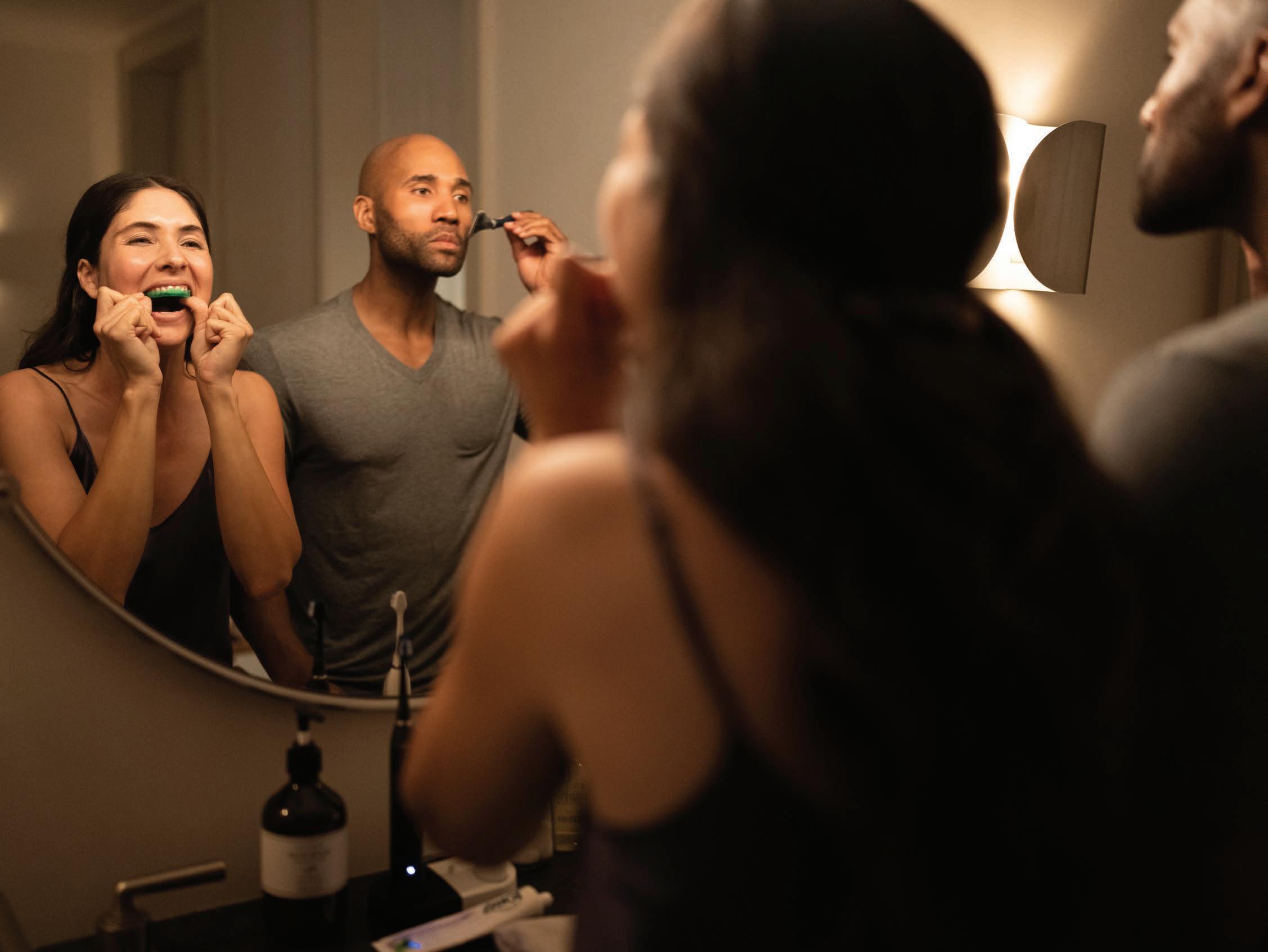

be elegant be refined be glam be home.
EDITORS’ NOTE Jonathan Landau is a founding member and the Chief Executive Officer of Landau Properties. Landau is a 20-year real estate veteran who has acquired, capitalized, developed and operated over $5 billion of properties in Austin, Boston, Dallas, Miami, and New York. Prior to co-founding Landau Properties, he was a founding member and CEO of Fortis Property Group. Landau also practiced corporate/transactional and tax law with DLA Piper for six years, primarily advising real estate companies on acquisitions, dispositions, syndications, joint ventures, entity-level investments, and tax-structured transactions. Landau holds a JD from the University of Maryland.

COMPANY BRIEF Landau Properties (landauproperites.com) acquires and develops properties with distinction in highly desirable but untapped locations with barriers to entry. The company’s focus is to raise the benchmark of quality, design, and lifestyle in each of its markets and to be the purveyors of excellence and innovation.
Will you highlight the history of Landau Properties?
Having spent the better part of the past 25 years first advising, and then working with, partners on diverse and complex residential and commercial real estate transactions, it has been my long-time dream and ambition to build a family real estate business. I’ve always wanted to work closely with my remarkably talented and driven children, so this is an incredible next chapter for me. We launched Landau Properties in late 2022 and look forward to bringing our thoughtful, bold, and competitive approach to new opportunities.
How do you describe Landau Properties’ culture and values?
Our culture at Landau Properties is driven and competitive, but kind. We aspire to execute and deliver at the highest levels in a fun, nurturing, and enjoyable environment. The modern workplace is no longer a grind. It must be highly-energized, stocked with talent and ambition to foster creativity,
passion, camaraderie, and both personal and team accomplishment. Our team approach is to add value wherever possible and to be present. Each member is empowered and encouraged to formulate and execute in his or her area of expertise. We collaborate on ideas and goals and execute autonomously.
Will you provide an overview of Landau Properties’ developments and current projects?
Our first endeavor is a boutique residential development on a waterfront site on Miami’s coveted Bay Harbor Islands. Overlooking Indian Creek Island, Indian Creek Residences & Yacht Club will offer a limited collection of nine luxury residences and one of the only private yacht clubs in the area. Pre-sales and construction are underway.

We also have several deals in the works across various markets and industries, from New York City to Philadelphia to Boston. We’re excited to share more details in the coming months.
What have been the keys to Landau Properties’ strength and leadership in the industry?
We are the little engine that could. We select projects that we can develop or operate as differentiated assets. While differentiation can be delivered in many forms including luxury, lifestyle, and design, we look for a superior edge and deliver it at a high level to a market that is otherwise supplied with cookie-cutter product. For each project, we develop a vision and pursue it with excellence and determination regardless of how avant-garde or outof-the-box our vision may seem relative to the industry standard.
Where do you see growth opportunities for Landau Properties as you look to the future?
Given the disruption caused in large part by interest rate and capital market distress, premier assets and sites are becoming available at more reasonable price points. While turbulence may persist for the next few years, now is an ideal time to commence development and construction. Firstly, projects that commence now will be constructed through the downturn and deliver into a recovering and pent-up market. Secondly, many anticipated or scheduled new development projects that were underwritten to pre-downturn
assumptions are being abandoned or put on hold causing construction costs to finally settle. Over the next 12-18 months, we plan to selectively pursue some of these premier opportunities in geographic markets that have strong local economic drivers. We expect these markets will be firing on all cylinders as the turbulence subsides.
Will you discuss the talent and expertise of the Landau Properties’ team?

I gained invaluable experience during my time at Fortis, where I was responsible for sourcing and negotiating real estate
transactions and overseeing the company’s operating, development, and leasing activities. I worked on several signature achievements with Fortis including securing a groundbreaking $1 billion refinancing deal and anchor tenant for One Lincoln, the skyline-defining office tower in Boston’s Financial District, and developing Olympia Dumbo, the iconic, record-breaking luxury residential tower overlooking the Brooklyn Bridge.
I’m bringing the lessons I learned from these successes, and many challenges, to
Landau Properties, where I have the exciting opportunity to work with my daughter Yael, who is a world-class marketing and creative genius, and my son-in-law DC, who is the rare combination of savvy, street-smart, charismatic, and driven. Each of them brings great strengths, insights, and knowledge of various parts of the industry to our team.
What do you see as Landau Properties’ responsibility to be engaged in the communities it serves?
For generations, my family has been active in local charities and community matters. Thankfully, my children and I have the desire to give imbedded in our DNA. Whether we live, work, or develop in a community, we are always looking for ways to connect with, participate in, and assist people and organizations in our communities.
Did you always know that you had an entrepreneurial spirit and desire to build your own company?
Yes, building is another characteristic that is in my DNA. Since I was young, I was always a sucker for building anything and leading a team. I feel and feed off the energy of team members who are driven to deliver a common goal. It is truly a blessing to be able to build a company together with my children.
What advice do you offer to young people interested in building a career in the real estate industry?
First, find a segment of the real estate industry that you enjoy and for which you have aptitude. Second, work with people that appreciate and promote your skill set and drive. Third, don’t settle for mediocrity –once you establish the necessary competence and experience, reach for the stars. •
“Our first endeavor is a boutique residential development on a waterfront site on Miami’s coveted Bay Harbor Islands. Overlooking Indian Creek Island, Indian Creek Residences & Yacht Club will offer a limited collection of nine luxury residences and one of the only private yacht clubs in the area.”
EDITORS’ NOTE Robert Catalano founded the Kids for Kids Foundation (kidsforkidsnyc.org) in 2006. It is a community of friends, families, and colleagues that raises money for organizations that support children and families struggling with medical challenges. Catalano earned a bachelor’s degree in business from St. John’s University.
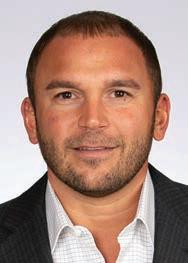
What was your vision for creating Kids for Kids Foundation and how do you define its mission?
I have always had a soft spot for kids, and as my business grew, it provided the opportunity to do more to support kids facing catastrophic medical issues. The idea was to create a community of friends, families, and colleagues raising money for organizations that support children and families struggling with medical challenges. Kids for Kids puts together

family-focused events that celebrate all that we have to be grateful for and serve to inspire the next generation of humanitarians – our children. We envision a time when all children struggling with health challenges can have a better future and a chance at life, and we strive to instill in our youth the importance of helping others, no matter their age.
We started by hosting an event at the Bronx Zoo and many of the families that attended that event were inspired and wanted to find ways to get involved and support our efforts. This helped me realize that the concept of hosting these events would work and my focus became on how to expand our reach.

We are focused on finding ways to get families and children involved in giving back, and the more we can open up opportunities for kids at younger ages to be involved in charity and philanthropy, the longer they will be able to make a difference throughout their lives.
What are the organizations that Kids for Kids supports?
Kids for Kids Foundation is committed to donating money to organizations that serve both children and their families. We support
St. Jude Children’s Research Hospital, an organization that is leading the way the world understands, treats, and defeats childhood cancer and other life-threatening diseases. We work with St. Mary’s Hospital for Children, an organization that has a mission to improve the health and quality of life for children with special needs and life-limiting conditions, and their families. St. Mary’s is New York’s largest and most experienced provider of long-term care to children with medically complex conditions and New York City’s only post-acute care facility. I remember walking the halls at St. Mary’s and seeing firsthand the work they were doing for kids in need, and I knew it was an organization that fit our criteria. We support Maimonides Children’s Hospital, an organization where patient care in the Neonatal Intensive Care Unit (NICU) is family-centered and where parents, siblings, grandparents, and other loved ones are seen as integral elements of the neonate’s health and are included in care decisions at every step. In addition, we work with Cohen Children’s Medical Center which is the top-rated children’s hospital in New York State. Cohen’s takes pride in building trusting relationships with the children and families they care for –and treat each one like they would their own. We have made 5- to 10-year fundraising commitments for naming rights of rooms at each of the hospitals.
The commonality with all the organizations we support is that they serve both children and their families.
Will you highlight the types of events that Kids for Kids holds?
We host all kinds of events throughout the year, from golf outings to family fun day at the Bronx Zoo to car racing at Monticello Motor Club to sporting clays. Our focus is hosting
quality events with a great network of people and guests where we are raising money and spreading awareness for the beneficiaries that we support.
We also developed a Junior Committee that is comprised of young volunteers ranging in age from 5 to 18 years old. This committee has grown to 61 members and they dedicate themselves to organizing year-round creative events, such as car washes, math-a-thons, bake sales, dance-a-thons, among others. We provide the tools and resources to help them with these events, and are working to inspire
the next generation to make a difference and give back. Through the passion of our Junior Committee members for helping others, they have been awarded over $100,000 in school scholarships, received Service Awards from their own respected communities, and been accepted into distinguished and highly competitive college programs that range from medical research to world issues and service to their peers.
How valuable has it been for Kids for Kids to have such an engaged board and talented staff?
This is most important because when I first started it was me, a few friends, and employees of my company who were giving their time to help make it work. As the Foundation grew, it became too much of a burden on the people who worked for my company to keep giving so much of their time – it was as if they had a second job. We realized that we needed to hire full-time staff to work at the Foundation, and over time we needed to continue to grow.
The board has been critical and their support for Kids for Kids is truly amazing. They bring their specific hobbies and interests to the Foundation, and have been catalysts for some of our most successful events, whether it is car racing or sporting clays or golf outings.
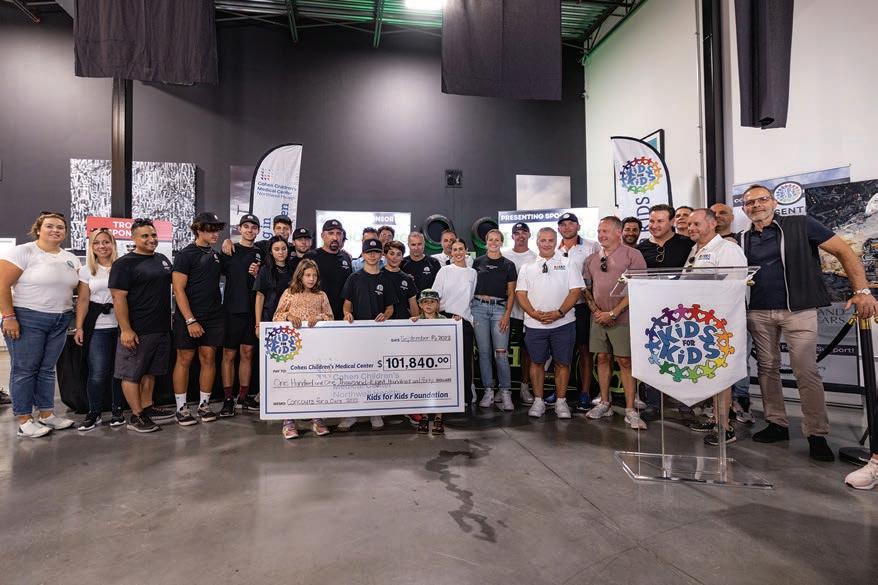

Are you surprised at how the charity has grown over the years?
I never imagined Kids for Kids would have grown the way it has since its founding 15 years ago. I love the work we do and it has been a great experience for me. There is no better feeling than when I hear that we inspired someone to make a difference, and knowing that we are helping children and their families is an amazing feeling.•
Kids for Kids Fondation 2022 Race for a Cure eventEDITORS’ NOTE Dusty May led Florida Atlantic to what is undoubtedly its greatest season in school history in the 2022-23 campaign. May guided the Owls to the Final Four while posting a program-best 35-4 record. Prior to this season, the Owls had one previous appearance in the NCAA Tournament, but this year, May led the Owls to not just their first win in the big dance, but all the way to the Final Four in Houston. In April 2023, May and Florida Atlantic reached an agreement on a 10-year contract extension.

May’s resume is well-decorated, as he was named the CBS Sports National Coach of the Year, as well as the NABC All-District 17 Coach of the Year and Conference USA Coach of the Year this
season. May is the Owls’ all-time leader in coaching wins with a record of 101-60, despite having only been on the FAU sidelines for five seasons. FAU has not had a losing season in the five years of the May era. The Owls also captured the Conference USA Tournament and Regular Season Championships, both for the first time in school history. Under May’s guidance, the 2022-23 Owls have the most wins in school history, the most conference wins in school & C-USA history, the longest winning streak in school history, and the third-longest streak in C-USA history.
Prior to becoming Head Coach, May spent the previous seven seasons on Mike White’s coaching staffs, first at Louisiana Tech University for four seasons and then with the University
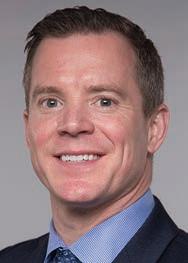
of Florida. White is the older brother of Brian White, who was named FAU’s vice president and director of athletics in March 2018.
May joined FAU after three years as an assistant coach at Florida, where he helped the Gators compile a 69-37 record, including back-to-back NCAA Tournament appearances. He was retained as an assistant at Louisiana Tech when Mike White took over the program entering the 2011-12 season, and the Bulldogs won three straight conference championships –the Western Athletic Conference title in 2013 and C-USA crowns in 2014 and 2015. May served six seasons (2009-15) as assistant coach and associate head coach at Louisiana Tech. In his final season with the Bulldogs, the team went 27-9, including 15-3 in C-USA to win the regular season championship by two games, and went 17-0 on its home court.
May was a student manager for the Indiana University men’s basketball team and after graduating, he began his professional career as an administrative assistant/video coordinator at USC from 2000-02. He returned to Indiana in an administrative role for three seasons before taking his first step as an assistant coach with Eastern Michigan (200506). He has also served as an assistant at Murray State (2006-07) and UAB (2007-09).
Will you discuss your journey in coaching?
I started playing basketball in elementary school and fell in love with the game immediately,
and since as early as I can remember, I always wanted to be a coach because of the impact that my coaches had on me. There have been many ups and down on my coaching journey, and at several points in my career I thought about going in another direction because of my family. My wife and I had three children when we were young, and there were a lot of times when it was challenging to be a good father, a good husband, and give to my career the way I needed to if I was going to continue to grow in the profession. My wife and kids were always very supportive, and I was able to work
for great people. I caught a few breaks along the way and was able to keep climbing – it has been a great ride.
How important were mentors during your early years in coaching?
Early in my career, Coach Knight (Indiana University) was someone that I would ask for advice on career moves, and later on the head coaches that I worked for were all great coaches to learn from. I leaned on a lot of the assistant coaches for advice and direction because they were closer to where I was, and they were where I was trying to get to. For me, being a head coach was a long-term goal, so I leaned on the assistant coaches that I was working under or working with for advice. As I got older, Mike White, who I served as an assistant under at Louisiana Tech and Florida during my career, was someone I could always go to for advice and feedback. I have been very fortunate throughout my career to work with and for people who took the time to get to know me and gave their time to support me.
What was it like in the early days at Florida Atlantic as you looked to build the program into a national contender?
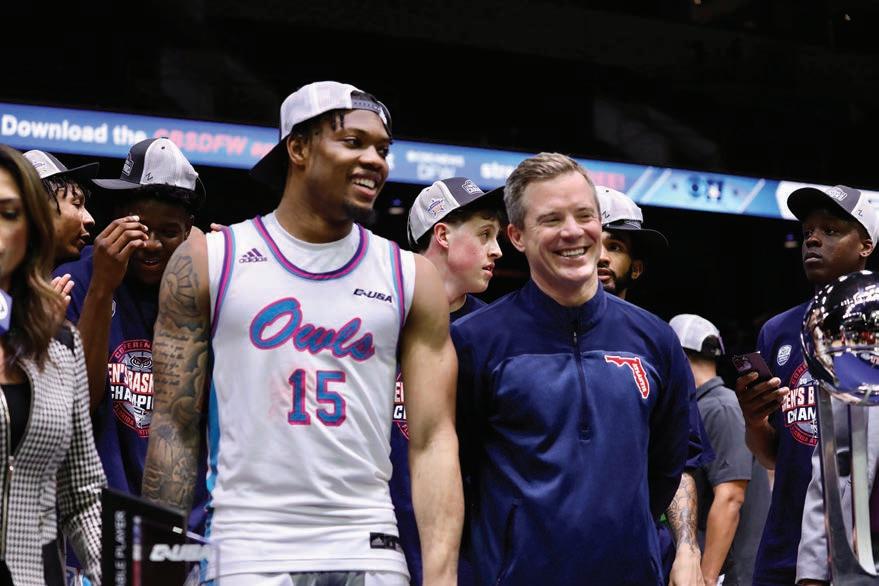
It was all about the work and the challenge. We were faced with adversity, but it is how you respond to adversity that determines your success. This is what we teach to our players. It is not always going to be smooth and easy, but it is about making the best of it and finding solutions to the problems. My focus was on finding the best players to recruit, and putting together a coaching staff and a team that was going to pull together in the same direction.

While you are always looking to recruit the best talent, how important is personality and culture fit as part of the process?
We value character, drive, and determination. Clearly, they must be talented basketball
“We were faced with adversity, but it is how you respond to adversity that determines your success. This is what we teach to our players.”Dusty May and sophomore guard Alijah Martin after winning the Conference USA Tournament Championship
players or we would not be recruiting them in the first place, but once we identify those players it becomes a deep dive into evaluating whether they will fit with our values and mission. We have great human beings throughout our program, and I find that great people tend to gravitate towards great people which has made it happen somewhat organically. I believe as people we are all attracted to certain types of relationships.
What are the qualities you look for in your coaching staff?

I go to many NBA games and see times when there is very little interaction between the head coach and the staff, which is not my philosophy. I value the opinions and experiences of our staff, and I rely on them heavily. Our staff is not concerned about getting credit or hearing their names in the news –it is about working together as a team which trickles down to our players. It is about each of us working to make the other person better, and this permeates throughout our program. It is about putting the team ahead of yourself.
What led to the success of the team this season in reaching the Final Four?
We felt that we received some bad breaks last year with injuries, as well as on certain nights finding ways to lose – we were young and we were gaining experience. This year we brought back the same team and we were confident that if we continued to improve, we would get over the hump. Our hardest workers were also our most natural leaders which was a key to our success. It takes great locker room leadership and we had that this year.
Now it is about being even hungrier as we look to next season if we are going to continue our success. Since the season ended, I have said
that the first thing you are concerned with is complacency, but we have a group that enjoys working and loves to compete so I am confident that we will continue to do what we need to achieve success.
How important is it to maintain your relationships with your players after their playing days are over?
This is extremely important, and it is a reason why we are so focused on continuity in our program. We have brought back a former player who is on our staff now, and we stay in close contact with our players. We are about
our players, not just when they are playing for us, but throughout their lives. The messages we are teaching our players are for today, as well as for the next 50 years of their lives. These kids put their heart and soul into the program, and we feel a responsibility to be there for them long after their playing days are finished.
What are your views on the state of college basketball today and the impact of the transfer portal and NIL?

The transfer portal concerns me since if you are going to bounce around from school to school, you will lose credits and it will impact graduation for these young athletes. I can only focus on my job of providing the best situation for the short and long term for our players, and hopefully they will not want to look for something else. Many players are used to moving around during high school and on their AAU teams, so they are comfortable with change and experiencing new places, but as long as we are providing a learning environment and are setting them up for success in life after basketball, we hope that they will value that and stay with us.
I think that NIL deals are great for players as they are learning business and entrepreneurship. I think there are areas that need to be watched and adapted, but for the most part this is a positive for players.
Are you able to take moments to reflect on the success of this year and appreciate what the team accomplished?
I am focused on next year and raising the bar. I have spent very little time reflecting on last season, other than watching the games again and reliving the feelings that I had in those moments. It is about looking forward to having another great season and staying ahead in the constantly changing landscape of the profession.•
Dusty May during the NCAA Elite 8 game against Kansas State at Madison Square GardenWe’ve done hard things before, we do them all the time.
For most cancer patients, the usual options are surgery, chemotherapy, or radiation. So we’re working on ways to get the immune system to deploy billions of cancer-killing cells and help more patients survive.
When some people experienced mysterious COVID symptoms and had nowhere to go, our team created the first Center for Post-COVID Care.
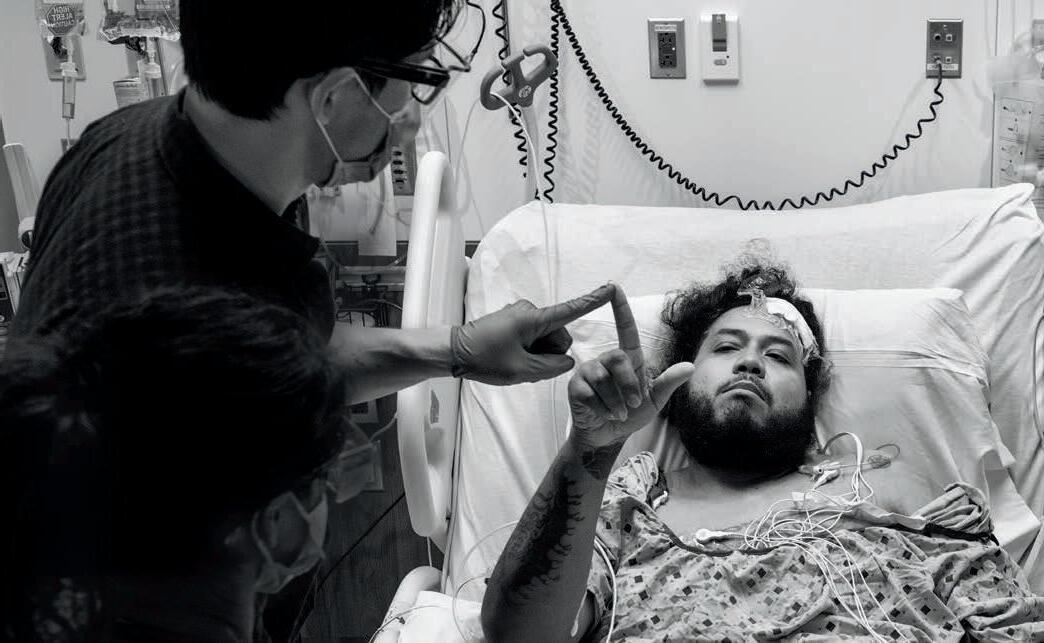
It wasn’t that long ago we had to open up your whole chest for heart surgery. Now we’re pioneering a bypass that goes through a few tiny incisions. With this surgery, we can get you back on your feet in weeks instead of months.
So if anyone ever tells you there’s no other way—don’t listen.
EDITORS’ NOTE Martin Nussbaum has more than 20 years of real estate investment, development, and operational experience throughout the United States. He oversees the strategic vision behind the company’s multiple business platforms, investment decisions, capital market relationships, and execution of its portfolio. Throughout his career, he has acquired over $8 billion worth of real estate in all asset classes. Prior to Slate, Nussbaum was the co-founder and managing partner of Silverstone Property Group, a full-service real estate owner and operator that purchased over $1 billion of New York real estate assets. Prior to Silverstone, he worked for a family office overseeing a portfolio of over 5,000 apartments and three million square feet of commercial property throughout the New York tri-state area. He started his real estate career at Wells Hill Partners, a real estate investment bank based in New York. Nussbaum graduated from the State University of New York Albany.
David Schwartz has more than 20 years of experience buying, developing, and operating real estate across the United States. Schwartz oversees Slate’s Affordable and Impact investment strategies in addition to development and construction projects. David also shares responsibility for all acquisitions and investment decisions. He currently runs all development and construction projects for Slate Property Group and shares responsibility for all acquisitions and investment decisions. Previously, Schwartz co-founded two New York City based development firms. He was responsible for the development of more than 1,000 units throughout New York City representing over 750,000 square feet. Prior to founding his own development firms, Schwartz worked for Crescent Heights of America, where he was involved in over $500 million in groundup residential developments representing over 1,000 units. Throughout his career, he has been involved in the development of almost $5 billion in real estate. He also worked at Lux Capital and J.P. Morgan. Schwartz received his BS in finance from Syracuse University.
COMPANY BRIEF Slate Property Group (slatepg.com) is a vertically integrated owner, operator, and developer of multifamily and commercial real estate with a primary focus on the New York metropolitan area. From adaptive reuse and repositioning of existing assets to ground-up development and lending, Slate’s dedicated team of more than 115 employees leverage extensive
experience in the multifamily asset class. Over the last decade, Slate Property Group has invested in excess of $6 billion across equity and debt over more than 50 investments.
Will you highlight the history of Slate Property Group?
Nussbaum : We founded Slate Property Group in 2013, and we’ve since grown to own, build, lease, finance, and manage every kind of multifamily housing. Our portfolio includes thousands of apartments across the New York region. Over the past decade, we’ve carved out a reputation as innovators,

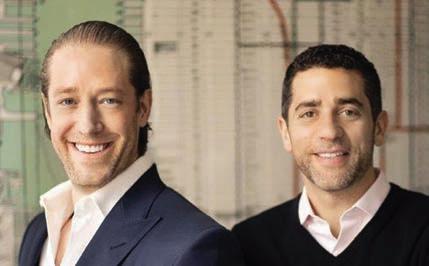
not only for the brick-and-mortar side of our business, but increasingly in our role helping to finance the development of new housing all across the region. We leverage our extensive experience across the multifamily asset class, our deep-seated roster of in-house experts, and a data-driven approach to deliver superior risk-adjusted returns for our investors.
How do you describe Slate Property Group’s culture and values?
Schwartz : People are proud to live in Slate buildings. It doesn’t matter whether we’re building an all-affordable project or something at the very high end of the market. We utilize the same teams and the same expertise, and it shows in the end product. There’s a hallmark of quality in everything we do.
We also value partnership. I think nonprofits and government agencies, communities, and investors see us as a trusted partner to make complex developments and deals happen. They value our expertise in every part of the housing ecosystem, from managing land use approvals, to financing construction, to successfully operating the building.
Will you provide an overview of Slate Property Group’s developments and current projects?
Nussbaum: In the decade since we launched the company, Slate has invested over $6.4 billion in real estate assets across equity and debt, totaling over 10,000 housing units and more than 50 investments. Just last year, we completed more than $300 million in market rate value-add acquisitions, totaling more than 640 units and with 350 units in active development throughout Manhattan, Queens, and Brooklyn.
We’ve also seen great success on the lending side of our business where we focus on providing secured transitional loans as a direct lender supplying first mortgage financing. During 2021, we closed more than $1.25 billion in loans, with that momentum continuing into 2022 with $475 million in loans completed.
Schwartz : We are also rapidly becoming a go-to partner for nonprofits and government agencies looking to finance, build, and operate affordable and supportive housing projects that meet the highest standards. We recently completed a major supportive housing development with Westhab at the Tremont Residences in the Bronx.

We also just announced a collaboration with RiseBoro Community Partnership to convert an underutilized hotel near JFK airport into more than 300 permanently affordable apartments – a first-of-its-kind project. We’re particularly proud of the speed with which we’re able to deliver on this project, with units ready for occupancy next year – far faster than the typical six years for ground-up construction. The project also cracks the code on conversions here in New York City, setting the stage for others to make similar projects viable.
Where do you see growth opportunities for Slate Property Group as you look to the future?
Schwartz : New York is grappling with a serious housing crisis and to compound that, there’s limited new supply coming available due to the expiration of 421A, rising construction costs, and lack of access to financing. Not every company can succeed in that environment, but we can. We’ve become one of the most active lenders for multifamily housing in Brooklyn and Queens over the past few years. We can lean on data from our own housing portfolio to make smart lending and acquisition decisions, and lean on the data from our lending business to inform how we manage and finance our own assets and acquisitions. That’s a real value-add in a tough economic moment.
Nussbaum : We see great potential for growth in our credit business. This is an incredibly interesting period for the markets which have been hurt by higher interest rates, causing a power shift from borrowers to lenders. We’re excited to see how we can leverage the current lending environment to bolster our portfolio.
Will you discuss the talent and expertise of the Slate Property Group team?
Nussbaum : We’ve been very intentional about building a deep bench of expertise and leadership around us. That’s the differencemaker between a founder-led company that reaches a plateau, and one that grows into a leading real estate firm. As part of our growth strategy, we’ve built that depth in every area of the company, including Jay Stark as President,
Brian Vetter as Chief Investment Officer, John Valladares as Managing Director of Affordable, Golan Hod as Managing Director of Development, among others.
When I say vertically integrated, I mean it. We have an industry-leading development and construction team, best-in-class property management, and experienced financial services professionals – all of whom collaborate across verticals.
What do you see as Slate Property Group’s responsibility to be engaged in the communities it serves?
Schwartz: Martin and I have always been involved in supporting priorities like affordable housing. Those are personal passions that have also become priorities for the business. But I think our connection to community runs a lot deeper than that. If you asked our nonprofit partners and the elected officials that represent communities where we work, I think they would tell you that we build true and longlasting relationships. For example, when we looked at converting the Hilton hotel near JFK into permanently affordable housing, we recognized the project would be much stronger if it were owned by our nonprofit partner, RiseBoro Community Partnership. Not every company in our industry would make a decision like that, but we knew it was the best model for the longterm success of the building.
Did you always know that you had an entrepreneurial spirit and desire to build your own company?
Nussbaum : David and I both thrived as entrepreneurs independently before launching Slate together. While I enjoyed success with my previous ventures, this partnership and the business that we’ve built is what I’ve been working toward my entire career.
Schwartz : Working in this industry has always been my passion, and all my experience learning the ropes in the development world was with my sights set on building and owning a company like Slate one day. When the opportunity arose to work with Martin and make our vision for Slate into a reality, it was a no-brainer.
What has made the working relationship between the two of you work so well?
Schwartz: First and foremost, Martin and I happen to really like each other. That’s integral to our longtime successful business relationship. We consistently find ourselves on the same page in terms of strategy and goal setting.
Nussbaum: I agree with David, and I would also add that our backgrounds and skillsets are certainly varied, but also incredibly complementary. We trust each other and we trust the team we’ve brought on to grow this business.
What advice do you offer to young people interested in building a career in the real estate industry?
Schwartz : If you want to break into this industry, don’t just look at the biggest players and think that’s the end-all, be-all. Look at the next generation of companies being built and how they are innovating. The best way to succeed is to set conventional wisdom aside and look for opportunities that others overlook.•
EDITORS’ NOTE Igor Jablokov is the CEO and Founder of Pryon, an AI company focused on businesses. Named an “Industry Luminary” by Speech Technology Magazine , Jablokov has long been advocating for smarter, safer deployments of AI and built Pryon to offer valuable technology to enterprises that, most importantly, can be trusted. He previously founded industry pioneer Yap, the world’s first highaccuracy, fully automated cloud platform for voice recognition. After its products were deployed by dozens of enterprises, the company became Amazon’s first AI-related acquisition. The firm’s inventions then served as the nucleus for follow-on products such as Alexa, Echo, and Fire TV. Jablokov is a believer in the need to slow down the deployment of AI until there are developed principles and protections. At Pryon, he has intentionally built a product for enterprises that is secure and reliable, qualities many now realize are lacking in the generative AI products dominating the news cycle. Jablokov was awarded Eisenhower and Truman National Security fellowships to explore and expand the role of entrepreneurship and venture capital in addressing geopolitical concerns. As an innovator in human language technologies, he believes in fostering career and educational opportunities for others entering STEM fields. As such, he serves as a mentor in the TechStars’ Alexa Accelerator, was a Blackstone NC Entrepreneur-In-Residence (EIR), and founded a chapter of the Global Shapers, a program of the World Economic Forum. Jablokov holds a BS in computer engineering from Pennsylvania State University, where he was named an Outstanding Engineering Alumnus, and an MBA from the University of North Carolina.
COMPANY BRIEF Pryon (pryon.com) is an AI company that delivers augmented intelligence for the enterprise. Driven by the inventors of core natural language technologies, the company is developing a platform that connects employees to digital transformation, extending their ability to find and use knowledge, drive workflows, and make better decisions from wherever they are. Pryon streamlines AI adoption to dramatically reduce complexity, costs, and deployment times.
What was your vision for creating Pryon and how do you define its mission?
In 2017, we created Pryon to provide enterprises with a secure way to get accurate and trusted answers based on their own proprietary content. Through our background of building Yap, a company which became the foundation of Alexa after its acquisition by Amazon, it was clear that the experience of being able to ask a question and get an instantaneous answer was groundbreaking in the consumer world, but was missing in support of corporate and government operations. We set out to solve that and unlock the most critical and differentiating knowledge that is captured in the archives and knowledge bases of the most important institutions in the world.
Pryon’s mission is to eliminate the friction that exists between people and the information they need to do their jobs accurately, confidently, and productively. In addition, it is foundational to our mission to do so securely and in a way that drives forward the value of the institutional knowledge that so many companies have created, but have not been able to leverage as a competitive advantage. Will you provide an overview of Pryon’s business?
Pryon provides a knowledge operating system for enterprises – that is, an end-to-end

AI platform that safely and securely reads, organizes, and understands the collective knowledge of an organization and delivers accurate, reliable, and trustworthy answers to natural language questions in a subsecond.
Pryon integrates with the existing systems of record such as applications, knowledge bases, and repositories an organization already uses. It reads and understands the information – whether it’s captured in text form, documents, presentations, photographs, videos, or old, handwritten sets of instructions – by leveraging proprietary computer vision technologies, large language models, and natural language processing. This process creates a fabric of knowledge that delivers trusted answers directly from this content with greater than 90 percent accuracy on day one, without any need for custom code, model training, or rules.
Our customers and partners are using Pryon to dramatically improve the productivity of their workforce, the quality of their work, as well as overall end-user satisfaction. We have been deployed across many use cases including customer services and IT help desk applications, virtual sales engineer applications, as well as use cases that support technical operations in highly engineered environments such as energy, manufacturing, or semiconductors. The ability for our clients to get accurate and fast answers is revolutionizing the way they do business.
“Pryon’s mission is to eliminate the friction that exists between people and the information they need to do their jobs accurately, confidently, and productively.”
What have been the keys to Pryon’s growth and how do you describe the Pryon difference?
Pryon is transforming the way enterprises manage their knowledge while also ensuring attribution, safety, and security. Because our platform operates as a closed system, it takes in and shares only trusted and vetted information confidentially. By extracting answers and providing full provenance to sources, it avoids the “black box” approach that underlies too many AI models.
Unlike other systems that are currently generating decidedly mixed headlines, Pryon’s technology offers authoritative, reliable, and trusted answers in seconds, dramatically improving productivity, work quality, and overall access to knowledge for our customers. Pryon is a complete end-to-end solution that can be deployed in days or weeks, providing greater than 90 percent accuracy out of the box. Enterprises recognize the difference and are able to see value right away, and we’ve seen a lot of demand as a result.
That need for a trustworthy and deployment-ready AI solution for enterprises has driven Pryon’s growth. As new generative AI technologies hit the market, businesses are evaluating the risks and are looking to adopt the most reliable and secure solution for their internal data. We built Pryon over the past six years on the foundation of accuracy and security and, as a result, we have an AI knowledge platform enterprises can trust.
Will you discuss your views on the need for smarter, safer deployments of AI?
Broad awareness around the potential for AI has arrived. Despite decades of thoughtful rule development and efforts to construct these technologies ethically, these guidelines have often been ignored by the companies that are haphazardly trying to grab the largest market share across the AI landscape. The lack of safe and ethical infrastructure and oversight renders many AI tools too risky for business use, especially in core workflows.
We have not yet seen the extent of the risks of AI technology that is not created responsibly, but we know that without rules, AI can expose
and undermine intellectual property (even when it’s not the user’s intent), it can introduce legal issues for companies as it delivers generative works based on copyrighted content or patented technology, and it can spread misinformation in ways that can affect outcomes and our very sense of what is true and what is false.
Pryon is advocating for businesses and society to reprioritize reliability, security, and trust in the adoption of AI technologies. Pryon’s own proprietary technology was built around a core set of ethics that guides the function of our company and technology. This is the model all AI creators should follow if AI is to become a central driver of business transformation.
What do you see as Pryon’s responsibility to be a force for good in society?
Pryon is setting the bar high for the ethical development and deployment of AI. This isn’t lip service and builds on the way that we interacted with the world at IBM and at Yap. AI should be a force for good and it can be when built with strong guidelines, with us having to lead by example. Technology can uplift humanity, but when built with loose expectations and standards, it can become detrimental to businesses and society.
AI is more than capable of empowering a safer and more prosperous world for all – anyone who says otherwise is lazy – and at Pryon, we feel a responsibility not only to produce private and secure AI technologies, but to be a voice championing a clear set of ethics in AI development that can empower people and empower the best in our society, responsibly.
How important is it for Pryon to build a diverse and inclusive workforce?
When creating a new business or technology, it is important to incorporate diverse perspectives from day one to maximize the aperture. An inclusive workforce helps to ensure that the company and its technology are agile and responsive to as many needs as practically possible. That way our creators are a team best set up to successfully invent products that are free from bias and can help the broadest range of individuals.
We’ve seen technology with egregious blind spots that alienate people, or that create
a poor experience for a segment of users. The only way to avoid that is to draw from a wide range of backgrounds and experiences and create a product fit for all. We accomplished this in our previous company before this was a known imperative.
Did you always know that you had an entrepreneurial spirit and desire to build your own business?
I’ve always had that desire to tinker and create given my parents being artists. I enjoy building something impactful to everyone’s day-to-day experiences versus catering to niches. My interests and work has been rooted in research so that it’s a unique proposition that hasn’t been tried before. This passion for invention has driven me from one team at the cutting edge of AI to the next until I recognized the value that AI could create for society. From there I knew that I had to act, and if I didn’t turn my ideas into reality, no one else would. I wanted to see this idea come to life, and I was committed to doing it the right way, with privacy and security embedded into our technology from the start.
What do you feel are the keys to effective leadership and how do you describe your management style?
An effective leader empowers others to lead in their own right since one should be hiring subject matter experts in their respective fields. Providing necessary resources, lifting people up, and challenging them to be the best version of themselves drives us all to work smarter, to think more creatively, and to be better human beings. It also requires building trust and establishing high expectations given the serious applications we could be supporting.
I strive to be a transparent and frequent communicator as I’ve learned that’s the best way to distribute intelligence across a team. In addition, hiring the best people – surrounding great people with other great people – empowers and motivates the team to work together to accomplish amazing things. In a work environment where we are creating the next generation of AI technologies, practicing what we preach is an essential motivator that nurtures innovation and growth. We should relish things that are difficult, because that means those become impossibilities for others.
What advice do you offer young people beginning their careers?
Put your efforts and energy into what you believe will make the world a better place, but be at peace that there are no shortcuts to such things coming to fruition. Think boldly – you will hear many object to your world views in the process of disruption. Think beyond the limits of the current applications and instead consider ways that technology can be adapted and improved for a greater and positive impact. Apply what you know to what you believe and what you support for the good of humanity. Assume what you know is but a snowflake on a tip of an iceberg and be insatiable in knowledge acquisition, and remember that you don’t know what you don’t know yet. Start small but think big.•
“Pryon is transforming the way enterprises manage their knowledge while also ensuring attribution, safety, and security. Because our platform operates as a closed system, it takes in and shares only trusted and vetted information confidentially.”
EDITORS’ NOTE For 30+ years, Michael Boydell’s (theadventureadvantage.com) passion has been studying and working with the unique needs of elite level performers, specifically C-suite executives, professional athletes, global organizational leaders and their teams. He is a former varsity athlete, Ironman finisher, and seasoned executive, holding positions as CEO, start-up founder, and board member with high-growth, international companies. Boydell launched his advisory business in 2009 to an exclusive CEO client base and quickly became a go-to expert for global leaders who want to gain more freedom and self-actualization in their busy lives. He has designed and delivered leadership programs for the International Board and global community of facilitators with Young President’s Organization in Japan, Australia, Denmark, and the United States. He is an accredited Board Director, has advanced certification in the Birkman Method and Tilt365 leadership tools, and is the creator of The Fear Less Advantage™ framework for whole-life performance. His methods have been successfully utilized in one-toone advisory relationships, experiential team offsites, board and leadership retreats, organizational growth strategies, and as part of companywide leadership programs. He is the author of The Adventure Advantage: A Roadmap into Uncertainty, Through Fear, and Onward to Your Heroic Life. Boydell graduated with a BA in psychology from Queen’s University and holds an MBA from the Richard Ivey School of Business.
How did you develop your intertest in the topic of leadership in teams and organizations?
I experienced firsthand the effect both good and bad coaching and leadership had while competing in sports throughout my youth, and as a varsity basketball athlete in college and graduate school. The complexities involved in aligning a diverse group of talented, high-performing individuals toward realizing a unified goal beyond the reach of any one person fascinated me. I combined a degree in psychology with an MBA and dedicated myself to studying, coaching, and working with elite level performers – C-suite executives, entrepreneurs, athletes – to shape winning cultures, create lasting impact, and achieve bottomline results ever since.
What was a defining moment that shaped who you are as a leader?

I believe most defining moments come through hitting an impasse or experiencing failure. My first such pivotal growth moment came in my mid-30s as a young executive after years of hard-driving to achieve those ego-seducing trappings of success –the title, the money, the accumulations. After an executive dinner at a posh London restaurant and severaltoo-many martinis, I found myself back in my hotel room alone, distraught, and feeling like I’d hit rock bottom.
After a long look in the mirror, I realized how far I’d become lost in proving my worth by chasing other people’s definitions of who I was supposed to be. It was a powerful and challenging wake-up call – my invitation to hit the “reset” button and get back in control of the life I most wanted to lead. Looking back, that was a catalytic moment to recalibrating my priorities and launching the professional and personal life I thrive in today.
How do you continue to hone your skills as a leadership coach?
As the saying goes, “Beware the coach who doesn’t have a coach.” I commit chunks of time each week, enjoy immersive workshops, and take an annual sabbatical to personally test new development modalities that level-up my approach in keeping with the demands facing passionate, driven professionals in the world today.
Regular feedback also plays a vital role in my growth as a leadership coach. Actively seeking feedback from my global network of clients, peers, and elders helps to continually expand my perceptions and shine light into my biases or blind spots. This feedback-driven approach enables fresh innovation in my business model and coaching style, and offers solutions that meet the unique needs and challenges of the professionals, teams, and organizations I work with.
For 25 years, I’ve been a proponent and participant in mastermind groups, YPO forums, and other forms of peer-to-peer leadership learning circles, investing time to get real with those with shared passion for living an authentic life, creating lasting prosperity, and renewing personal vitality.
What are you seeing as a critical leadership challenge facing global organizations today?
There’s no question that the post-pandemic redefinition of “work” and workplace” is a massively disruptive game-changer for organizational leaders today. Any sense of “right” answer remains up for debate, depending on age-and-stage, gender, geography, socioeconomic variables, and type of work. I believe virtual and hybrid work models are here to stay, and while leaders and businesses spend countless hours in search of the ever-elusive “best practice,” there is something that will never change: people are social beings. We need in-person human connection to survive and thrive.
More and more, executives and teams working in a hybrid model are finding value in quarterly, multi-day offsites. I lead what some are calling “radical retreats” as an alternative to the traditional high-cost, low-value corporate boondoggle. This kind of highenergy, regular in-person touch points work incredibly well to hone interpersonal connectivity, foster creative problem-solving, spot new opportunities, and drive winning results – making virtual work far more effective in the time between.
In hybrid situations, I encourage leaders to make the most of the unstructured time when the team is together. Sacrificing an extra hour of productivity pays immediate and downstream dividends in the form of innovation, early-stage risk identification and mitigation, and deeper loyalty through more trusting connections. In the end, you’ll have a far more cohesive team, able to produce results beyond any one person, and eager to help each other succeed.
Fully virtual work models may work well for individuals, but prove more challenging when it comes to team performance. In these situations, it’s still important to connect by video from time to time for unstructured interactions – one-on-one and as a whole team. These don’t have to be long, but they are essential for leaders in communicating priorities, testing for alignment, and building rapport.
How have you used technology to augment your coaching, and in what ways is technology hindering leadership development?
I always advise leaders and coaches to lean into technology rather than avoid it. Its
uses are only accelerating, so we must find ways to utilize new platforms, apps, and AI tools in our work. I personally have found Miro board, ChatGPT, and the expanded apps within Zoom to be additive in my virtual work.
Technology also has its challenges. Despite my nearly two decades as an executive in the tech sector, most of my in-person performance coaching work is low-tech by design. If I can’t be effective with a pencil and a blank sheet of paper, or the right set of provocative questions during a walk outside, then I’m probably making things more complicated than necessary. Technology can become a major distraction to inviting real human connection, or may simply offer more things to go wrong.
Perhaps the biggest way I see technology hindering real performance growth and leadership development is that it often seems like a quick fix alternative to making the time for live human interaction. Instead of working with a credible professional, I often see individuals posting a question or a problem they’re having on social media, or they text the group chat. They feel like they are addressing an issue and getting the help or connection they need. Unfortunately, the result is usually someone else’s advice, which acts as merely a Band-Aid and rarely solves the larger issue at hand.
As we look at the next generation of leaders coming up, how do you see leadership evolving?
For the next generation coming up, authenticity is key. The main area I see that will have to evolve across leadership positions everywhere is transparency. There will be no more hiding behind fancy titles at a big corporate desk. That’s not going to get a leader far, I can tell you that. And this speaks to what I mentioned earlier – now more than ever, people are seeking a real connection.
I believe leaders are going to have to really get comfortable with who they are – thus the importance of what I call the Freedom Adventure – so they can lead with their true selves. Younger people in the workforce today see through the façade.
What does the title of your book, The Adventure Advantage, mean?
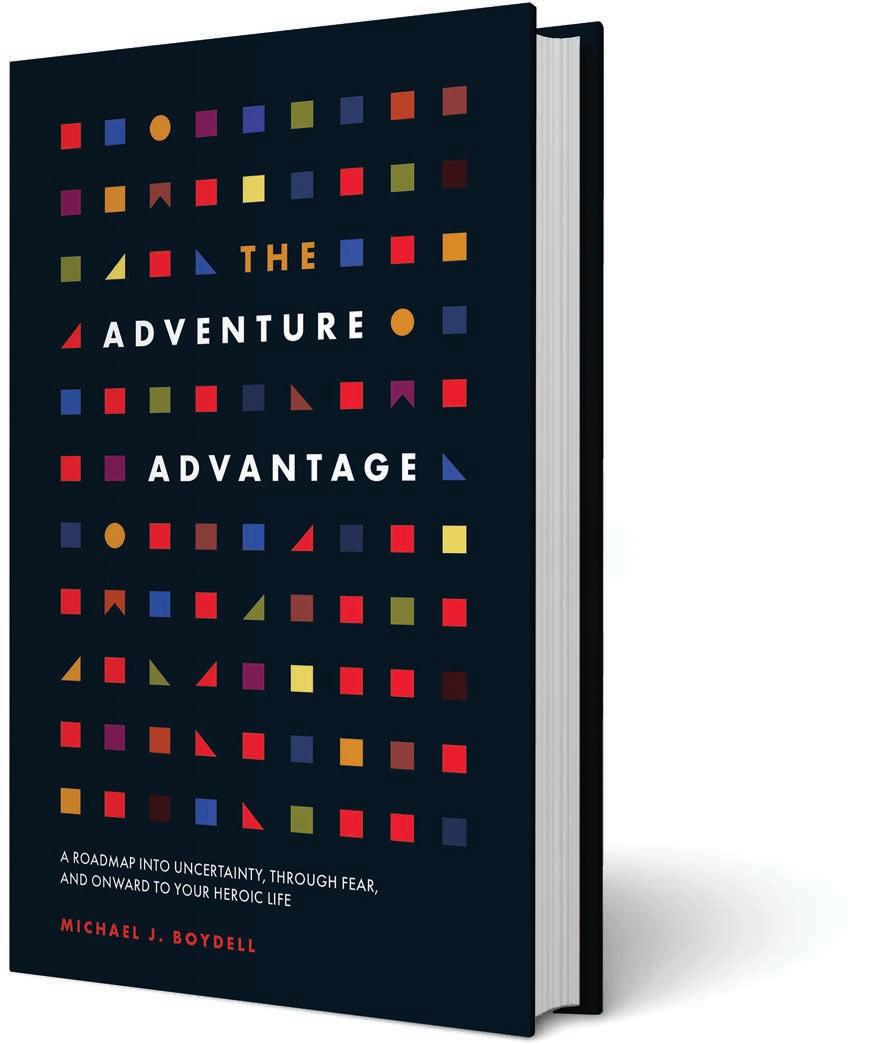
At the beginning of my book, I assert that “change is the constant and necessary catalyst for growth of all kinds.” That means that when disruption shows up – big or small – the advantage will go to those who see change as something happening to invite growth, not something to be afraid of, steer around, or fight against. Leaders who understand how to navigate fear, evolve their own outdated mental framework, and discover the opportunity in change, will have an advantage. Leaders who learn to rely on and grow their innate abilities of vision, presence, empathy, and bravery, will have an advantage.
For me, adopting an “adventure” mindset when facing change is the only advantage you’ll ever need, in our work and chosen
profession, in our most important, most intimate relationships, and in pursuit of personal meaning and purpose, over a lifetime.
In your book, you talk about the “Three Greatest Adventures.” What are they and how can leaders apply them?
In The Adventure Advantage, I refer to the Freedom Adventure (the path to authentic independence), the Courage Adventure (the path to collective prosperity), and the Power Adventure (the path to vital renewal) as the Three Greatest Adventures required for every leader to navigate disruptive change and realize breakthrough performance – when leading broad-reaching organizational change, high-functioning teams, or growth within themselves.
At the heart of the Freedom Adventure is discovering who you are in the world. It’s about knowing yourself. This is where you establish your sense of authentic independence, master your strengths, overcome fears, and develop a mantra you can trust. Without the Freedom Adventure, leaders often remain
stuck in someone else’s definition of who they should be, and never quite discover their own voice.
In the Courage Adventure, you show yourself in the larger world and learn to see others for who they are without trying to manipulate or control them. Here is where you learn to celebrate diversity, achieving beyond what you could have ever done on your own. Without the Courage Adventure, leaders run the risk of over-controlling, continually stifling the kind of lasting prosperity that comes from true collaboration.
Finally, the Power Adventure is about growing yourself so as never to become stagnant or complacent. Instead, a leader must be willing to relinquish past identities and levelup beyond mere status and titles. Stepping into new levels of intellectual, emotional, physical, and spiritual power renews one’s sense of vitality. The Power Adventure yields the sort of potency that leaves a leader feeling born again, avoiding the slow fade to irrelevance.•
EDITORS’ NOTE Harel Edery’s education as an architect led him to hold key positions in various projects, both as an architect and later as a development manager. This experience allowed Edery to develop a vast range of capabilities translated into EDRE’s hands-on mentality from conception to completion. Edery holds bachelor’s and master’s degrees in architecture from La Villette School of Architecture in Paris.

(edredevelopment.com) is a vertically integrated real estate company handling every aspect of projects, from underwriting, acquisition, funding and investment, through architectural design, construction and development management. Based in New York City, the firm specializes in ground-up development projects located in prime locations throughout the city with a focus on Brooklyn’s condo markets. The firm leverages its experience in architecture, design, financial structuring, and construction management to bring meaningful value to its projects. EDRE’s strategy for every project is to use creative thinking and innovative design to overcome financial hurdles with a focus on introducing new, yet responsible, ideas resulting exceptional living environments.
What was your vision for creating EDRE Development and how do you define its mission?
I created EDRE as a design-build development company rather than a purely real estate investment firm. Thoughtful design is at the forefront of every one of our projects. The EDRE mission is to create well-built, long-lasting, and design-driven living environments using new building technologies and creative thinking. Will you provide an overview of EDRE’s portfolio and current projects?
EDRE has completed five condo projects to date, with one being completed every year since 2018. All are located in prime Brooklyn locations. Along with our condo projects, EDRE is building an income-producing rental portfolio made of existing value-up multi-family properties.

How do you describe the EDRE difference?
We are all encompassing – we do the architecture in house and self-perform the construction of our projects. Therefore, we have full control and very often find ways to be financially efficient where others can’t, allowing us to push the quality to a higher level.
Where do you see growth opportunities for EDRE?
We build where we live and in areas that we understand; areas that we see the need and opportunity to evolve. We stay local in our developments and bring the EDRE aesthetic to prime Brooklyn locations.

How critical has it been to build the EDRE team?
Our team is made of financial professionals and architects. These two worlds, when merged properly. are the key to executing EDRE’s vision – design at the forefront backed by a highly conscious financial strategy. Designing a building in house is highly valuable for putting in place a financial strategy before even buying the land and this is our strength. In addition, making design adjustments during construction with our in-house team of designers and responding to unforeseen financial constraints has been very valuable and has become a key element in executing a project on time and on budget.
Did you always know you had an entrepreneurial spirit and desire to build your own business?
My first entrepreneurial business transaction was when I was 15 or so, so it has always been with me. While I was in architecture school, I knew that I wanted to not just design, but wanted to design my own buildings.
What are your priorities for EDRE as you look to the future?
I’d like to keep the same mindset of not cutting corners, as well as learning and educating our team about new ways to make living better and suitable for the changes in society.•

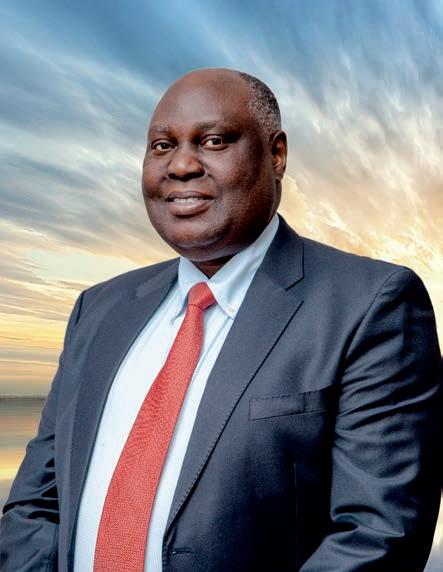

EDITORS’ NOTES Barbara Linarducci serves as the Chief Executive Officer and Vice-Chair of the Board of Trustees at the Silvermine Arts Center. Since 2016, she has played a pivotal role alongside Board Chair RoseMarie Fox in rescuing the century-old Arts Institution from dire financial circumstances. In a bold move, Linarducci implemented a significant restructuring of the management team and staff, leading to her assuming multiple additional roles including CFO, CIO, Development Officer, and Facilities Manager. Over a 25-year career in the computer software industry, Linarducci honed her expertise in two emerging technologies, namely Database Management and Enterprise Content Management. Her journey in the software industry began as a technologist, and she swiftly transitioned into sales roles, eventually assuming sales and service management positions in both well-established companies and startups. Linarducci’s passion for art runs deep, not only as a dedicated CEO, but also as an art lover and artisan.

Rose-Marie Fox’s life has been a fabric woven with art, profession, philanthropy, and adventure. From a young age, she created art on every surface available, culminating in her graduating with a BFA from Manhattanville College. At the same time, she studied accounting with an eye to a future career. Upon graduation, Fox commenced her career at AT&T in the areas of capital budgeting and strategic planning. Seeking advanced education in business, Fox achieved an MBA from The Wharton School of the University of Pennsylvania. She headed to Wall Street and built a career in investment banking representing the “Bell” companies at Lehman Brothers as a Senior Vice President, Corporate Finance. During this period, Fox served on the board of several New York City charitable and cultural not-for-profits such as Roundabout Theatre, and United Neighborhood Housing. Her career took a turn with an invitation from Edelson Technology Partners (ETP) to serve on the Valuation Committee of the board of ETP, a technology venture capital firm with corporate investors including AT&T and 3M.
With ETP backing, Fox founded Cornerstone Financial Co. with a focus on private equity and M&A in China which, in the early 1990s, was opening to foreign investment and partnerships. Retiring in 2011 at the age of 60, Fox relished the opportunity to return to art and enrolled fulltime at Silvermine School of Art where she was very impressed by the excellence of the instruction and the warmth of the Silvermine artist community. Fox was invited by Roger Mudre to join the Board and then shortly thereafter to succeed him as Board Chair as he was at the end of his term though he committed his continuing support. Seeing a rare opportunity to make a difference in a nearly 100-year-old institution by deploying professional management with an entrepreneurial spirit, Fox took on the challenge and a new personal adventure.


As a passionate connoisseur and advocate for the arts, Svetlin Tchakarov has dedicated a significant portion of his life fostering artistic creativity and expression. For over a decade, he has worked at Diageo, a global leader in beverage alcohol, in various Director roles where he has cultivated extensive experience in directing and improving operational performance. His enduring love for art and its digital evolution led him to the role as Co-Chair at the Silvermine Art Center. Always captivated by the convergence between technology and creativity, Tchakarov is an avid collector of largely digital art. Recognizing the enormous potential of the nascent metaverse, he sponsored the creation of the Silvermine Art Center’s virtual gallery in Somnium Space. Tchakarov’s vision for the future is to continue pushing the boundaries of digital art, to develop a vibrant and inclusive worldwide community that appreciates creativity, and to pave the way for the next generation of artists and collectors.

Roger Mudre is a seasoned professional in the art industry, currently serving as the Gallery Director at Silvermine. His career in the arts began in 1976 when he joined Koenig Artist Supplies where he gained valuable experience and knowledge of the business world. In 1993, Mudre embarked on an entrepreneurial journey as a self-employed decorative painter, honing his artistic skills and expanding his creative repertoire. Mudre’s association with Silvermine began in 1997, and since then he has held various roles within the organization, including trustee, Board Chair, and Co-Chair of the Silvermine Guild of Artists. In 2017, he assumed the pivotal position of Gallery Director, responsible for curating thoughtprovoking exhibitions exploring art’s societal significance. Mudre’s ability to connect deeply with the artists he represents stems from his background as a practicing artist represented by galleries, granting him a unique perspective and enabling him to advocate for their work effectively. Beyond his work at Silvermine, Mudre has dedicated over four decades of his life to a high school drama program. In this role, he has used the transformative power of the arts to engage troubled and extraordinary needs teenagers, providing them with an outlet for self-expression and personal growth. Mudre’s contributions to the arts have been widely recognized, and in 2004 he received the prestigious State of Connecticut Advocate for the Arts Award.
Founded in 1922, and incorporated in 1924, the Silvermine Arts Center (silvermineart.org) exhibits, teaches, collects, and interprets contemporary art for the inspiration and education of the public. Since its founding, Silvermine has grown to encompass a Guild of over 300 professional artists; five Galleries welcoming 12,000 visitors annually; a School of Art with over 4,000 annual enrollments, offering classes in an extraordinary range of media for students of all ages and abilities; and Outreach Education Programs serving over 2,000 under-resourced students annually.
Will you discuss the history of Silvermine Arts Center and how Silvermine has evolved?
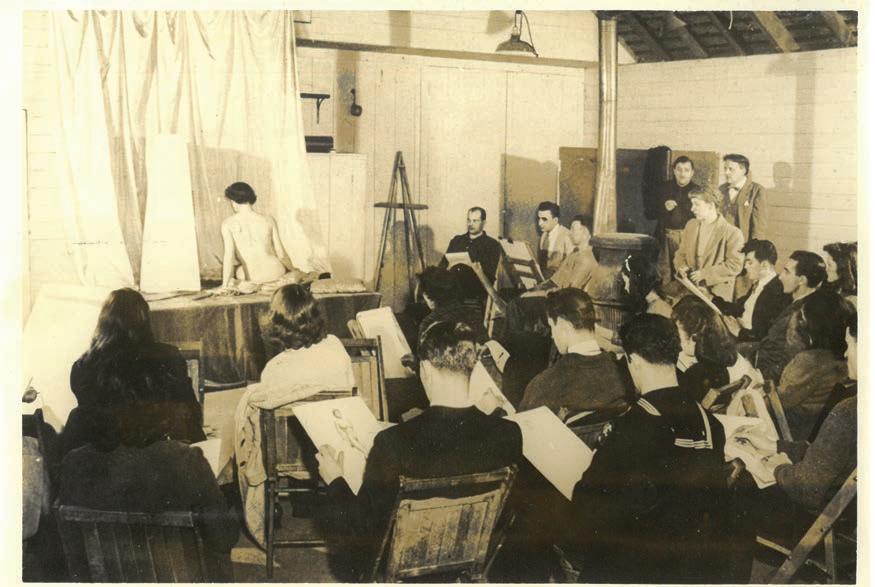
Linarducci : We are excited to be celebrating our 100th anniversary. Silvermine was founded in the early 1900s by a colony of professional artists who were residents of New York City, but had summer homes in the New Canaan area. Their mission originally as a colony was to support each other in the artistic community, and to exhibit and critique each other’s work. They formally organized as a Guild in 1922 and started the Silvermine School of Art. Education was a core focus for them.
There have been many changes at Silvermine over the past hundred years – we have grown from a single barn to a five-acre campus; we have a complex of five galleries; a School of Art with over 4,000 enrollments annually in a multitude of disciplines; as well as Outreach programs providing scholarships and educational opportunities for under-resourced students in our area. We also have a guild of over three hundred professional artists.
How do you define Silvermine’s mission?
Linarducci: We believe that art is essential to the human experience, contributing to our wellbeing and providing opportunities for personal growth and expression. Silvermine’s mission is to promote and encourage the development of the arts in all forms, showcasing and serving artists and providing opportunities for arts education and appreciation for the broader community.
Through our programming, Silvermine helps to support and nurture creativity and innovation. We foster an environment that encourages experimentation and exploration, giving artists the freedom to express themselves and push boundaries in their chosen medium. At the same time, we recognize the important role that arts education plays in the development of individuals and communities. By providing accessible
and inclusive opportunities for learning and engagement with the arts, Silvermine helps to build appreciation for the arts and to promote cultural understanding and awareness.
At the Silvermine Arts Center, we create a vibrant and supportive arts community that enriches the lives of all those who engage with us, whether as artists, students, or members of the public.

What have been the keys to Silvermine’s ability to stay relevant over 100 years?
Fox: It comes down to passion. The artists are on the leading edge, whether they use their art to communicate what is happening in culture
and society, or in terms of medium, technique, or style – they are always pushing the envelope. That creativity, coupled with their passion, has kept Silvermine relevant for all these years. As we move into the next century for Silvermine, we are cognizant of maintaining the legacy and history while we move into the metaverse and digital art.
How important is it to maintain the foundation and roots of Silvermine as it continues to evolve and adapt for the current times?
Fox: It is essential. We always talk about our programs being pathways to proficiency, which is about taking the classical training and moving it forward. Our roots are fundamental to who we are as an organization and provide the foundation for everything we do.
Will you provide a description of Silvermine School of Art?
Linarducci: Since its establishment in 1922, education has played a crucial role in the development of Silvermine. The Guild and the School of Art, rooted in shared traditions, have consistently upheld their commitment to educational excellence and integrity. Their primary mission has always been to foster, promote, and inspire artistic pursuits and art education.
Today, the renowned School of Art stands as the premier educational institution for visual arts in Fairfield County. With an impressive enrollment of over 4,000 students annually, spanning from ages 4 to 94, it caters to individuals at all levels of artistic proficiency, ranging from beginners to advanced practitioners. Offering a diverse selection of more than 1,100 courses, workshops, and youth programs throughout the year, the school cultivates a nurturing environment. It strikes a balance between providing the freedom to explore one’s creativity and instilling a strong foundation through disciplined instruction.
1930s figure drawing class at Silvermine Arts CenterWhat sets Silvermine apart and entices students to join and stay is its exceptional faculty of dedicated instructors. Additionally, the institution boasts the broadest array of disciplines available in the region, offering students unparalleled opportunities for artistic exploration. Indeed, there is no other place quite like Silvermine.
What is the focus of the International Artist-in-Residency program?
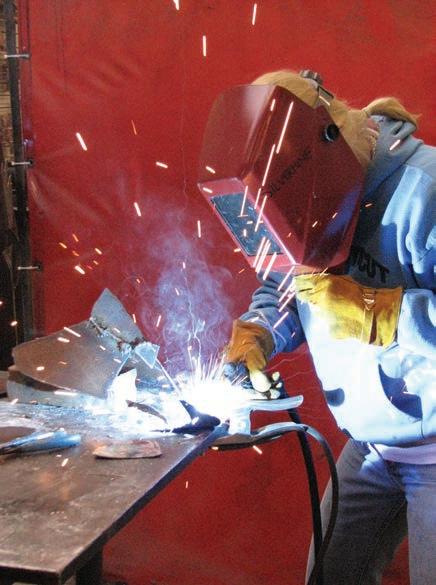
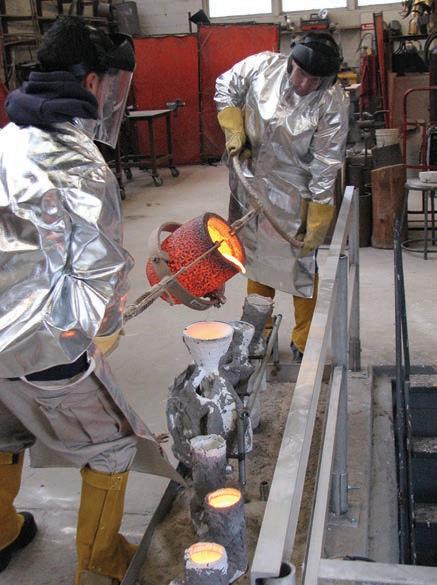
Linarducci: In 2019, Silvermine Arts Center established a new International Fulbright residency program, initiated and funded by artist and

philanthropist, Janet Hennessey Dilenschneider, and her husband, Robert Dilenschneider, and managed by the Institute of International Education (IIE). The IIE supports flagship exchange programs, including Fulbright, “to make the world a more interconnected place.”
The residency fosters creative and professional growth for emerging artists by providing an immersive environment on Silvermine’s campus with access to instructors in a wide range of mediums. These Fulbright scholars herald globally and contribute to art’s impact in creating a more connected world.
Will you provide an overview of the Silvermine gallery?
Mudre : I have been involved here since 1997 when I became a member, and have been involved in some aspects of the gallery for all that time. The gallery provides a place for our members to exhibit, and we now have artists from all over the world. When we were faced with the challenges of COVID, we immediately knew we needed to have a bigger presence online, and Barbara was able to secure the funding to make this happen. It is now possible to see every exhibit on our website and to see the artists and hear the artists talk about the artwork. Our artists are now seen worldwide.
The Silvermine Galleries showcase contemporary art exhibitions featuring the work of local, national, and international artists. These exhibitions span various art forms, including painting, sculpture, photography, printmaking, and mixed media. The galleries provide a platform for artists to exhibit their work and engage with the community.
Silvermine has a long-standing history of organizing acclaimed and accessible exhibitions accompanied by robust programs that encourage engagement with not only works of art, but also with artists, curators, faculty, students, and visitors across generations, building a sense of community.
Silvermine also seeks to use exhibitions in our galleries as a springboard for conversations about aesthetic ideas, humanities themes, and interdisciplinary contexts. Our galleries are free and open to the public, as are most of our programs, reflecting our goal to enrich the lives of diverse artists, students, and visitors from all social, economic, and educational backgrounds. Silvermine continually aspires to strengthen its role as an inclusive gathering place for transformative experiences with art that inspires creativity.
 Bronze pour and metal working in the sculpture studio
Cereus, 48 x 48, Acrylic on panel by Roger Mudre
Bronze pour and metal working in the sculpture studio
Cereus, 48 x 48, Acrylic on panel by Roger Mudre
What are the objectives of Silvermine’s Outreach Programs?
Linarducci : We believe the Arts have the power to shape and strengthen every aspect of a community. We know that art is a powerful tool for communication, education, enrichment and development for students of all ages and skill levels. Through our partnerships, Silvermine deepens and broadens its relevance to the community.
Our Educational Community Programs extend beyond the Silvermine campus to bring transformative programs that inspire creativity, build community, promote education, and offer enjoyment. Since 1992, Art Partners Programs have provided curriculum-based arts education for under-resourced Bridgeport, Norwalk and Stamford public schools. Serving over 2,000 at-risk urban youth annually, Art Partners help close Connecticut’s educational achievement gap – one of the largest in the nation – by providing access to the arts and unique enrichment programs designed specifically to target critical student needs.
Our programs have a proven track record of fully engaging students in the advancement of their critical thinking, problem-solving and collaboration competencies, supporting better academic achievement and life skills. The distinctiveness of our program lies in our professional Teaching Artists and their ability to collaborate with classroom teachers to tailor curriculumbased art classes for K-8 students that address their developmental needs.
We develop projects based on where the students need the most assistance. We collaborate with the public schools to meet our collective goals of enhancing literacy and social/ emotional skills while developing exciting projects that capture students’ imaginations, provide
much needed life skills, and even create the next generation of artists and innovators.
In 2019, Silvermine launched a new “ArtAcademy” program in partnership with STAR, Inc. to benefit people with disabilities. STAR, Inc. provides services for individuals with intellectual and developmental disabilities (I/DD) living in Fairfield County with opportunities to live full lives with respect, independence, freedom of choice and personal growth. ArtAcademy taps
into the transformative power of art to engage adults with I/DD in a variety of classes in an inclusive setting on our campus.
Professional art instruction encourages curiosity and builds skills and self-esteem. The program fosters not only artistic and social development, but also joy through art. Teaching Artists design the curriculum to encourage personal accomplishment and collaborative engagement with others as a team.



 Colorful Birch Trees, Diptych, Mixed Media 30 x 40 each by Jan Dilenschneider
Colorful Birch Trees, Diptych, Mixed Media 30 x 40 each by Jan Dilenschneider
ArtAcademy offers the resources and pathways for adults with I/DD to explore, develop, and share their talents – and perhaps even discover skills that might lead to career development.

You mentioned the need for Silvermine to pivot quickly to address the challenges resulting from the pandemic. Will you elaborate on how Silvermine navigated this uncertain and difficult time?
Linarducci: This was a very challenging time for Silvermine. We decided to close the facility earlier than most, but began to immediately plan for reopening as soon as possible. I personally felt strongly about the need to reopen because I believed that the community needed the type of experience that they get at Silvermine. Once we closed, we quicky engaged our website developers and, as Roger mentioned, we began to put our exhibitions online. Even though we were closed, Roger was in the gallery every day accepting work and photographing pieces to get them ready for the website. We knew that we needed to focus our efforts around social media in order to let people know that Silvermine was still here and operating.
We also had to invest in our facilities to prepare for reopening with new air filtration systems, and we implemented new safety procedures for how we were going to reopen. When the State of Connecticut allowed us to reopen, we were one of the first to open.
Fox: We were able to open for the children and youth in the New Canaan area when they had been so isolated during this time. We held the classes outside which provided more space, did temperature checks, everyone wore masks, and as a result, we had no spread of COVID from Silvermine so the procedures were effective. We knew that the community needed Silvermine and we were there for the community.
Mudre: When we reopened the gallery, we did it by reservation. We were fully booked because
I think that people just wanted to get outside and see art and feel a sense of normalcy. This was a difficult time for everyone in the community, and Silvermine was able to be a positive force for the well-being of our community.

Fox: I would add that because we had been financially responsible since the time we took over the management and leadership of Silvermine in 2016, we were able to financially weather the COVID storm. It was critical that we had effectively planned and managed our finances which is a testament to the strength and commitment of our entire leadership team.
How are you addressing the balance between the importance of the physical location for Silvermine and the growth of its online offerings?
Mudre: The online presence has been very valuable as we have increased art sales from people who viewed us online. We’ve noticed that many people who come to the gallery will tell us that they have already viewed the exhibition, so it has in many ways provided an invitation to get people to come through the door.
Fox: I think the in-person experience is critical throughout Silvermine, from our classes to the gallery, since there are emotions that you can only experience when you are here. That being said, online has given us much wider exposure and people who would have probably had no interaction with us now do. It has been more about expanding our reach, not replacing the importance of our facilities.
How do you describe the Silvermine experience?
Linarducci : I would call it inspiring. We have open houses every Fall when we have our instructors come and give demonstrations in their different areas of expertise and mediums. This allows the community to come to Silvermine and experience it, meet the instructors, talk about the classes offered, and see live demonstrations. Silvermine is part of the fabric of New Canaan, and the Fairfield County community. We are at the center of the community – engaging, socializing, and coming together around art and creativity.
Will you discuss the strength of the Silvermine staff?
Linarducci: Each member of our team brings unique skills and talents to the table, creating a formidable force that propels us forward. The strength of our staff lies not only in their individual capabilities, but also in their ability to collaborate seamlessly as a cohesive unit. We recognize
International Fulbright Artist-in-Residence, Razel Mari from the Philippines, at Silverminethe power of teamwork and understand that by combining our strengths and leveraging our diverse perspectives, we can overcome challenges that come our way.
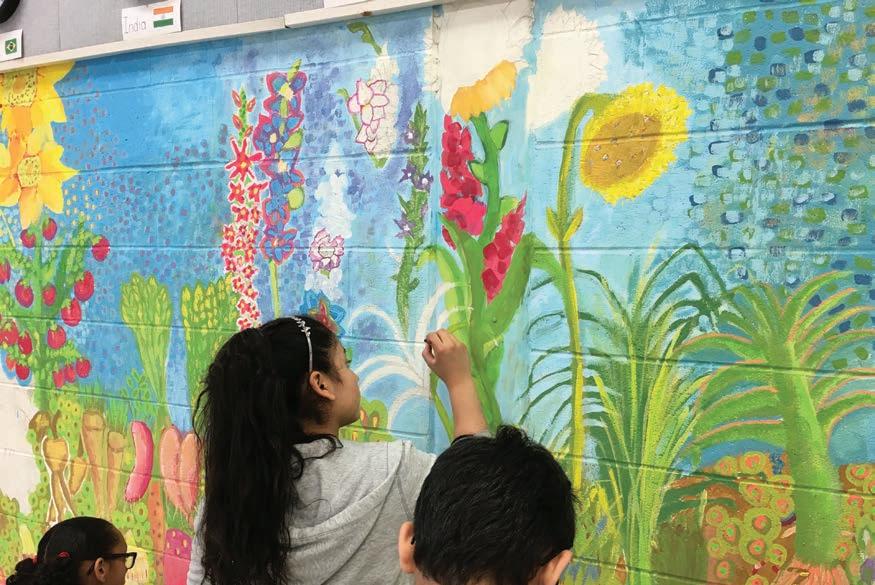
Will you discuss the importance of Silvermine having such an engaged and committed board?
Fox: One of the things that I love to hear from management and the board is how well they operate with each other. There is an open dialogue between board members and management – the communication channels are open and it is a tremendous working relationship. When we assumed responsibility at Silvermine we started evolving the board to encompass the artistic side and the business side. On the business side, the directors have a real passion for the arts, but may not be artists themselves. We have leadership expertise across the business spectrum, including finance, legal, marketing, sales, and technology. On the artistic side, we have a gallery director, guild artists, educators – it is really a blend. The board knows that we need money to make this organization work, and is very strong personally with philanthropy as well as reaching out to the community for support.
Linarducci: We believe leadership comes from selecting and developing the right team at the Board and at key management and staff positions that share a vision for the future and flexibility to react to opportunities and challenges, with a spirit of open communication, respectful dialogue, and an action-oriented approach where advancement to goals is predictable.
What has made the working relationship between all of you work so well?
Mudre: I think a big part of it is that we are truly friends. We work so closely together and have created a great relationship, based on mutual respect and trust. We will be friends long after we leave Silvermine.
Fox: When we took over Silvermine, it was in a very difficult place financially. It needed people with passion who were not going to let it fail. We looked at each other and knew we could do it – I come from a finance background, Barbara from an operations background, and Roger from his artist background. We made a commitment that we were going to turn the ship around and save Silvermine. We went from many years of losses prior to our leadership, and after the first year, turned it positive. When you go through that experience together, it forges friendships.
Linarducci: We changed a lot of the staff, and even though we have a small staff, we have brought on people with a can-do attitude who work collaboratively and share a common goal. We are a team, and our success has been because of the strength of every member of the team.
What are your plans for Silvermine as you embark on the next century?
Tchakarov: For the past century, Silvermine Arts Center has championed art creation as well as its understanding and appreciation. As we embark on the next century, we are implementing new ideas to entice young artists and collectors, notably by expanding into the metaverse by launching in 2022, Silvermine Galleries in Somnium Space, now open to visitors from all around the world. This digital addition transcends geographical limits, increases the accessibility of art, and encourages cultural exchange. Anyone from anywhere in the world is welcome to come see it, enjoy it, and engage in conversation with other art enthusiasts and collectors in an immersive environment. Our mission is to develop on-line communities and virtual spaces in which guests can interact not only with works, but also with the artists directly, fostering a deeper connection.
Through expansion into the metaverse, Silvermine aims to broaden the art experience, engaging larger audiences and presenting novel opportunities for artists and collectors, while preserving Silvermine’s classical art appreciation and cultural legacy.
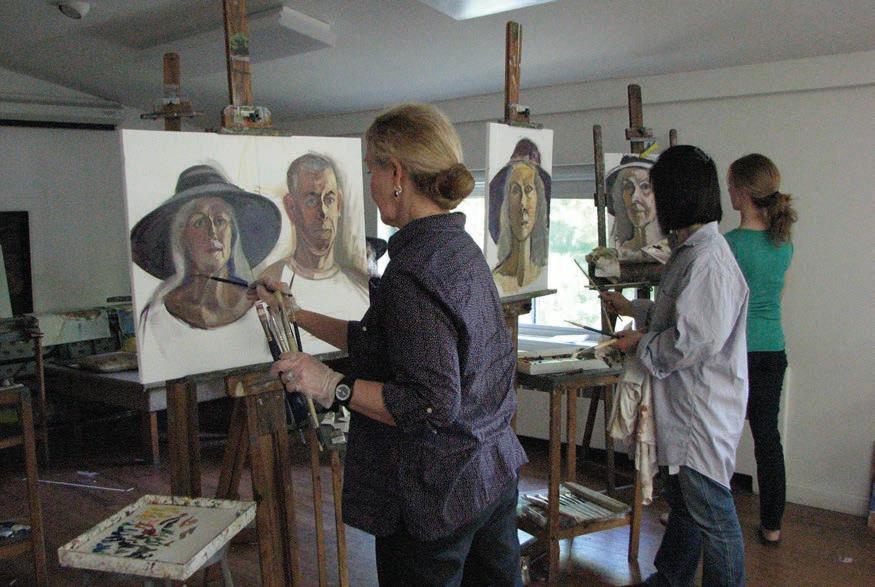
As Silvermine celebrates its 100th anniversary, are you able to enjoy the process and appreciate what you have accomplished?
Fox: We love the process. Even in the most difficult of times, we embraced the struggle, taking on the challenge to achieve what we knew was necessary.
Linarducci: We support each other and we are all committed to leaving Silvermine better than how we found it.•
Adult portrait painting classEDITORS’ NOTE Taryn Brandes founded Brand Urban to bring a specialized and thoughtful approach to her real estate tenant representation and landlord advisory business. Prior to launching Brand Urban in 2019, she worked at SCG Retail, an urban division of The Shopping Center Group based in New York City. Brandes has been awarded The Rising Star Award in the Commercial Observer’s Power 100 issue. She sits on the Board of Directors for Maman. Active in the community, she is a member of the New York City Hospitality Group (NYCHG) and the UJA Federation REX Planning Committee. Brandes earned a BS degree from Tufts University.
 Taryn Brandes
Taryn Brandes
How do you describe Brand Urban’s culture and values?
What differentiates the Brand Urban company culture is our unparalleled passion and authentic expertise. We prioritize and value partnership, transparency, thoughtful strategy, analysis, and creativity. We approach our business with an entrepreneurial spirit and prioritize collaboration and teamwork above everything else. Our office is motivated by, immersed in, and excited by what we do, the brands we touch and the markets we work in. Our work in essence extends outside the workplace – when we travel, dine out with friends, and experience new brands in our daily lives. Will you provide an overview of Brand Urban’s services and solutions?
landlords, focused on hospitality and lifestyle retail. Our services include strategic planning, detailed-analyses, and a disciplined dealmaking process given our unique national perspective and knowledge base.
On the tenant-advisory side of the business, we develop and execute multi-unit expansion strategies for growth stage companies both locally and nationally – with services ranging from strategic development, market analysis, site selection and deal negotiation.
COMPANY BRIEF Working with both tenants and landlords, Brand Urban (brandurbanre.com) has become a strategic consultant and leasing advisor by leveraging its team’s deep understanding of brands, their businesses, and their core customer. Its team specializes in real estate expansion strategies for growth stage companies, and partners with like-minded landlords to shape communities through thoughtful placemaking and leasing of their assets. Clients include Planta Restaurants, Shake Shack, Maman, WTHN Acupuncture, ICONIQ Capital, Prudential and RXR. Brand Urban is passionate about hospitality, retail, and the vibrancy of the brands it works with. The company has a unique approach to the brokerage business and values partnership, honesty, and creativity as the basis for the results it achieves.
Our platform provides national consulting and brokerage services for both tenants and
On the landlord-advisory side of the business, we essentially help turn real estate assets into brands, through thoughtful retail curation, programming, and leasing strategy –with a large focus on hospitality. Over the past year, we integrated placemakingconsulting into our landlord-advisory platform. We expanded our team’s expertise with marketing and public activation know-how to provide innovative leasing, placemaking, and
Brand Urban and how do you define its mission?
The vision and driving force behind building Brand Urban’s business was to work with like-minded consumer brands, restaurant operators, and real estate developers on projects where we are the core consumers. I wanted to develop a retail real estate advisory platform that was focused on “strategy” before “brokerage;” brokerage just being one of the services we provide for our clients.
We are excited about hospitality, lifestyle retail, the projects we help re-imagine and the markets we help shape – and we love partnering with growth-stage companies where we play an integral part in their success stories.
“The vision and driving force behind building Brand Urban’s business was to work with likeminded consumer brands, restaurant operators, and real estate developers on projects where we are the core consumers. I wanted to develop a retail real estate advisory platform that was focused on ‘strategy’ before ‘brokerage;’ brokerage just being one of the services we provide for our clients.”
related consulting solutions for developers. Our team’s differentiated expertise provides landlords with a full stack “marketing to lease” platform.
Will you highlight Brand Urban’s approach to the brokerage business?
Our team’s unique expertise, knowledge base, and strategic analysis differentiates us in the business. We have become experts in all major metro lifestyle corridors nationwide –both urban and suburban, in part because of the strategic roll-out work we have done for our tenants in all these markets. As a result, we bring tremendous knowledge and value on the landlord-side of the business when working on projects in these cities.
We approach growth-strategy for our tenants, merchandising-strategy for our landlords, and ultimately the dealmaking process for our clients with the foundation of understanding these brands and their business models in a unique way. We spend a great deal of time analyzing the brands, their businesses, and the markets that we study both personally and professionally – which sets us apart from most –allowing for the most thoughtful real estate positioning and most advantageous deal terms to be negotiated for our clients.
We deeply consider the long-term goals and business strategies of the clients we work with. We are invested as brand ambassadors and value-add thought-partners for the life of each brand – and similarly on the landlordadvisory side. Our advisory is prudent and deeply considered because these are brands that we and our peers touch and experience
daily. That depth of knowledge and understanding is a big part of our motivation and excitement, ultimately setting us apart from our competitors with a genuine and personal touch.
Where do you see growth opportunities for Brand Urban as you look to the future?
We’re extremely energized by the strategic expansion work we’ve done for brands like Planta and Maman. Maman, for example, we took from six to thirty units, and Planta from five to twenty units open and under development in just over three years. We’re honored to be a part of these long-term success stories that now are nationally recognized lifestyle brands and leaders in their categories. Looking ahead, we’re focused on building upon this momentum and broadening the types of clients we service outside of food and beverage, and into complementary use-groups in lifestyle retail, beauty and wellness that cater to the clientele we know so well.
Further opportunity for Brand Urban is expanding our strategic growth and development work on the brand-side by broadening our services and tapping into the private equity companies themselves by advising these firms as they analyze potential investments in the consumer, brick and mortar-space. Similarly, we are excited to pursue expanding our current landlord advisory platform and take on greater placemaking opportunities that include groundup and major redevelopments – combining and enhancing the various services that Brand Urban currently offers.
Will you discuss the talent and expertise of the Brand Urban team?
We work differently. Brand Urban works in a team-based environment, with strategy and collaboration as the foundation of our platform. At many traditional brokerages, most brokers effectively work on their own individual books of business. At Brand Urban, we work as one integrated, multifaceted consultancy – providing services that range from strategic planning and development to real estate marketing, leasing, and placemaking strategy, all the way to brokerage services in site selection and deal negotiation. We all specialize in different aspects of the business, and work collaboratively as a team to execute on each project.
Everyone at Brand Urban has a breadth of knowledge that supports our mission. Some are data-driven, some are highly experienced brokers, and others are incredible marketers and storytellers who really understand brand positioning. Plus, we have those experienced in pop-ups and short-term activations. Our collective backgrounds in food and beverage, fashion, and lifestyle catered to the next generation-consumer allow us to service clients in a holistic way.
Did you always know that you had an entrepreneurial spirit and desire to build your own company?
Yes, I’ve always had an entrepreneurial spark, which I am told is immediately evident by the passion and excitement in my voice when I talk about the business I have built and the space I am creating within the industry. I realized early on that entrepreneurship was the path I wanted to pursue, and both my father and fatherin-law have played a big role in this as they are successful entrepreneurs and creative businesspeople in the real estate world. Growing up under my dad’s influence instilled in me his entrepreneurial curiosity and core values: a strong work ethic and drive to think outside the box, pushing the boundaries of what my business could look like – with the guiding principle of doing something that excites me. By surrounding myself with a great team, embracing guidance from influential people in my life and having confidence in my intuition, I feel empowered to forge my own path and lean into my own concept of what a brokerage and advisory company can be.
What advice do you offer to young people interested in building a career in the commercial brokerage business?
I have one key piece of advice. The most important thing to remember is that it is not about what you are working on, but who you’re working with. Having proper mentorship is everything when you enter the industry. You want to be working with people who are willing to put in the time to train you, giving you the utmost exposure and experience you need to learn and confirm your interests, skillset, and passion for the business. The people who are willing to invest in you and want to see you grow are far more pivotal to your career than what you are working on when you’re getting started. I have incredible respect, admiration, and appreciation for my mentors and teachers over the years in this business. I would not be where I am today without them.•
“At Brand Urban, we work as one integrated, multifaceted consultancy – providing services that range from strategic planning and development to real estate marketing, leasing, and placemaking strategy, all the way to brokerage services in site selection and deal negotiation. We all specialize in different aspects of the business, and work collaboratively as a team to execute on each project.”
EDITORS’ NOTE For more than 20 years, Jordan Kavana has been a noteworthy leader in the real estate space and developed one of the first single family home for rent platforms operating nationally. As the Chief Executive Officer of ARK Homes for Rent, his mission is to provide quality housing for families embodying good health and well-being for residents through amenities in the communities and to generate strong riskadjusted returns for investors. After establishing Transcendent Investment Management in 2008 to lay the foundation for his vision of a data-driven platform in the single-family residential space, he formed the firm’s vertically integrated Build U.S. Back line of companies as its operating platform to research, select, acquire, renovate, rent and resell properties in-house. This led him to become the subject of a 2014 Harvard Business School case study, “Build U.S. Back: Opportunities in the U.S. housing market.” Kavana has led TIM through completion of over $3.5 billion in real estate transactions and has expertise in the major
Sunbelt markets. To continue the hypergrowth, in 2021, Transcendent Electra Management was formed, a joint venture between single-family rental (SFR) platform Transcendent Investment Management (TIM), and longtime multifamily owner/operator, Electra America. With this venture, the investment platform, now known as ARK Homes for Rent, aims to acquire or develop approximately $3 billion in SFR housing over the next three years, focusing on Build to Rent homes and single-family homes for rent. The platform is unique in the industry given that it is the only one that buys newly built homes only and because of its preventative health platform, ARK Living. Prior to launching ARK Homes for Rent, Kavana successfully formed and grew an international high-tech toy company in China, which he sold in 2003 to return to the U.S. where he co-founded JL Real Ventures, a private equity fund that assembled a portfolio of multi-family properties in the Southeastern United States. He is a founding member of AIPAC’s Miami club, and served as a trustee on the Florida State
Pension Plan Board. Kavana received inclusion into Latin Trade’s Top 100 Most Powerful Businesspeople listing of the year. He earned his BA degree in hospitality management and finance from Florida International University, pursued graduate-level studies in real estate finance at Harvard University, and is a graduate of Harvard Business School’s OPM program.
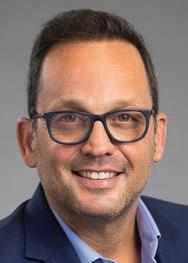
COMPANY BRIEF ARK Homes for Rent (arkhomesforrent.com) creates communities that cater to its residents’ holistic wellness. Surrounded by natural beauty, its brand-new homes enable renters to live active, free, and healthy lives, while its proprietary ARK Living App allows access to round-the-clock healthcare, property maintenance, and on-demand wellness content. Backed by decades of experience in managing homes, ARK Homes for Rent also brings an educated lens to leasing budget-friendly, single-family housing.
What was the vision for creating ARK Homes for Rent, and how do you define its mission?
We aim to create a lifestyle that fosters a sense of community, offers comfort, and promotes an enriching environment where residents feel safe, cherished, and interconnected. We strive to deliver an unparalleled living experience to our residents that prioritizes their quality of life, the amenities we provide, and the services we extend. Every initiative we undertake is tailored to enhance the lives of our residents.
How is ARK Homes for Rent transforming the American rental experience?

Unlike other single-family rental service providers, ARK Homes for Rent offers its residents newly built homes, each backed by warranties from top-tier home constructors. Our portfolio includes homes replete with outstanding features, such as new appliances, granite countertops, decorative backsplashes, energy-efficient appliances, and hardwood flooring. Our properties are located near schools, business hubs, and recreational facilities. Embracing modern technologies, we’ve simplified the rental journey. Through our dedicated ARK Homes for Rent App, our residents can conveniently make payments and schedule maintenance appointments. An additional benefit for ARK Homes for Rent residents is access to our exclusive ARK Living platform. This proprietary tool promotes and maintains their overall health and well-being.
How do you describe the ARK Homes for Rent difference?
What sets us apart and fortifies our position is our unique business model. ARK Homes for Rent exclusively offers newly built homes, complete with builder home warranties, to our clients across the Sun Belt region. The company has charted a robust investment strategy of over $3 billion for single-family properties in this area over the next three years. This ambitious plan aims to double our current portfolio heading towards 10,000 managed homes to exceed 20,000.
Where do you see the greatest opportunities for growth for ARK Homes for Rent?

ARK Homes for Rent’s primary avenue for expansion lies in our continued investment in the Sun Belt region. This area is experiencing increased migration from major gateway cities such as New York, Chicago, and Boston, driven by its thriving economic development initiatives and opportunities. Despite the fluctuations in interest rates, the Sun Belt’s rental markets experienced substantial rent growth from 2020 to 2022. Even with current higher interest rates, rents persist in rising, albeit at a slower pace than during the earlier stages of the pandemic.
Long-term projections show sustained migration to the Sun Belt, sparking further demand for residential development. A shift is being observed in our society as it transitions from a nation predominantly of homeowners to one of the renters – a change from past generations. The younger demographic is considering factors such as quality of life when deciding where to reside and work. Given the region’s lower taxes, pro-business economic policies, and warmer climates, an increasing number of renters are setting their sights on communities within the Sun Belt region, as opposed to traditional gateway cities across the country.
How critical has it been to build the ARK Homes for Rent team, and will you highlight the strength and expertise of the workforce?
Building the ideal team has been pivotal to the success of ARK Homes for Rent. Our team is a blend of professionals from multiple sectors, including real estate acquisition, finance, accounting, property management, preventative healthcare, and technology.

The diversity in our team’s skills and backgrounds has enabled us to build an outstanding service offering with a keen focus on delivering an exceptional rental experience to our clientele. We consider our team our most valuable resource. Their proficiency, commitment, and dedication to our mission distinguish us from other players in our field.
What do you see as ARK Homes for Rent’s responsibility to be engaged in the communities it serves?
Discussions around well-being often cater to the 1 percent. What about the remaining 99 percent? This majority is where our focus lies. Beginning with the ARK Homes for Rent portfolio, we are introducing ARK Living, a health and wellbeing program designed to be inclusive for all.
Moreover, we have collaborated with the National Rental Home Council (NRHC) to establish the industry’s inaugural Health and Well-Being Council. This council will utilize the NRHC member network to pinpoint crucial areas of practice that may influence the health and wellness of residents. Its objective is to inform and educate homeowners about these vital factors in managing, operating, and constructing single-family rental homes. It’s an honor for me to serve as the Chair of this council. I firmly believe we are in a position to positively impact millions of renters nationwide.
Did you always know that you had an entrepreneurial spirit and desire to build your own business?
My family lineage consists of Holocaust survivors who overcame unimaginable adversity. Despite their hardships, they found ways to attain balance and success in their lives after relocating to Uruguay, where I was born. Their journey taught me that while starting a business comes with challenges, they pale compared to the real trials of life, such as the ones my family surmounted. Their resilience, perseverance, and disruptive spirit instilled in me a desire to challenge the status quo and become a disruptor myself.
With this mindset, while attending business school, I established my own business in Asia centered around consumer electronics. We developed an award-winning product line and grew sales to $40 million, successfully cultivating a toptier customer base that included notable retailers such as Best Buy and Walmart. In 2008, amid the housing downturn, I identified a business opportunity. I consequently founded Transcendent Investment Management, an operational platform dedicated to researching, selecting, acquiring, renovating, renting, and reselling single-family properties across more than 50 markets nationwide.•
An ARK Homes for Rent developmentEDITORS’ NOTE Anita Busch and her family have suffered through two mass shootings – the theater shooting in Aurora, Colorado and the Route 91 concert in Las Vegas, Nevada. After her cousin, Micayla, was murdered at the movie theater massacre in Aurora that left 12 dead (and an unborn baby) and 70 injured, Busch helped create a new model for charitable giving to ensure that 100 percent of donations collected for victims of mass casualty crime actually go directly to those victims, so donor intent is honored. Busch gathered together parents and family members of those killed in 9/11, Columbine, Virginia Tech, Northern Illinois University, Aurora, Oak Creek Sikh Temple, and Sandy Hook – to craft the protocol for the National Compassion Fund which has been utilized after multiple mass casualty crimes, including Ft. Hood, Aurora, Chattanooga, Orlando Pulse, Las Vegas, Charlottesville, Parkland, Santa Fe, Jacksonville, Cincinnati, Highland Park, El Paso, Milwaukee, Atlanta, Indianapolis, Uvalde, and Louisville. She also served as a victim’s specialist/advocate helping the Ventura County Community Fund distribute donations to survivors after the Borderline Bar & Grill shooting in Thousand Oaks, California. Busch is a key co-founder of the National Compassion Fund and currently serves as a Mass Violence Relief Specialist and Advisor to the Fund. To date, she has personally helped victims, survivors, and/or communities behind the scenes in over 45 mass casualty crimes. For over a decade, she has interviewed mass shooting families of the deceased, and those survivors injured both physically and mentally after mass shootings to

develop Best Practices for Mass Casualty Crime, a trauma-informed, live, victim-centric document which helps communities organize after these tragic events without re-victimizing victims. Best Practices has been shared by politicians, mass shooting victims and communities around the country and worldwide.
ORGANIZATION BRIEF VictimsFirst (victimsfirst.org) is a network of surviving victims of mass casualty crime and trusted supporters who have first-hand experiences of the problems and re-victimization that accompany these acts when there is a lack of coordinated effort and/or understanding of what survivors need. In 2021, VictimsFirst officially applied to become a 501(c)(3) to better serve victims of mass casualty crimes. The organization works pro bono and is a member of the Advancing Bereavement Care Coalition (ABCC), which represents millions of bereaved Americans and frontline practitioners across the nation. Collectively, these organizations have expertise supporting and advocating on behalf of bereaved individuals, including those who need bereavement leave due to pregnancy, stillbirth, child, sibling, spousal or parent loss.
What was the vision for creating VictimsFirst and how do you define its mission?
Our vision was to ensure that victims of mass violence receive the care and help that they need during the most excruciating time of their lives. We knew that a critical way to do this was by helping communities organize in the aftermath of mass violence in the best interests
of those most directly impacted: the victims and survivors. We created VictimsFirst in 2012 as a grassroots network of mass shooting families who banded together to provide mutual aid and fight against our own re-victimization in the aftermath of the Aurora theater shooting where my cousin, Micayla, was one of the 12 people murdered.
We were horrified when a nonprofit began collecting funds and the first $100,000 went to other nonprofits instead of directly to the victims and survivors who desperately needed it, and they were using our murdered loved ones’ faces to collect those donations. I learned that similar things happened to previous mass shooting families. Donors were surprised to learn this as well.
After the Sandy Hook school shooting, we worked behind the scenes to try to keep families and survivors on their feet and from being similarly re-victimized. I gathered families of the deceased together from Columbine, Virginia Tech, NIU, Aurora, Oak Creek Sikh Temple, and Newtown. Together, we put together a protocol, named, funded, and began the National Compassion Fund to administer Centralized Victims’ Funds wherever a mass casualty crime was to occur throughout the country which guarantees every penny collected goes directly to survivors in cash payments in a way that is ethical, equitable, and transparent.
After that, I led the next generation of mass shooting victims, survivors, and trusted advocates to establish VictimsFirst as an official nonprofit. Over the past 10 years, I have personally worked behind the scenes on 47 mass casualty crimes. Our board consists of those wounded and injured in some of the most highly publicized mass shootings in America
“We created VictimsFirst in 2012 as a grassroots network of mass shooting families who banded together to provide mutual aid and fight against our own re-victimization in the aftermath of the Aurora theater shooting where my cousin, Micayla, was one of the 12 people murdered.”
and they have responded to many shootings over the years.
I can tell you with certainty that VictimsFirst is the only nonprofit in the U.S. dedicated to helping victims of mass violence with 100 percent of funds raised going directly to victims’ families and survivors. We have the only National Mass Shooting Victims’ Fund in the nation that provides direct emergency financial assistance to survivors of mass violence at any time of need.
We are the first and only nonprofit in the nation providing an updated, victim-centric, trauma-informed Best Practices for Mass Casualty Crime which helps communities to organize in the best interests of the victims. Our Best Practices were written from the point-of-view of victims and survivors themselves, documenting what works and what doesn’t and how to better serve the victim base in the aftermath of mass violence.
Community preparedness is key, and we are there to shine the light on the path to make sure no one stumbles. We are also there to help victims and survivors get back on their feet with resources and immediate financial needs.
What makes the work of VictimsFirst so personal to you?
My family has endured two mass shootings: one in 2012, where a generation of my family was wiped out when Micayla was murdered along with 11 others in the Aurora theater mass shooting; and another in 2017, when Stacy survived by running for her life through a hail of bullets at the Rt. 91 concert in Las Vegas. I have known many other mass shooting families for over 10 and a half years – some of them have become lifelong friends and even family to me.
You often hear about the rash of mass shootings and the number of people killed,
but these are not numbers to us. These are our moms and dads, children, brothers, sisters, cousins, grandmothers, grandfathers, partners, and extended family. Because it is so personal, we have taken no salaries or administration fees. For added transparency, we collect donations to operate the organization separately.
VictimsFirst is now composed of over 20 years of mass shooting families from across the nation, from Columbine to Uvalde, Orlando to Colorado Springs, Aurora to Virginia Tech. We just want things to go easier for the next set of unfortunate families. We do not want anyone to endure what we have in the aftermath of mass shootings.
Who better to step up in the chaos and assist communities on how to organize in the right way while keeping victim/survivor dignity and privacy than those of us who have firsthand experience with this and over many years? Those who lived through this are the nation’s experts.
Will you provide an overview of VictimsFirst’s programs and initiatives?
First and foremost, we provide Best Practices for Mass Casualty Crime guidelines to communities in the aftermath of a mass casualty crime. We provide free consultation to community leaders and urge each community to first create a centralized victims’ fund to capture donations for the victim base immediately after a mass casualty crime. We urge communities across the nation to have a plan in place before mass violence hits.
We provide immediate emergency financial assistance for victims’ immediate family members and survivors while communities work to organize. We also fundraise for the specific victim base in a separate bank
account, and 100 percent of what we collect goes to whatever Centralized Victims’ Fund is created. For instance, in Colorado Springs and Uvalde, we raised funds for the entire victim base, while also keeping people on their feet there and across the nation with immediate and emergency financial needs through our separate National Mass Shooting Victims’ Fund.
In addition, we provide many, many other resources – be it assistance with sudden accessibility needs to finding medical specialists, trauma specialists, jobs, advocating for victims’ rights – honestly, whatever is needed, we find the resource or are the resource. For example, when a victim of a mass shooting is catastrophically injured, they cannot just leave the hospital and go back into their homes in wheelchairs and with walkers. In Colorado Springs, we found a flooring company that was able to replace the shag carpeting so when a victim who was shot multiple times returned home, his walker would glide easily over the floor. We have done this more than once and have assisted with other accessibility needs. Also, when trauma knocked a survivor out of their job in Uvalde, we sat down and helped them create a new resume and then culled together a list of possible employers to help them secure a new job. We have fixed cars so people can get to jobs and job interviews. We have bought groceries and paid rent, utility, and medical bills.
We do this for victims and survivors of any mass violence across America at any time in their path forward.
Will you highlight VictimsFirst’s Best Practices and how this provides a roadmap for communities, families, and individuals to utilize if they are impacted by a mass casualty crime?
“We were horrified when a nonprofit began collecting funds and the first $100,000 went to other nonprofits instead of directly to the victims and survivors who desperately needed it, and they were using our murdered loved ones’ faces to collect those donations. I learned that similar things happened to previous mass shooting families.”
“We are the first and only nonprofit in the nation providing an updated, victim-centric, trauma-informed Best Practices for Mass Casualty Crime which helps communities to organize in the best interests of the victims.”
Our Best Practices for Mass Casualty Crime is a roadmap that we share with communities. It is the only resource of its kind and includes a wealth of information that empowers communities to respond in the best interests of the victims and survivors. Our Best Practices includes guidance on ethical fundraising, appropriate language use, immediate needs and resources, and what local businesses can offer. For instance, it explains that many people do not like to hear that their child was “lost” and would rather hear, “I’m sorry your child was stolen from you, taken from you, or murdered.” Similarly, calling the one-year mark of the shooting an “anniversary” is not the best choice of words as it is nothing to celebrate – rather use year-marks or year remembrances.
We also provide guidance to the media and others to focus on the victims and heroes and not the shooter – fully endorsing the No Notoriety campaign begun by Tom and Caren Teves after their son Alex Teves was murdered while successfully protecting his girlfriend in the Aurora theater shooting.
There are generous donors who want to pay for funerals, but funeral costs can be reimbursed by victim compensation programs. Through our Best Practices, we make communities aware of this while explaining that the cost of the burial plots and headstones are usually not covered and can be extraordinarily expensive.
We also address the issue of food insecurity after mass violence. For example, people often want to start meal trains to help families. Our Best Practices teach that there is a way to do this to keep victims/survivors’ addresses off the Internet, maintain their privacy, and keep them safe.
Our Best Practices addresses a wide variety of issues and is the go-to guide for truly helping victims and survivors of mass violence. We continuously update our Best Practices for Mass Casualty Crime after each tragedy, because every community, victim base, and incident is different and we always learn something new when we respond.
What are the areas where communities, law enforcement, and politicians can do better if a mass casualty crime takes place in their community?
We urge each community to immediately start a Centralized Victims’ Fund, one where 100 percent of what is collected into that fund goes directly to the victim base. This provides clarity and transparency for both the donors and the victims/survivors.
Oftentimes, nonprofits start collecting and nothing goes directly to victims when they truly need help. Nonprofits can apply for grants, but victims and survivors rely heavily on those donations to make ends meet when they can no longer work from trauma. It takes time to learn how to manage and cope after a sudden, violent act that rips a healthy child or parent away from your family. Physical rehabilitation or acclimating to a new way of life after being shot also takes time and survivors need every penny intended for them. We believe that after a tragedy, generous people give to help the victims and survivors directly. There is no doubt what their intent is, and it is important it is fulfilled.
After a mass shooting, you feel a loss of control. Having donations coming directly to you so you can make your own decisions on your own finances is critical to mental health. Oftentimes, community nonprofits want to hold onto funds for “long-term care,” treating the person or family victimized like children. We are all families who are already paying bills, rent, mortgage, car payments, taking care of children, putting them through college – no one appreciates having to go back repeatedly to a nonprofit, with hat in hand, to ask for donations that are already intended for you. It is re-victimizing to have that control further taken from you and being treated like a child by a community nonprofit.
We also urge politicians to put victims first before their careers. If you speak at a memorial, know how to pronounce the names of those who were murdered. Make sure your community takes advantage of the millions of dollars in mental health grants that are available at both the state and federal level and apply immediately for those grants.
Do not move forward on a memorial without the input of the families of the deceased. We have seen expensive park benches and scholarships be established in the victims’ names while the families themselves whose loved ones are being honored are unable to pay their bills. Ask the victims’ families what they want. Also, people are more important than construction projects. We have seen this in Orlando after the nightclub shooting where a nonprofit began collecting millions of dollars for a museum while the victims could not pay bills. This is wrong. The priority should always be ensuring the basic needs of survivors are met, first and foremost.
For law enforcement, please inform families as soon as possible that their loved ones have been murdered and do it with compassion. We have waited overnight; it was 19 hours for our family to receive the news that Micayla was murdered. And the way some parents have been informed lacked any semblance of empathy.
Every Attorney General or Secretary of State across America should be bird-dogging both fundraisers and nonprofits after a mass shooting to ensure donations collected for victims goes to victims and that nonprofits follow the law. VictimsFirst has been doing this on our own, and for years. In Uvalde, we turned in two questionable nonprofits/fundraisers to the Texas Attorney General’s office for further review.
And please, please make sure the families of the deceased are able to contact each other if they want to. This is key to helping people manage their trauma, and it’s just not being done right now.
How important are metrics to measure the impact of VictimsFirst’s efforts?
So much of what we do is not measurable, whether that’s talking to mass shooting survivors through a challenging time or out of suicide, reaching out to hospitals to ensure medical services are donated, or helping organize a press conference or event to amplify the voices of survivors.
However, there is a lot that we do that can be measured through various metrics. For instance, we keep track of the number of victims we help across the country, whether that’s with direct financial assistance or ensuring a survivor gets adequate mental health support. We also keep track of how much money has been raised and disbursed to victims’ immediate family members and survivors, whether that’s through our National Mass Shooting Victims’ Fund or our location-specific funds. For example, in 2022 we responded to eight mass shootings, collected a total of $8,802,555.77 for five specific mass shootings – 100 percent of those donations, every penny, went directly to victims – and we distributed an additional $206,342.28 directly to victims through our National Fund.
The older generation of mass shooting families are now preparing the next generation to take over the work. It’s sad to say there even is a next generation. The victims and survivors from the Orlando nightclub shooting, Las Vegas, Parkland, Uvalde are the next generation. Let’s hope there is not another. •
“Our Best Practices for Mass Casualty Crime is a roadmap that we share with communities. It is the only resource of its kind and includes a wealth of information that empowers communities to respond in the best interests of the victims and survivors.”



EDITORS’ NOTE Michael Dowling is one of healthcare’s most influential voices, taking a stand on societal issues such as gun violence and immigration that many health system CEOs shy away from. His leadership has been invaluable to Northwell’s consistent expansion and prominence. In March 2020, he successfully navigated the health system through the first COVID-19 epicenter in the U.S., detailing Northwell’s experiences in a book titled, Leading Through a Pandemic: The Inside Story of Humanity, Innovation, and Lessons Learned During the COVID-19 Crisis. Overall, Northwell treated over 300,000 COVID patients – more than any other U.S. health system.
Prior to becoming CEO in 2002 and joining Northwell in 1995, Dowling served in New York State government for 12 years, including seven years as State Director of Health, Education, and Human Services and Deputy Secretary to the Governor. He was also Commissioner of the State Department of Social Services. Earlier, he was a Professor of Social Policy and Assistant Dean at the Fordham University Graduate School of Social Services and Director of the Fordham campus in Westchester County. Dowling has been honored with many awards and recognitions over the years, including the Ellis Island Medal of Honor, the Presidential Distinguished Service Award for the Irish Abroad, the Alfred E. Smith Award from the American Society for Public Administration, the National Human Relations Award from the American Jewish Committee, and the Foreign Policy Association Medal Award. In 2017, he was selected to serve as the Grand Marshal of New York’s St. Patrick’s Day Parade. In 2022, he was named the most influential leader in healthcare by Modern Healthcare, ranking #1 in its annual list of the “100 Most Powerful People in Healthcare” making it the 16th consecutive year he was featured.


Dowling is past Chair of the Healthcare Institute and the current Chair of the Institute for Healthcare Improvement (IHI). He is a member of the Institute of Medicine of the National Academies of Sciences and the North American Board of the Smurfit School of Business at University College, Dublin, Ireland. He also serves as a board member of the Long
Island Association. He is past chair and a current board member of the National Center for Healthcare Leadership (NCHL), the Greater New York Hospital Association, the Healthcare Association of New York State, and the League of Voluntary Hospitals of New York. Dowling was an instructor at the Center for Continuing Professional Education at the Harvard School of Public Health. He earned his undergraduate degree from University College Cork (UCC), Ireland, and his master’s degree from Fordham University. He also has honorary doctorates from the prestigious Queen’s University Belfast, University College Dublin, Hofstra University, Dowling College, and Fordham University.
INSTITUTION BRIEF Northwell Health (northwell.edu) is a clinical, academic and research enterprise with a workforce of more than 85,000 and annual revenue of $16.5 billion. Northwell is the largest healthcare provider and private employer in New York State, caring for more than two million people annually through a vast network of more than 890 outpatient facilities, including 220 primary care practices, 52 urgent care centers, home care, rehabilitation, and end-of-life programs, and 21 hospitals. Northwell also pursues pioneering research at the Feinstein Institutes for Medical Research and a visionary approach to medical education highlighted by the Zucker School of Medicine, the Hofstra Northwell School of Nursing and Physician Assistant Studies, and one of the nation’s largest medical residency and fellowship programs.
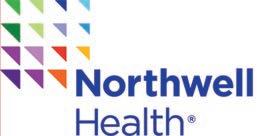
Will you discuss your views on effective leadership and the role that business leaders have in addressing societal issues?
Leaders, in my view, have a special responsibility and obligation. It’s not just a job and it is not about having a lofty title and a fancy office. You should never be defined by those things –you should be defined by what you do and by the positive difference you make.
There are two major roles, I believe – an internal one and an external one. The internal role is to manage and lead your organization –build an optimistic, team-oriented culture and attain the desired business results.
That role, of course, is primary, but I am a firm believer that leaders have an external obligation – to use their influence to improve circumstances in the community at large. This applies to all CEOs, but especially in healthcare. In most communities we are the largest employer. We have an obligation and mission to raise health, not just provide medical care.
I define health broadly. One’s health is impacted by a multiplicity of factors. We raise health by providing employment opportunities; we raise health by enhancing educational opportunities; we raise health by dealing with nutrition and food insecurity; and we raise health by responding to the growing issue of gun violence. Gun violence is a major public health issue – how many people realize that guns are the leading cause of death for children and adolescents.
Our responsibility as leaders is broad and community-wide. We must stand up and lead. It is good to see many doing so, but more is needed, especially in the uncertain times we live in. Optimism is key and a core ingredient in any definition of leadership. We have the ability to change lives for the better – to build a better future. It cannot just be left to our political leaders, especially now.
You mentioned that you define health broadly. How do you decide where to commit Northwell’s resources and what issues to address?
We obviously cannot do everything. We analyze what’s going on in the communities we serve and we get input from local leaders and influencers. We also target those issues that can have wide (even national) impact and where we can be a catalyst to get others involved. At the present time, we are targeting as priorities: gun violence, food insecurity, education (for children in poorer families), mental health, and immigration.
At Northwell, we have almost 85,000 employees. They are also community members, affected by so many of these issues. They are excited about our involvement and have expressed their happiness to work for and belong to an organization that cares about these issues.
How did Northwell’s focus on gun violence prevention develop and how have you approached this effort?
Each year, 40,000 die and more than 70,000 are injured by guns. That’s a distinction the U.S. should not be proud of. Of all the children 0-14 who die from gun injuries in the developed world, almost 90 percent occur in the U.S. Things must change.
Our active involvement began in earnest about five years ago. I took a full-page ad in The New York Times calling on all healthcare leaders to use their influence to treat gun violence as a public health issue and focus – not on the 2nd amendment, but on prevention and safety. The response was minimal at first, but that is now changing.
At Northwell, we established the Center for Gun Violence Prevention and Safety – we focus on education, on enhancing public awareness, and partnering with other local, regional

and national organizations who are likewise involved.
At the beginning, many healthcare leaders were hesitant, but fortunately, as mentioned, it has changed. We have created a national CEO Council which now has 55 CEOs of the largest health systems in the country involved. That is progress. We plan to launch a robust national awareness campaign on prevention and safety. It is also wonderful to see the leaders of other non-healthcare organizations getting involved.
This is a long-term effort and I am optimistic that over time we will bend the gun violence curve and bring some reasonableness and common sense to our deliberations on this issue.
There are many aspects to gun violence. What are the keys to driving change?
The keys to driving change are optimism, education, public awareness, and consistency of effort. I remember, years ago, the discussion on automobile safety. Cars were dangerous – high death rates and injuries. We did not ban cars, nor will we be able to ban guns. We took a “public health” approach. We installed air bags, seat belts, we “softened” the dashboard, we changed speed limits in certain locations. We strengthened the requirement to have a driver’s license. I recall how much Ralph Nader was criticized at the time – but he was right. We have to take a similar approach with guns –how do we lessen the impact, who should have access to them and who should not, how do we enhance their safety, etc. It’s important to remember that 80 percent of legitimate gun owners are strong supporters of gun safety and prevention.
In today’s culture and politics, there is no quick answer or solution, but that must not deter our commitment. It’s a long-term effort.
How important is it to address mental health as part of the gun violence discussion?
This is an area where we need to be very careful. We have a huge mental health problem, and it is growing, just like we have a huge gun violence problem, and it is growing. There is an overlap – there are issues with mental health and issues with guns – we have both. Not all gun violence is related to mental health, and not all mental health is related to gun violence, but there is a segment of it that is both. We must acknowledge the fact that, as healthcare leaders, we have a mental health problem and this impacts gun violence, while acknowledging that mental health is not the cause of all gun violence.
Another aspect that is really difficult, especially when it comes to kids, is social media and technology. They play these massively violent games where people die and then they come back to life. There is blood all over the place and then it disappears because it is fake. We need to address the impact that this is having on the mental health of kids.
Is it difficult to remain optimistic when you look at the increase in gun violence?
In the short run – yes, but one has to maintain an optimism about what’s possible in the long term. Success with anything takes time –and most progress is incremental, one step at a time. We have to give people the sense that there is always hope and to inspire them never to quit. In many ways, this is what leadership – good leadership – is all about. We have too many naysayers, too much negativity. We can look at the dark side or we can look at the bright side. We have to acknowledge the dark, but see the light.
How important has it been for you to never forget where you came from, even with all of your success?
Very important. We are all shaped by our past experiences and by the decisions we make along the way. Your past gives perspective. Growing up in the circumstance in which I lived taught me important lessons – the virtue of hard work, the importance of relationships, the importance of taking risk, of having integrity and decency. I learned that few people want to follow a pessimist – that optimism and a neverquit mentality is key to any degree of success. I learned that it’s essential to keep your feet on the ground, treat people with respect, not be enamored just with yourself. When you look in the mirror, observe the good and the blemishes – it keeps perspective. It keeps you humble.
What motivates you?
I am motivated by realizing that I have the opportunity to make a small difference. I like to be challenged and I like crises. Big problems inspire me. I enjoy taking risks. Good people are always a little bit dissatisfied, which motivates them to get better. Ralph Waldo Emerson said, “Do not follow where the path may lead, go instead where there is no path and make a trail.” I ask myself what kind of trail can I leave? What do I want my kids to say about me? I want them to say that their father made a difference, not just in my children’s lives, but in the lives of others as well.•

EDITORS’ NOTE Dr. Jose Prince is a practicing pediatric surgeon and focuses on translational research directed at understanding and regulating the injury response of children. A native of Queens, New York, Prince was recruited from the University of Pittsburgh Medical Center to join the founding faculty of the Zucker School of Medicine in 2010. He completed both his general surgery and pediatric surgery training in Pittsburgh. In addition, he completed a three-year postdoctoral research fellowship at the University of Pittsburgh studying the innate immune response to injury. Prince attended Yale University School of Medicine and was awarded a Howard Hughes Medical Institute Research Fellowship, which he completed at the National Institutes of Health under the guidance of Dr. John Hanover in the National Institute of Diabetes and Digestive and Kidney Diseases. Prince is a member of various international and national societies, including the American College of Surgeons, American Academy of Pediatrics, American Pediatric Surgical Association, Shock Society, Surgical Infection Society, Association for Academic Surgery, International Pediatric Endosurgery Group, Society of American Gastrointestinal and Endoscopic Surgeons, and the New York Surgical Society. He serves as a guest reviewer for a number of scientific publications. In addition, Prince is a mentor for postdoctoral fellows, graduate students and undergraduate students within his lab. He has authored more than 80 scientific reports, articles, and chapters.
Will you highlight your role and areas of focus at Northwell?

First, I am a physician who found purpose in helping children as a pediatric general and thoracic surgeon using minimally invasive advanced surgical techniques. As a surgeon-scientist, I have focused my basic science research on the injury response in collaboration with Dr. Ping Wang at Feinstein. This work led to my first program leadership role as the Trauma Medical Director at Cohen Children’s Medical Center (CCMC) and my efforts in pediatric trauma system development and injury prevention within Northwell, New York State, and globally. More recently, I have the privilege of leading the pediatric general and thoracic surgery division and serving as the Surgeon-in-Chief of CCMC.
Will you provide an overview of Northwell’s Center for Gun Violence Prevention and how you define its mission?
The Center for Gun Violence Prevention is charting a public health approach to end the epidemic of gun violence. Our mission is to eliminate gun violence as the leading cause of death in children and adolescents in the United States by developing and implementing firearm injury and mortality prevention strategies as part of routine healthcare. The Center was established in 2020 as a result of Michael Dowling’s call to action as a direct response to the litany of shooting deaths and injuries across our region and America. Our goal is to challenge healthcare leaders to see this as a public health issue which they have the power and responsibility to address.
collaborative led by our Center has brought the full breadth of over 600 stakeholders together to share best practices and to learn from each other. Dr. Chethan Sathya, the Director of the Center, is a tireless advocate for a public health approach to ending gun violence. His NIH-funded research studies universal firearm injury risk screening performed in the emergency departments of multiple Northwell emergency departments, including CCMC. As a result of his work, the center co-sponsored a National Academies of Sciences, Engineering & Medicine (NASEM) Workshop focused on integrating firearm injury prevention strategies in healthcare settings. Recently, Mr. Dowling has convened a CEO council of the major health systems of the U.S. to further build upon the momentum to unify healthcare’s response to this crisis.
Guns are now the leading cause of death among children and adolescents. What do you say to lawmakers and public officials about the need to address this issue as a public health crisis?
We have no time to waste. Lawmakers and public officials must rally together to fund research, support violence prevention programs, and organize government resources to prioritize this public health crisis. When the modern Eisenhower interstate highway system was built in the U.S., it led to motor vehicle collisions as a leading cause of death of Americans. Smoking was a major cause of suffering and death for Americans until public health advocates and litigation forced a public accounting. Polio, COVID, and influenza have ravaged our country over the last 100 years. By organizing our efforts, we have overcome all of these public health crises in the past. We must rise to the challenge that firearm injury and gun violence present to our children and the future we leave our grandchildren.
What do you feel are the keys to driving change in addressing gun violence prevention?
A key aspect in driving change is to reframe the discussion to move past the polarized and frozen status quo. This is not about the second amendment. This is about tackling a major health crisis in our country. To this end, Northwell has organized an annual forum with thought leaders, community leaders, healthcare and business leaders to work in partnership to advance a shared conversation. An international learning
Is it hard to be patient when you look at the slow progress being made in addressing gun violence prevention?
As a pediatric surgeon, my daily work draws me to look to the future. Each operation or procedure is performed in the hopes of a better tomorrow for that child. We have made some progress with our efforts. Ultimately, I know we will overcome this challenge. We can’t accept that guns will be the leading cause of death for our children – our children and youth don’t accept it now, and our grandchildren should see it as a problem of the past. Each of us has a responsibility to make that the future for them.•
“We must rise to the challenge that firearm injury and gun violence present to our children and the future we leave our grandchildren.”
EDITORS’ NOTE Dr. Chethan Sathya is a pediatric trauma surgeon and National Institutes of Health (NIH)funded firearm injury prevention researcher. He serves as director of Northwell Health’s Center for Gun Violence Prevention and oversees the health system’s expansive approach to firearm injury prevention. Under Sathya’s leadership, the center has leveraged the health system’s diverse patient population and wide reach to implement groundbreaking preventative strategies and perform highlevel research. Sathya was recently awarded $1.4 million from the NIH to study gun violence prevention and implement a first-of-its-kind protocol to universally screen among those at risk of firearm injury. The grant is part of the health system’s, “We Ask Everyone. Firearm Safety is a Health Issue” research study, which aims to shift the paradigm to view gun violence as a public health issue and approach firearm injury risk similarly to other health risk factors that are part of routine care, like smoking, substance use, and motor vehicle accidents. Furthermore, Sathya spearheaded the formation of the National Gun Violence Prevention Learning Collaborative for Hospitals and Health Systems, which is a multi-year, multi-phase platform in which hospitals and integrated health systems can learn about gun violence prevention from experts, engage in open dialogue, develop best practices through an iterative process, and implement and evaluate strategies for the prevention of firearm related injuries and deaths. Sathya has been an invited keynote speaker at a number of events, including the American Hospital Association Leadership Summit on Violence Prevention and the Healthcare Association of New York State symposium on best practices in gun violence prevention. In addition to being a surgeon, he is associate trauma director at Cohen Children’s Medical Center and assistant professor of surgery and pediatrics at the Donald and Barbara Zucker School of Medicine at Hofstra/Northwell. He completed medical school and general surgery training at the University of Toronto, followed by a Pediatric Surgery Fellowship at Northwestern Medicine in Chicago. He also holds a master’s in clinical epidemiology from the University of Toronto, in addition to completing a Fellowship in Global Journalism at the Munk School of Global Affairs and a Global Public Health program at the Dalla Lana School of Public Health.
Where did your interest and focus on gun violence prevention develop?
It started with my core job as a pediatric surgeon and a trauma director and, unfortunately, we are usually the ones who have to treat kids who come to the hospital with gun injuries. My journey started while working in Chicago when I had to treat a little infant during my first week on the job, a six-month old baby girl. That experience opened up my eyes to this epidemic, and that was not the last time I treated a young person for a gun injury – I had to do that over and over again in Chicago, and we are doing that here in New York too. We had a 350 percent increase in the number of kids that we treated with bullet wounds just last year at Cohen Children’s Hospital at Northwell Health. This is something where you can’t just sit on the sidelines when you are working on the front lines and dealing with this day in and day out.
When I came to Northwell in 2019, I was really inspired by the leadership of our CEO, Michael Dowling, who was one of the first health system CEOs to take a stance on gun violence prevention and to say that it was a public health issue. Michael put institutional commitment behind it and it galvanized many of our peers and, largely because of Michael and Northwell’s leadership, we have a new CEO Council comprised of health system CEOs and we have built a number of learning collaboratives around this topic that are helping to create programs all across the country.
While there has been momentum in addressing gun violence prevention, the numbers continue to increase. What is being learned from the research being conducted in this area?
I think it is important to break down the term “gun violence” when discussing the issue. We are talking about firearm injuries, and that could mean firearm suicide; it could mean accidental injuries; and it could mean homicides, the majority of which are assault or violence, with a small fraction being mass shootings. You really have to look at each of these pieces in order to have a productive conversation on this topic. If you look at the spike that we are seeing in injuries to kids, this is largely due to firearm violence and, if you look at the root causes of this, in many ways it is about more than just the gun. It is about structural inequity, structural racism, access to care –many of the same root causes that impact other social determinants of health.
It is clear that we have also seen an increase in school shootings and kids getting shot in driveways,
and this is an issue of too many guns in this country. What are strategies that could be employed in these cases as seen through a public health lens? This is very much focused on firearm safety which can really help prevent these type of instances.
Is the right conversation taking place to focus on the root causes that you mention?
We have a long way to go, but there is momentum in talking about this issue as a public health issue, and we have never had more research being done in this field. This means that we are getting a better understanding every year of the root causes of this epidemic and what types of things might work.
How has the Center for Gun Violence Prevention evolved?
The Center has grown rapidly and we have over one hundred initiatives taking place. We are working with the community, law enforcement, schools, and gun owners as we work to educate the community and prevent firearm injuries. We are funded by the NIH and have a screening program where we ask about gun safety which has expanded exponentially. We do work around research and advocacy, we develop common-sense policies, we develop educational curriculum for our providers and employees on how to counsel on gun safety. We know that there are policies that work, whether they be firearm safety or violence interaction and we are working to implement these policies.
How special is it for you to work for a health system like Northwell that takes a stand and leads in addressing public health issues?

I could not imagine being a part of an organization that does not have leadership such as Michael now that I have been here and experienced it. This type of leadership is not easy to find as I hear from many of my colleagues across the country. I knew that there was something special at Northwell when I chose to come here, and it has exceeded my expectations. When you look at a public health issue such as gun violence, it means a lot to know that you are part of an organization that is making a difference.

You mentioned that first week on the job in Chicago and treating the six-month old baby with a firearm injury, and that you continue to treat children with these injuries to this day. How hard is it to stay positive and be optimistic that real change will occur?
It is not easy. I focus on the work that we are doing on this issue to move in the right direction, and I also speak with families and survivors who reinforce that the work we are doing means a lot to them. We are there to support them, and it is inspiring to know that we are working to make a difference.•
EDITORS’ NOTE Ramon Soto is a skilled marketing executive with deep healthcare and financial services experience. He is responsible for the development and execution of Northwell’s brand strategy, as well as for all aspects of marketing and communications, including public relations, digital engagement, strategic marketing, clinical marketing, and customer acquisition. Soto is a member of Northwell Health’s executive leadership, responsible for shaping the growth strategy and execution for the enterprise. He was formerly the Chief Marketing Officer for Magellan Health. Prior to Magellan, Soto was a Senior Vice President with Aetna, managing the commercial marketing function for the Aetna enterprise. Before his nine years at Aetna, he spent seven years at GE Capital. In 2006, Soto was admitted into Yale School of Management’s MBA program for executives. He is also a graduate of GE Capital’s Leadership Interchange, a high potential manager training program. He is Six Sigma certified, was awarded a U.S. government patent for co-development of GE Capital’s product development process, and was an instructor at GE’s Small Business College. Soto received a BA degree from the State University of New York at Binghamton, an MBA from the Yale School of Management. He also received an Advance Management Degree from Harvard Business School.

Northwell Health has a history of leadership in addressing public health issues and taking on challenging topics. Will you discuss this focus and how you communicate these efforts?

This is an area we have debated heavily within the organization. Northwell Health serves the metro New York market where consumers have great choices for healthcare. I tip my hat to NewYorkPresbyterian which is a storied academic medical center that had their charter signed in the 1700s; NYU Langone that has been an innovator in clinical care; and Mount Sinai which is a storied health system –and here is Northwell Health, a 30-year-old challenger brand who truly sees healthcare differently.
We believe that the Northwell Health difference is that we engage and interact with consumers differently, and part of this is telling a broader story about health that is not just about the actual transaction or about being ranked in a specific specialty. Our value proposition is expressed through a very simple term: better health for all. COVID fortified
this purpose for us, and it is an absolute travesty that consumers experience care differently depending on who you are or where you live. It is a terrible notion that where you live can dictate how long you live. There are so many hidden injustices that sit right below the surface in healthcare that need an organization to focus on and address to bend the curve. An example is gun violence. Most consumers do not know that guns are now the leading cause of death for children in the United States. That is preposterous and as a society we need to do something about it.
How does Northwell Health approach its messaging around gun violence prevention and how important is it to address this issue as a public health crisis?
Before Northwell started tackling this issue, no other health system would talk about it, and it is because it is an incredibly slippery slope. It deals with a political issue that is at the heart of a tremendous amount of intolerance and camps at the extremes of the political spectrum. We leaned into the data and researched and experimented with a number of different ways to tell our message. You need to acknowledge that guns are not going anywhere, and to focus on how to make it a safer environment since even gun owners want to make it a safer environment.
The reality is that we have seen over a 400 percent increase in children presenting in our Cohen Children’s Hospital with gun wounds. The fact that we are in this crisis and in 2019 guns became the leading cause of death for children provides you with the opportunity to have a new and different conversation and fortifies the healthcare lane to be engaged and lead in this conversation. Our research has shown that we are making an impact with consumers.
Northwell’s campaign was targeted around parents and alerting them that there was this new threat that they need to protect their children from. Parents know that if their child has a food allergy, or if their child does not know how to swim, that when they drop them off at a friend’s house, they need to make this known. Now, they also need to ask if there is an unlocked gun in the house. Only 14 percent of consumers who were not familiar with our campaign knew to ask if there was an unlocked gun in the house, but 34 percent of consumers that were exposed to the campaign said that they would now ask if there was an unlocked gun in the house. When it came to parents, 70 percent of those that were aware of the campaign said that they would ask if there was an unlocked gun in the house, which shows that we are moving the needle, regardless of political affiliation. We tested it with gun violence survivors, we tested it with police, we tested it with those across the political spectrum, and across the board we saw really strong scores.
You use the word “consumers” in an industry where many use the word “patients.” Will you discuss this distinction?
This is a debate that goes on in the industry and with physicians, and neither reference is wrong. When an individual has a health event and they present themselves to our institution, they are a patient, but this is a moment in time. As a person takes his or her journey of life, they are taking their journey of health, and they are a consumer in its broadest sense. At Northwell, we are taking this journey with the individual. We are not just a place to treat the sick – we need to partner with the individual to optimize their state of health.
The industry uses language which refers to the transaction – it is called the episode of care. This makes it seem that it is an episode that happens once, but there is a lead up to it, there is the actual episode, and then there is the aftermath. At each phase, we have a role in that individual’s life. Northwell is leading in redefining how we can take the journey of health with the individual, and we are embracing the opportunity to deliver better health for all.•
“There are so many hidden injustices that sit right below the surface in healthcare that need an organization to focus on and address to bend the curve.”

Founded in 2005, China General Chamber of Commerce - USA (“CGCC”) has been recogni ed as the largest and most impactful non profit organi ation representing Chinese enterprises in the U.S. With a mission to create value, generate economic growth, and enhance cooperation between the U.S. and Chinese business communities, CGCC offers a broad range of programs, services and resources to over a thousand multinational members across the U.S.

CGCC is an independent, non-partisan, non-governmental chamber of commerce since its inception. As of March 2022, CGCC’s Chinese member companies have cumulatively invested over $135 billion, employ more than 220,000 people, and indirectly support over one million jobs throughout the United States.
Established in 2014, CGCC Foundation is a 501(c)(3) tax-exempt organization. The mission of CGCC Foundation is to deepen mutual understanding and cooperation between the United States and China through research, public charity and engagement in economic, cultural and social exchanges.

CGCC is committed to strengthening communication and cooperation between businesses in the United States and China to achieve economic growth and positive social impact, by integrating private sector resources, working with existing U.S. organizations and other chambers of commerce.
Uniting U.S.-China business communities and advancing opportunities for our members to achieve economic growth and prosperity, and positive social impact.
Our members’ interests lie at the core of what we do and drive every decision we make.
We embrace diversity and inclusion. We strongly believe in our duty to connect people from all walks of life and provide them with opportunities for open dialogue and cooperation.
We believe in fostering an evolving and forward-thinking culture that adapts to the needs of today’s modern world, providing industry best practices to meet complex daily challenges and create new opportunities for our members and local communities.

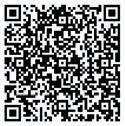

ince , the nnual usiness urvey on Chinese nterprises in the . . has been one of the flagship pro ects of CGCC and CGCC Foundation. The survey aims to identify key trends and overall business sentiment of Chinese enterprises in the . . and provide readers with the opportunity to gain deeper insights into the development of these industries.
ach year, CGCC sends out well designed questionnaires to hundreds of Chinese companies operating in the . . and receives valuable first hand information that reflects the current . . business environment. he writing and publication of the report shed further light on both the impacts and contributions of Chinese enterprises to the . . economy and local communities and the challenges these enterprises face while operating in the . .
Read the full report:
Compared to the 2022 survey results, only 42% of companies reported year-over-year revenue growth, and 13% experienced a revenue decline of more than 20% of those surveyed.

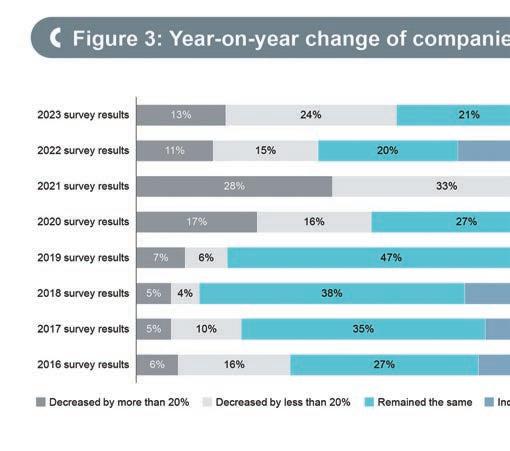


35% expect their U.S. revenues to remain flat over the next two years; expect revenue to decline over the next two years; and the overall percentage of companies expecting lower revenues was higher than last year’s survey.
Compared to the tough situation shown in the 2021 survey, the 2023 results shows improvement. However, it is still far from the high point five years ago when economic and diplomatic relations were more favorable.
This year of respondents are concerned with the bilateral tension between the U.S. and China; show concerns over the inflation in the . . and the im pact on the economic environment.

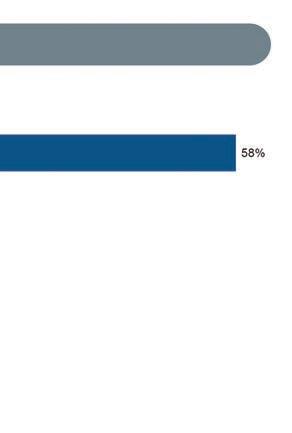
of companies predict further deterioration in U.S.- China relations while 83% report that inflation and economic uncertainty has already had a negative impact on their business.



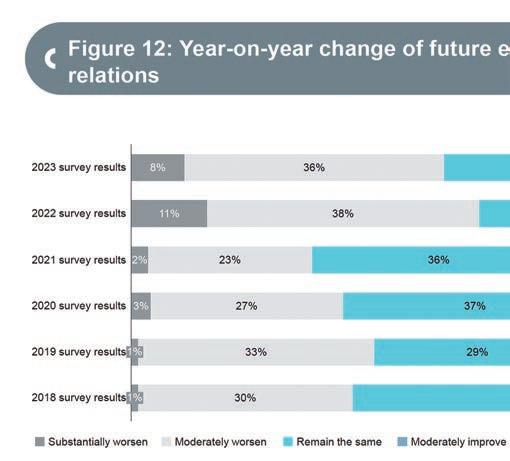
ensions in - hina re ations an ersistent inflation are to concerns or hinese com anies in the
Over 80% of Chinese companies are satisfied or neutral with all aspects of the . . busi ness environment. Of these, are very satisfied with the . . support for innovation, technol ogy, and nvironmental, ocial, and Governance G concerns.



While most companies report that they have largely or fully met their motivation for es tablishing a presence in the . ., appro imately of compa nies report that actual growth has been lower than e pected, while an additional report that . . profitability is lower than their Chinese parent companies.
“
e are le eraging downturns to recuperate, re amp our online and o ine s stems, and solidi connec tions with airline partners. n addition to our current capabilities and ongoing e orts, we ha e colleagues dedicated to go ernment a airs who communicate with the Chinese go ernment and ha e alread submit ted documents to increase ights. e are gathering strength until better times come.”
U.S. China business lead o a ma or U.S. airline

3hinese com anies are most satis e ith the mar et an ha e e e o e oca i ation strate ies to ma imi e usiness ro th
In the “up” market cycle, “new business areas and portfolio expansion” are the top strategic priorities adopted by Chinese companies.
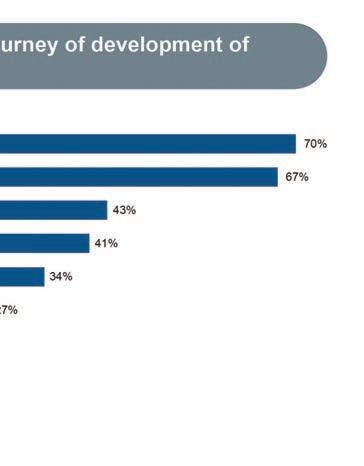

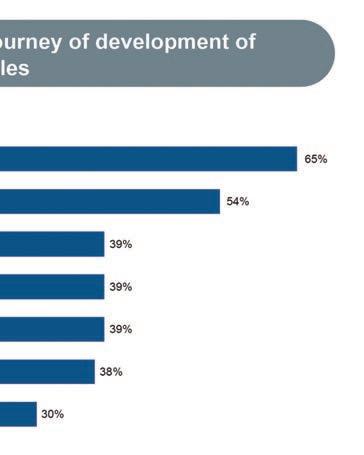

During the “down” cycle, 65% of respondents choose to “aggressively change their core business strategies”, while of respondents vote to “explore new business opportunities to offset the pressure.
Last year, our revenue experienced a slight decline during major holidays such as Chinese New Year and the middle of the year, which did not meet our expectations. However, we were able to boost our revenue towards the end o the ear during lac rida and Christmas. espite these uctuations, our o er all performance remained relatively good, and we met more than of our original expectations. This year, we have decided to not only expand our operations in U.S. but also establish a stronger presence in other parts of the world. Given the potential impact of U.S.-China policies, we aim to diversify our resources b establishing di erent routes.”
Leverage the current downturn to enhance and fortify your operations and capabilities. Chinese companies in the U.S. should take advantage of the slumping market and allocate greater attention and resources to improving their internal strengths, especially since the opportunity cost of doing so is currently lower than it would be in a bull market. This is especially true for Chinese companies operating in the U.S.
Doing so to make diversification a more effective way to offset pressure on main business. Given its priority for Chinese companies in the U.S., identifying new businesses with a rational and proven approach is an essential skill. Given the high failure rate and challenges of diversifying the main business, however, it is important to understand the risks and difficulties of entering a new line of business.
Not only will this strengthen local business in the U.S., but it can improve the overall performance of global operations.
As localization evolves, doing so will help to overcome inflation and ongoing staff shortages of qualified employees. We recommend Chinese companies in the U.S. wholly embrace digitalization, automation, and artificial intelligence technologies to overcome staffing shortages and increase efficiency.
Consider “regional expansion” into Mexico and Canada to further bolster U.S. operations.
China General Chamber of Commerce - USA and CGCC Foundation would like to thank all survey respondents for their continued support and participation in the 2023 annual survey.

Ying (Abby) Li Director of Corporate Communication and Research, CGCC
Jiangyue (Luna) Yu Research Coordinator, CGCC Yanting Wu CGCC Survey Intern
Corporate and individual customers in the U.S. market in general have shown considerable acceptance and support for innovation, and they have demonstrated a strong willingness and ability to pay a premium for technological and functional innovation. At the same time, with the support of the patent and other regulatory systems, unique innovations can be better protected, and relying on innovation to achieve revenue and profit growth abroad can be well guaranteed. Thus, Chinese companies in the U.S. should indeed be more liberal, especially in consumer industries.”
– A Chinese company manager in the U.S. information service industry
Richard A. Rosenbaum is the Executive Chairman of Greenberg Traurig, a unified international law firm of more than 2,650 attorneys spanning 45 offices around the globe. He has long been considered a thought and change leader in the broader legal profession. He joined the firm in 1985 as its 90th lawyer and has since been integrally involved in forming and successfully executing the strategies which have led to the firm’s growth and unique culture across locations in the United States, Europe and the Middle East, Latin America, and Asia. He closely guards the firm’s long-term core values while still aggressively navigating ever-changing times. Rosenbaum has always put the firm’s clients and people first, understanding that a law firm leader works for them, first and foremost. He is proud of his work founding the firm’s renowned and wide-ranging “Commitment to Excellence” program, which ensures that all these values remain core to the firm’s daily practice and global brand for many years to come.

Shari L. Heyen is Co-Chair of Greenberg Traurig’s Global Restructuring & Bankruptcy Practice and Managing Shareholder of the Houston office. Heyen has experience in complex restructuring, bankruptcy, insolvency, and complex commercial litigation matters. She has represented numerous creditors’ committees, debtors, bank groups, acquirers, and other significant constituencies in national Chapter 11 cases and workout proceedings, including complex oil, gas, and energy cases. Heyen has broad experience in the prosecution and defense of fiduciary litigation, real estate, oil and gas, healthcare, receiverships, and alternative energy matters.
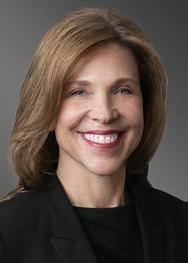
Chinh H. Pham is Co-Chair of Greenberg Traurig’s Venture Capital & Emerging Technology Group and is a registered patent attorney. He advises clients, ranging from startups to public companies, on the creation, development, and management of patent portfolios, the acquisition and exploitation of intellectual property rights, and identification of risks. Pham counsels clients on IP due diligence through the evaluation of client and competitor portfolios, assists startup clients with strategies for leveraging their IP portfolio, and serves as a mentor to entrepreneurs and early-stage ventures.
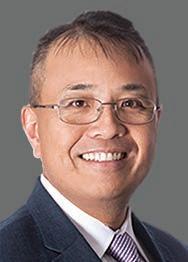
Diane N. Ibrahim is the Managing Shareholder of Greenberg Traurig’s Delaware office. Over the course of her career, she has handled virtually every type of corporate transactional matter involving Delaware corporations, limited liability companies, limited partnerships, and statutory trusts. Ibrahim’s intimate knowledge of the Delaware General Corporation Law, Delaware’s alternative entity statutes, and the intricacies of Delaware common law enable her to skillfully advise clients on various commercial transactions.

Mentioned: Nikki Lewis Simon , a commercial litigator with more than two decades of experience, primarily serves as the firm’s Chief Diversity, Equity & Inclusion Officer. In this capacity, Simon designs and guides strategic initiatives and programs to deepen firmwide diversity and inclusion efforts that further enrich client engagements and community investments. Simon is also an active member of the Greenberg Traurig Labor & Employment Practice team comprised of diverse lawyers who concentrate in strategic DEI and employment counseling.

FIRM BRIEF Greenberg Traurig, LLP (gtlaw. com) has more than 2,650 attorneys in 45 locations in the United States, Europe and the Middle East, Latin America, and Asia. The firm is a 2022 BTI “Highly Recommended Law Firm” for superior client service and is consistently among the top firms on the Am Law Global 100 and NLJ 250. Greenberg Traurig is Mansfield Rule
5.0 Certified Plus by The Diversity Lab and is recognized for powering its U.S. offices with 100 percent renewable energy as certified by the Center for Resource Solutions Green-e® Energy as a member of the U.S. EPA’s Green Partnership Program. The firm is known for its philanthropic giving, innovation, diversity, and pro bono.
Richard, will you discuss the importance of diversity as a core value at Greenberg Traurig?
Creating a workplace that is diverse and inclusive is the right thing to do for everyone at every level at every company and institution. At Greenberg Traurig, we have two key drivers that are specific to our law firm.
The first is that diversity is in our DNA. Our origin story is one of diversity out of necessity. In 1967, three attorneys in Miami faced religious discrimination. That did not stop them. They were determined to start their own firm, a new kind of firm that would rival “white shoe” New York firms, with one difference: here, everyone was welcomed – and Greenberg Traurig was born. This philosophy would go on to inform everything we have done in the 55-plus years since. At Greenberg Traurig we are proud of our long-standing, comprehensive, and awardwinning diversity, equity, and inclusion (DEI) initiative.
The second driver is one of Greenberg Traurig’s greatest differentiators: the way we operate. It can be summed up in two simple but powerful words: we act. We do so swiftly and decisively. While others may wait for corporate consensus, follow trends, or check boxes, we are already at work with a strategic plan. This formula of strategic, decisive action helped us grow into a global powerhouse with 2,650+ attorneys and 45 locations across the United States, Europe and the Middle East, Asia, and Latin America. Our strategic, decisive action goes beyond business and financial success. It drives the success of our DEI programs and our quest for a more just world.
Our origin of diversity, together with our ability to act quickly, is an unstoppable
combination and it is how we continue to break barriers and impact change in the legal profession and the communities around us.
Richard, what advice would you give about how to create an effective diversity initiative?
Writer Joel Barker said, “Vision without action is merely a dream. Action without vision just passes the time. Vision with action can change the world.” The sentiment in Barker’s quote is integral to how we approach our DEI initiative. Our vision is to work toward creating a more just and equitable workplace and community where every individual feels valued, has a sense of belonging, is comfortable as their true self, and is provided the opportunity, voice, mentorship, training, collaboration, substantive skill development, and connections to reach their greatest potential. To do this, we must act. If you change behaviors, you can change perceptions. That’s why at Greenberg Traurig we act by putting diverse people in leadership roles, recruiting from a diverse talent pipeline, and putting together diverse teams on client matters, to name a few.
It also holds true that if you change perceptions, you can change behaviors. That’s where our sensitivity training, transparency, open communications, affinity groups, and a core culture of respect from top down and bottom up change our behaviors, our firm, the legal profession, and our community for the better.
To help ensure that our commitment to excellence extends to our DEI initiative, we are fortunate to have an internationally recognized thought leader in the field, Shareholder Nikki Lewis Simon, as our Chief DEI Officer.
We set strategic and measurable goals that cover all aspects of inclusion and diversity.
As of December 31, 2022, almost half of our U.S.-based attorneys were diverse – women, ethnically diverse, and/or LGBTQ+. When it comes to attorneys who serve on the highest governance committees, lead offices and/ or firm-wide practice groups or departments, approximately half are diverse. In 2023, 46 percent of the attorneys elevated to shareholders and of counsel were diverse.
Following are snapshots into the thinking of three Greenberg Traurig attorney leaders who are each fully committed to the future of our culture of inclusion: Shari L. Heyen, Chinh H. Pham, and Diane N. Ibrahim.
Shari, how did you overcome preconceived stereotypes to emerge as one of the Co-Chairs of Greenberg Traurig’s Global Restructuring and Bankruptcy Practice and Managing Shareholder of the Houston office?
Greenberg Traurig values leaders from different backgrounds, with different experiences, and different voices. As a woman and supporter of the LGBTQ+ community, I am grateful to be at a firm that has allowed many diverse individuals, like myself, to be at the forefront of change in the legal profession. By being your authentic self, and not an externally generated version of who you are, you are able to foster genuine relationships. These relationships in the legal field can make all the difference in your career and on your potential positive impact on others.
At Greenberg Traurig, I get the opportunity to lead teams and collaborate with diverse attorneys across locations and practices to bring innovative advice to clients in complex restructuring, bankruptcy, insolvency, and high-level commercial litigation matters. I intentionally surround myself with a strong group of diverse
individuals. During these times of economic uncertainty and geopolitical unrest, it is especially critical to have diversity of experience, logic, and thought to allow for a broader range of ideas that work for our clients in real time in an increasingly complex world.
Being in a prominent leadership position, it is important for me to recognize my responsibility to serve as a role model. It is vital for me to make myself visible, accessible, and available to engage with others and work toward providing my team with means for success.
I encourage women who want to lead to be intentional with their actions. Leaders must make sure their voices are both used and heard; to lead by example to make a difference in their organization and community for the greater good.
Chinh, your escape from Saigon was a harrowing experience for a 10-year-old. How do you feel that informed your commitment to creating a more just world?
My family and I fled Vietnam in 1975 following the fall of Saigon. We left as refugees with dreams of finding a better life and opportunity and were fortunate to have made our way to the United States. In 2003, I joined Greenberg Traurig, truly a firm of opportunity where every individual is respected and provided the tools to succeed. Today, I am Co-Chair of the Venture Capital & Emerging Technology Group at this global, powerhouse law firm. Our business departments, firm and legal practice leadership, and our attorneys collaborate at a unique level. This has been key to our ability to meet and exceed the expectations of our clients, our colleagues, and our communities. With the full backing of the firm, I am proud to serve as the first Asian American president of the Boston Bar Association.
“Our origin of diversity, together with our ability to act quickly, is an unstoppable combination and it is how we continue to break barriers and impact change in the legal profession and the communities around us.”
Richard Rosenbaum
“I encourage women who want to lead to be intentional with their actions. Leaders must make sure their voices are both used and heard; to lead by example to make a difference in their organization and community for the greater good.”
Shari Heyen
The Affinity Group model is one of the tools Greenberg Traurig uses to foster our firm’s culture of belonging and opportunity for all. We currently have seven groups focusing on gender, gender identity, race, ethnicity, and veteran status. These groups create an engaging environment to promote success for its members through collaboration and professional and business development. An important element of these groups is the participation of allies, champions of diversity, equity, and inclusion irrespective of how they self-identify. Allies’ experiences provide an important dimension to the conversation which often results in a more robust outcome with regards to a group’s programming, recruitment, and business development. The groups also work with external professional and community organizations for greater impact. I am proud to have served for more than 10 years as a leader of the firm’s Asian Pacific American Affinity Group.
Diane, when you were named managing shareholder of Greenberg Traurig’s Delaware office, you were the first woman, and the youngest person, to do so. How does this reflect the firm’s commitment to DEI?
Affinity bias is a real challenge for many organizations. By naming me, a first-generation Egyptian American woman, as the managing shareholder of the Delaware office at a young age, Greenberg Traurig recognized the idea that the next leader of the office could be different than those who had come before. This reflects a genuine commitment to diversity and inclusion. I do a significant amount of recruiting in my role at the firm, and I always share with candidates that there is no obstacle to success here at Greenberg Traurig other than your own drive to succeed.
The firm’s platform allows me to have a visible role and mentor other women. As a mother of three young children, I understand the challenges many women attorneys face during child rearing years, and I work diligently to be an approachable resource for them. More formally, I also act as a mentor in the Good2Great (G2G) Executive Coaching Program, a diversity initiative developed by Greenberg Traurig that supports the firm’s highpotential women shareholders. In this capacity, I provide advice, introductions, and access to opportunities for growth and development to ensure that the next generation of women have the opportunity to reach their greatest potential.
Greenberg Traurig’s culture of collaboration and diversity directly benefits the firm’s clients. I work on complex cross-border matters on teams comprising talented and diverse attorneys across the United States and as far reaching as London, Milan, Berlin, Shanghai, Seoul, and Mexico City. This platform allows each of our attorneys to bring our unique experience and specific knowledge to provide broader, seamless service to our clients.
Richard, how does it enrich a law firm to have a diverse group of attorneys?
According to “Diversity Wins,” a McKinsey report, “The business case for inclusion and diversity is stronger than ever. For diverse companies, the likelihood of outperforming industry peers on profitability has increased over time…” Before DEI programs were “popular,” we knew that our culture of inclusion was one of the keys to our success. When you have teams where individuals have different backgrounds, experiences, world views, and approaches, you are
going to be able to offer more robust, creative solutions for clients and the communities they serve. Because of this, our top-tier attorneys, and teams, working collaboratively across industries, practices, and markets can provide even greater value and service to our clients.
What is the key to team success?
Team success, in work and in life, is about having character, an eye for excellence, the drive to ultimately succeed and a commitment to giving back. This is not just about the legal industry. In fact, I am reminded of these important values by my wife, Inga Rosenbaum, based in Warsaw, Poland. Inga was a fashion model when younger and prizes beauty, total commitment, and being the best. But in recent years, she found the courage to follow her true passion. She became immersed in the training, breeding, and competitive showing of our now-world class Samoyed and Cane Corso dogs. Inga aims for the best, brings passion to the dogs every day and refuses to let others tell her what she can or cannot do – now multiple international winners of best in show, best in breed, and other honors. And Inga has remembered to give back to the less fortunate, becoming heavily involved in Fundacja Cane Corso Rescue Poland (Cane Corso Rescue Poland Foundation), which helps care for and place abused or abandoned Cane Corsos, an urgent need.
Doesn’t even more need to be done?
At Greenberg Traurig, we are inspired by how our diversity story began and proud of how far we have come. We know more needs to be done. We are committed to continue making our firm, the legal profession, our communities, and the world a more just place for now and for future generations.•
“The Affinity Group model is one of the tools Greenberg Traurig uses to foster our firm’s culture of belonging and opportunity for all. We currently have seven groups focusing on gender, gender identity, race, ethnicity, and veteran status.”
Chinh Pham
“By naming me, a first-generation Egyptian American woman, as the managing shareholder of the Delaware office at a young age, Greenberg Traurig recognized the idea that the next leader of the office could be different than those who had come before. This reflects a genuine commitment to diversity and inclusion.”
Diane Ibrahim

EDITORS’ NOTE Cynthia Bowman serves as the chief strategist for diversity and inclusion and social responsibility globally, focused on leading programs, initiatives and policies that actively support Bank of America’s diverse and inclusive workplace and recruitment strategies. In this role, she helps steer the bank’s Global Diversity & Inclusion Council – which is chaired by Bank of America’s CEO – comprised of senior leaders from across the company, and leads the company’s Global Diversity and Inclusion Organization (GDIO), which supports enterprise-wide diversity initiatives, diversity conferences, strategic partner management and sponsorships, diversity awards and recognition, diversity metrics and data reporting, and oversight of the company’s 11 employee networks that have more than 180,000 memberships and allies across the globe. Bowman also leads a team of talent acquisition professionals responsible for filling tens of thousands of positions annually with the highest quality candidates to meet business needs. She joined Bank of America in 2007 and has served in various leadership roles throughout Global Human Resources. She has been recognized on the 2016 EBONY POWER 100 list, named one of Black Enterprise’s Top Executives in Corporate Diversity in 2017, 2018 and 2019, acknowledged as a Top 100 HR Influencers by Engagedly (2019), and this year, Bowman was recognized as one of North America’s Most Influential D&I Leaders by Hive Learning. She is a member of the Board of Trustees for the Boys & Girls Clubs of America (Midwestern Region) and sits on the Board of Directors for The Sphinx Organization. Bowman graduated from the J.L. Kellogg Graduate School of Management with an MBA in organization behavior and operations. She also has a bachelor of industrial engineering degree from Georgia Institute of Technology and a BS from Spelman College.
COMPANY BRIEF Bank of America (bankofamerica.com) is one of the world’s leading financial institutions, serving individual consumers, small and middle-market businesses, and large corporations with a full range of banking, investing, asset management and other financial and risk management products and services. The company provides unmatched
convenience in the U.S., serving approximately 66 million consumer and small business clients with approximately 4,300 retail financial centers, including roughly 2,900 lending centers, 2,500 financial centers with a Consumer Investment Financial Solutions Advisor, and around 2,300 business centers; more than 17,000 ATMs; and award-winning digital banking with approximately 39 million active users, including over 31 million mobile users. Bank of America is a global leader in wealth management, corporate and investment banking and trading across a broad range of asset classes, serving corporations, governments, institutions and individuals around the world. The company offers industry-leading support to roughly 3 million small business owners through a suite of innovative, easy-to-use online products and services. Bank of America serves clients through operations across the U.S., its territories and approximately 35 countries.
Will you highlight your role and areas of focus?
As Bank of America’s Chief Diversity, Inclusion and Corporate Social Responsibility Officer, I focus on programs, initiatives and policies that help drive Responsible Growth, which is our two-pronged approach of growing the economy while also creating tangible value for
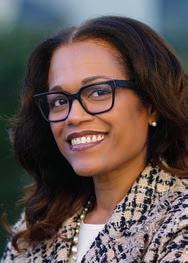
our business, our clients and the communities we serve. My D&I team supports enterprise-wide diversity initiatives including conferences, strategic partnerships with key organizations, and diversity metrics and data reporting. Our CSR team drives strategies and programs for equitable outcomes and social impact within our communities around the country, like supporting diverse entrepreneurs, providing access to capital for women and minorities, and providing jobs for people in low-to-moderate income areas.
How important is it for diversity and inclusion to be engaged in business strategy?
It’s so important for diversity and inclusion to be embedded in all aspects of a business –not only because it’s the right thing to do, but because it’s good for business. It’s necessary to have leaders at the top who not only talk the talk but walk the walk, and who show their commitment to these efforts. However, commitment to change can only go so far if it’s not paired with accountability. Accountability is critical to ensuring that diversity commitments are upheld and actually create meaningful change. Our management team sets the diversity and inclusion goals for the company. Each management team member has aspirational, actionoriented diversity goals subject to our quarterly business review process, used as part of talent planning and included in scorecards reviewed by the Board of Directors. The scorecards are even linked to compensation.
“At Bank of America, we know that our employees are our number one priority. That’s why we focus every day on being a great place to work, driving our efforts by being an inclusive workplace for all, and creating opportunities for our teammates to develop and grow.”
Will you discuss Bank of America’s commitment to build a diverse and inclusive workforce?
At Bank of America, we know that our employees are our number one priority. That’s why we focus every day on being a great place to work, driving our efforts by being an inclusive workplace for all, and creating opportunities for our teammates to develop and grow. Our commitment to diversity and inclusion starts with our efforts to develop and retain talent and help people of all backgrounds find meaningful employment. But it’s not enough to simply hire a diverse workforce – retention and the development of talent are equally as important so that employees feel supported and set up with a roadmap to full-time employment and long-term career success. We work with more than 200 external partners, including Year Up, UnidosUS, Disability:IN, and Paradigm for Parity – and more than 450 colleges, universities and community colleges, including 64 HBCUs, HSIs and tribal colleges – to identify diverse talent and expand our impact. Our progress speaks for itself with our U.S. workforce being made up of 50 percent women and people of color last year.
How engrained is diversity and inclusion in Bank of America’s culture and values?
I’ve worked at Bank of America for the last 16 years and it’s been incredible to witness the work and progress we’ve made to maintain a strong culture of diversity and inclusion over the years. However, this progress wasn’t accidental. Diversity and inclusion are at the center of everything we do. We’ve built a strong culture of inclusion by fostering an environment of trust and engagement, where all employees are empowered to bring their whole selves to work. We’ve been successful in this by making sure that employees have access to a range of resources focused on building understanding and driving progress in the workplace. Our 11 Employee Networks bring together employees who are facing similar life experiences to help them develop leadership skills, build ties
with local communities and advance diversity recruitment. We have over 355 chapters worldwide with over 230,000 members – servicing a variety of communities like the Military Support & Assistance Group and the Leadership, Education, Advocacy and Development (LEAD) for Women.
How critical are metrics to measure the impact of Bank of America’s DEI efforts?
I’m proud to say we’ve been a leader in transparency for human capital metrics. We measure diversity progress across all levels of our company, and leadership at every level is engaged in, and accountable for, driving diversity and inclusion. If we’re not measuring our impact, then how would we know we’re making progress and setting effective and achievable goals?
We keep close track of our hiring goals to make sure we’re making progress. For example, in 2022, we added 5,100 military veterans to our workforce – increasing the representation of veterans at the bank by 24 percent. In 2022, veterans represented 16 percent of all U.S. external hires – highlighting and measuring progress on our five-year goal to add 10,000 military veterans to our workforce.
Additionally, our Employee Engagement Index score reflects a strong trend over time –increasing 10 percentage points during the last decade. We also measure an internal Diversity & Inclusion Index that gives us feedback on how we measure inclusion at the company. It is up 8 percentage points during the same time, and index scores are strong relative to industry benchmarks over time.
What steps can be taken to grow the number of diverse candidates interested in pursuing a career in banking?
It’s important to make sure that we’re doing our part in removing barriers to entry for any individual interested in a career in banking or finance. Candidates should feel comfortable knowing that their employers will support their career growth and development, regardless of their past experiences. This means creating and fueling pipelines of
diverse talent that will increase the representation of women, people of color, veterans, LGBTQ+ talent, neurodiverse candidates, and more, in the industry.
At Bank of America, we take many different approaches to investing in our talent acquisition programs and community partnerships to ensure a career in banking is accessible to all. Our community hiring and development program, Pathways, provides entry-level jobs and career training for individuals from lowand moderate-income (LMI) neighborhoods. We’ve already surpassed our goal of hiring 10,000 teammates from LMI communities by 2025 through Pathways and are on track to hire another 10,000. We’ve also removed degree requirements from the majority of entry-level roles and use a skills-based approach to hiring, among other initiatives.
How important is it to have diverse perspectives and experiences at the table when making business decisions?
Diverse perspectives and sincere conversations allow us to challenge our brain’s traditional way of thinking and opens our minds to new perspectives that can help to improve decision-making. As employers, we have a responsibility to ensure that our employees feel comfortable speaking up and supported to know that they can bring their whole selves to work. Our diversity makes us stronger and is essential to fulfilling our purpose.
Do you feel that there are strong opportunities for women to grow and lead in the industry?
My own personal story and career journey are a testament to how women are making a real difference in the industry. I’m really proud of the progress we have made to have fair representation of women at BofA. We believe the diversity of our management team reflects the progress we’ve made, with 55 percent of our management team being diverse members, including seven women. We also maintain robust policies and practices that reinforce equal pay for equal work, with an internal review finding that compensation received by women was on average greater than 99 percent of that received by men. We’re also strengthening our progress at all levels of the company, with the 2022 fulltime campus hires from our internship program being made up of 44 percent women.
Although we have made incredible strides and investments in women at BofA, we know it’s our collective responsibility to continue to push for progress. At the beginning of 2021, research found that women in North America remained dramatically underrepresented in the financial-services workforce – particularly at the level of senior management and above (McKinsey, 2021). This is why it’s critical that women of all backgrounds feel supported, valued, and recognized for the full extent of their contributions.
You have spent over fifteen years with Bank of America. What has made the experience so special for you?
The impact that we make on driving an inclusive environment for all.•
“As employers, we have a responsibility to ensure that our employees feel comfortable speaking up and supported to know that they can bring their whole selves to work. Our diversity makes us stronger and is essential to fulfilling our purpose.”
EDITORS’ NOTE Tracy Brightman leads FedEx Corporation’s Human Resources function which includes talent development, succession planning, executive compensation, benefits, workforce strategy, and HR operations. Brightman is a member of the FedEx Strategic Management Committee which is responsible for developing and reviewing the corporation’s strategic business activities. Before transitioning to FedEx Corporation, Brightman’s 20-year tenure at FedEx Office included her serving in the Legal Department as General Counsel and Senior Vice President of Legal and Human Resources, Vice President, Assistant General Counsel and Managing Director of Litigation and Employment. Prior to joining the company, Brightman was Vice President and Assistant General Counsel for Associates First Capital Corporation/Citigroup and worked as an attorney for private law firms. She has also provided volunteer hours for North Texas Food Bank’s Love Packs program, as well as several other Dallas/Fort Worth-area family and children’s nonprofit organizations. She recently joined the Memphis Botanic Garden board of directors. Brightman received a BA degree in English from the University of North Carolina at Chapel Hill and earned her JD from the University of Virginia School of Law. She is admitted to the State Bar of Texas.
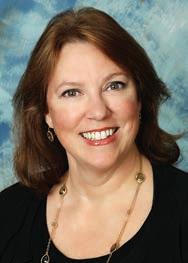
COMPANY BRIEF FedEx Corp. (fedex.com) provides customers and businesses worldwide with a broad portfolio of transportation, e-commerce and business services. With annual revenue of $93 billion, the company offers integrated business solutions through operating companies competing collectively, operating collaboratively and innovating digitally as one FedEx. Consistently ranked among the world’s most admired and trusted employers, FedEx inspires its more than 530,000 employees to remain focused on safety, the highest ethical and professional standards and the needs of their customers and communities. FedEx is committed to connecting people and possibilities around the world responsibly and resourcefully, with a goal to achieve carbon-neutral operations by 2040.

Will you highlight your role and areas of focus?
I’m a huge fan of Simon Sinek, and his concept of identifying your “what” and your
“why” has truly resonated with me. In fact, I’ve used this method to become very clear on my purpose within my work at FedEx throughout my career. My purpose is to enable others to find their paths and achieve their full potential in work that brings joy and meaning to them. I am a champion of our culture at FedEx, reinforcing our values through every initiative, every communication, and every interaction between me and my team and the team members that we support in the field. One element of being a culture and team member champion is having a focus on creating a team member experience that is just as engaging and intentional as the customer experience we want to have. We want to make sure we are looking at every stage in the development of a team member and giving it the time and attention needed to make a difference in that team member’s career journey.
Also, being very data driven is an important aspect of my role and my focus. How do we think, in a global world, about things
like data, demographics, labor availability, and market wage rates and how they drive what we do? All those things are critical in our decision-making. Another goal of mine is to be a leader across the organization. I want to be known as someone willing to be in the trenches collaborating with my team –I would never ask anyone to do something I wouldn’t and haven’t done myself. Bringing authenticity and transparency to the role is so important, especially during a business transformation.
How important is it for the Chief People Officer function to be engaged in business strategy?
It’s critical because the role of the CPO at its very core is to ensure that the talent strategy matches up to the business strategy. There are of course multiple facets to the job, but if you think about it – you manage the strategy and processes associated with building and retaining an exceptional team and there’s a lot that gets packed into that.
Not only do you need good business acumen, but you must also understand the business strategy – not just the current state,
but also how it will develop for the future –because the talent strategy must line up to all those things. In other words, you must be the talent architect for today and in the future to make sure we have the talent to meet our goals. Succession planning plays a huge part in that. How we identify, curate, nurture, and develop our diverse talent throughout their careers is vital so that our leadership at all levels represent our team members on the front lines, that in turn represent the communities where we live and work.
Will you discuss FedEx’s commitment to build a diverse and inclusive workforce?
Our greatest asset is our people. They are at the heart of our success and are the foundation of our strong reputation. Our company’s commitment to diversity began nearly 50 years ago, long before it was an expected part of corporate strategy. The cornerstone of our work is our commitment to fostering respectful, safe, and inclusive workplaces that celebrate the unique contributions of each individual.
We bring this commitment to life in part by integrating it into our global governance structure with DEI committees at FedEx Corporation and a DEI team at each operating company. Our DEI Corporate Council connects DEI representatives from across the HR, Sourcing, and Communications functions of our operating companies through bi-monthly meetings to foster collaboration, discuss best practices, and support programs in the communities we serve.
Additionally, we continue to provide opportunities for all team members to advance in their careers at FedEx. More than 33,000 frontline team members are learning new skills through our Purple Pathways program, which won the American Transportation Association DEI Change Leader Award this year. And thousands of team members are earning certificates and degrees through tuition assistance and access to free online courses. In the U.S., we also work closely with Historically Black Colleges and Universities (HBCUs) to help students gain leadership skills and access to work experience while they complete their education. FedEx Express Asia-Pacific, Middle East, and Africa (AMEA) is collaborating with specialized universities to develop a quality
talent pool with specific skills and knowledge in gateway operations and customer service. How engrained is diversity and inclusion in FedEx’s culture and values?
One of our biggest competitive advantages is our culture. Our team members around the world are committed to the Purple Promise: “I will make every FedEx experience outstanding.”
We are focused on making FedEx an outstanding place to work by fostering a diverse and inclusive team that reflects our operations globally. Our diversity, equity, and inclusion (DEI) commitments are aligned with our shared culture values and guided by the absolute belief that everyone deserves to be themselves and see themselves at FedEx. To highlight one example of this belief in action, FedEx team members who identify with a minority group held 36 percent of U.S. management roles in FY22.
Our efforts to provide fulfilling employment and advancement opportunities, to build community and allyship through affinity groups and resource teams, and our relentless focus on safety and well-being has consistently earned FedEx recognition as one of the world’s best places to work.
We believe a winning culture leads to winning strategies. It sparks the development of ideas, products, and services that help better serve our customers and drives our success.
How important is it to have diverse perspectives and experiences at the table when making business decisions?
We enhance our business performance by supporting a diverse and engaged workforce. This workforce, our supplier base, and supporting culture, all enable FedEx to better serve customers and compete in the global marketplace. We have a saying at FedEx, “we are as diverse as the world we serve.” We reach over 200 countries and employ over 500,000 individuals. Diverse perspectives and experiences allow us to tailor our services, approach, and relationships to customers around the world. Research links higher levels of diversity with increased innovation and economic performance. The world around us is changing quickly. Diversity is one of our most valuable tools as we continue to lead and innovate into the future.
Do you feel that there are strong opportunities for women to grow and lead in the industry?
We are intentionally supporting leadership, development, and advancement programs for women across levels within our business as well as in the communities we serve. While women have traditionally been underrepresented in the logistics industry, we are actively working to create more balance within both front line and corporate roles. Internally, we have created spaces for women to build community, learn, and grow together. Our Women in Leadership, Women Leading Change, and Women in Logistics business resource groups provide networking, professional development, and unique mentoring opportunities.
We recently celebrated a new milestone – our first all-female African American flight crew took to the skies in 2022. Less than 1 percent of the world’s pilots are Black women and we want to encourage others to join and fly for FedEx. On the roads, a female driver for FedEx Freight was named a 2022 Women in Trucking Driver of the Year finalist, and FedEx Freight was also named a top company to work for by the Women in Trucking Association.
In our communities around the world, FedEx Cares supports leadership, advancement, and economic opportunity programs for women to achieve economic mobility and small business success. We have special small business accelerator programs with Babson College, E-Commerce training with Accion Opportunity Fund, mentorship with the Asian University for Women, basic needs support with the Women’s Foundation of Greater Memphis, and leadership development with Dress for Success Worldwide, to name a few.
You have spent more than 20 years with FedEx. What has made the experience so special for you?
Every day brings new opportunities here at FedEx, and the experience has made this a place I’ve wanted to stay and grow in my career –especially as a female leader. Along the way, I’ve sought out different experiences – including lateral moves – and I’ve never ceased to be able to learn something new. I have a strong belief that careers are much more lattices than ladders, because it’s getting those experiences and exposure to the business that makes you a more well-rounded leader and team member. By continuing to learn and grow, I’ve been able to work alongside gifted and inspiring leaders and team members – especially our frontline team members whose stories and dedication are motivating beyond belief. Our organization is made up of over half a million of those individuals all with inspiring stories, and their unique contributions and commitment speak for themselves. It’s the everyday work – things like interacting with our customers, making sure packages and projects get where they need to go, and understanding that every single delivery has a story and a meaning to someone – that’s what inspires me every single day.•
“One of our biggest competitive advantages is our culture. Our team members around the world are committed to the Purple Promise: ‘I will make every FedEx experience outstanding.’”
EDITORS’ NOTE Lilian Vanvieldt is a 30-year insurance industry veteran who serves as Alliant’s Executive Vice President and Chief Diversity, Equity & Inclusion Officer. As the head of Alliant’s Diversity, Equity & Inclusion (DE&I) initiative, Vanvieldt leads a company-wide effort focused on promoting DE&I within Alliant and throughout the broader insurance industry through awareness, training, mentoring, and career development. In addition to her role, Vanvieldt is one of the nation’s leading brokers in the education space. She leads the Alliant Kindergarten to Community College (K-14) Public Entity program and plays an influential role in setting the program’s national business strategy. A proud survivor of stage III breast cancer, Vanvieldt currently serves as Director of the Susan G. Komen Leadership Foundation in San Diego and was the organization’s Honorary Breast Cancer Survivor of the Year in 2018. She holds a bachelor’s degree in economics and history from the University of California, Los Angeles.

COMPANY BRIEF Alliant Insurance Services (alliant.com) is one of the nation’s leading distributors of diversified insurance products and services. Operating through a national network of offices, Alliant offers a comprehensive portfolio of services to clients.
How do you define the role of a Chief Diversity, Equity, and Inclusion Officer and how critical is it for the role to be engaged in business strategy?
A Chief Diversity, Equity, and Inclusion (DE&I) Officer must be aligned with the company’s business strategy to ensure and instill meaningful DE&I change both internally and externally. The role of the lead DE&I professional is crucial in cultivating an engrained DE&I plan that aligns with the organization’s business priorities and objectives.
Despite the importance of fostering belonging and creating an equitable workplace for all, progress can be made exceptionally difficult without leadership buy-in. Building an infrastructure of top-down support establishes the overarching accountability vital to internally advancing DE&I within an organization and
paves the way for external change. Ultimately, we must collectively commit to accountability when building the kind of workplace where employees from all backgrounds can thrive. Will you provide an overview of Alliant’s diversity, equity, and inclusion mission?
Alliant’s Diversity, Equity, and Inclusion (DE&I) mission is to nurture and sustain an inclusive culture that boosts employee engagement, attracts a diverse talent pool, advances innovative problem-solving for our clients, and allows all our people to thrive. Above everything, we are focused on the retention and advancement of underrepresented professionals. Our six-pillar strategy, outlined below, takes a multi-faceted, metrics-driven approach to promoting DE&I at every level of our organization.
1. Accountability: We believe what gets measured, gets done. We hold ourselves responsible by setting realistic internal and external goals to advance our DE&I mission and establishing systems and processes to keep track of our progress.
2. Culture: By cultivating a human-centric culture, we direct our focus to individuals and transforming organizational behavior by promoting allyship, increasing retention, and advancement efforts through engagement in our mentorship and forthcoming sponsorship programs.
3. Representation: By partnering with colleges and universities with historically underrepresented student populations to establish risk management internship programs, we continue to nurture the talent pool and broaden student access to the insurance industry.
4. Clients: We take great pride in providing stellar client service that incorporates diversity of thought and representation.
5. Brand Development: As a nationally recognized top insurance brokerage firm, we are keen to leave our DE&I imprint in the wider insurance industry.
6. Community Investment: Both in business and in the world at large, Alliant holds fast to the belief that we can make a difference. It’s a commitment we are proud to live out each day in communities across the nation. Through the launch of our Alliant Insurance Foundation, we are striving to
make the insurance industry more accessible for underrepresented students.
How engrained is diversity, equity, and inclusion in Alliant’s culture and values?
Alliant believes that diversity, equity, and inclusion is not a byproduct of our success, but a catalyst for it. As an organization, we are wholly invested in furthering the DE&I needle. From establishing a department of six professionals focused on executing our data-driven DE&I strategy to developing programming that focuses on equitable representation, our culture prioritizes inclusion initiatives that promote belonging. Below is a list of key initiatives organized by our department that comprise our efforts and illustrate how engrained DE&I is in our culture and values:
1. Provide program coordination and general administrative support to our seven, formalized Employee Resource Groups (ERG) that represent our women, racial/ethnic minority, LGBTQ+, and veteran communities; we also have an ERG that provides support to our community of cancer survivors and caregivers,
2. Engage in Alliant Learning in the Workplace, a monthly curriculum-based programming that moves our workforce from passive to active allyship across our company,
3. Conduct DE&I fluency workshops with our different departments,
4. Launched and grow an Alliant DE&I LinkedIn page that helps us with culture building and elevating the profiles of underrepresented professionals,
5. Streamlined a process that endeavors to equitably provide sponsored development opportunities to our high-potential, underrepresented talent, and
6. Worked in conjunction with our Alliant Insurance Foundation to design, launch, and grow an Alliant Fellows program that creates access and opportunities for racial/ethnic minority students in the insurance industry.
How important is it to have diverse perspectives and experiences at the table when making business decisions?
Diverse perspectives are integral in making successful business decisions and establishing a welcoming and collaborative workplace. When done and communicated
effectively, equitably representative decisionmaking at the table signals that all are valued across the organization. From an internal perspective, informed decisions foster organizational innovation, increase problemsolving capabilities, and attract more talent and business opportunities. When assessing external value, research demonstrates that leadership and business development teams largely benefit from a more diverse and representative workforce, as they can expansively and genuinely connect with their clients to an exponential degree. In an industry like insurance, where the underrepresented populations being served continue to grow, it is vital to ensure that they are served by brokers as diverse as they are. We want Alliant to be an organization that consistently attracts and retains top talent by virtue of having leaders that are representative of our population.
Will you discuss Alliant’s commitment to expand opportunities for career growth and advancement for individuals with diverse backgrounds and life experiences?
In addition to investing and supporting our seven fully-fledged Employee Resource Groups (ERGs) across varying affinities, Alliant and our dedicated DE&I department are developing and maintaining relationships with underrepresented identity-specific insurance organizations, including Women in Insurance, Ellevate Network, Asian American Insurance Network, Hispanic Alliance for Career Enhancement, Rainbow Risk Alliance, and the National African American Insurance Association. We have also had past relationships with the Latin American Association of Insurance Agencies and the National LGBTQ+ Bar Association. In collaboration with these partnerships, the DE&I department is developing corresponding mentorship and sponsorship programs to further advance and develop our underrepresented high-potential leaders.
With a streamlined process established, we also continue to equitably allocate sponsored development opportunities and resources to our women, racial/ethnic minority, LGBTQ+, and veteran professionals. Additionally, our Alliant Fellows program and other collaborative academic partnerships with Historically Black Colleges and
Universities, including Howard University and Southern University A&M College, provides accessible career development resources to students interested in pursuing careers in insurance.
In your role, how valuable has it been to have the commitment of Alliant’s senior management in the company’s diversity, equity, and inclusion efforts?
The commitment from senior management is essential to the success of our diversity, equity, and inclusion (DE&I) efforts, and our executive team has taken an active stance in ensuring that DE&I is woven into every aspect of Alliant’s operations by supporting our DE&I department in developing and executing our six-pillar data-driven, peoplecentric strategy. Additionally, our Chairman and CEO, Tom Corbett, has pledged both his support and that of Alliant’s to CEO Action for Diversity & Inclusion (CEOAction. com). This pledge is the largest CEO-driven business commitment to advance diversity, equity, and inclusion within the workplace across industries and to commit to change and learning from each other. Our goal is to leverage our top-down leadership support to move the needle on DE&I in the insurance industry, foster belonging, and advocate for meaningful and impactful change that is sustainable.
You lead the Alliant Kindergarten to Community College (K-14) Public Entity program. What was the vision for creating this program and how has the program evolved?
As a public entity specialist and a nationwide industry leader in the education space, I am at the forefront of business strategies for the public entity sector alongside supporting the Alliant Kindergarten to Community College (K-14) Public Entity initiative. I am committed to protecting invaluable community assets, and this collaboration is the ideal partnership to advocate for schools and an honorable opportunity to give back. Just as Alliant is dedicated to investing in our employees and ensuring all feel welcome, our shared commitment to investing and strengthening our communities are equally prioritized through this program.
Do you feel that there are strong opportunities for women in leadership positions in the insurance industry?
It is no secret that historically, the insurance industry has predominantly been led by men. Over time, we have seen an increase in women insurance professionals in senior roles, and today, more than ever, our industry prioritizes women in leadership. However, while the opportunities for women in leadership positions have increased, there is still much work to be done. While insurance is largely comprised of women, they are primarily concentrated at the lower rungs of organizations and their upward mobility is largely influenced by their visibility to senior leadership. At Alliant, we’re mitigating unconscious gender bias and advocating for promotion through sponsorship and mentoring. We are focused on equitably allocating career advancement and development resources to our underrepresented professionals, women included, to ensure their talents and potential are recognized and celebrated. We, as women, must collectively support one another and establish a community of awareness, allyship, and advocacy to move the needle forward for women leaders in insurance.
You have spent more than 30 years of your career in the insurance industry. What has made the industry so special for you?
The insurance industry provides a multitude of avenues to pursue my mission of serving our communities for the greater good and advocating for their best interest. This vision stems from my unique perspective as a proud survivor of stage III breast cancer and as a woman of color from an immigrant family. My fortitude in the face of adversity is inherent, but largely bolstered by the sincere and exhaustive support I received from Susan G. Komen. I have always sought to use my work and influence to advocate for health equity and remain an active spokesperson for breast cancer education and prevention. I am forever indebted to my community and strive to utilize my specialization in risk management and public entity to provide the necessary and essential support system to fortify what they’ve built. I aspire to strengthen all my relationships within the public sector as my community has strengthened me. Unified, we can prepare for a successful and protected future. •
“We are focused on equitably allocating career advancement and development resources to our underrepresented professionals, women included, to ensure their talents and potential are recognized and celebrated.”
EDITORS’ NOTE Dr. Lynne Holden, who is professor of emergency medicine at Einstein and an attending physician at Montefiore Health System, has worked extensively with medical students, residents, and faculty at Albert Einstein College of Medicine. In recognition of her teaching excellence, she was elected to the Leo M. Davidoff Society, which honors teachers who have made significant contributions to the education of Einstein medical students. She has served as a co-chair of the admissions committee, taught the Introduction to Clinical Medicine course for first-year medical students, and held the position of associate residency director/site director at Montefiore. She continues to serve on the EM residency admissions committee. As vice-chair for diversity, equity, and inclusion for the department of emergency medicine, Holden spearheaded the development of the Social EM Program, which fosters activities that expose residents to the social determinants of health in the Bronx and empowers them to create empathetic solutions through research and community service. Since 2006, she has directed the Emergency Department Clinical Exposure and Mentoring Program, which has provided educational and experiential learning through volunteering and shadowing for 1,800 New York City undergraduate and post-baccalaureate students. Holden is co-founder and president of Mentoring in Medicine, Inc., (MIM), a national nonprofit organization dedicated to inspiring and preparing students to become healthcare and science professionals in order to help eliminate health disparities. Since its establishment, MIM has reached more than 58,000 students from elementary age through medical school, along with parents and educators. MIM alumni include 478 physicians from diverse backgrounds. The organization has also introduced 8,000 students, kindergarten through 12th grade, to biomedical and healthcare careers through class presentations, stage plays, and workshops. Holden’s numerous honors include a 2007 Maybelline NY-Essence Empowerment through Education Award, a 2009 Robert Wood Johnson Foundation Community Health Leader award, and the 2019 Distinguished Community Service Award from the United Hospital Fund. She has published the results of her work extensively and has appeared
widely in the media as an expert in mentoring and diversity in medicine. Also on the national level, Holden is active with the American Board of Emergency Medicine as a senior national oral board examiner and as the National Medical Association’s (NMA) immediate past section chair for EM. She serves on several national committees that address workforce diversity in medicine, including the American Association of Medical Colleges’ Action Collaborative for Black Men in Medicine (in partnership with the NMA) and the American Association of Medical Colleges Pathways Program Advisory Group. She is chair of the K-Grad Working Group within the Roundtable on Black Men and Women in Science, Engineering, and Medicine at the National Academies of Sciences, Engineering and Medicine. She is also a board member and on the education committee of the Friends of the National Library of Medicine. Holden is a graduate of Howard University and of Temple University School of Medicine. Following an internship at Albert Einstein Medical Center in Philadelphia, she began her residency in emergency medicine at Jacobi Medical Center, and later served as chief resident. After a brief stint as an attending physician at Kings County Hospital, and as assistant clinical professor at SUNY Downstate Health Sciences University, both located in Brooklyn, Holden returned to the Bronx to join Einstein and serve as an attending physician at Jacobi and Montefiore. She rose through the academic ranks at Einstein to become a full professor in EM, the fifth African American female in the United States to achieve this distinction at an academic medical center.

INSTITUTION BRIEF Albert Einstein College of Medicine (einsteinmed.edu) is a research-intensive medical school. For nearly 70 years, its diverse faculty and staff has set a standard of excellence in medical and graduate education and patient-centered clinical care, and has made major contributions to scientific research enhancing human health in its communities and beyond. The College of Medicine’s mission is to prepare a diverse body of students to become knowledgeable, compassionate physicians and innovative scientific investigators, and to create new knowledge. Einstein is affiliated with both Montefiore Health System and Yeshiva University.
Will you provide an overview of Albert Einstein’s College of Medicine’s diversity and inclusion strategy?
You can trace our diversity and inclusion strategy to the College of Medicine’s initial founding in the early 1950s, when women, people of color, and many other groups were largely excluded from careers in medicine and science. In this context, Einstein was established with the stated principle of accepting students of “all creeds and races.” The College of Medicine’s commitment to social justice was present at its founding and has continued ever since.
Our current, formal strategy traces back to 2017, when 60 members of the Einstein community – including faculty, students, and staff –formed the Diversity and Inclusion Council. The council created the Diversity and Inclusion Strategic Plan for Excellence, which guides the activities of the diversity office. The plan outlines our mission and goals but was designed to be fluid, so it continuously evolves. For example, we’ve made adjustments to reflect the changes in societal perspectives and expectations that took place during the COVID pandemic. Our overall strategy is to ensure that diversity, equity, and inclusion are interwoven through the fabric of Einstein, creating an environment where all faculty, students, and staff belong and understand that their contributions are valued.
How valuable has it been to have the commitment and engagement of Einstein’s leadership team in its diversity and inclusion efforts?
We are fortunate to have a leadership team whose words and actions reflect the quest for social justice in science and healthcare. There is a difference between discussing diversity, equity, and inclusion efforts and implementing and maintaining them. By prioritizing the recruitment, retention and development of diverse students, faculty and staff, Einstein leadership can learn from a variety of experiences and perspectives in order to foster creative solutions. Various mechanisms have been created to listen to the voices of the people we serve in order to enhance our decision-making and implement new ideas.
For example, the 2018 Einstein diversity and inclusion strategic plan provided guidelines for the creation of a Senior Associate Dean for Diversity and Inclusion. To fill this role is an honor and privilege. My job is to serve as the liaison between the leadership and our faculty,
Lynne Holdenstudents, and staff. There are opportunities for these constituents to interact directly with the leadership through regularly scheduled meetings.
There is also a vibrant effort to engage the Bronx community, which is 56 percent Hispanic, 35 percent Black, and is challenged economically. For example, we sponsor several pathway programs, some beginning as early as middle school, that are designed to cultivate the local health and science biomedical workforce. Also, our medical students must now complete required service-based coursework, often with local community organizations. We also have a number of community advisory boards and outreach programs that inform our scientific, medical, and outreach efforts.
How engrained is diversity and inclusion in Einstein’s culture and values?
As I mentioned earlier, Einstein’s commitment to diversity and inclusion has been present since its founding. Albert Einstein agreed to have his name attached to the proposed medical school on his 74th birthday, March 13, 1953, under the condition that students of “all creeds and races” were able to attend. Two years later, Albert Einstein College of Medicine opened its doors with the mission of social justice. While it wasn’t called that at the time, diversity and inclusion is a part of the College of Medicine’s DNA.
I was introduced to the Einstein community in 1990 while entering my fourth year of medical school at Temple University School of Medicine. I knew that I wanted to pursue emergency medicine. I heard about one of the top training programs in the country – the oldest on the Northeast coast – located in the Bronx. The U.S. was in the middle of the HIV/AIDS epidemic that was raging in New York City. I wanted to leave Philly to go to the Bronx to gain more experience. Then I discovered that a four-week Emergency Medicine rotation was being offered for diverse students at the Bronx Municipal Hospital Center, now Jacobi Medical Center, on the campus across the street from Einstein. I applied and, fortunately, was accepted.

During those four weeks, I was immersed in the Einstein culture and saw its values in action. I was embraced by colleagues and staff
at the hospital and medical school. I knew this was where I belonged. Thirty years later, I am still a member of the Einstein community, upholding these same values.
You were the fifth African American female to achieve the rank of full professor in Emergency Medicine at a U.S. academic medical center (Montefiore Einstein). Will you discuss this distinction and what you think can be done to make emergency medicine more diverse and inclusive?
Einstein, and its University Hospital and academic medical center, Montefiore Health System, have been at the forefront of grooming physician leaders in their respective fields with a world-class education and unmatched patient care experiences. I am fortunate to have been embraced in such a nurturing environment with core values such as social justice in healthcare. This experience has groomed me to become a national thought-leader in building workforce diversity, which became my path to professorship.
In general, African Americans make up 5 percent of the nearly 950,000 physician workforce with 2 percent being African American females, according to the American Medical Association. Furthermore, the number of African Americans in academic medicine reaching the rank of professor in any specialty is small. Of all U.S. medical school faculty in 2022, according to the AAMC, 2.2 percent were ranked as Professor and 4.6 percent were Assistant Professors.
Nationally, Montefiore Einstein has been foundational in the cultivation of emergency medicine leaders. The distinction of being the fifth African American full professor of Emergency Medicine is an honor that I could not have accomplished alone. I received immense support and resources provided by Montefiore Einstein. I was mentored and sponsored by three diverse, trailblazing physicians who are now EM full professors. Two were trained at Montefiore Einstein: the second African American professor, Dr. Lynne Richardson, and the first Latina professor, Dr. Yvette Calderon. The third African American female professor, Sheryl Heron, MD, MPH from Emory, was instrumental in providing national resources for improving diversity in medicine. Mentorship and providing opportunities for others to advance are critical in the development of a more diverse and inclusive specialty.
What can be done to attract more diverse candidates to pursue a career in medicine?
We must take a holistic approach to inspire more diverse candidates to pursue careers in medicine. We can accomplish this with early and continuous exposure to the field and providing intense encouragement and support along the career path. One of
Albert Einstein College of Medicine“Our overall strategy is to ensure that diversity, equity, and inclusion are interwoven through the fabric of Einstein, creating an environment where all faculty, students, and staff belong and understand that their contributions are valued.”
my mentors, Dr. Jo Ivey Boufford, stated that to have a successful pathway program, you must remember the mantra “not me, without me,” meaning programs need to be designed with the input of the people you’re serving.
When I wanted to hear from the population we were trying to engage, I was curious about the factors that hindered students from pursuing a health career, so I hosted focus groups with high school and college students, parents, and educators from Harlem. In 2013, I published a landmark paper outlining the perceived obstacles to pursuing a health career with opinions from students, parents, and educators, titled Promoting careers in healthcare for urban youth : What students, parents and educators can teach us (Holden, L., Rumala, B., Carson, P., & Siegel, E. (2014). I learned invaluable lessons and creative ways to reach out to our target population. Since then, every outreach program has input from the population being served, which gets incorporated into the curriculum. The program organizers encourage and guide the participants in an engaging manner, infusing their intended goals, but the constituents become active participants in their educational experience.
You are involved in curriculum development for the new Bard Bronx. Will you highlight Bard Bronx and what this new partnership between Bard and Montefiore Einstein means for students in New York?
It is too early to discuss details about the curriculum. What I can say is that the newly developed Montefiore Einstein partnership with Bard is an exciting step in which two major institutions are cultivating local talent to pursue research and medical careers. On the Einstein campus, there is a unique opportunity to pair leading researchers and physicians with motivated high school students from the community, allowing intellectual exchange that is built into the school day. This experiential learning model will accelerate the knowledge and creativity of the students and help the biomedical professionals gain insight into the community in which they work. We hope this opportunity accelerates learning and creates more roads to economic prosperity and better health.
You are also co-founder and president of Mentoring in Medicine, Inc. (MIM). What was your vision for creating MIM and how is it working to inspire and prepare students to become healthcare and science professionals to help eliminate health disparities?
Mentoring in Medicine, Inc. (MIM) is a nonprofit organization founded to inspire, equip and empower students who are underrepresented in medicine to pursue their dream. The vision for MIM is to broaden the field of competitive applicants to health professional schools. I was stunned by an article I read in 2008 by Paul Jolly, PhD that was published by the American Association of Medical Colleges. It noted that 75 percent of students who matriculated in United States medical schools came from households with family incomes in the top two quintiles. The study was replicated in 2017 with similar sobering results, with 73 percent-79 percent of medical school matriculants coming from household incomes greater than $121,019.
Mentoring in Medicine targets students from family households in the lowest quintiles –those with few resources but great potential. Our job is to cultivate these students by providing academic enrichment, leadership development, civic engagement, and mentoring. Foundational science and math topics are introduced, reinforced and then built upon. Key qualities necessary for success, such as intellectual curiosity, critical thinking skills and grit, are cultivated over time. Students must develop their professional identities and find mentors. Therefore, MIM engages students as early as elementary school and continues through the start of their professional careers. While students can enter at any point along their educational journey, the goal is to provide them with tools to achieve their dream of becoming a biomedical professional.
Since its establishment, MIM has reached more than 62,000 students from elementary school age through medical school, along with parents and educators. MIM alumni include 517 physicians – including residents and medical students –from diverse backgrounds. The organization has also introduced 8,000 students, kindergarten through 12th grade, to biomedical and healthcare careers year-round through school-based programs, summer camps, Saturday workshops, stage plays, and fairs. But it’s not just the numbers. The impact
of our work is also made clear to me when adults who attend our programs tell us, “I wish you were around when I was younger, my life may have been very different” and children say “we don’t get this in regular school.”
Do you feel that there are strong opportunities for women to grow and lead in the industry?
There are strong opportunities for women to advance in the biomedical industry. Emergency Medicine, for example, has not achieved gender parity – women represent 35.9 percent doctorsin-training, 28.3 percent faculty and 11 percent department chairs in 2019, according to the American Association of Medical Colleges. To advance gender parity, especially in leadership roles, we need mentorship and sponsorship.
My mentor, Dr. E. John Gallagher, was the founding Chair of the Department of Medicine at Einstein and a pioneer in the field. He embodied the Einstein values of social justice and provided opportunities for all. As the leader of the oldest Emergency Medicine residency program on the Northeast coast, he was an advocate for the promotion of a more diverse and inclusive workforce and used his influence to open doors for so many. It was his suggestion that I apply to become a national oral board examiner in 2003. At the time, out of a pool of approximately 200 examiners, there were very few women and an even smaller number of diverse examiners.
Fast forward to 2022, I am the first African American female in 43 years to sit on the Board of Directors of the American Board of Emergency Medicine. This would not have been possible if Dr. Gallagher and others after him did not advocate for me. We need more sponsors of all backgrounds who have a seat at the table to call for qualified women and diverse people to join them at the table, and to spend time grooming them for that opportunity.
What attracted you to pursue a career in medicine and what has made the work so special for you?
My desire to pursue a career as a physician began at the age of six after seeing my grandfather suffering with shingles. The strongest man I knew was reduced to tears and moaning from the intense pain. My role model at the time was Marcus Welby, MD. My favorite television shows were Marcus Welby, MD, Quincy, ME and Rescue 911. I grew up in a two-family household with resourceful and supportive parents. At a young age, it was my personal desire to help alleviate pain so I would not have to see another person suffer like my grandfather.
I met my “future professional self” in 6th grade during a spring break shadowing experience. The well-known and beloved Dr. Muriel Petioni, known as the Mother of Medicine in Harlem, became my role model, mentor and, eventually, sponsor. I was her companion at local school speeches and high-powered events with elite power brokers. For nearly 40 years, I was immersed in the world of being a physician advocate dedicated to building a healthier community. It naturally follows that I would also aim to cultivate future physicians who can also build healthier communities.•
“On the Einstein campus, there is a unique opportunity to pair leading researchers and physicians with motivated high school students from the community, allowing intellectual exchange.”
Our law firm has been committed to inclusion since its founding — a dedication that has shaped the intellectual and cultural character of Paul, Weiss over many decades.
Our Civil Rights and Racial Equity Audit Practice builds on this tradition by helping companies and boards deliver on their diversity, equity and inclusion commitments, while mitigating potential legal, reputational and business risk.
Paul, Weiss, Ri�ind, Wharton & Garrison LLPEDITORS’ NOTE Laura Vulaj oversees SL Green’s ESG program in addition to executing strategic company initiatives. She is also responsible for developing and managing SL Green’s hospitality program, a new concept focused on enhancing the workplace experience for tenants. Vulaj serves as a Board Member for Urban Green Council and previously served as a member of the Energy Efficiency & Housing Advisory Panel for the New York State Climate Action Council. She also assisted in developing the Food1st Foundation, a not-for-profit organization established by SL Green to alleviate food insecurity in New York City, provide meals to emergency service workers, and support the restaurant industry. In 2019, Vulaj was an honoree at NEW’s (Nontraditional Employment for Women) annual Equity Leadership Awards Luncheon. She earned her BS degree in economics from Northeastern University.
COMPANY BRIEF SL Green Realty Corp. (slgreen.com), Manhattan’s largest office landlord, is a fully integrated real estate investment trust, or REIT, that is focused primarily on acquiring, managing, and maximizing value of Manhattan commercial properties. As of March 31, 2023, SL Green held interests in 60 buildings totaling 33.1 million square feet. This included ownership interests in 28.8 million square feet of Manhattan buildings and 3.4 million square feet securing debt and preferred equity investments.
Will you highlight your role and areas of focus?
As Senior Vice President of Hospitality and Sustainability for SL Green, Manhattan’s largest office landlord, I am responsible for executing the firm’s strategic operational objectives, including overseeing our industry-leading ESG program and our innovative hospitality program aimed at transforming the traditional office experience into more people-centric workspaces.
Will you provide an overview of SL Green’s diversity and inclusion strategy?
While encouraging a supportive and entrepreneurial workplace culture, SL Green attracts the best and brightest within the industry largely due to our investment in the well-being of our employees and
commitment to fostering an inclusive environment. SL Green’s people-centric approach is integrated throughout our business as we prioritize creating equitable opportunities for success, growth, and development at the firm. How ingrained is diversity and inclusion in SL Green’s culture and values?
SL Green’s commitment to diversity and inclusion is reinforced by its employees, managers, and executives at every level. From recruitment and hiring to training, SL Green is committed to action when it comes to diversity and inclusion. This effort is evident in our recruitment strategy which continues to broaden our candidate outreach to further diversity within our workforce. I am proud to say that as a result, each year our employee diversity continues to grow. For example, across our entire employee base, 73 percent of our 2022 new hires identify as racial minorities. Our dedicated People Experience team has introduced specific employee programs focused on diversity, equity, and inclusion which help shape our company culture and directly contribute to our success within the industry. We are proud to be Great Place to Work® certified, signifying the strength of the SL Green workplace experience.
How important is it to have diverse perspectives and experiences at the table when addressing client needs?
Diverse perspectives and experiences are essential to the growth and success of any business, and SL Green understands this deeply by incorporating diversity as a key component within our business model. Our long-standing success as the premier office landlord in New York City is a testament to how a pluralistic workforce creates valuable contributions to strategic operations across the board. We couldn’t have had the success we’ve witnessed at One Vanderbilt Avenue, or our newest transformative development One Madison Avenue, without constant engagement with our partners and stakeholders, taking into account their diverse perspectives and experiences. A diverse team helps foster innovative thinking and ensures we approach issues from multiple angles, considering the economic, social, and environmental aspects of each decision and
allowing us to cater to the needs of our clients and key stakeholders.
Do you feel that there are strong opportunities for women in leadership positions in the industry?

It’s no secret that the commercial real estate industry has historically been male dominated. Over the years, however, we have started to see changes take shape, and at SL Green and throughout this industry more women hold leadership positions at leading firms. Though we are always striving towards higher representation of women in the industry, the game is changing. SL Green has been pushing for more female representation in its key decisionmaking and strategic operations, including at the board level. The representation of women in leadership positions is an important force that helps to motivate the next generation, and we are proud to be seeing more of that. As such, while there is much work left to do, talented women today have more opportunities for leadership and growth in the sector than ever before. To women who are looking to break into commercial real estate, I say this: there is no better time to make your mark than now.
SL Green has a long and deep commitment to sustainability. Will you discuss SL Green’s sustainability initiatives?
SL Green’s commitment to sustainability is a core value within our organization. This past year we released our 10th annual ESG report which outlines the expansiveness of our program and integration of ESG throughout our business. It’s important to recognize that “sustainability” isn’t limited to environmental initiatives – it encompasses social, cultural, financial, and environmental strategies that are focused on creating long-term value.
One Vanderbilt is a paragon of “sustainability” when you think of its broader definition. From a social perspective, we made a $220 million investment in public transit improvements that allow the MTA to move thousands more people each hour and we transformed Vanderbilt Avenue into a public plaza that improved both cleanliness and safety. The development has had a substantial economic benefit for New York City, bringing workers back into the office, stimulating local businesses, and making East Midtown a tourist destination. One Vanderbilt has also become a cultural epicenter with the opening of SUMMIT,
Le Pavillon, and Jōji. Environmentally, it’s the only building worldwide to achieve LEED v3 Platinum and v4 Gold simultaneously. The development revitalized East Midtown and our investment in public transit reduced urban sprawl which is similar to what we’re now doing at One Madison. One Vanderbilt is the perfect example of transit-oriented development that reduces the number of vehicular commuters by encouraging public transportation from the Metro North, Long Island Railroad, and New York City subways.

From an environmental lens, SL Green is continuing to implement portfolio-wide decarbonization strategies to reduce our carbon footprint and optimize our energy portfolio’s efficiency to continue to create safe, healthy, and sustainable spaces for our tenants and their employees.
What was the vision for developing SL Green’s hospitality program and how is the program enhancing the workplace experience for tenants?
SL Green has always valued, above all, a best-in-class, wellness-forward experience for our team and our tenants. This value system has been recognized as a key differentiator leading to our success as New York City’s largest office
landlord. Our hospitality program is centered around service to meet tenant demand for five key building amenities: food and beverage, meeting spaces, social spaces, commutability, and health and wellness. These are all vital areas of consideration when it comes to delivering high-quality spaces that encourage employees to thrive in the workplace.
As our hospitality program is based on the revitalization of these values, this has guided us in defining our commitment to hospitality and wellness. A great example is One Madison Avenue, our latest Class-A office building set to be completed later this year, in which our hospitality-driven program will be in full view. One Madison will offer tenants a rooftop terrace and garden, and a 7,000-square-foot tenant-only amenity space called “The Commons.” The Midtown South office tower will feature bestin-class amenities and wellness with the inclusion of a DOAS HVAC system and the building is expected to achieve LEED-Gold and WELL certifications.
Michelin-starred Chef Daniel Boulud will be opening two new French culinary destinations, bringing to life a European petit marché and an upscale French steakhouse, ensuring there is something for everyone at the building,
whether it’s fine dining or picking up fresh seasonal ingredients from local purveyors. We are proud to be creating the people-centric workplaces of the future through highlyamenitized office buildings and the delivery of concierge-level service to all our tenants and their guests.
You have spent over ten years of your career at SL Green. What has made the company so special for you?
When you find a good workplace that inspires you, it’s important to stick with it. For me, SL Green’s leadership and enterprising culture is unmatched. Though SL Green is a large organization, I see an incredible amount of cohesion among our staff and enjoy the constant collaboration. All of this comes together to illustrate how we’ve been able to attract the best and brightest in the business, and why I believe that regardless of fluctuations in the market, our team is always able to adapt and come out on top. As our company continues paving the way for the future, our commitment to cross-collaboration across different departments, teams, stakeholders, and partners will be invaluable to the ideageneration and problem-solving ability that sets us apart among our competitors.•
EDITORS’ NOTE Dr. Tamarah Duperval-Brownlee (“Dr. Tam”) is the inaugural Chief Health Officer of Accenture and is charged with creating and innovating strategies to enhance health, safety, and wellbeing of 700,000+ associates and their families across the globe. Her career spans more than two decades of senior leadership in healthcare, focused on improving health and advancing health equity. Previous roles included senior vice president and chief community impact officer at Ascension, a nonprofit Catholic health ministry in the U.S. Before that, she practiced clinical family medicine and served as a clinical and operational leader in Academic Health Centers and Federally Qualified Health Centers. She has a BS degree in chemical engineering, an MD degree, an MS degree in public health, and an Executive MBA. She was recognized in 2021 by Modern Healthcare as one of the Top 25 Women Leaders and by Fierce Healthcare as a Woman of Influence.

COMPANY BRIEF Accenture (accenture.com)
is a leading global professional services company that helps the world’s leading businesses, governments, and other organizations build their digital core, optimize their operations, accelerate revenue growth, and enhance citizen services – creating tangible value at speed and scale. Accenture is a talent and innovation led
company with 738,000 people serving clients in more than 120 countries. Technology is at the core of change today, and Accenture is one of the world’s leaders in helping drive that change.
Will you discuss your role as Chief Health Officer at Accenture and how you focus your efforts?
As Chief Health Officer, I embrace my personal purpose of enabling people to live healthy and well. We recognize that this can look very different for individuals, given our global diversity of people, and my team excels at being nimble and agile in terms of meeting those varied needs. We are delivering on a global strategy with approaches that are locally and culturally relevant to our people.
We’re committed to putting a scientific rigor behind what we do – making sure the tools, support, and efforts we provide are equitable, holistic, and delivering desired outcomes that align to our overall mission: helping people thrive personally and professionally. Part of how we determine impact is through measurement. Understanding (from anonymized data) trends around how utilization of health and wellness benefits influences metrics, like attrition and engagement, can help inform whether we’re moving in the right direction and the impact we’re delivering for our people.
How is Accenture working to create strategies to enhance the health, safety, and well-being of its associates across the globe?
At Accenture, our overall health and wellbeing strategy is focused on three main areas:
• We’re working on shifting mindsets and behaviors of our people, particularly leaders, to prioritize and integrate health and well-being into their daily operations and interactions. This includes bringing the “superpowers” of empathy, compassion, and kindness to the fore.
• We’re also adapting ways of working to be flexible for virtual or in-person arrangements, leveraging technology for efficiency while fostering a culture of compassion and well-being. This includes encouraging meaningful check-ins among team members where there’s an opportunity to pause, think, reflect, and reset.
• We have also optimized how we provide access to services and resources that address the genuine needs of our people. We’ve created a Mental Well-being Hub to ensure easy access to tools that can help with issues like parenting support, sleep and relaxation, and building resilience, and have expanded access so that immediate family members can tap into these benefits, too. We’re broadening our resources to include financial health support, as we recognize the stress and anxiety caused by the global economic landscape.
“We’re committed to putting a scientific rigor behind what we do – making sure the tools, support, and efforts we provide are equitable, holistic, and delivering desired outcomes that align to our overall mission: helping people thrive personally and professionally.”
In taking a holistic approach we also consider the broader support network around our people. We’re fortunate to have an active community of leaders working to set the tone from the top, and a strong network of Employee Resource Groups who help carry the message that it is critical to prioritize your health so you can thrive both personally and professionally.
Another unique enabler is our force of trained Mental Health Allies, in every country where we operate, who provide compassionate support and help guide our people to professional mental health resources. Allyship is so important when we think of leveraging the power of our people to help lead in this effort of well-being. To that end, we’ve recently established our Allies in Action program, which brings together all existing and new allies (including Mental Health and Pride Allies, Disability Inclusion and Cross-Cultural Champions) via learning, events, and community building, to learn what it means to be an ally, practice inclusive behaviors, and be role models for others.
Will you highlight Accenture’s efforts to develop solutions to impact the shifting COVID-19 landscape and support the behavioral and mental resilience for its more than 700,000 associates worldwide?
It’s important to recognize that even though we are out of the height of the pandemic, overall health and well-being, and especially mental health, may experience reverberations for 3-5 years to come. Because
of that, it is going to be very important for places of work to double-down on efforts to support their people’s health. Of all the dimensions of health, mental health tends to be the area that suffers the most, and it is a particular focus for us at Accenture. We understand how intricately it is linked to other dimensions of health, such as social connection and belonging, and our activations and efforts will be directed to supporting those pieces as well.
Accenture’s 2022 Future of Work research revealed that companies supporting and enabling workers in new ways can unlock their full human potential, regardless of their location. We know how critical it is for us to create a sense of community and ensure that our people feel supported and valued, even if they are not working in a traditional office setting on a regular basis.
What are your views on the need to address the issue of health equity in the workplace and how is Accenture addressing this issue?
As a global organization, the discussion about health equity is at the forefront. We recognize that perspectives on health, and how people view their path to being healthy, can vary greatly. Our approach is to respond to this diversity with cultural humility while striving to establish a common standard in our benefits and programs. Our goal is to ensure that everyone has the opportunity to live a healthy and well life in a way that is meaningful to them.
This topic is personally important to me as a physician who provided care to underresourced communities for many years. At Accenture, inclusion and diversity are ingrained in all aspects of what we do and help drive the success of our people and business outcomes. We care deeply about our people and are committed to fostering a culture of equality where everyone can achieve their personal and professional aspirations. Central to this is ensuring the health and well-being of all our people.
Our culture of equality acts as an accelerator for innovation, enabling us to deliver comprehensive value, devise better solutions for our clients, and inspire their own efforts toward inclusion and diversity. I strive to understand and act on the diverse needs of our people across different cultures, geographies, and demographics, and we are committed to ensuring access to care and support for all.
What advice do you offer young people beginning their careers?
Knowing your “why” is critical and getting clear on your purpose is so important. Purpose is where your skills meet needs, and there will be times when your skills and the needs you meet may differ. There is a lot of pressure on young people around this notion of a “dream job,” but maybe there isn’t one anymore. What people should aim to create is a career journey of continuous learning, with lots of stops along the way where they can express their purpose.•
“It’s important to recognize that even though we are out of the height of the pandemic, overall health and well-being, and especially mental health, may experience reverberations for 3-5 years to come.”
“As a global organization, the discussion about health equity is at the forefront. We recognize that perspectives on health, and how people view their path to being healthy, can vary greatly. Our approach is to respond to this diversity with cultural humility while striving to establish a common standard in our benefits and programs.”
EDITORS’ NOTE Loretta Lynch is a partner in Paul, Weiss’ Litigation Department and is chair of the firm’s Civil Rights and Racial Equity Audits Practice. She served as the U.S. Attorney General from 20152017, and twice as U.S. Attorney for the Eastern District of New York. Lynch handles complex government and internal investigations and high-stakes litigation matters, including those that implicate significant regulatory enforcement issues.

FIRM BRIEF Paul, Weiss, Rifkind, Wharton & Garrison LLP (paulweiss.com) is a firm of approximately 1,000 lawyers with diverse backgrounds, personalities, ideas, and interests who provide innovative and effective solutions to their clients’ most complex legal and business challenges. The firm represents many of the world’s largest and most important public and private corporations, asset managers and financial institutions, and clients in need of pro bono assistance.
What do you feel have been the keys to Paul, Weiss’ industry leadership and how do you describe the Paul, Weiss difference?
I was drawn to Paul, Weiss because of its distinctive culture. We thrive in high-stakes situations and handle our clients’ most complex problems, while also supporting each other’s successes. Our lawyers are collaborative and respectful, qualities that have been part of Paul, Weiss since its inception and continue to be important to the partnership. Diversity and
inclusion are central to our firm’s identity, and we recognize that the breadth of perspectives and skills across the firm makes our work stronger. It’s an incredibly dynamic, yet supportive, place to practice. Our cohesive culture enables us to provide the best client service. We go above and beyond to deliver exceptional results and build deep relationships with our clients; as a result, the world’s leading companies seek us out for their most sensitive and challenging matters.
You serve as chair of Paul, Weiss’ Civil Rights and Racial Equity Audits Practice. What was the vision for creating this practice?
In recent years, companies have faced increasing government and public scrutiny into their corporate DEI commitments. Our vision was to create an audit process that would help clients proactively identify and address gaps in these commitments and ensure that the experience of all their stakeholders, whether employees, customers or others, aligns with the values and goals the company has expressed. We wanted to provide our clients with an accountability tool focused on whether their DEI programs are achieving desired results.
In creating this practice, we are uniquely positioned to help clients. We bring to the table unparalleled experience in internal investigations and crisis management, as well as a dedicated, multidisciplinary Sustainability & ESG Practice, and a history of putting DEI goals into action within the firm. We have already been counseling clients on these issues for a long time.
Will you provide an overview of Paul, Weiss’ Civil Rights and Racial Equity Audits Practice and its areas of focus?
Our Civil Rights and Racial Equity Audit Practice helps ensure that companies and boards are delivering on their DEI commitments. We conduct racial equity and other civil rights audits, helping companies, boards, and investment firms proactively identify and mitigate potential legal, reputational, and business risk – and we were among the nation’s first dedicated legal teams to focus on this important work.
Leading up to the launch of our practice and since its launch in July 2022, we have led numerous sensitive audits helping boards and management be more informed, act effectively and respond appropriately to internal stakeholders and the public. Our audit representations have included an audit focused on race-related issues of a major technology conglomerate’s workforce; a global human rights due diligence assessment for a leading data and intelligence solutions provider; a comprehensive assessment of a multinational investment bank’s ESG programs, policies, committees and initiatives; and an assessment of equal justice in the state court system for the New York State Court System, among others.
How is Paul, Weiss’ Civil Rights and Racial Equity Audits Practice helping clients address potential gaps in their equity efforts and deliver on their DEI commitments?
We strategically tailor our approach to each client because each client’s business, needs, DEI practices and policies are different. So our first task is to determine the scope and parameters of the audit. Once this is determined – most
“In recent years, companies have faced increasing government and public scrutiny into their corporate DEI commitments. Our vision was to create an audit process that would help clients proactively identify and address gaps in these commitments and ensure that the experience of all their stakeholders, whether employees, customers or others, aligns with the values and goals the company has expressed.”
often in consultation with the board or management – we deploy an investigative team to analyze data, interview stakeholders, and basically take a deep dive into a company’s DEI programs and outcomes.
At the end of each audit, we prepare a comprehensive report, including an action plan with specific policy recommendations as well as guidance on how and what to track, measure and monitor. The action plan ensures that the client has the tools to foster racial equity on an ongoing basis and address issues before they become serious legal, reputational, and business risks.
These audits are especially important for understanding the impact of companies’ DEI programs and assessing whether the experiences of key stakeholders match the company’s stated policies and goals. They can also serve as a catalyst to launch deeper conversations about DEI commitments and what must be done to meet them – from allocation of resources to reaching the proper communities. Driving forward these discussions is critical and is an essential aspect to effective corporate governance.
What do you tell business leaders about the importance of building diverse and inclusive workforces in driving business growth?
There is a clear business case for diversity. Research has repeatedly shown that companies with more diverse workforces outperform their peers. Bringing together a diversity of perspectives has the potential to make your decision-making more nuanced and informed, opens the door to new and varied ideas, and allows for a wider variety of skills. And as companies struggle to attract and retain talent, prioritizing inclusivity and strong DEI commitments can be incredibly valuable.
To be successful, though, these efforts shouldn’t solely focus on your bottom line. Inclusion should be driven by established company values. Racial equity audits are useful tools in this regard because they can help companies pinpoint their values and assess whether their efforts are working.
Do you feel that there are strong opportunities for women and diverse professionals in leadership positions in corporate America?
There are an increasing number of opportunities for women and diverse professionals to lead in corporate America, and we have a responsibility as a profession to mentor and sponsor women and diverse professionals to help them connect with these opportunities and to advocate for them. It’s also absolutely critical that women and diverse candidates be their own champions. I like to remind more junior lawyers that their differences in perspective are assets, and they should leverage those assets, rather than trying to sand them down to blend in.
What interested you in serving in government and will you discuss this experience?
My father, a Baptist minister, taught me about the importance of standing up for others, even when doing so is difficult, and treating people equally. I saw this first-hand as a child when he helped student protesters during the Greensboro, North Carolina sit-ins and advocated for women to have leadership positions in our church. I saw it in how he lived his life. He also taught me to have faith in the law – something he impressed upon me when he would take me to the local courthouse to observe proceedings.
Early in my legal career in private practice, I worked myself to the point of exhaustion and realized I was pouring myself into my work but wasn’t fulfilled; it forced me to seriously reconsider my path. I began to search for more meaning in my work – and that is when I went into public service. Being an Assistant U.S. Attorney for the Eastern District of New York was incredibly fulfilling – in particular, helping victims and witnesses tell their stories. I continued to learn throughout my two stints as U.S. Attorney in the same district, as well as during my time as a pro bono legal advisor to the International Criminal Tribunal for Rwanda. Later, as U.S. Attorney General, I viewed my main responsibility as upholding the ideals of justice and equality under the law.
My experience serving in government continues to inspire me in my work in private practice. It is very rewarding to help companies and other entities navigate white collar issues in ways that allow them to reaffirm their commitment to being good corporate citizens. It was also important to me to find a firm that is dedicated to social justice, and Paul, Weiss has proven time and again that it is a leader in this space.
What advice do you offer to young people beginning their careers?
Take control of your career. Early in my professional life, I learned the importance of speaking up so that I was part of the discussion and seeking out opportunities to bring me closer to my goals. Whatever path you choose, work hard to develop your skills and raise your hand for challenging work. Investing in your own professional development is invaluable for your growth and the clients you serve. Finally, don’t be afraid to explore beyond the traditional path; find the opportunities that are most meaningful to you.•
“Diversity and inclusion are central to our firm’s identity, and we recognize that the breadth of perspectives and skills across the firm makes our work stronger. It’s an incredibly dynamic, yet supportive, place to practice.”
“Bringing together a diversity of perspectives has the potential to make your decision-making more nuanced and informed, opens the door to new and varied ideas, and allows for a wider variety of skills. And as companies struggle to attract and retain talent, prioritizing inclusivity and strong DEI commitments can be incredibly valuable.”
EDITORS’ NOTE Greg Francis is the manager of CNA’s Commercial Lines Underwriting Center, which he helped design and build. In this role, he is responsible for leading and growing the underwriting team that currently supports all of CNA’s U.S. branches with respect to the Middle Market, Construction, and Inland Marine Segments. Francis also serves on the company’s DEI Council and is the Executive Sponsor of the Empowering Black Professionals ERG. He also represents CNA on the IIABA’s Diversity Council. Prior to this role, Francis served in multiple commercial underwriting leadership roles dating back to 2012. He was a Commercial Underwriting Officer for the branches in Texas, Oklahoma and Arkansas; Zone CUO for the Central Zone; Zone CUO for the Southern Zone; and West Territory CUO. Francis started his insurance career as a Casualty Underwriter Trainee in CNA’s Syracuse Branch. He then spent more than 20 years between Chubb and The Hartford in various commercial underwriting and underwriting leadership roles. Francis holds a BA degree from Dartmouth College where he majored in English and was a member of the men’s tennis team.
COMPANY BRIEF CNA (cna.com) is one of the largest U.S. commercial property and casualty insurance companies. Backed by more than 120 years of experience, CNA provides a broad range of standard and specialized insurance products and services for businesses and professionals in the U.S., Canada and Europe.
Will you highlight your role and areas of focus?
I’ve spent more than 30 years in various commercial underwriting and underwriting leadership roles. I am currently a Vice President of Underwriting for CNA and help manage our Commercial Lines Underwriting Center, which I helped to design and build. In this role, I am responsible for leading and growing the underwriting team that currently supports all of our U.S. branches with respect to the Middle Market, Construction, and Inland Marine segments. I also proudly serve on CNA’s Diversity, Equity & Inclusion (DEI) Council, am the Executive Sponsor of our Empowering Black Professionals Employee Resource Group, and represent CNA on the IIABA’s Diversity Council. How do you describe CNA’s culture and values?
CNA has a welcoming culture of inclusion. As a company, we are striving for excellence across all aspects of the organization, continually evolving and improving, with a goal of consistently being a top quartile carrier. CNA puts people first – whether it’s the people and businesses we insure, the agencies and brokers with whom we work, or the employees who make us the great company we are. What creates an excellent environment and makes me so proud to work for CNA is our unwavering commitment to conducting the business ethically, with honesty, integrity, and fairness.
What have been the keys to CNA’s strength and leadership in the industry?
CNA has leaders and employees that care, respect, and value each other, work hard to grow and improve, and share the vision of making differences small and large each day to deliver innovative solutions and services that will merit being the carrier of choice. The leaders at CNA actively listen to the employees and to our agents and do their best to respond effectively to raised needs, concerns, requests, and suggestions. Whether it’s industry designations, pertinent higher education courses or degrees, continuing education, subject matter training or leadership training, CNA supports and invests in the training and education of our employees.

“CNA puts people first – whether it’s the people and businesses we insure, the agencies and brokers with whom we work, or the employees who make us the great company we are. What creates an excellent environment and makes me so proud to work for CNA is our unwavering commitment to conducting the business ethically, with honesty, integrity, and fairness.”
Will you discuss CNA’s commitment to build a diverse and inclusive workforce?
CNA has been committed to DEI for a long time. The company has been focused on DEI education, recruitment, talent development, partnerships, as well as a continued evolution of our policies and benefits with inclusion and equity in mind. All across CNA, we encourage deeper and more open conversations at work, which ultimately helps all employees bring their authentic selves to the workplace each and every day. Also, together as a global organization, we experienced a yearlong learning journey on allyship in which we learned about and practiced four specific allyship habits: Explore different perspectives; Diversify your network; Practice engaged listening; Speak up and stand up for others. Now we are institutionalizing allyship through an elevated focus on equity.
As the old adage goes, the proof is in the pudding. In our DEI employee survey, an overwhelming majority of our employees agree that CNA makes DEI a priority, feel they are treated with respect and dignity at work, and agree that the company is headed in the right direction on our DEI efforts.
How important is it to have diverse perspectives and experiences at the table when making business decisions?
It’s been proven time and time again that a team of people with diverse backgrounds,
experiences and perspectives nearly always outperforms a more homogenous team when it comes to problem-solving, creative thinking, idea generation and performance. As the world continues to evolve and business continues to be increasingly global, the importance of having teams of people with diverse perspectives and experiences becomes more and more critical. One example of this is our DEI Council, which is made up of leaders with diverse backgrounds, perspectives, and experiences from different business areas of the organization, such as Underwriting Shared Services, Claims, Risk Control, HR, Talent Management, Legal, and Analytics, to name a few.
How is CNA working to attract more diverse candidates to the industry?
CNA clearly understands the importance of attracting diverse candidates to the industry. There are so many career opportunities that need skills from all different backgrounds. We, as an industry, need to do a better job of communicating that to prospective candidates. At CNA, we take accountability, collaborating across the organization instead of making this solely an objective for Talent Acquisition, HR or the DEI Council. The programs we build and the initiatives that we execute are all in support of creating an environment where those with various skill sets, education and diverse
backgrounds can thrive. For example, we work with various nonprofits to educate and expose more people in the diverse communities they serve about the excellent career opportunities that exist in our industry, as well as provide internship and employment opportunities. CNA proudly sponsors and supports participation, including speaker roles, at major events like Out & Equal. And, in partnership with our Veterans Employee Resource Group, our Risk Control organization designed an all-new program to hire veterans into key positions within our Risk Control business, working with organizations like Hiring our Heroes, P3 and Recruit Military.
What do you tell young people about the type or career the insurance industry offers?
There are excellent careers, not just jobs, in the insurance industry – and they exist for people with diverse experiences, backgrounds, education levels, and interests. Roles are expansive from Claims, Operations, Legal, HR, and Accounting to Loss Prevention, and Sales. There are careers if you have a medical background, a law enforcement background, or an education background. There are roles for people with a high school education, Associates degree, Bachelor’s degree, Law degree, and a Master’s degree. It’s a noble and dynamic industry that is critical to business and society.•
“CNA has a welcoming culture of inclusion. As a company, we are striving for excellence across all aspects of the organization, continually evolving and improving, with a goal of consistently being a top quartile carrier.”
“Also, together as a global organization, we experienced a year-long learning journey on allyship in which we learned about and practiced four specific allyship habits: Explore different perspectives; Diversify your network; Practice engaged listening; Speak up and stand up for others. Now we are institutionalizing allyship through an elevated focus on equity.”
EDITORS’ NOTE Dr. Gary Butts is a visionary leader with decades of experience in designing, developing, and managing diversity, equity and inclusion programs and strategies. Butts is Executive Vice President for Diversity, Equity, and Inclusion, as well as Chief Diversity and Inclusion Officer, for Mount Sinai Health System. He also is the Dean for Diversity Programs, Policy and Community Affairs for the Icahn School of Medicine at Mount Sinai. Additionally, he holds joint appointments as tenured professor of Pediatrics, Medical Education, and Environmental Medicine and Public Health, and has been an integral member of the senior leadership team at the Icahn School of Medicine since 1998. Recently, Butts led the effort to launch the Diversity Innovation Hub, of which he is Director and a co-founder. Since 2004, he has directed the Center for Multicultural and Community Affairs (CMCA), which has been recognized as a Health Resources and Services Administration (HRSA) Center of Excellence for Minority Health. Butts has held regional and national leadership positions with the Association of American Medical Colleges and the Associated Medical Schools of New York, the National Medical Association, among other professional organizations. In 2020, Butts chaired the MSHS Task Force to Address Racism across the health system and is a key lead implementing its strategies.
Under his tenure, the medical school and health system have been recognized annually by Higher Education Excellence in Diversity (HEED), the Human Rights Campaign for LGBTQ inclusion and quality care and by DiversityInc for the Top 10 Hospitals and Health Systems for 4 consecutive years, achieving #1 ranking in 2017 and 2018. In addition, MSHS has achieved status as Forbes Top 20 employers for Diversity in the nation in 2018 and 2019 and the Diversity Innovation Hub was awarded the Rock Health Diversity Innovations award in 2020.
He has been recognized for his leadership and service by The Network Journal’s Top Black Doctors in New York Metro Area on several occasions; by the National Association of Minority Medical Educators with the Distinguished Service to Health Award; by the National Medical Association for Outstanding Leadership and Service; by the National Hispanic Health Foundation for
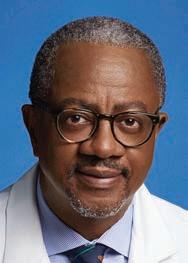
Leadership for Improving the Health of Hispanic Communities; and by Our Town Thanks You for his work locally in healthcare. In 2015, he was awarded the Jacobi Medallion, one of the highest honors that Mount Sinai bestows. As a Deputy Commissioner for the New York City Department of Health from 1993 to 1998, he directed city-wide maternal and child health services for planning, clinical services and program development, evaluation, health policy, and national public health research for the largest local health department in the United States. Butts completed his premedical studies at Columbia College before attending Cornell Medical College. He completed his clinical training in pediatrics at The Mount Sinai Hospital and has been part of Mount Sinai since 1980.
INSTITUTION BRIEF Mount Sinai Health System (mountsinai.org) encompasses the Icahn School of Medicine at Mount Sinai and eight hospitals, as well as a large and expanding ambulatory care network. The eight hospitals – Mount Sinai Beth Israel, Mount Sinai Brooklyn, The Mount Sinai Hospital, Mount Sinai Queens, Mount Sinai St. Luke’s, Mount Sinai South Nassau, Mount Sinai West, and New York Eye and Ear Infirmary
of Mount Sinai – have a vast geographic footprint throughout the New York metropolitan region. The Mount Sinai Hospital is ranked #14 in the nation by U.S. News & World Report and ranked in the top 20 nationally in eight medical specialties in the 2019-20 Best Hospitals guidebook. The New York Eye and Ear Infirmary of Mount Sinai is also ranked nationally in ophthalmology.
What have been the keys to Mount Sinai Health Systems’ industry leadership and how do you define the Mount Sinai difference?
Mount Sinai Health System (MSHS) is the largest academic healthcare system in NYC. In addition to our recognized leadership in clinical care, research, education, and innovation, we have been consistently acknowledged for our leadership in DEI. This is in large part due to several key and distinguishing features of our DEI organization and work:
• Our DEI structures are smartly organized and health system-wide with a single person as system Chief Diversity and Inclusion Officer and medical school Dean for DEI. This allows for a singular focus and uniform DEI strategy and plan for implementation.
• Our DEI work is full-thickness – including all important elements and areas of focus for a health system and medical school DEI.
“The primary driver for our current system-wide DEI strategy is our Mount Sinai Health System Roadmap for Action which includes 11 strategies, over 55 tactics, and a recommended process to advance the work. Most of our MSHS programs and initiatives can be linked to the Roadmap.”
Will you discuss CNA’s commitment to build a diverse and inclusive workforce?
CNA has been committed to DEI for a long time. The company has been focused on DEI education, recruitment, talent development, partnerships, as well as a continued evolution of our policies and benefits with inclusion and equity in mind. All across CNA, we encourage deeper and more open conversations at work, which ultimately helps all employees bring their authentic selves to the workplace each and every day. Also, together as a global organization, we experienced a yearlong learning journey on allyship in which we learned about and practiced four specific allyship habits: Explore different perspectives; Diversify your network; Practice engaged listening; Speak up and stand up for others. Now we are institutionalizing allyship through an elevated focus on equity.
As the old adage goes, the proof is in the pudding. In our DEI employee survey, an overwhelming majority of our employees agree that CNA makes DEI a priority, feel they are treated with respect and dignity at work, and agree that the company is headed in the right direction on our DEI efforts.
How important is it to have diverse perspectives and experiences at the table when making business decisions?
It’s been proven time and time again that a team of people with diverse backgrounds,
experiences and perspectives nearly always outperforms a more homogenous team when it comes to problem-solving, creative thinking, idea generation and performance. As the world continues to evolve and business continues to be increasingly global, the importance of having teams of people with diverse perspectives and experiences becomes more and more critical. One example of this is our DEI Council, which is made up of leaders with diverse backgrounds, perspectives, and experiences from different business areas of the organization, such as Underwriting Shared Services, Claims, Risk Control, HR, Talent Management, Legal, and Analytics, to name a few.
How is CNA working to attract more diverse candidates to the industry?
CNA clearly understands the importance of attracting diverse candidates to the industry. There are so many career opportunities that need skills from all different backgrounds. We, as an industry, need to do a better job of communicating that to prospective candidates. At CNA, we take accountability, collaborating across the organization instead of making this solely an objective for Talent Acquisition, HR or the DEI Council. The programs we build and the initiatives that we execute are all in support of creating an environment where those with various skill sets, education and diverse
backgrounds can thrive. For example, we work with various nonprofits to educate and expose more people in the diverse communities they serve about the excellent career opportunities that exist in our industry, as well as provide internship and employment opportunities. CNA proudly sponsors and supports participation, including speaker roles, at major events like Out & Equal. And, in partnership with our Veterans Employee Resource Group, our Risk Control organization designed an all-new program to hire veterans into key positions within our Risk Control business, working with organizations like Hiring our Heroes, P3 and Recruit Military.
What do you tell young people about the type or career the insurance industry offers?
There are excellent careers, not just jobs, in the insurance industry – and they exist for people with diverse experiences, backgrounds, education levels, and interests. Roles are expansive from Claims, Operations, Legal, HR, and Accounting to Loss Prevention, and Sales. There are careers if you have a medical background, a law enforcement background, or an education background. There are roles for people with a high school education, Associates degree, Bachelor’s degree, Law degree, and a Master’s degree. It’s a noble and dynamic industry that is critical to business and society.•
“CNA has a welcoming culture of inclusion. As a company, we are striving for excellence across all aspects of the organization, continually evolving and improving, with a goal of consistently being a top quartile carrier.”
“Also, together as a global organization, we experienced a year-long learning journey on allyship in which we learned about and practiced four specific allyship habits: Explore different perspectives; Diversify your network; Practice engaged listening; Speak up and stand up for others. Now we are institutionalizing allyship through an elevated focus on equity.”
EDITORS’ NOTE Crystal CastilleCromedy leads Hines’ talent and DEI strategy. Since first joining Hines in June 2020 as Vice President of Talent, Leadership and Diversity, Equity & Inclusion, Castille-Cromedy has demonstrated her leadership through the creation and evolution of numerous internal programs such as mentorship initiatives, employee resource groups, performance reviews and succession planning. Additionally, she plays a key role in Hines’ major new business pursuits, including the recently selected proposal to redevelop Tropicana Field for the Tampa Bay Rays. Since Castille-Cromedy joined Hines, she has managed a team of 25 people to lead the company’s efforts in translating Hines’ values and business goals into tangible HR actions. She previously served as the Vice President of HR and Head of the HR Executive Office at BP. Castille-Cromedy received an undergraduate degree from the University of California, Davis and earned an MBA with an emphasis in human resource management from the University of Phoenix.
FIRM BRIEF Hines (hines.com) is a global real estate investment, development and property manager that was founded by Gerald D. Hines in 1957 and now operates in 30 countries. The firm manages nearly $96 billion in highperforming assets across residential, logistics, retail, office, and mixed-use strategies. Its local teams serve 480 properties totaling nearly 241 million square feet globally. Hines is committed to a net zero carbon target by 2040 without buying offsets.
Will you highlight your role and areas of focus?
As the senior vice president of talent and chief diversity officer at Hines, I am responsible for leading the company’s talent and DEI strategy. My goal is to ensure that Hines attracts, develops, and retains the best and most diverse talent the globe has to offer, creates high-quality talent outcomes, and achieves equitable diversity representation across the company’s employee base. As a strategic business partner, I also work closely with HR to oversee the company’s integrated vision for talent acquisition, talent management, talent development, and diversity, equity, and inclusion.
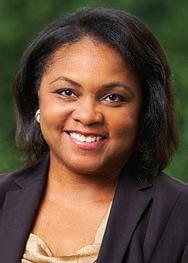
My role includes building upon the creation and evolution of numerous internal programs such as mentorship initiatives, employee resource groups, talent development, performance management, career progression, and succession planning that I have implemented since joining Hines in 2020. I’m also collaborating with HR to create fair and transparent talent practices that can be consistently implemented across the company, regardless of location. This is a critical part of my platform to elevate employees and increase their sense of belonging at Hines.
How important is it for the HR/Talent function to be engaged in business strategy?
It is imperative for the HR/talent function to be fully engaged in business strategy. At Hines, I work closely with our Chief People Officer and her team on multiple initiatives. The HR/ talent functions are responsible for managing the organization’s talent – ensuring we have the right people, in the right jobs, at the right time. Therefore, these teams should be involved in strategic decision-making to ensure that the organization’s people strategy is aligned with its business priorities.
Business strategy and people strategy are interdependent, and organizations cannot achieve their goals without cohesive alignment between the two. HR/Talent should work closely with business leaders to understand the organization’s objectives, identify talent gaps, and develop strategies to attract, retain, and develop a diverse and inclusive workforce that supports the organization’s goals.
By collaborating with Hines’ HR/talent teams, we can identify potential barriers to diversity, equity, and inclusion in the organization’s business strategy and develop plans to mitigate them. For example, if the organization is expanding into a new market, HR/Talent can work with business leaders to ensure that the recruitment process is inclusive, and attracts diverse talent reflective of the new market.
How engrained is diversity, equity, and inclusion in Hines’ culture and values?
At Hines, we prioritize the employee experience because our business is about more than constructing and investing in great buildings and projects. Our commitment is
to create environments where people can thrive, whether it’s within our workplace, in the spaces we manage, or across the communities we are involved with. We prioritize making a positive social impact in every Hines project.
Will you provide an overview of Hines’ diversity, equity, and inclusion initiatives?
Our approach to diversity, equity, and inclusion at Hines is designed to apply a DEI lens to the entire talent ecosystem, including access, hiring, belonging, and elevation. Our goal is to create an inclusive environment that values differences, embraces diversity, and celebrates unique perspectives while supporting everyone’s growth and development.
In terms of access, we prioritize expanding awareness and access to commercial real estate careers for underrepresented groups. To achieve this, we offer opportunities through campus recruiting initiatives and internship programs like Skyline Scholars, which gives college freshmen and sophomores from underrepresented groups access to the commercial real estate industry.
When it comes to hiring, we believe that a diverse workforce is a stronger and more resilient workforce. As such, we are committed to improving gender and ethnic representation in all job families, especially at the senior leadership level, and building teams that reflect the diversity of the communities in which we operate. Our efforts have already yielded promising results: 15 percent of Skyline Scholars participants have converted to the Hines internship program, 68 percent of our interns are from underrepresented groups, and 64 percent of our full-time graduate hires are from underrepresented groups.
After hiring, our next priority is to ensure that all employees feel a sense of belonging. Our belief is that employees’ unique backgrounds and perspectives are essential to driving innovation and advancing ideas that benefit Hines, our stakeholders, and partners. To support this belief, we have created employee resource groups that advance our DEI strategy and promote a firmwide platform to connect employees and celebrate diversity. Hines launched five new ERGs in 2022 for a total of seven with a 45 percent increase in participation from the firm since the launch of these additional ERGs.
Finally, our focus is on elevating our employees. We recognize that hiring, retaining, and promoting diverse talent are critical to the future of our firm. Our aim is to reflect society and to have the right talent in place to meet the needs of Hines, our stakeholders, employees, and the people globally where we operate. We are taking steps towards solutions, such as updating our officer promotion criteria for greater transparency and launching a new mentoring program to drive progression opportunities for all employees. Currently, 41 percent of our workforce is female, 36 percent represent a U.S. racial/ ethnic minority group of which 10 percent are officers, and 21 percent of our officers are female, including our C0-CEO, Laura HinesPierce. While we are proud of our progress, we recognize the journey ahead and are determined to continue creating opportunities for a more diverse future.
Will you elaborate on the importance of developing employee resource groups as part of Hines’ DEI work?
Hines’ employee resource groups are designed to advance our DEI strategy and create a firmwide platform to connect employees and celebrate diversity. These groups serve as a commitment to provide a space for employee awareness, engagement, connection, and learning. The goal is to provide equity through increased empathy, education, and action that drives employee engagement, increases employee understanding, and ultimately creates a greater sense of belonging for all employees.
The seven employee resource groups at Hines are the OneHines Women’s Network (OHWN); PRIDE; Black Employees Advocacy Network (BEAN); Latino & Hispanic Employee Resource Network (LHERN); CARE (Working Caregivers); OneHines Asian Network & Alliance (OHANA); and Alliance for Veterans Engagement (AVE).
How critical are metrics to measure the impact of Hines’ DEI efforts?
Metrics are essential to measure the impact of DEI efforts, but they only tell half the story. Metrics help organizations to track progress, identify gaps, and hold themselves accountable for creating a more diverse and inclusive workplace, but having good, clean data is one of the largest hurdles industries face when enacting DEI plans. It’s not only
about increases in percentages, but how employees feel in the workplace and have confidence in their ability to successfully grow their careers.
Even with the most reliable and consistent data, it is important to note that metrics should not be the only tool used to measure the success of DEI efforts. Qualitative data such as feedback from employees and other stakeholders, anecdotes, and stories can provide additional proof points and insight into the impact of DEI initiatives. Ultimately, a combination of both quantitative and qualitative data provides a more comprehensive understanding of the effectiveness of DEI efforts.
How does having diverse perspectives and experiences at the table drive better business outcomes?
Having diverse perspectives and experiences at the table is critical to driving better business outcomes. This diversity of thought and experience can also help a company identify new opportunities and markets that they may have otherwise overlooked. In addition, diverse teams are more likely to reflect the needs and wants of a diverse clientele base. This can lead to better service and a better understanding of clients’ needs, which can help drive business growth. Furthermore, research has shown that diverse teams are more productive and creative. When individuals feel valued and included, they are more likely to contribute their best ideas and work collaboratively with others.
• A report by McKinsey & Company (2020) found that companies with higher gender diversity on executive teams were more likely to outperform on profitability and value creation.
• A study by Boston Consulting Group (2018) found that companies with more diverse management teams have 19 percent higher innovation revenue than companies with less diverse teams.
By embracing diversity, equity, and inclusion, companies can create a culture that values and leverages the unique perspectives and strengths of all employees, leading to a more successful and sustainable business.
Do you feel that there are strong opportunities for women to grow and lead in the industry?
We are seeing opportunities for women increase within the commercial real estate industry, although we still have a ways to go to create meaningful change. I often say, “Change doesn’t happen overnight, but progress happens daily.” Hines is an organization that is dedicated to creating opportunities for women, and it starts from our executive office. Last year, Laura Hines-Pierce was promoted to Co-CEO of the firm and sits next to her father, Jeff Hines, overseeing the firm’s strategy and management. Shortly after increasing Hines’ U.S. Paid Family Leave Policy from 8 weeks to up to 16 weeks, Laura understood first-hand the importance of work-life balance for caregivers as she began her own family. She worked hard to set the example that women are supported and can achieve their career aspirations while still prioritizing family. Laura also serves as co-executive sponsor to Hines’ Working Caregiver ERG (Care), reinforcing her personal commitment to this cause.
You joined Hines in 2020. What excited you about the opportunity and has it been what you expected?
I was initially attracted to Hines because it presented an opportunity to join a company that valued diversity, equity, and inclusion, and had a strong commitment to driving change in this area. This created a great space for me to work with a group of talented people while taking the lead in making meaningful strides of improvement. Working for a company whose leadership recognizes that a diverse workforce and inclusive culture is not only the right thing to do, but also critical for achieving business success, was important to me, and I knew it would be critical to my success at the organization.
Three years later, I am grateful to work with a team of passionate individuals and leaders who are committed to advancing DEI in the company and the real estate industry as a whole. Hines has a strong track record of success, and we have been able to build on that foundation to create meaningful change.
Hines’ commitment to DEI is genuine and is reflected in its actions, not just its words. I am continuously impressed by the level of engagement from leadership and the willingness of employees at all levels to participate in DEI initiatives. •
“Our commitment is to create environments where people can thrive, whether it’s within our workplace, in the spaces we manage, or across the communities we are involved with. We prioritize making a positive social impact in every Hines project.”
EDITORS’ NOTE Dominica Groom is responsible for leading bankwide strategic inclusion and diversity initiatives. Groom has more than 15 years of experience driving innovation and leading global DE&I, change management, communications, and marketing platforms. She most recently served as the Chief Culture, Inclusion and Diversity Officer at Guidehouse, a leading consultancy and solutions provider to the public and commercial sectors. Prior to that, she served as the Vice President, Office of Inclusive Engagement at Freddie Mac where she led the company’s DE&I and community engagement platforms. Groom previously was the Senior Director, Global Supplier Diversity and Sustainability, at Marriott International. She has been recognized as a “Top Influential Leader in Diversity” by the National Association for Minority Companies, a “Rising Star” by HousingWire Magazine, and a “Women Worth Watching” by the Profiles in Diversity Journal Groom is a graduate of the Academy of the Holy Cross and the University of Michigan.
COMPANY BRIEF Truist Financial Corporation (truist.com) is a purpose-driven financial services company committed to inspiring and building better lives and communities. Truist has leading market share in many high-growth markets in the country. The company offers a wide range of services including retail, small business and commercial banking; asset management; capital markets; commercial real estate; corporate and institutional banking; insurance; mortgage; payments; specialized lending; and wealth management. Headquartered in Charlotte, North Carolina, Truist is a top 10 U.S. commercial bank with total assets of $545 billion as of June 30, 2022.
You joined Truist in 2022. What excited you about the opportunity and made you feel it was the right fit?
What initially excited me about Truist was the company’s purpose, mission, and values. These foundational principles represent the company’s genuine commitment and pursuit to deliver excellence to clients, teammates, and stakeholders (communities). Additionally, I was very intrigued by Truist’s innovative and
robust business platforms that are truly reimagining banking, its longstanding and evolving commitment to diversity, equity, and inclusion (DEI), and the “purple pride,” as I like to call it, across the organization. Everything about Truist beautifully aligns with my personal purpose and professional objectives. I am grateful that Truist chose me, and that I now have the honor of working for a company whose environment cultivates growth across the board to drive meaningful impact from the inside out.
Will you highlight your role and areas of focus?
As EVP and Chief Diversity, Equity, and Inclusion Officer, I oversee core elements of the Truist DEI platform, including governance, strategy, and execution. I employ a comprehensive 360-degree view of how to best optimize our DEI platform to drive favorable business outcomes. I work within a comprehensive framework that guides our efforts year-round. The first element is governance and operations which focuses on establishing a sustainable structure to set clear expectations, create autonomy, and ensure shared accountability for leveraging DEI as a key business strategy that drives outcomes. The second area is strategy development that involves integrating DEI into all aspects of the business and aligning it with the corporate strategy and planning processes. This plan drives deeper integration of DEI across each core area of the business: clients,

teammates, and stakeholders (communities). Another key area is measurement and reporting which allows us to be transparent while showcasing not only our successes, but also highlighting areas for growth and opportunities to drive greater impact. I am also responsible for our eight business resource groups that are instrumental in driving further teammate engagement, as well as opportunities for allyship and intersectionality across our workforce.
How important is it for the DEI function to be engaged in business strategy?
DEI as a standalone and siloed effort is not effective. It is imperative for the DEI function to be engaged in business strategy. This strategically positions the platform to further support and drive key business priorities, objectives, and outcomes. A thoughtful and integrated approach is mutually beneficial to both DEI and business opportunities.
Will you discuss Truist’s commitment to build a diverse and inclusive workforce?
I am energized by Truist’s commitment to create an inclusive and energizing workplace that empowers teammates to learn, grow, and have meaningful careers. We know that in order to do this successfully, all teammates must feel valued, respected, connected, and engaged. The path towards inclusivity is driven by many factors, including ensuring we identify opportunities to increase and embrace all forms of diversity across our workforce.
Truist strives to be a magnet for amazing talent to help us become more innovative and competitive. We have a multitude of platforms and
“DEI as a standalone and siloed effort is not effective. It is imperative for the DEI function to be engaged in business strategy. This strategically positions the platform to further support and drive key business priorities, objectives, and outcomes.”
programs to successfully drive collective talent recruitment, engagement, development, and retention. As an example, we established a dedicated diversity recruiting team that leverages innovative strategies, recruiting tools, and networks for identifying and engaging diverse talent. Specifically, we have forged strategic partnerships with organizations and networks like Women in Technology and the National Association of Black Accountants, as well as partner with diverse owned/operated recruiting firms to source talent. We also have our Grow, Recruit, and Accelerate Development (GRAD) program which focuses on driving greater career mobility for diverse talent through a thoughtfully crafted development and internal network experience.
How engrained is diversity and inclusion in Truist’s culture and values?
Embracing diversity, equity, and inclusion is fundamental to who we are and what we stand for at Truist. We foster a supportive environment for everyone to be inspired by and celebrate the differences that bring us together. We strive to embed DEI into every aspect of our business and hold ourselves accountable to build lasting change inside our walls and in the communities in which we operate and serve.
Will you provide an overview of Truist’s DEI initiatives?
Truist’s DEI platform is aligned to three core business pillars: teammates, clients and stakeholders (communities). This scope ensures DEI reaches and impacts every area of our business. Our DEI efforts are far reaching, but a few I’d like to highlight include:
• DEI Councils embedded across Truist lines of business and function areas. These councils are led by teammates who support emerging needs and opportunities and drive the development and execution of our enterprise DEI strategy across their respective business units.
• Eight teammate-led Business Resource Groups (BRGs) that help foster an atmosphere of inclusion, play a critical role in helping us deliver on our purpose, and help move Truist from better to best.
• A Multicultural Banking Office with multiple branches that help us build relationships with diverse community partners.
• Efforts via the Truist Foundation that awarded a $10 million grant in 2022 to Connect Humanity, a nonprofit focused on advancing digital equity among historically marginalized communities. The grant will be used to strengthen Connect Humanity’s current efforts in providing financing, tools, training and network builds to eliminate the digital divide.
• The recent development of an inclusive design thinking model that will further enable DEI opportunities and impact across the enterprise.
How important is it to have diverse perspectives and experiences at the table when making business decisions?
Diverse perspectives foster more inclusive business decisions which have proven to maximize opportunity and drive more favorable business outcomes. The multitude of unique backgrounds, skillsets, experiences,
learnings, and talent across the organization create an enabling environment for inclusive decision-making. If we all want to move in the same direction to achieve a common goal for our organization, then it’s important that we leverage our differences as a strength. As they say, many hands make light work. The more seats and the larger the table, the better for business.
Do you feel there are strong opportunities for women to grow and lead in the industry?
I am the embodiment of there being strong opportunities for women to grow and lead in the banking industry. I am equally proud to say that at Truist, I am not alone in this journey, as we have many phenomenal women leaders across every level of the organization. At Truist, our aspirations for women are intentional and purpose-driven, and this includes increasing women in leadership by 15 percent by 2025. Furthermore, we are proud that women comprise about one-third of our Board of Directors and several hold key board leadership positions.
With our ongoing pathways to leadership, Truist remains committed to empowering this generation and the next of powerful women in banking. By driving and embracing these strong opportunities for women, we can remain competitive across the industry while simultaneously giving women a sense of belonging that supports them in leveraging their power and value to drive lasting business impact.
What are your priorities for Truist’s DEI efforts as you look to the future?
Success is never final. We are always proactively exploring opportunities to evolve our DEI platform. Continued enhancements across the Truist DEI strategy remain a top priority as we continue to meet the needs of our teammates, clients, and stakeholders (communities). We are steadfast in our belief that this is a marathon, not a sprint. Moving deliberately will help us to better align and intersect our DEI efforts across core business strategies and priorities. In doing so, we can more effectively position DEI as a driver of favorable business outcomes. At Truist, every person, voice, and moment matters. We will continue driving a DEI platform which celebrates that we all come from various walks of life, but we are united through a common purpose – to inspire and build better lives and communities, together.•
“What initially excited me about Truist was the company’s purpose, mission, and values. These foundational principles represent the company’s genuine commitment and pursuit to deliver excellence to clients, teammates, and stakeholders (communities).”
“If we all want to move in the same direction to achieve a common goal for our organization, then it’s important that we leverage our differences as a strength. As they say, many hands make light work. The more seats and the larger the table, the better for business.”
EDITORS’ NOTE Ed Haug was a founding member of Haug Partners in 1997 and is now the firm’s Chairman. With offices in New York City, Boston, West Palm Beach and Washington, DC, intellectual property, antitrust, FDA and commercial litigation are among Haug Partners’ specialties. Haug has been recognized by Chambers U.S.A. for his expertise in intellectual property law. He has extensive experience in bench and jury trials, having appeared before numerous district and appellate courts across the U.S., the U.S. Court of Appeals for the Federal Circuit, and the U.S. Supreme Court. His experience extends beyond the U.S., having participated in cases before the United Kingdom High Court, German Federal Supreme Court, and Tokyo High Court. He served as President of the Federal Circuit Bar Association and is a frequent lecturer on varied legal issues. Haug was a Ford Merit Scholar at the University of Notre Dame, graduating with a BS in chemical engineering. He graduated from St. John’s Law School and studied law in Exeter, England. Apart from his legal career, Haug is a Board Governor of the New York Metropolitan Club and Chairman of the Trustees for the One East 60th Street Historical Foundation.
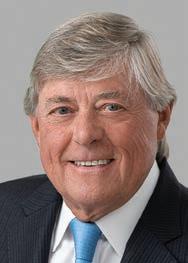
FIRM BRIEF Haug Partners (haugpartners.com) provides integrated, multi-disciplinary legal services for life science and technology businesses. Its goal is to deploy the Firm’s diverse resources, technical expertise, legal acumen, and business judgment to deliver optimal outcomes for clients.

When we started the firm more than 25 years ago, the founders of the firm were all, at the time, classified as patent attorneys – drafting patents and enforcing patents. It was a very technically focused practice, and all the lawyers had engineering or science backgrounds. The firm that we had originally come from had disbanded as the industry changed, and we had to decide whether to join a large, general practice firm and head up an IP group, join one of the larger patent firms that then existed, or to start our own firm. In 1997, we decided to start our own firm, and our vision was to become an intellectual property firm with high-quality lawyers with a focus on technology-related issues – using technology to support our work in drafting, enforcing, and defending all forms of intellectual property including patents, trademarks, and copyrights. We also became focused on dealing with government regulatory issues and actions, such as those involving the FDA, FTC, and ITC. We wanted to bridge the gap between what highly specialized patent firms were doing and what antitrust and FDA specialists were offering to service businesses, such as financial institutions, pharmaceutical and automotive companies, etc. Our lawyers needed to learn to think like businesspeople in addition to serving as lawyers.
We started small and have continually grown through the years. We evolved in a number of ways: we were the first IP firm to start an
FDA practice, which followed naturally from all the pharmaceutical work we were handling. We were the first IP firm to start an antitrust practice, which made sense because the main focus of the firm at that time was life sciences and we had evolved into a leader in the Hatch-Waxman arena. The vision for the firm was to expand, but not to become a general practice firm. We were focused on expanding in areas that were complementary to our core offering and expertise.
Over the last two decades, the practice has changed dramatically as technology has grown and expanded in ways that no one could have predicted. The internet came along, 5G came into being, lifechanging discoveries in gene therapy and medical breakthroughs, and now we are in the midst of a major paradigm shift to artificial intelligence and how all of this technology is going to intersect with the government and industry.
How has the talent at the firm provided a competitive advantage?
It has been a great advantage and enabled us to grow and achieve great results for our clients. Our approach to growing the firm has been to do it organically from people within. We aim to bring in the best young associates we can find in the top law schools, a diverse group of associates, and then provide opportunities for them to grow in the firm. We also added lateral partners with proven experience in very specific areas – including antitrust, FDA, and litigation – each of whom is today among some of the most respected experts in their respective fields. Our size and specialization allow us to be laser-focused on honing and elevating our practice.
Will you discuss Haug Partners’ approach to representing clients?
Our approach to representing clients, such as with due diligence or litigation, is to assemble a smaller team of people who are highly qualified from top to bottom, understand the issues our clients are facing, and remain focused only on addressing these issues. I like to describe us as a “Seal team” that gets meaningful results in very difficult cases as opposed to being like the Navy.
What have been the keys to Haug Partners’ ability to retain its talent?
Success in what we do. We have been able to create a firm culture where everyone trusts and respects each other. This includes all of our lawyers and staff. I think that being a smaller, specialized firm has allowed us to build that culture internally which we then effectively use to serve our clients. We try to work with the decisionmakers at the client – the chief IP attorneys, CEOs, managers, and business leaders – so that we can better understand their business needs. This collaborative style fosters a true partnership with our clients.
As the firm recently celebrated its 25-year anniversary, were you able to reflect and appreciate what the firm has accomplished?
Yes, I have. I have enjoyed every year of our 25-year history. I am very fortunate because of the trust and respect that I have with and among all of our Partners and our staff. Every five years we have a significant firm celebration with everyone at the firm and close friends and supporters of the firm. Haug Partners is not solely a law firm, but a family. I would not trade that for anything. •
EDITORS’ NOTE Sandy Kuzmich, PhD, focuses on patent litigation and strategic intellectual property counseling in the areas of pharmaceuticals, chemicals, and biotechnology. Recognizing that product life-cycle management is continuous and dynamic, she develops, manages, and protects diverse patent portfolios, taking into consideration a client’s immediate and long-term business objectives. Her extensive experience in pharmaceutical patent litigation allows her to offer a distinctive approach to protecting and maximizing the value of intellectual property assets. She specializes in counseling clients on how to obtain strong and diverse intellectual property protection on pharmaceuticals and biological products during early research, and how to expand and defend that protection throughout development, product launch, and beyond. Upon completion of her graduate degree in pharmacology, Kuzmich became a post-doctoral research associate with the Fox Chase Cancer Center where she investigated mechanisms of anticancer drug resistance. She spent several years in the private pharmaceutical sector, managing departments in the U.S. in the areas of drug metabolism and pharmacokinetics, and also collaborating with her counterparts in Europe and Asia to coordinate worldwide regulatory submissions. Kuzmich serves as Secretary on the Board of Directors for the Federal Circuit Bar Association, which includes being a frequent lecturer at various international conferences throughout the year. She earned a BA in chemistry, Phi Beta Kappa, from Douglass College, Rutgers University; a PhD in pharmacology from Yale University; and a JD from Fordham University.
What has been your personal mission as Managing Partner of Haug Partners?

I agreed to take on the role of Managing Partner because at this point in my career I have the experience and flexibility to devote time to preparing the Firm for the future. To me, that means taking what has worked and expanding upon it, but also having the foresight to evolve and pivot so that the Firm can meet the challenges that lie ahead. When I was elected Managing Partner in August 2019, I could not have imagined that six months later I would be faced with running the business in the midst of a pandemic. What I had planned to focus on had to take a back seat to the challenges that confronted us because of the pandemic.
What was it like to encounter the pandemic and how did Haug Partners adapt its business during this uncertain time?
The biggest challenge I have faced to date as Managing Partner was running the business leading up to, during, and after the pandemic. I was fortunate enough to be surrounded by a small but incredibly knowledgeable and dedicated administration that worked with me to transition attorneys and staff to a fully remote operation in anticipation of lockdown in February 2020. Because of our size and our collaborative culture, we were able to manage this transition efficiently and continue to function effectively while being fully remote so that we could focus on our business, which was to service our clients without interruption.
What is the biggest challenge you have faced coming out of the pandemic?
No question, the tension between remote work versus physical presence in the office. Our Firm has always had, and still does have, a culture
that emphasizes teamwork and mentoring, much of which is done through in-person collaborations at the office. And many of the most valuable interactions happen on the spur of the moment, which means a group of professionals getting together in a conference room to brainstorm an issue. Remote platforms, as good as they may be, don’t really lend themselves to this type of collaborative mentoring. Because of our culture that has for 25 years emphasized the value of interpersonal interactions in professional development, the majority of our attorneys have returned to the office on almost a full-time basis. In contrast to some large general practice law firms, we have not had to mandate that attorneys be in the office a specific number of days a week – that has happened organically.
Will you discuss Haug Partners’ efforts around diversity and inclusion?
Now that the pandemic is in our rearview mirror, I have been able to turn more of my attention to issues related to positioning the Firm for the next generation. Diversity is one of those issues. Post-pandemic I established a Diversity Committee, and the Firm became a member of the Leadership Council on Legal Diversity (LCLD), where I have pledged to continue to make inroads on the issues of Diversity, Equity, and Inclusion (DEI). Through the Federal Circuit Bar Association (FCBA), of which I am a board member and have been nominated for the position of Secretary beginning July 2023, I have fostered the participation of the Firm’s associates in mock appellate arguments before the judges of the Federal Circuit and mock pitches before in-house counsel. As an alumni of Douglass College, Rutgers University, every summer I sponsor two externs from the Reilly Program at the BOLD Center at Douglass. Our partnership with this program gives women an opportunity for a real-world experience of lawfirm life at an early stage of their education.
My approach to DEI is holistic, and not limited to what I do at Haug Partners. I was elected to the Board of Yale’s Graduate Student Alumni Association where I serve as a co-chair of the DEIB (“B” for “Belonging”) Committee.
In addition to your efforts in DEI, what other areas do you think are important as you look to shaping the future of the Firm?
I would like us to do more in the area of pro bono work. It is a real win-win for the client, and also for our young attorneys. The client benefits through attorney representation. On the other hand, our attorneys have the opportunity to argue cases before a judge, which sometimes does not occur early in a career because a lot of what we do is based upon written submissions to the court.
Because the pro bono prospects in the field of intellectual property law are not always available, we encourage our associates to take on pro bono work that interests them and gives them an opportunity to develop their skills. Appellate work concerning unemployment benefits, issues related to New York City small businesses, and legal assistance to Afghan nationals in need are just some of the Firm’s pro bono efforts.
You and Ed are both now managing the firm. Do you still have the chance to practice law together?
Yes we do, and we still have fun after all these years. Just recently, together we represented the Intellectual Property Law Professors and Scholars in the filing of an amicus brief before the Supreme Court in a highprofile intellectual property appeal. Not only was an aspect of the brief raised at oral argument, but the brief was cited and quoted in the Supreme Court’s written decision. Moments like this never get old.•
Sandy Kuzmich, PhD
Will you provide an overview of the Life Sciences practice at Haug Partners?
Haug Partners collaborates with Life Sciences clients to provide comprehensive legal strategies from the inception of an idea through commercialization and next-generation planning. Industry leaders trust and rely on the Firm to help them procure, manage, protect, and maximize the lifecycles of their most valuable intellectual property assets.
Haug Partners has appeared as lead trial counsel in more than 200 Hatch-Waxman litigations in its 25-year history, litigating more than 60 different pharmaceutical products with an overwhelming success rate. Our team includes more than 50 attorneys, mostly with technical degrees who have extensive experience litigating Hatch-Waxman cases as well as biosimilars and biotechnology discoveries. We have also prosecuted over 16,000 issued patents. Haug Partners effectively combines its scientific know-how with extensive trial, FDA, and antitrust experience to achieve optimal results for our life science clients.
What sets Haug’s Hatch-Waxman practice apart?
The Firm is a one-stop-shop for Life Sciences clients. From the Hatch-Waxman perspective, this involves extensive expertise not just in protecting our clients’ life-saving innovations by maximizing the lifecycles of their pharmaceuticals, but also providing expert insight into related issues including antitrust and FDA. The Firm brings a unique group of exceptionally experienced, bright, diligent, and focused lawyers to a trial who understand the science, are comfortable in the courtroom, versed in the legal and regulatory issues at play, and appreciate the realworld pharmaceutical market dynamics to win and achieve our clients’ objectives. Additionally, we are able to tap into our unique history of being an industry-leader in representation of generic pharmaceutical companies before we transitioned to representing on the brand side. All of these factors contribute to the firm’s extraordinarily high rate of success in representing Hatch-Waxman plaintiffs.
What is the future of the firm’s Hatch-Waxman practice?
The Hatch-Waxman practice’s future is bright and exciting as the Haug team relies on experienced attorneys and an ever-growing bench

of motivated, eager, and capable younger attorneys who participate, contribute and add to a winning team. The practice has evolved into the biosimilars arena, too.
What is something you enjoy about Hatch-Waxman litigation?
We enjoy the opportunity to understand and support the business objectives of our clients both from a high level and also down to the smallest details. We don’t just understand the highly technical subject matter behind our clients’ hard-earned patents, but we also understand how drugs are formulated and distributed, how doctors prescribe them and how consumers use them. We leverage this knowledge to really “paint a picture” or tell a story for the judge or jury when putting together our strongest case.
Of course, we also enjoy the thrill of achieving favorable results for our clients when the stakes are high. Most recently, the Firm secured a key victory protecting Takeda’s multibillion dollar Vyvanse® product from generic competition during the full term of Takeda’s patent life. •
How does the Firm’s antitrust practice support the firm’s mission of enhancing value for technology and life sciences clients?
Our technology and life sciences clients are innovators, and gain value by introducing new and unique products that dominate the marketplace, frequently on account of intellectual property rights. With that success and with IP rights comes antitrust risk, and we routinely work
Porter Fleming, Nick Giove, Andrew Roper, Kaitlin Farrell, Andrew Wasson Kaitlin Farrell, Porter Fleming, Nick Giove, Andrew Roper, Andrew Wassonwith these clients to avoid, mitigate and defend against that risk, whether in the initial strategy or throughout the product lifecycle, including at the point of IP enforcement.
What makes the Firm’s antitrust practice unique?
Our antitrust practice is unique in two ways. First, we are a small firm practice with a big firm presence. The small firm approach offers us regular access to our patent, regulatory and litigation colleagues, enabling us to better serve our antitrust clients. In the meantime, we take on major complex antitrust cases in roles typically handled by only the largest firms and we counsel on high stakes cutting-edge issues. Second, we are among the leading experts in pharmaceuticals and life sciences antitrust. Beyond working in a lead role on some of the major cases of recent years, we closely follow every development within this space, and we share an understanding of the industry and the law that puts our life science clients at a strategic advantage.
How do you see the antitrust practice evolving?
Our antitrust practice evolves by staying on top of both the technological developments and legal developments that are in constant flux. As products, conduct and theories evolve, our practice moves with them and even subtle changes in the landscape may counsel for change in how we frame certain issues and advise our clients. Likewise, our litigation practice utilizes the best and latest technology, and will continue to evolve as the features and options available to us evolve.•
Andrew Wasson
What is your approach to FDA law?
Our approach emphasizes the close relationships that FDA law has with other practice areas in the life sciences sector. FDA regulatory law has a close and important relationship with patent law and litigation between pharmaceutical companies advancing brand products and generic pharmaceutical companies looking to market lower cost drugs. The statutes that authorize generic drugs and followon biologics contain extensive provisions relating to the resolution of patent disputes. Issues at the cutting-edge of FDA regulatory law also underpin many antitrust disputes in the pharmaceuticals sector. Appreciating the many touch points between the areas of law is not only intellectually challenging, but it provides a richer approach to litigation and product strategy.
How does FDA law effect patent litigation in therapeutics?
FDA regulatory statutes have many direct effects on patent litigation in pharmaceuticals and biologics. For one, regulatory exclusivities can affect the timing of when a patent litigation can start. The statutes that govern generic or follow-on therapeutics often prescribe exclusivities that limit when a generic or follow-on applicant can file an application with the Agency. For drugs that are new chemical entities and for biological products, the relevant statutes prevent a generic applicant from even filing an application until four years from the approval of the innovator product. And then relevant statutes contain provisions that give rise to other types of exclusivities as well, which govern when the FDA can approve a generic product (e.g. orphan drug exclusivity, clinical exclusivities, and pediatric exclusivity).
What is the relationship between FDA law and antitrust litigation?
FDA regulatory law is also sometimes implicated in antitrust disputes in the pharmaceuticals sector and our regulatory practice often supports our antitrust colleagues. For instance, antitrust plaintiffs sometimes allege that innovator pharmaceutical companies improperly petitioned the FDA to institute inappropriate requirements on generic competitors. Understanding whether arguments are reasonable often has antitrust implications and requires deep experience with Agency precedent.
What are some other issues at the intersection of FDA law and patent law?
One major area where FDA and patents overlap is the FDA publication colloquially called the Orange Book – the print edition many years ago had an orange cover. The types of patents that can – and should
not – be listed in the Orange Book can have wide-ranging repercussions. For instance, generic applicants have to take a position on the infringement and validity of patents listed in the Orange Book, which could give rise to a 30-month litigation stay during which the FDA generally cannot approve a generic applicant. Knowing the line between “listable” and “unlistable” patents requires judgment and familiarity with a decades long dialogue between the Agency, industry, and lawmakers.
What are some ways that high tech advances are transforming FDA law?
Advances in computer science are transforming every industry, including pharmaceuticals. As the pharmaceutical industry continues to harness new computing advances, the FDA faces the increasing challenge of determining whether, and to what extent, regulation applies to these new uses. However, these challenges are not new to the Agency – the FDA has been addressing the growing number of medical devices incorporating AI and machine-learning for a number of years. •
Brian Murphy
How does your experience as a former Lead Administrative Patent Judge shape your practice?
The Patent Trial and Appeal Board (PTAB) is a high-profile business unit of the U.S. Patent & Trademark Office responsible for taking a second look at commercially important patents. For example, a company sued for patent infringement in federal district court can now challenge the validity of the asserted patent in a PTAB proceeding that is much faster and less expensive than district court patent litigation. I served as a PTAB judge for four years, including three years on the leadership team where I was a Lead Administrative Patent Judge responsible for supervising, training, and mentoring a team of 15 Administrative Patent Judges. I also presided over nearly 200 PTAB patent validity challenges that impacted some of the most successful companies in the world – AstraZeneca, Apple, AT&T, Baxter Healthcare, Cox Communications, Eli Lilly, Google, Lenovo, Microsoft, and 3M Company, among others.
My experience allows me to provide clients with strategic and tactical advice in PTAB patent validity proceedings as a critical component of an integrated patent litigation strategy. In particular, I help identify, distill, and forcefully present the most relevant and material evidence of record in our briefs and at oral argument. I often conduct mock PTAB and Federal Circuit arguments to help prepare lead counsel to be most effective at oral argument. On occasion, I also serve as an expert witness in patent practice and procedure.
How does the PTAB practice contribute to Haug Partners’ mission of maximizing the value of its clients’ patent portfolios?
Haug Partners has a very successful track record when defending patent owners in PTAB patent validity trials. PTAB cases we have handled range across many technology disciplines: pharmaceuticals, biotechnology, biomedical devices, mechanical and electrical devices, and related computer science and software. Our firm grasp of legal, scientific, and procedural nuances yields critical insights when litigating complex patent cases, which is key to our effective representation of innovative life sciences and technology clients at the PTAB. Haug Partners attorneys are well prepared and adept at explaining the legal and technical positions crucial to persuasive argument before technically savvy PTAB judges.
I bring the cold eye of an experienced judge and passion of a long-time trial advocate to advance each client’s interest in every case. In virtually all completed cases where Haug Partners has defended a patent owner in PTAB patent validity challenges, the firm has either won a denial of the patent challenger’s petition, a Final Written Decision upholding the patent claims, or a favorable settlement. Clients trust our PTAB expertise.•

Does Haug Partners represent clients in industries other than the life sciences industry?
The Firm represents clients in a variety of other industries, including the automotive, technology, and medical device industries, in patent litigations and related proceedings. This includes patent infringement litigations in U.S. District Courts and the International Trade Commission (ITC), post-grant proceedings in the Patent Trial and Appeal Board (PTAB), and patent appeals in the U.S. Court of Appeals for the Federal Circuit. Clients include Porsche, Volkswagen, Audi, Bentley, and Red Bull Racing (the Formula One team). The firm also represents clients applying for patents in the U.S. Patent and Trademark Office.
What tools does Haug Partners utilize to achieve its success in the courtroom?
We like to say that we have a “deep bench” of top tier intellectual property attorneys and can specially curate the right team of people to represent the specific needs of our clients. Whereas some large general practice firms have smaller IP practice groups where each attorney focuses

broadly on all sectors of IP law, our attorneys have the ability to subspecialize and hone their practice with a more focused approach. This means that for most IP issues that arise, we have attorneys who have favorably resolved very similar problems many times over. Of course, the challenge and the excitement comes from leveraging that experience to develop the right strategy for a particular and unique client issue.
We also routinely collaborate with trusted, industry-leading experts with whom we are very proud to work. Choosing a qualified and credible expert who will defend his or her opinions under cross-examination is critical, and the Firm has extensive experience identifying the right expert for any given case by tapping into our vast network of trusted connections or finding new experts based on top-of-the-line industry and academic credentials.
Does the Firm have experience litigating at the International Trade Commission?
Yes, the Firm has significant experience litigating at the International Trade Commission, or the ITC. The ITC is a federal government agency that can block the importation into the United States of products that the agency determines infringe a valid patent. An ITC litigation is similar in many respects to a patent litigation in a district court because the parties litigate the question of whether the patent is valid and infringed. While the ITC does not award infringement damages, it will block importation of products that infringe a valid patent, and it can be a powerful tool in the arsenal of a patent infringement plaintiff.
Mark Chapman, Georg Reitboeck Camille Turner, Sheila Mortazavi, Jonathan HerstoffAre there benefits to litigating at the ITC compared to the district court?
Often times these litigations take place in parallel. The ITC typically issues its decision more quickly than most courts, which can strengthen the patent owner’s leverage in settlement discussions. Given its jurisdiction, ITC cases are often filed against foreign companies that import products made overseas into the U.S., including consumer electronics and automotive companies.
Does the Firm work with clients involved in international patent litigations?
Because we represent leading global technology companies, this is most often the case. For defendants, patent litigation in the U.S. is typically more expensive, burdensome, uncertain, and unpredictable than patent litigation in other countries, primarily because of several unique features of the U.S. litigation system. We work with international clients to protect their interests while navigating and complying with the sometimes intrusive nature of U.S. discovery processes.
Have there been any recent noteworthy developments in the patent world from an international perspective?
One significant recent development is the new European Unified Patent Court (UPC), which opened its doors on June 1. Before the UPC, patent owners who wanted to sue for infringement in Europe would have to bring a separate litigation in each country. Now they can file one litigation in the UPC and obtain an infringement damages award and an injunction in all 17 member countries, including Germany, France, Italy, and the Netherlands.
The advantages of being able to obtain cross-border remedies across such a large marketplace presumably should induce patent owners to file in the UPC. Moreover, we expect that the UPC will be more willing than U.S. courts to grant injunctions, in particular for patent-assertion entities who typically cannot obtain injunctions in U.S. courts. It will be interesting to see whether patent-assertion entities file more actions in the UPC, including as another front in an international enforcement campaign with a parallel U.S. lawsuit.
How is the patent world dealing with the rapid pace of developments in artificial intelligence?
The patent community is actively considering and debating the role of artificial intelligence (AI) in innovation and obtaining patent protection. The Federal Circuit concluded last year that a patent cannot be obtained if an AI system is listed as the sole inventor. The court reasoned that the patent statute defines an ‘inventor’ who can obtain a patent as limited to a human being, and the Supreme Court recently declined to review the decision.
Overseas, the Federal Court of Australia also concluded that AI could not be an inventor under the Australian patent statute, and the UK Supreme Court is currently considering this issue under the UK statute.
Additionally, the U.S. Patent and Trademark Office has solicited feedback and is actively considering the impact of AI on the patent application process, including the circumstances in which a human inventor can obtain a patent for an invention developed with the assistance of AI. The U.S. Congress is also holding hearings regarding the impact of AI on intellectual property protection.•
Jon Gordon and Jenny Lee
What types of prosecution and counseling services does the Firm provide to technology-focused clients?
As a result of its 20+ years of experience in prosecuting patents across widely diverse technologies – spanning data processing to drug development – clients rely on Haug Partners to protect their innovations in the United States and worldwide. The technology prosecution practice emphasizes computers, data networks, and financial technology, building on our professional experience, such as Partner Jon Gordon’s background as a derivatives trader and a software developer. Gordon has deep experience protecting inventions related to blockchains and distributed ledgers. When seeking patent prosecution services, innovators trust the Firm’s multifaceted experience and insight will let us find and protect the value in their inventions.
How does the the life sciences patent prosecution practice support the Firm’s objectives of maximizing the value of its clients’ intellectual property?
We routinely help innovators secure patent protection for their inventions and help navigate intellectual property questions that arise in day-to-day research and development in the pharmaceutical, biologic, and medical device industries. In life science industries, patent rights are critical in helping innovators protect their research and development investments and manage product life cycles. Our attorneys apply their strong abilities to digest complex biologic and chemical technical information to help clients procure worldwide patent rights. We apply that technical understanding to help clients navigate the interplay between patent protection and regulatory exclusivity regimes and provide a business-oriented approach in building and managing patent portfolios. Often, we work closely with both technical and business personnel to develop patent strategies that are aligned with our clients’ business goals, including life cycle management of products. We are also frequently called upon by our clients to provide patent insights in various types of transactions, including evaluating patent portfolios and regulatory exclusivities relating to pharmaceutical, biologic, and medical device products. •
“We like to say that we have a ‘deep bench’ of top tier intellectual property attorneys and can specially curate the right team of people to represent the specific needs of our clients.”
Ben Natter

Our aim is to go beyond robotically filing for new trademark applications – anyone can do that. Rather, we strive to help our clients carefully clear potential marks and ensure that our filing strategy matches their long-term goals for their business and brand. This process may include a global trademark search, deciding whether to add a design or additional terms to accomplish registration, analyzing potential enforcement issues, along with numerous other considerations regarding how the mark will be used and in which jurisdictions.
Our trademark team represents domestic and international clients, including world-famous brands and market leaders. Moreover, our clients stem from a broad range of industries including technology, fashion, retail, consumer goods, software, hospitality, entertainment, and media. It takes time to learn business and industry objectives to ensure clients are properly represented. Our trademark group includes attorneys with experience in the U.S. and abroad that have worked both as in-house counsel and in private practice. Our unique perspective and experience allows
clients to tackle potential roadblocks at the onset of implementation of strategy and minimize issues brands are accustomed to discovering down the road with a standard U.S.-focused firm.
What is the reach of the trademark practice?
At Haug Partners, the trademark group is global. On any given day, we handle trademark filings, enforcement, and disputes worldwide. Our team is highly effective handling global disputes because we understand there is not a one-size fits all strategy in trademark law. We tailor each client’s specific needs, objectives, and concerns to develop the proper strategy. In doing so, we take into account the global implications of any particular action to ensure that we are consistently putting the client’s objectives first, no matter where they may be doing business.
Our team is well equipped to handle the procurement and enforcement of intellectual property rights even in the most complex regions due to our experience and close relationships with a cultivated team of local counsel throughout the world. Notably, our team has achieved considerable success and recognition in connection with our work in Latin America and China. This keeps the practice interesting for both clients and our team and it is quite unique for a U.S.-based firm.
How does Haug Partners utilize the Trademark Trial and Appeal Board to achieve client goals?

The Trademark Trial and Appeal Board (TTAB) is a very important part of our practice in handling domestic disputes. Our team has extensive experience handling all types of disputes before the TTAB including appeals, oppositions, and cancellations. By strategically utilizing the TTAB, we are able to bring pressure on another front that tends to be quicker and more cost-effective than a federal lawsuit. The TTAB is yet another example where we are able to apply our vast experience to develop an appropriate strategy, utilizing all available avenues, on behalf of our clients.
What advice would you give a prospective client about their options if someone is infringing their trademark?
Enforcement against an infringer can feel like a daunting task for clients. We aim to tailor each client’s enforcement strategy to accomplish their goals while keeping in mind important considerations such as cost, timeline, and potential publicity. Our practice utilizes a large range of enforcement measures ranging from cost-effective administrative proceedings – which can be implemented in many countries – to federal infringement lawsuits. Additionally, our team has extensive experience negotiating favorable settlement agreements on behalf of our clients. In sum, we carefully weigh options to determine the most appropriate and efficient path to achieving the objective of our client.•
Ben NatterSELECT FIRM ACCOLADES
• Firm Managing Partner Sandy Kuzmich Current Secretary Federal Circuit Bar Association
• World Trademark Review for New York 2020-2023
• Patexia® Best Performing Law Firm 2023, 2022
• Patexia® Most Active Firm 2023, 2022
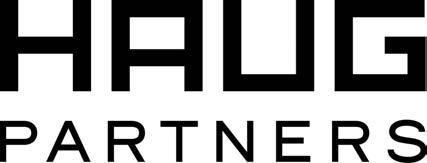
• Patexia® Best Performing Attorney 2023, 2022
• Leadership Council on Legal Diversity –2022 Compass Award
• Best Lawyers® “Best Law Firms” 2023, 2022 – National Rankings in Patent Law, Antitrust Law, FDA Law, and Mass Tort Litigation/Class Action - Defendant
• Many Super Lawyers® and Rising Stars distinctions

EDITORS’ NOTE Magui Chadwick grew up among the Cabernet Sauvignon vines of Puente Alto, where some of the finest wines of Chile are sourced. She graduated with a degree in design from Universidad Católica de Chile and then specialized in fashion and luxury brand management at the London School of Arts. Following a brief stint in fashion, she returned to her roots and joined her father, Eduardo, in steering the family wine business, which comprises Seña and Viñedo Chadwick, to new heights. Her roles have grown quickly at both estates, starting as the brands’ chief marketer, and recently becoming executive director, where she travels to various markets, leads global communications strategies with her marketing teams, and reaffirms Seña and Viñedo Chadwick’s position as not only one of Chile’s finest wines, but among the world’s best. Chadwick has become a strong symbol of female leadership in South American fine wine, and is part of the wave of female leaders taking wine brands into the future.

COMPANY BRIEFS Seña (sena.cl) is the product of a revolutionary collaboration between globallyrecognized winemaking icons Eduardo Chadwick and Robert Mondavi. Established in 1995, Seña is Chile’s first icon wine because it serves as a pioneer within its terroir. In 2017, world-renowned wine critic James Suckling awarded a perfect 100 score to the Seña 2015 Vintage. This incredible global feat solidified Seña as a formidable top-tier wine of not only Chile, but the world. Last September, Seña released its 2020 Vintage. Seña is the latest entity of the Chadwick Errázuriz portfolio of wines from a historic family that continues to evolve the wine industry.
Viñedo Chadwick (vinedochadwick.cl) is a tribute to Don Alfonso Chadwick that showcases the tradition and expertise of the Chadwick family in producing fine wines. The vineyard, originally his personal polo field, is considered the cradle of world-class Cabernet Sauvignon in Chile. Located in Puente Alto D.O. Maipo Valley, Viñedo Chadwick made history at the legendary Berlin Tasting in January 2004, in which Viñedo Chadwick 2000 was placed first, above the Super Tuscans from Italy, and the First Growth wines from Bordeaux of that vintage.
Will you discuss the history and heritage of Viñedo Chadwick and Seña and how these brands have evolved?
Each of these wines has its own origin and character. Viñedo Chadwick was born as a tribute to my grandfather, Alfonso Chadwick. In his honor and memory, we converted his beloved polo field at our home estate in Puente Alto, Maipo Valley, into a vineyard back in 1992. The small appellation of Puente Alto, located at the foothill of the Andes Mountains with gravel alluvial soils, had historically been considered the cradle of the finest Cabernet Sauvignon from Chile, and my family wanted to create a wine to showcase the greatest expression of this unique terroir in order to give the estate the destiny it deserved. For these reasons, Viñedo Chadwick is always going to be of great significance for us as it represents our family quest and desire to build a legacy for future generations of what can be achieved from our land with passion, perseverance, and pursuit of excellence.

On a different note, Seña became a reality in 1995 when Robert Mondavi and my father, Eduardo Chadwick, signed the first international joint venture in the history of Chilean wine. They embarked on a pioneering journey with the challenging goal of creating a truly great wine that would showcase the full potential of Chile in producing world-class wines. Seña’s beautiful property is located some 100 kilometers north of Santiago in the Aconcagua Valley, just 40 kilometers away from the cold Pacific Ocean. Modeled on a Bordeaux style, Seña’s hillside vineyard is planted to Cabernet Sauvignon and Carmenere, which gives the wine its “Chilean soul,” along with Malbec, Petit Verdot, and Cabernet Franc, all farmed under biodynamic practices.
What have been the keys to the strength and leadership of Viñedo Chadwick and Seña in the industry?
Throughout their history, both Seña and Viñedo Chadwick have played a leading role in obtaining global recognition for Chilean fine wines. This constantly implies breaking boundaries and setting their own paths with passion, persistence, and vision. Starting with the Berlin
Tasting in 2004, which was inspired by the Judgment of Paris, the landmark event that took place in France in 1976, my father invited the legendary wine figure, Steven Spurrier, to conduct a blind tasting in Berlin in January 2004. Europe’s most respected wine experts came together and judged Seña and Viñedo Chadwick against the world’s finest Bordeaux and Super Tuscan wines from the millennium vintage, some of which had received 100 points from wine critic Robert Parker.
The results of this now-historic tasting surprised everyone and proved to be a true eyeopener. Of the 16 wines tasted, two Chileans topped the expert’s lists of preferences – the 2000 vintage of Viñedo Chadwick was first, and the 2001 Seña was second and ahead of the best wines of the world. The Berlin Tasting became a milestone event for the Chilean wine industry and also helped elevate the image of Chile and positioned it in the global map of fine wines.
Some years later, Viñedo Chadwick 2014 received Chile’s first 100 point score, which proved our family commitment to produce the best wine with meticulous attention to detail and utmost respect for the land.

Will you highlight your role with Viñedo Chadwick and Seña and how you focus your efforts?
Today, my role as Executive Director for Seña and Viñedo Chadwick focuses mostly on the marketing strategies for both brands, defining the objectives and plans to strengthen their positioning among the best wines of the world, and consolidating their distribution globally. I also participate in key market visits and consumer activities abroad related to image building.
I help lead the sustainability initiatives at both wineries and work together with our great teams to keep all parts aligned and reach our goals successfully. Additionally, I represent the family at Viñedo Chadwick, which plays a key role in every aspect of this wine from the viticulture, winemaking, the family house, the promotion in the markets, as it is a very special project for the family and holds the legacy we want to transmit to the future generations.
Do you feel that South American fine wine is well-understood and what do you want people to know about the region?
The most renowned critics and people in the wine industry understand and validate South American fine wine, but we need to strengthen the understanding of Chilean fine wines within the wine lover and wine collector communities of the world. There is also a great need to educate people on wine appreciation, empower wine enthusiasts, and get the younger generations interested in wine.
Chile has proved that there is great diversity of sites for producing quality wines from specific site appellations, from the foothills of the Andes Mountains to the coast of the cold Pacific Ocean. We have the challenge of getting the consumer familiar with these terroir-driven wines and I want people to refer to these as world-class wines of origin.


Do you feel that there are strong opportunities for women in leadership positions in the wine industry?
I think there have been improvements over the years when it comes to leadership opportunities for women, and the industry will keep moving toward a more equal space as it is happening globally. Now, you can see some female wine personalities that are very relevant in the industry, especially in the areas of wine writing, reviews and producers. In Chile alone, we have many talented women winemakers that are contributing and marking the difference in the Chilean wine scene.
Other examples include more women becoming Masters of Wine, or the “SAKURA” Japan Women’s Wine Awards, where a contest is judged only by women. It will be interesting to watch how the trade sector in the wine industry will evolve in this matter, but the future is bright for women leaders.
What has made the family business work so well and how special is it to work with your father?
Something that has always caught my attention is the vision, persistence, and dedication of the leaders in my family. When there is a strong commitment to the long-term vision, every process works in an eloquent way as the goal is clear. This process shapes how the family business is run by making authentic, quality wines that stem from deep respect for tradition, land, and nature that is inherent in the wine’s origin. My father played an important role in my interest in the wine industry and has given me great opportunities to develop and explore from a young age. I learned, and continue to learn, so much from him. Thankfully, we complement each other in a very good way that benefits the whole team.
What are your priorities for Viñedo Chadwick and Seña as you look to the future?
Our top priority, commercially speaking, is to continue strengthening Seña and Viñedo Chadwick’s position among the leading fine wines of the New World. To achieve this, one of our strategies is to continue growing in our global distribution, maintaining our constant growth in the secondary market and maximizing our presence in the top, high-end on-premise accounts. Although we have a balanced international distribution, during the last few years we’ve been focusing on the U.S. market as it is very dynamic. For consumers, we are developing more events to reach the fine wine collectors directly, such as auctions in the top houses, wine dinners showcasing historical vintages, and even some exclusive opportunities to visit our estates in Chile to understand and experience the origin of our wines. Also, we are increasing our digital presence in the different social channels and taking advantage of all the emergent technologies for tailor-made promotions of our wines.
In addition to our organic and biodynamic practices in viticulture, our most important efforts are focused on sustainability which comprises a wider approach from all angles, including the community and all processes involved in the business. We are also putting utmost care to reduce water consumption and look for better management solutions, as the availability of this resource is becoming one of Chile’s biggest challenges.•
EDITORS’ NOTE Kate McManus is a leader in marketing, business development and branding with more than 25 years of experience in the wine and spirits industry, She has focused on building talented and dedicated teams by creating a positive culture that fosters innovation and creativity. As a thought leader, McManus is an expert in developing strategies for winery portfolios and excels in building brands with a consumer first approach. Over the years, Kate has worked for some of the industry’s top companies from New York to Napa Valley. After spending over 10 years with Remy Cointreau and Kobrand in NYC, she moved to the Bay Area almost 20 years ago. As Vice President of Marketing at Constellation Brands, Kate led marketing for domestic and international wineries from New Zealand to Italy with a focus on both luxury and innovation. Later at Delicato Family Vineyards, she was given the opportunity to rebuild a marketing department with expanded trade and digital capabilities and a more consumer first mindset. Since joining Far Niente Wine Estates in early 2022, she is focused on strengthening FNWE’s consumer marketing, winery experiences, and supporting the winemaking teams to build on their recognition as a premier Napa Valley and Sonoma producer.
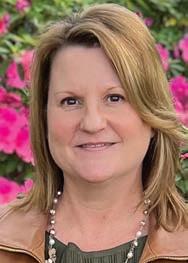
WINERY BRIEF Far Niente (farniente.com), renowned for its Napa Valley Chardonnay, Napa Valley Cabernet Sauvignon and Oakville Cabernet Sauvignon, is one of Napa Valley’s original stone wineries, constructed in the late 19th century. Today, more than 125 years later, the winery stands as a stunning example of the region’s early winemaking heritage.
What excited you about the opportunity to join Far Niente Wine Estates (FNWE) and made you feel it was the right fit?
I eagerly joined Far Niente Wine Estates (FNWE) due to its exceptional collection of renowned brands that command great respect, consistently craft exquisite wines, prioritize meticulousness, and set the standard for unparalleled hospitality. These brands embody an exceptional dedication to quality, catering to consumers of all backgrounds, and exemplifying industry leadership in every aspect, from their meticulous farming practices to the exquisite taste of their wines. I feel that I was the right fit for the role at FNWE because I bring more than 25
years of strategic, consumer-first oriented marketing expertise. My background lies in planning and developing strategies for strategic portfolios, and I excel in building brands with a consumer-first approach. I am developing strategies for each of FNWE’s brands that will support their foundation and position them for future growth. By taking a consumer first approach, I am focused on strengthening the company’s commitment to providing the finest in luxury hospitality and service in the Napa Valley.
FNWE is dedicated to investing in its wines at all levels of production, from farming the vineyards to committing to sustainable practices across its wineries. Since joining the company in April 2022, I have played a fundamental role in our company’s work to build a new home for our Bella Union brand at the former Provenance winery in Rutherford.
Will you discuss the history and heritage of Far Niente Wine Estates?
Far Niente was established in Oakville, California in 1885 by John Benson, a forty-niner from the California gold rush. The winery prospered until the onset of Prohibition in 1919, when it ceased operation and the estate was abandoned. Sixty years later, the Nickel family purchased the winery and neighboring vineyard. The old stone shell of the winery underwent a three-year renovation which restored the building to its original, 19th century grandeur. They released their first wine, a Chardonnay, from the 1979 vintage, and winemaking returned to the estate in 1982. During restoration, the name “Far Niente,” which romantically translated means “without a care,” was found carved in stone on the front of the building.
Far Niente helped create the high-end Napa Valley wine market and has served as the benchmark wine estate for more than four decades. Dolce, the only North American winery devoted to a single late-harvest, botrytized Napa Valley wine, was introduced in 1989. Nickel & Nickel, launched in 1997, is focused on producing single-vineyard, single varietal Napa Valley Cabernet Sauvignon. EnRoute, established in 2007 in the Russian River Valley, is dedicated to the appellation’s Pinot Noir. Bella Union, devoted to Napa Valley Cabernet and located along Bella Oaks Lane in Rutherford, introduced its first wine with the 2012 vintage. Most recently, Post & Beam launched in 2020 with classic expressions of Napa Valley Cabernet Sauvignon and Chardonnay. Together, the wineries comprise Far Niente Wine Estates.
Will you highlight Far Niente Winery and the guest experience when visiting the winery?


Our Far Niente Winery sits nobly atop a crest in the heart of Oakville, Napa Valley. From beautifully cultivated gardens, to sprawling estate vineyards, to historic wine caves, you can explore the full splendor of the idyllic Far Niente Winery while enjoying a seated private tasting of our world-renowned Napa Valley wines.
Our signature experience is the Cave Collection Library Wine Tasting, which offers a tasting of our current release wines alongside specially selected Cave Collection library vintages expertly paired with seasonal food complements by Executive Chef Phillip Moratin. During this private, seated tasting, guests can discover how Far Niente wines age and evolve over time.
What have been the keys to the consistent strength and leadership of Far Niente Wine Estates in the industry?
As a benchmark wine producer in the Napa and Russian River Valleys, Far Niente Wine Estates is committed to preserving the land that we call home. Our goal from the beginning has been to prioritize environmental protection and sustainability, from installing the world’s first floatovoltaic solar energy system in 2008, to conserving water through forwardlooking and innovative farming practices. As part of our core mission of being responsible neighbors, we are also committed to bettering our community through the philanthropic initiatives and philosophy that was established by our founders, the Nickel family.
Our employees differentiate us in the industry through their knowledge and dedication to our vineyard and winemaking imprint. We are honored to further a strong company culture based upon respect, excellence, integrity, and social responsibility. We invest in our people through supportive wages, benefits, and a continual emphasis on evolving and growing.
vineyard blocks with drought-resistant rootstocks and installed technologies that measure vine-water demand and use other natural measures for early soil cultivation and weed control.
Carbon Emissions Reduction: Improved vineyard and winery efficiencies is of the utmost importance for all aspects of our day-to-day work. We avoid peak hours of electrical energy usage and implement multi-row mechanization to reduce tractor-drive time. Our Far Niente and Nickel & Nickel wineries are solar-powered, net-zero users of electricity energy for everything on the property.
Integrated Pest Management: By proactively tackling bio control efforts, we work to sustainably control pests and mitigate the risks they pose without relying on non-sustainable control measures and harmful plant chemicals. FNWE utilizes predatory insect release and insect mating disruption strategies allowing us to target specific pest species and proactively reduce pest populations. We also forgo the use of traditional pesticides which negatively affect the health of our vines, soils and water sources.
Far Niente installed the world’s first Floatovoltaic solar energy array in the winery’s vineyard irrigation pond saving valuable acreage. Far Niente purchased eight new propane powered frost fans to replace the diesel-powered water pumps saving over 5,000,000 gallons of water per year while reducing diesel consumption.
As a result of these efforts, FNWE has earned a number of sustainability certifications and awards. Far Niente and Nickel & Nickel are Certified California Sustainable Wineries (CCSW) – reflecting a commitment to growing and crafting quality wine grapes and wine while protecting the environment, being a good neighbor and employer, and maintaining thriving farms and businesses. They are also Napa Green Certified Wineries – demonstrated from production and administration to hospitality, they have implemented more than 120 sustainability and stewardship standards, and are committed to promoting sustainability.
Did you always know you had a passion for the wine industry and what has made the industry special for you?
At a young age, I started working in my Uncle Sal’s restaurant in New Jersey. From coat check to bartender and everything in between, I fell in love with the idea of bringing people together around a table to enjoy great food, wine, and conversation. After graduating college, I embarked on an adventure to Europe to discover more. Armed with just my Eurail pass and a backpack, my journey introduced me to the diverse cuisines across the continent, where I learned about the significant role that food and wine play in different cultures. Upon returning to New York City to kick off my career, I couldn’t resist the opportunity to work as an entrylevel marketing coordinator for a large French company that imported Champagne, Cognac, and Italian wines. From there, I fully immersed myself in my love for travel, history, and the sheer joy that food and wine bring to a culture.
We engage in the community holding agricultural representation in local government, memberships in the Farm Bureau, Napa Valley Grapegrowers, Winegrowers, Napa Valley Vintners, and certifications across multiple levels in the company, which reflects our dedication. Our partnership with our teams allows us to be nimble, be open to new ways of doing things, and to never stop finding ways to be the best possible stewards of the resources we have been entrusted with.
Will you elaborate on Far Niente Wine

We strive to champion biodiversity and sustainability in our vineyards and wineries. From water conservation and drought mitigation to improving winery efficiencies and reducing carbon emissions, we value environmental stewardship in all aspects of our company.
Water Conservation: One of the most important aspects of our sustainable practices is water conservation. With limited water supplies, conserving and recycling water helps us maximize this precious resource. To this end, we have implemented practices such as replanting our estate
Soil Health: A multi-layered approach to each site’s soil is an ongoing process to improve the health of each specific vineyard. FNWE has a multi-tiered belief in soil health. Heavy preplant compost applications of 25 tons per acre is an investment that pays us back in perpetuity. Benefits include reducing tillage needs down to zero, successful cover crops, improved nutritional levels in the rootzone, and increased storage of carbon.
Biodiversity and Wildlife Conservation: The promotion of ecology across our vineyards and properties has been an impressive feat. We have installed native corridors to allow animals to pass through our properties and invested in high density (1 per 20 acres) owl boxes and raptor perches to control gophers, voles and squirrels without pesticides.
Energy Efficiency and Greenhouse Gas Mitigation: Fossil fuel reduction is a priority at FNWE and is exemplified by our Scope 1, 2 and 3 GHG audit. In the vineyards, we minimize tractor passes with effective farm planning and multi-row operations reducing GHG. In 2008,
In fear of sounding cliché, it’s the people in the industry who have truly made it special. I was fortunate to receive guidance and support from some C-suite executives who believed in my ideas and allowed me to develop and launch brands like The Dreaming Tree with Dave Matthews. I also had the opportunity to create new strategies for oldworld wineries, such as Ruffino Estates from Italy, while finding ways to make Chianti more relevant to consumers and launching line extensions in growing categories like Pinot Grigio and Prosecco. Being involved in building new categories from their infancy, like Black Box 3L boxed wines and Tetra pack wines, taught me the importance of innovation. Nowadays, my focus is on mentoring and giving back to those entering the business. I am deeply passionate about workplace equality, particularly in the wine industry. In the past, I served as co-chair of the Women’s Leadership Committee, where I provided guidance and mentorship, and helped establish an internal women’s recognition program. I have also been actively involved in and sponsored Women of the Vine & Spirits. At Far Niente Wine Estates, I currently serve as the co-chair of the CSR (Corporate Social Responsibility) committee, where I contribute to guiding internal sustainability, DEI, and community development efforts.•
EDITORS’ NOTE Lisa Branson previously consulted for Campari where she globally managed the launch of Rare LTO Scotch and supported all categories in business intelligence. Before that, under her direction as the Vice President of Marketing for Arta Tequila, a start-up artisanal ultrapremium tequila brand, she grew the brand to a top 100 spirits brand as named by Wine Enthusiast in three years representing sales growth six times faster than category average. Earlier, she was with The Integer Group driving national promotions and the Coors Light brand for Coors Brewing Company. She has held various marketing leadership positions in Fortune 500 companies, built a brand division of a full-service marketing agency, and offered consulting services. Branson earned a BA in business and communications from Hamline University and an MS in marketing from the University of Colorado Denver.

COMPANY BRIEF Part of Stoli Group, one of the world’s leading premium spirits businesses, Cenote Tequila (tequilacenote.com) is an ultra-premium 100 percent Agave Azul Tequilana Weber Tequila inspired by the beauty of the Yucatán Peninsula and the spectacular underground water systems unique to this geographical region. Cenote Tequila has a complex flavor profile that balances fragrant cooked agave with delicate wood notes and is a result of the diligent craftsmanship of Master Blender Alejandro Garcia.
Will you highlight the history of Cenote Tequila and how the brand is positioned in the industry?



Cenote’s history is rooted in exploration, curation, and innovation and that is what makes us different in the tequila space. Our creator, Arturo Fuentes, nicknamed the godfather of tequila, grew up in Mexico and started making tequila. He decided to explore the world and went to France and made cognac. There he learned the best distillation methods, but he decided to return to his homeland and created Cenote Tequila. He curated the best methods and ingredients which led to all the innovation within our portfolio. We curated ancient blueprints to recreate an ancestral pit oven for our Ahumado, peels from green

oranges grown in Veracruz, created our own proprietary filters, and aged our Blanco for 21 days all because we want to bring the best to those who deserve the best.
How do you explain tequila to a person who has never experienced the spirit, and do you feel that there is still a stigma around tequila?
Has anyone not tried tequila these days? Tequila certainly has a unique taste since it isn’t grain based like a lot of other spirits. Agave has an earthy spicy flavor that is strong, but also tastes very clean – especially if you’re drinking Cenote. It is also naturally gluten-free and has no carbs.

The stigma may come from how educated new tequila drinkers have become. Younger drinkers know there is a difference between “tequila” and “100 percent agave tequila” and they start with the good stuff. The stigma comes from overconsuming shots of low-quality tequila that is 49 percent sugar water which causes the worst hangovers. Cenote is 100 percent agave juice, purified water from our artisanal well – no sugar, pure and simple.
What have been the keys to Cenote Tequila’s growth in the industry?
We are storytellers through tequila innovation – creating unique tasting experiences. We aren’t a mega-brand; we don’t rely on celebrities, and we don’t want to. We want the brand’s innovative approach to inspire tequila explorers to dive deeper into the purity story and share it among their core group of friends.
How critical is it for Cenote Tequila to continue to innovate and where is innovation taking place for the brand?



Innovation is part of Cenote’s DNA. Since our name is Cenote, of course we’re inspired by water. We are currently diving deep into this area and even partnering with a water sommelier.
Will you provide an overview of Cenote Tequila’s product offerings?
We have our core 3: Blanco, Reposado and Añejo – with all our varieties touching wood, even our Blanco which is unique in the industry. We have Cenote Cristalino Añejo, which is so smooth and even a bit sweet. Two of our most unique offerings are Cenote Ahumado Reposado which is what tequila used to taste like using ancestral techniques, and Green Orange, our full-strength aged Blanco infused with green-orange peels from Veracruz triple-distilled. Our rare jewel is Sac Actun, a 10-year Extra Añejo in a beautiful bespoke bottle and presentation box.
How do you define the Cenote Tequila difference and what sets the brand apart in the tequila space?
As our name suggests, we are inspired by water. So, our water which is drawn from our artisanal well on-site is the closest well to the Jalisco volcano. Its minerality makes it very special. Additionally, we focus on purity by filtering it through proprietary coconut fiber filters and ionize it with Mexican silver. We collect the most unique processes and
ingredients so that Cenote consumers can collect the best moments with friends.
What has allowed you to offer a highquality, premium product at an accessible price?


We are lucky. Our parent company owns our NOM, so we can control our process beginning to end.
What are your priorities for Cenote Tequila as you look to the future?
Our priorities are getting the Cenote story out and connecting with fellow tequila explorers. We want to provide trendsetters new tasting experiences that bring their friends together.•
“Cenote is 100 percent agave juice, purified water from our artisanal well – no sugar, pure and simple.”


EDITORS’ NOTE Tara Empson earned her success in part because she knows Italian wine from the roots-up. Having grown up in the wine industry, she is eager to live up to her parents’ legacy by investing in better ways to strengthen Empson’s business model while expanding the company’s global footprint. Her parents, New Zealander Neil Empson and native Rhode Islander Maria Gemma, moved to Italy in 1969 and founded Empson & Co. in 1972. After several years, they decided to return to the United States to start a family, and in 1984 Empson was born in Rhode Island. Empson lived in Rhode Island until the age of four when she moved with her parents to Milan to be closer to the family business. Educated in the Italian school system until age 15, she was immersed in Italy’s language and culture and traveled with her parents to wine events all over the world. Empson always knew what she wanted to do when she grew up: to follow in her parents’ footsteps and work in the wine industry. At a young age, she was surrounded by many of her parents’ partners and associates who until this day are a core part of the Empson business. The wine world was a very distant concept to her at that time, but something about the caring relationships always intrigued her. Empson’s deep-rooted need to nurture relationships and invest in quality – whether it is a relationship or in wine – fundamentally contributes to the person she is. At 15 years old, Empson returned to the U.S., enrolling in a Rhode Island boarding school to reacquaint herself with American English and New England culture. She missed her life in Milan and decided to finish her secondary education at the International School of Milan, and after graduating from high school, she took a year off and traveled with her parents to Australia and New Zealand, her father’s native country. There, Empson spent quality time with her family and had the unique opportunity to venture into a different wine region. Following her university studies in Rome, Empson moved back to Milan to begin her career at Empson, thereby fulfilling her childhood dream.
COMPANY BRIEF Family owned since its foundation in 1991, Empson USA (empsonusa.com) is an enterprising fine wine importer with a dynamic portfolio of distinctive estates from Italy, Spain, Chile, New Zealand, and the USA. Its mission is to discover and represent carefully selected toptier brands worldwide, and to share the “Art of Fine Wine” with its customers and partners in the U.S. market.
Will you highlight the history of Empson USA?
My parents, Neil and Maria Empson, began in 1970 working out of the utility room of their building in Milan before opening their headquarters in 1972. They traveled all over Italy in search of the best Italy had to offer, ultimately creating relationships with family wineries whose wines they felt the world needed to taste. The company expanded over the next few decades and in 1991, Empson USA officially opened in Virginia. We later opened in Canada in 2000 and Japan as well. Our wines are available in over 35 countries today. We’ve also expanded our portfolio to include new world and domestic selections and continue to seek and represent quality wines that complement our portfolio.
Will you provide an overview of Empson USA’s portfolio and offerings?
We offer a wide-ranging selection of top brands, wines, and varietals from around the world, as well as competitive collections for the U.S. market. As a company, we have always been about quality, provenance, and relevance. While we started out only offering Italian wines, we’ve grown over the years to include New Zealand and Chile, then Spain, and finally Oregon and California, and we continue to grow. We’ve built our portfolio to include niche and wide-market options and we follow our instincts and try to introduce wines we think are incredible, hoping to gain appreciation for them. Today, we also listen closely to the demands of the market which has seriously grown and is extremely knowledgeable. From the time my parents began, when the importer had a very significant role in the market, to current day, we’ve realized the importance of listening to our clients’ needs and finding solutions. As the market is overwhelmed with global selections, we aim to gather the very best from different corners of the globe and facilitate the creation of a unique wine list with key offerings.

What have been the keys to Empson USA’s industry leadership and how do you define the Empson USA difference?
One of the keys is definitely our strong connections to the U.S. and Italy. Having such a strong presence in Italy has enabled us to create long-standing relationships with family wineries, which is such a big focus for us. The other key is our strong presence in the U.S. in the on-premise and off-premise markets, helping us diversify. This is thanks to the Empson USA team, which is out there every day in restaurants and stores. And finally, we offer across-the-board services – from vineyard

to table. With all this, we are truly able to stay plugged in with our suppliers and each market, staying abreast of any changes, which gives us the opportunity to act quickly.
Where do you see the greatest opportunities for growth for Empson USA?
There’s great opportunity in the domestic market – we represent some excellent wineries now in Paso Robles and Napa Valley in California and the Willamette and Umpqua Valleys in Oregon. Reaching clients and consumers is also an important part of our growth. However, it’s not just about growth, but also staying relevant, maintaining what we have, and continuing to
cultivate those relationships in spite of how things change in the market. Making new placements is a great achievement, but seeing that the wine is appreciated and that it turns on the wine list or on the shelf is an even greater accomplishment.
How has technology impacted the way Empson USA operates?
Technology has provided a wonderful opportunity to create exposure for our wineries, for what we are doing, and for what the industry is doing. It can be so informative, visual and provide direct connections to wineries thousands of miles away. It’s been an excellent platform for education and has also shown us that you can still achieve great results, get people involved, and cut down timing constraints. Of course, we still prefer to meet in person as relationships and stories are uniquely conveyed through our senses, but that said, there is such great value in technology.
How important has it been to build the Empson USA team and will you highlight the strength and expertise of the workforce?
It is absolutely crucial to have a strong team and it’s thanks to ours that we have the reach we do. We value their wine knowledge, savviness, endurance, and the relationships they have built over the years. It’s not solely important to make the placement, but also to keep it. We constantly look to expand our team and build our core structure so we can provide the best services, satisfying market demands. We are grateful to our customers who by supporting us give us the means to build and evolve each day.
How do you focus your efforts leading Empson USA and what are your priorities for the business?
Well to start, it’s not just about me, it’s about us. I have been very blessed to grow up in the industry and I am so fortunate to be supported by such as an amazing team, which is like family to me. I work with a day-to-day team in different countries to make sure the health of the company is on track. My utmost joy and top priority is to maintain a healthy company. Difficulties and changes are inevitable, and my aim is to try to be flexible and innovative while maintaining our key messages of integrity, family, unity, and quality. These core values are what motivate us and give us purpose, drive, and excitement for tomorrow. The most important outcome is that we ensure our clients are happy and our relationships continue to blossom.
With all that Empson USA has accomplished, are you able to take moments to celebrate the wins?
We do. Our successes are celebrated knowing that our work has paid off and that we have conveyed our message to the people who enjoy our wines. At the end of the day, this is still a people business and it’s the people who make it a living, breathing entity, just like wine itself. Working with wineries for generations and being able to tell their stories is the greatest gift and a reminder that it’s not just about the wine, but the people, and that never gets old.•
EDITORS’ NOTE Reiniel Vicente Diaz, second-generation rum maker, joined Bayou Rum in 2013. He controls the entire process of making Bayou’s awardwinning rums, including raw materials, fermentation, distillation, aging and blending. He was born into the art of rum production in Sancti Spiritus, Cuba, and raised in a city surrounded by sugar cane fields, sugar mills and a rum distillation facility. From a young age, he followed in the footsteps of his father, who was Master Blender of a Cuban rum distillery for 15 years. At age 16, he began working alongside him in the design, preparation, and tastings of fine rums in Dominican Republic, where his father had relocated. His passion for the study of distillates and the processing of rums led him to study chemical engineering at the Autonomous University of Santo Domingo. Diaz’s extensive experience and talent enabled him to work for several Dominican rum companies where he developed numerous products, before ultimately moving to the United States to develop Bayou Rum.

COMPANY BRIEF Part of Stoli Group, one of the world’s leading premium spirits businesses, Bayou Rum (bayourum.com) is bringing back the lost artisanal art of American rum-making down in Lacassine, Louisiana. Bayou’s signature recipe uses local Louisiana sugar cane molasses produced by the oldest family-owned and operated sugar mill in the United States. Each rum is batch distilled using copper pot stills and then aged in a variety of casks, predominantly bourbon casks.
Will you discuss the history of Bayou Rum and how the brand is positioned in the industry?

Not many people are aware of the fact that rum is the original American spirit. Before there was whisky, bourbon or brandy, there was rum. It was the first spirit to be produced in America. Back then, it was produced using imported molasses from the Caribbean and enjoyed, among others, by America’s founding fathers before the American Revolution. Bayou Rum is bringing back the lost artisanal art of American rum-making.
The difference between now and then is that our rums are 100 percent American, proudly made in Louisiana. Our signature recipe uses local Louisiana sugar cane molasses produced by the oldest familyowned and operated sugar mill in the United States. Our rums are batch distilled using copper pot stills and then aged in a variety of casks, predominantly bourbon casks.
Bayou Rum was founded in 2011. I joined the team two years later in 2013 and have been Master Distiller since. Bayou was acquired by Stoli Group U.S. in 2015 and has since grown in case size and invested millions of dollars into its distillery, which also welcomes visitors looking to discover Bayou Rums and how they are produced.
Will you provide an overview of Bayou Rum’s product offerings?
Inspired by the rich history, diverse culinary scene, and celebratory nature of Louisiana, Bayou Rum is made with locally grown sugarcane molasses in our craft distillery in Lacassine. We offer four core expressions: Bayou White, the purest, unaged expression of our rum; Bayou Spiced, infused with a delicate blend of spices inspired by Louisianan Creole baking, including three styles of natural vanilla, cinnamon, and sweet figs; Bayou Reserve, which is matured in wet ex-bourbon barrels for up to four years and special aging uses the Solera method for a consistent flavor, smoothness, and character. Lastly, there is Bayou Mardi Gras XO, an ultrapremium rum matured in bourbon barrels for up to five years and finished for one extra year in the finest Spanish Pedro Ximenez sherry barrels. This double-cask luxury rum offers complex
 Reiniel Vicente Diaz
An Interview with Reiniel Vicente Diaz, Master Blender, Bayou Rum
Reiniel Vicente Diaz
An Interview with Reiniel Vicente Diaz, Master Blender, Bayou Rum
flavors with hints of orange marmalade and dark stone fruit, bursts of blackcurrant, prune, and oak, and slight sweetness. All of our offerings are handcrafted, pot-distilled and naturally gluten-free.
Will you highlight the Bayou Rum distillery and how it captures the spirit of the brand?
Our beautiful, craft distillery, located in Lacassine, Louisiana, captures the spirit of the brand in a number of ways. We only use locally-sourced sugarcane molasses to make our rum. By using ingredients that are unique to the region, Bayou is able to produce a rum that is truly representative of Louisiana’s culture and heritage. The local micro-climate of Louisiana, characterized by high temperature and humidity, is ideal for the aging of our rums and plays an important role in determining their flavor profile. Besides the production aspect, our distillery provides a special visitor experience. This includes tours and tastings which allow visitors to learn more about the distillation process and the great history of rum-making in Louisiana. This immersive experience helps to deepen the connection between the brand and its customers.
The quality of our rums has been our main growth driver. Bayou rums have won over 100 awards from renowned international tasting competitions, highlighting our brand’s quality credentials. Stoli Group has made great investments in our distillery enabling us to produce our rums in the best conditions and making sure quality and excellence are always our top priority.
Last, but not least, we have developed Bayou’s distribution outside of its home markets in the U.S. Our rums are available around the world, and we are constantly opening new markets, highlighting our American origin and quality credentials as part of our brand identity.
How critical is it for Bayou Rum to continue to innovate and where is innovation taking place for the brand?


Innovation is part of our brand strategy and the best way for the rum category to continue its premiumization. Our limitededition series, Bayou Single Batch, is the best example. We use different types of casks to demonstrate the influence that a specific type of cask aged for a specific amount of time may have on the flavor and taste profile of a rum. Our first Single Batch edition was aged for two and a half years in rye casks. Our second edition was aged for three years in red wine casks from Napa Valley. And our latest edition, Single Batch 3, has been aged for five years in red wine casks as well. The objective is to provide an elevated tasting experience and position super premium rum as an alternative to other premium dark spirits like bourbon, whisky or cognac.
How do you define the Bayou Rum difference and what sets the brand apart in the rum space?



The most substantial differentiating factor is our unique microclimate, as we are placed near the Gulf which makes our area one of the best places to make rum. With its heat and high humidity, the climate is extreme. In the mornings it can be very cold, but in the afternoon it warms up considerably which creates a unique condition that you’re not going to find in many other places. Additionally, we choose not to control the temperatures or the humidity in our warehouse at all. As a result, the angel’s share is quite something. The angels gulp down 6 to 7 percent of the maturing stocks of rum each year, and because it is so humid the rate of evaporation of water is slightly above that of alcohol. This means that over four or five years, the filling strength of 60 percent ABV will have risen to around 61.5 to 62 percent ABV.
What has allowed you to offer a highquality, premium product at an accessible price?
Given the fact that we source all of our ingredients locally, we are able to offer quality at an accessible price point for our loyal consumers.
What are your priorities for Bayou Rum as you look to the future?
Our objective is to become the spirit of choice in our home market, Louisiana. We are also looking to improve our distribution nationwide, making sure all Americans who love rum can enjoy our authentic American Rum. Ultimately, we look forward to reinforcing our presence in the rest of the world, making people discover the best America has to offer in the rum category. •


EDITORS’ NOTE Juan Pablo Murgia has played a key role in the promotion and communication of Argento sustainable principles. He is the Technical Director of Grupo Avinea and manages five wineries, with a special focus on Bodega Argento (Imported by Pacific Highway Wines) and the southernmost winery on the planet, Otronia (imported by New Frontier Wine Co.). Murgia has cemented his position in the wider wine community as a visionary, playing an instrumental role in bringing Argentine wines to a wider global audience.
COMPANY BRIEF Bodega Argento’s (bodega argento.com) vineyards are located in Argentina’s traditional regions of Mendoza and the Uco Valley. Each place is unique and has a story to tell, which is why the company works to consider climate and soil in order to preserve everything that gives identity to its wines. Bodega Argento takes care of the grapes and works in the most natural way possible. At the winery, it seeks to preserve the best of the terroir, use oak in a balanced way, and avoid over-extraction to maintain purity, freshness and elegance in each of its organic wines.
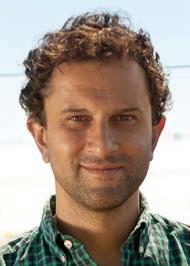
Will you discuss the history and heritage of Bodega Argento?
In 2012, we began to write a new chapter in our history with the premise of leading the production of organic and sustainable wines to preserve in each bottle the best of this region, which has a dry climate and alluvial soils, mountain water, high-altitude, and sun brightness. Our purpose was to lead Argentine viticulture in a sustainable way, respecting our environment and developing brands of high perceived value. We work to take care of natural resources and use organic production to express and preserve the best of our region through different grape varieties and places. Today, Argento leads the organic production of wines in Mendoza with more than 322 hectares of organic vineyards in Agrelo, Paraje Altamira, Ugarteche, Carrizal, and Cruz de Piedra.
What have been the keys to the growth and leadership of Argento in the industry?
The keys are our philosophy, mission, and vision as a company to manage our vineyards. We truly believe that the fruit that comes from a vineyard in agroecological balance with all the surrounding living compounds is a richer fruit in terms of grape and terroir expression, flavors, and color. On the other hand, with a strong commitment to ecology and sustainability, and caring about the world, we will leave to our children a strong enough reason to make things this way.
Bodega Argento is committed to sustainability. Will you highlight this focus and Argento’s sustainability initiatives?


Sustainability is a diverse concept and in our company we create an independent area to work and focus exclusively on sustainability. Our sustainability concept has strategic pillars:
• Natural resources administration (water, energy, waste management): we measure every resource and manage them in order to save as much as we can with high efficiency.
• People: we strongly consider our people’s work conditions and our community, so we decided to follow the Fair Trade program in all our vineyards and winery.
• Land: this is maybe the origin of our inspiration and philosophy, and of course, agroecological management is the way to make things, under the Organic certification.
• Business: working hard to maintain a healthy business is part of the sustainability of the project. After all, it is our job, what we do for a living, and we try to develop a healthy business, of course.
What do you feel people should know about the strength of the Argentine wine industry?
People should know that even though Argentina is a new world wine country, we have a strong history that our grandparents set more than a century ago and
nowadays this industry is going through a revolution in terms of quality and terroir identity, producing some of the best wines in the world, led by malbec but with other amazing grapes such as Cabernet Franc and Chardonnay.
The future of Argentina’s wine industry is very promising because we are consolidating year after year our capability of making worldclass wines.
How is technology impacting the winemaking process?
In high-end wines, our technology is focused on vineyards, especially in microterroir delimitation, soil characterization and mapping. Our high-end wines are made under artisanal processes in the winery and I am happy to keep it that way. In middle and entry-level wines, technology is a key factor because it always improves efficiency and quality.
Did you always know that you wanted to work in the wine industry and what has made the industry so special for you?
My grandfather was a viticulturist and winery owner. My father is a viticulturist and he introduced me to the vineyards during my childhood. When we would spend time together in the vineyards and winery, I was able to learn the philosophy of high-quality grapes and the care that goes into it all. I knew I wanted to be part of that and to continue paving the way for Argentine wines.
What are your priorities for Argento as you look to the future?
Of course, our biggest priority is to keep leading organic and sustainable wines in the future and focus on terroir identity pushing our wines into their deepest expression. The greatest wines in the world show places through the glass and this is what we are achieving nowadays in Argento. We are focused to keep going in that direction.•
EDITORS’ NOTE Todd English began his cooking career at the young age of 15 when he first entered the doors of a professional kitchen. At 20, he attended the Culinary Institute of America and graduated in 1982 with honors. He continued to hone his craft with Jean Jacques Rachou at New York’s La Cote Basque and then relocated to Italy where he apprenticed at the well-established Dal Pescatore in Canneto sull’Oglio and Paracucchi in Locanda dell’Angelo. It was in Italy that English, drawing from his Italian heritage, developed his unique style and approach to cooking. He returned to the United States at 25 and was asked to be the Executive Chef of the award-winning Northern Italian restaurant Michela’s in Cambridge, Massachusetts. He served there as an executive chef for three years, garnering high praise from both the press and the public. In the spring of 1991, English caught the culinary world’s eye when the James Beard Foundation named him their National Rising Star Chef. He followed through on that promise, as the James Beard Foundation subsequently named him Best Chef in the Northeast in 1994. Nation’s Restaurant News named English one of their Top 50 Tastemakers in 1999. In 2001, he was awarded Bon Appetit’s Restaurateur of the Year award and was named one of People Magazine’s 50 Most Beautiful People. He has also been named to the James Beard Foundation’s Who’s Who in Food and Beverage in America and is the Las Vegas Food & Wine 2022 Chef of the Year. The four-time James Beard Award-winner has established one of the best-known restaurant brands in the world, publishing critically acclaimed cookbooks and producing and hosting his own EMMY Award-nominated PBS TV show Food Trip . His multimillion-dollar hospitality empire, English Hospitality Group (ehgusa.com), recently revealed The English Hotel in the Las Vegas Arts District, which includes his world-class restaurant, The Pepper Club. This latest venture adds to his worldwide restaurant empire, including the Bahamas with Olives, The Beast by Todd English in Las Vegas, Todd English Pub in Birmingham, Figs in Boston and Charlestown, BlueZoo in Orlando, Tuscany in Connecticut, and MXDC
in Washington, DC. English is also joining forces with luxury car brand Bentley to open a resident-only private restaurant in the brand-new Bentley Residences in Miami, Florida. In addition, English created a new cannabis-infused food line with LastLeaf, and is currently developing new restaurants in cities across the globe.
When did you know that your passion was to be a chef?
I started cooking when I was 15 years old. I remember telling my high school counselor that I really enjoyed cooking and wanted to take a cooking class, so they sent me to a home economics class. We opened up a box of cake mix and made a cake. I went back to my counselor and said that this was not what I wanted to do. I had grown up with a bunch of Italians and we had a garden with fresh tomatoes and vegetables – I had never seen a cake out of a box.
I was also very involved in sports when I was young and went to college on a scholarship for baseball and soccer. I was injured and needed to take time off from sports to recover, and I moved back to Atlanta where I had grown up. I took a job as a cook at a steak restaurant since this was what I knew how to do, and the chef at the restaurant took a liking to me and mentored me. He was kind enough to call someone he knew at the Culinary Institute of America where it was very difficult to get accepted to attend, and I was able to go to the school. This was how my career began and I have never looked back.
What have been the keys to your ability to stay relevant over so many decades?
I have a constant fear of losing touch and becoming a dinosaur. I have a drive to continuously learn and improve. For example, I spent today at an organic farm as I am looking to create a mushroom restaurant and a mushroom village. One thing about this industry is that you are surrounded by young talent who see things differently from how you do, and this keeps me creative and excited about the future. I learn so much from these young people. There is nothing I enjoy more than spending time in the kitchen with the next generation of leading chefs.
As you have grown the number of restaurants and locations in your portfolio, has it been difficult to let go of being involved in every aspect of the business?
Letting go is always difficult. Technology helps since I can be in contact with my team whenever needed, so if we are working on daily specials at a restaurant, I am able to look at the dishes and give my suggestions. My focus is on working closely with our younger chefs and teaching them from my many years of experience in the business. There is a skill in cooking that I remember learning from watching and cooking with my grandmother, and that is an amazing sense of timing. Timing is the ability to understand when it is perfect and ready to serve – it is hard to explain, but if you cook you get a sense of the importance of timing and how critical timing is to the process.
How do you balance your love of being in the kitchen and cooking with the need to devote your time to running the business?
It is called the restaurant business, and I enjoy the challenge of creating things that are successful. I enjoy being creative, whether that is creating a new business concept or creating a new dish. I am working on creating new concepts around vegetables and plantbased offerings, since food is our medicine, and health is our wealth. I believe that there are still better ways to process food and as the world becomes eight billion people or ten billion people, how are we going to address food needs and food insecurity? We need to figure out better ways to get food to people –we still throw away 70 percent of our food. This is a very important focus for me.
What are your thoughts on the growth of cooking competitions on television and the concept of celebrity chefs?
The cooking competitions on television have provided a great way to get people interested and excited about restaurants and chefs, which is positive for the industry. These shows have shown people what it takes to be a chef and the level of intensity and dedication needed to be successful in the profession.
In regard to celebrity chefs, when I look at any celebrity that I have obtained in the profession, for me it is about using this celebrity to help raise money and be charitable to support
 Todd English
Todd English
worthy causes and give back to the communities we serve. When you attend a charity auction and have a dinner cooked by a celebrity chef being offered, it helps raise needed funds for important causes, and being able to do this is what excites me the most about having achieved some celebrity for my work.
When you open a new restaurant, do you know if it is going to work or are you at times surprised?
I am surprised all the time. There are times when a restaurant takes off above your wildest expectations, and there are times when it may not catch on and you need to evaluate what went wrong. You can’t win them all, but fortunately for me it has been an amazing journey.
This is a business where you are constantly focused on what you can do better as opposed to what you have done well – it is about continuous improvement. There are so many different elements that take place in the kitchen that contribute to the final product, and it takes a deep attention to detail and great focus to be successful. When it all comes together and the magic happens, there is nothing better.
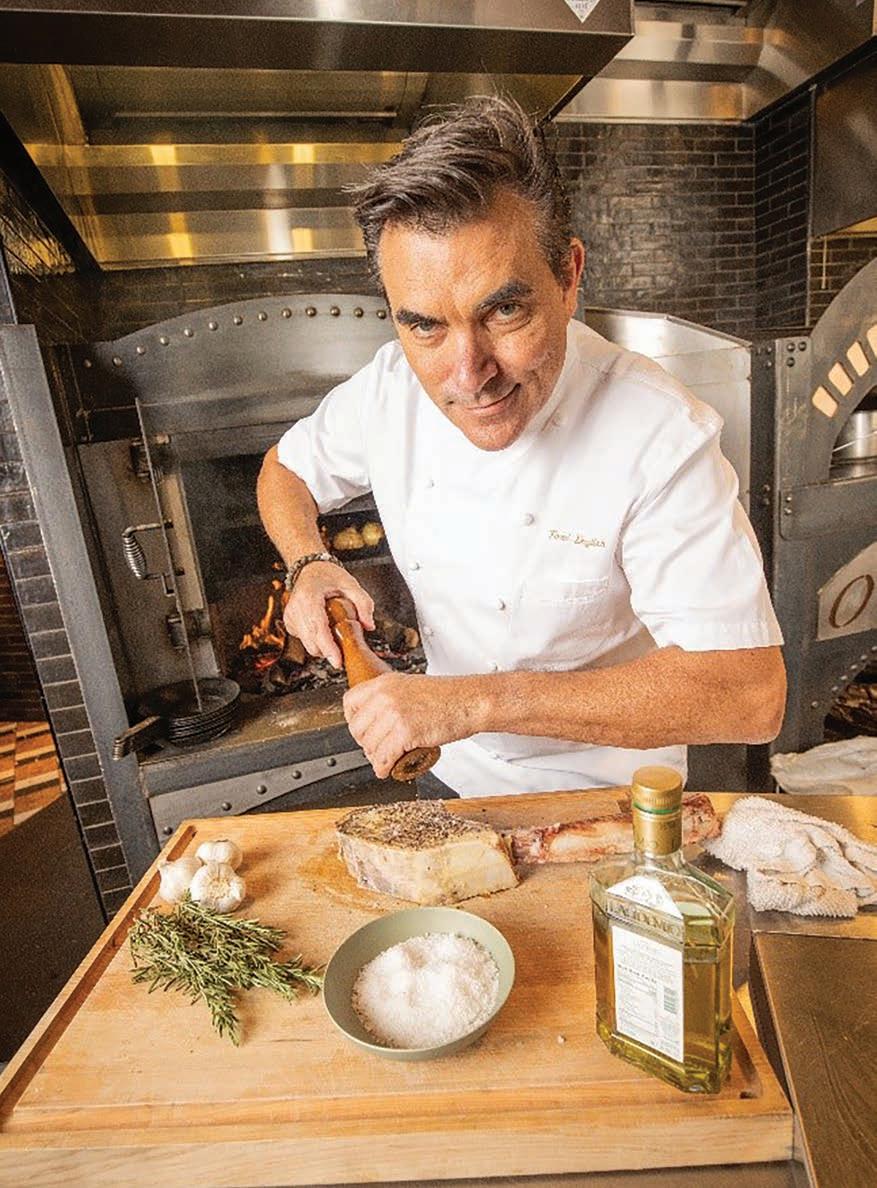
With all the success you have achieved, it has not always been a smooth ride. How important has it been to be resilient throughout your career?
There have been ebbs and flows. I think playing sports growing up had a major impact on me, since in baseball if you strikeout three times in a game it is about going back to the drawing board and evaluating what you did wrong to get better – this takes resilience. The mental toughness that I developed over the years has been extremely valuable since this can be a very humbling business, and just when you think everything is going perfect, something happens. You need to be able to bounce back and be resilient to build a long career in this profession.
What advice do you offer to young people interested in a career as a chef?
It is different for different people. You need to look at your ability and decide the best path – for some people, that is going to culinary school, while for others, it may be going straight to work in a kitchen. The keys to being successful in this business are hard work, commitment, and passion. You need to enjoy continuous learning and motivate yourself to be better every day. •
Todd English in the kitchen“It is called the restaurant business, and I enjoy the challenge of creating things that are successful. I enjoy being creative, whether that is creating a new business concept or creating a new dish.”





 Abraham Archibald Anderson
Miss Caroline Welton Mattatuck Museum
Abraham Archibald Anderson
Miss Caroline Welton Mattatuck Museum

Eli Wilner & Company specializes in the reframing of artwork from all periods. Mr. Wilner’s frames are on display in e Met, the White House and countless other museums as well as many private collections.




To schedule an appointment, his gallery can be reached at 212-744-6521 or by visiting www.eliwilner.com





HPU’s students benefit professionally from the CEOs, tech titans and global change agents who love mentoring them at The







